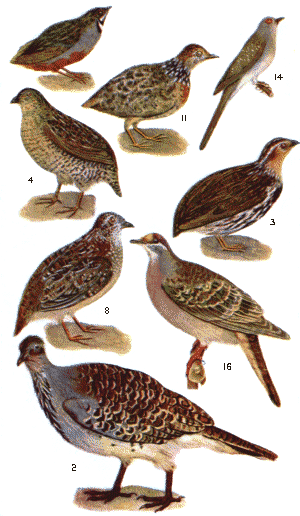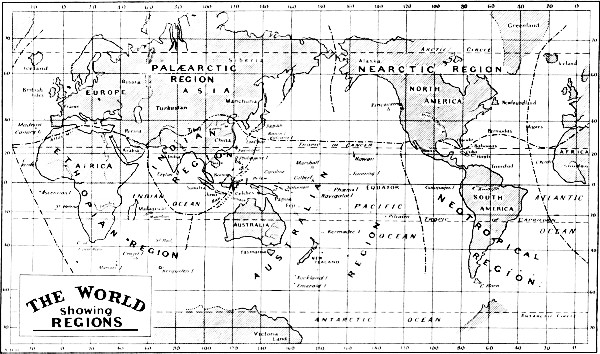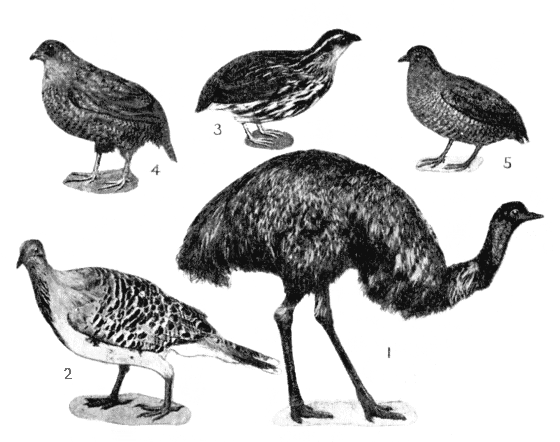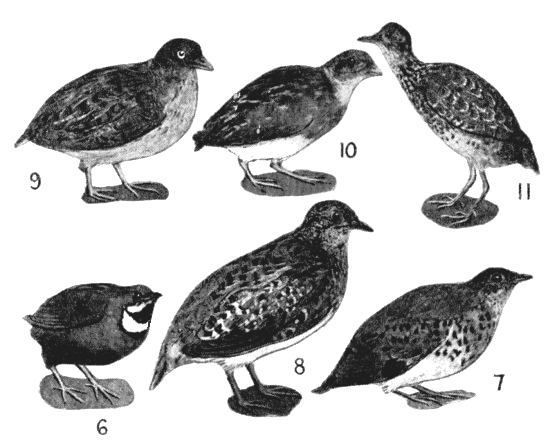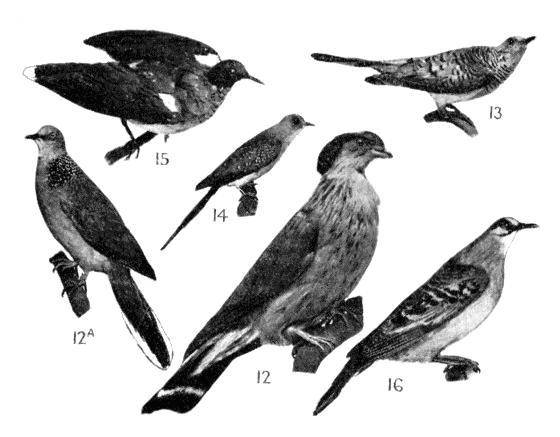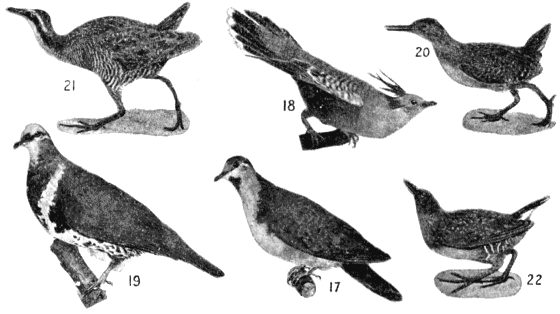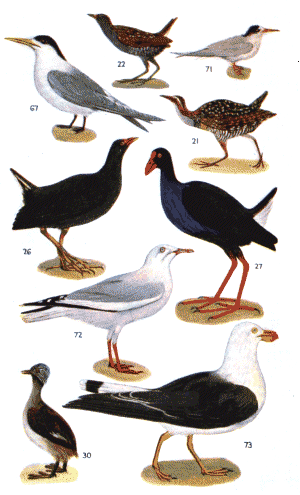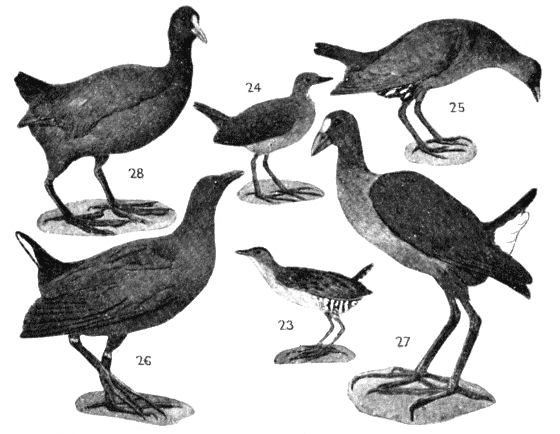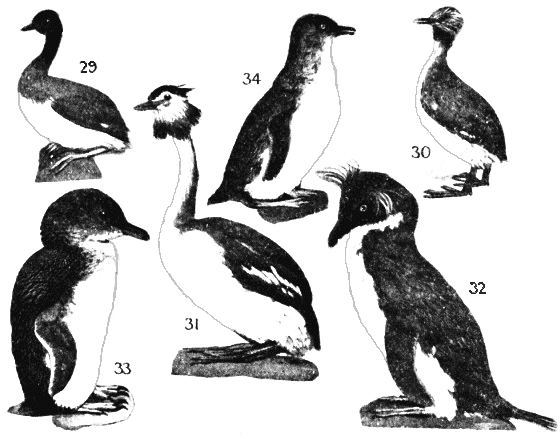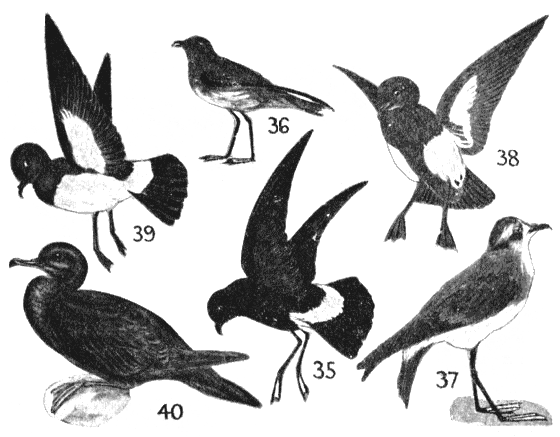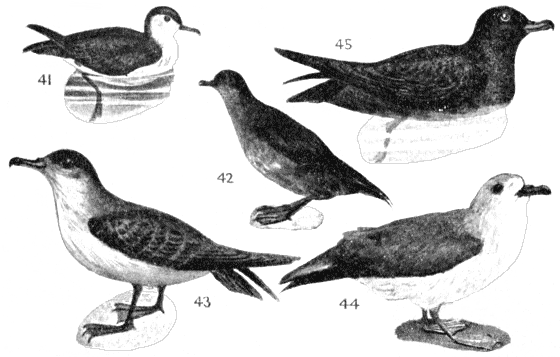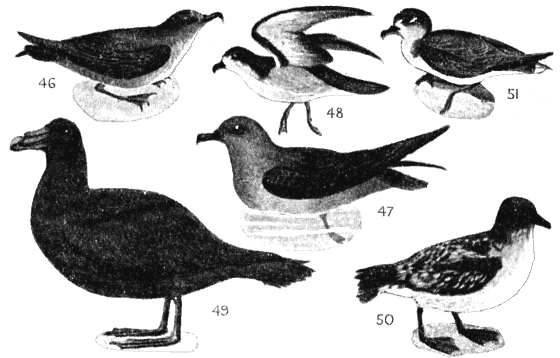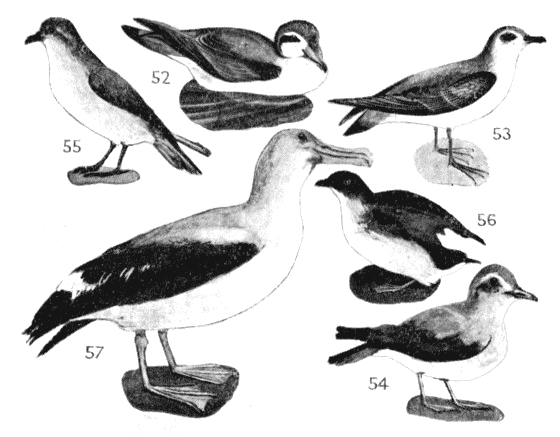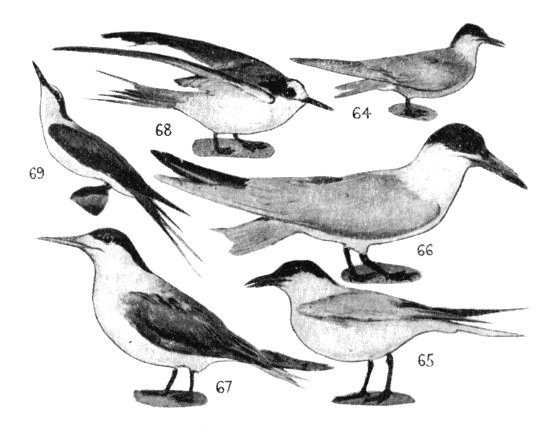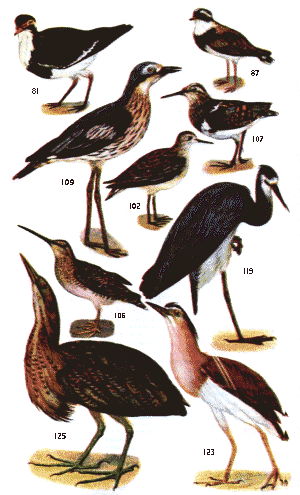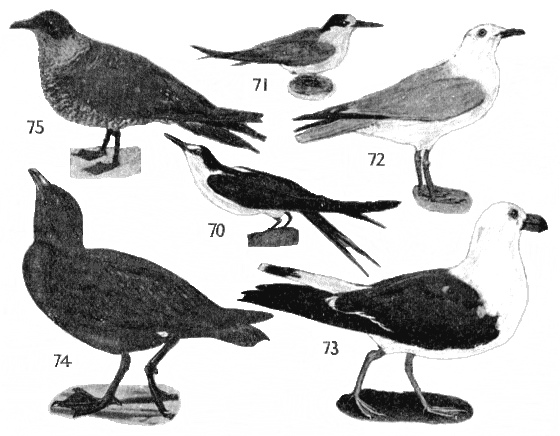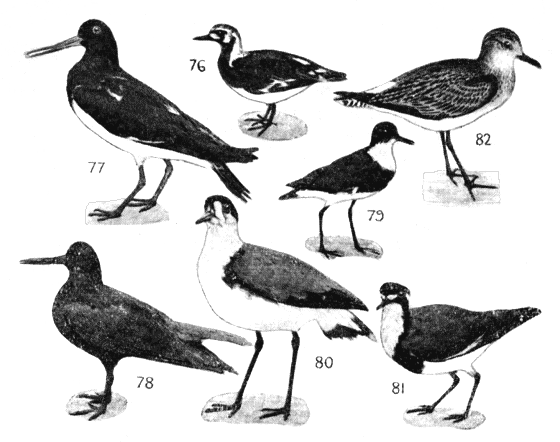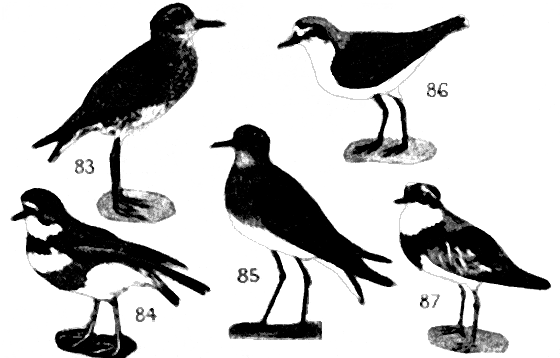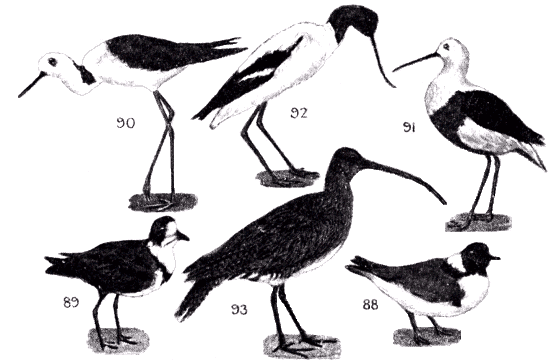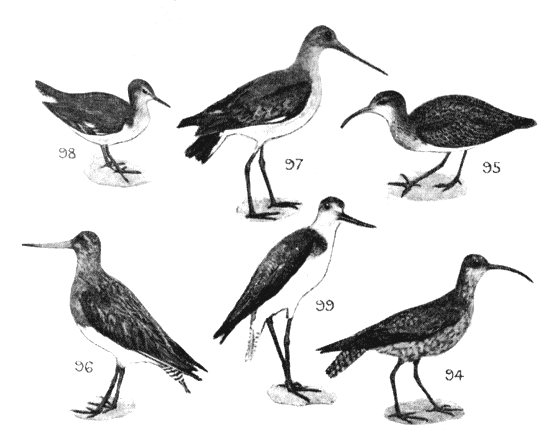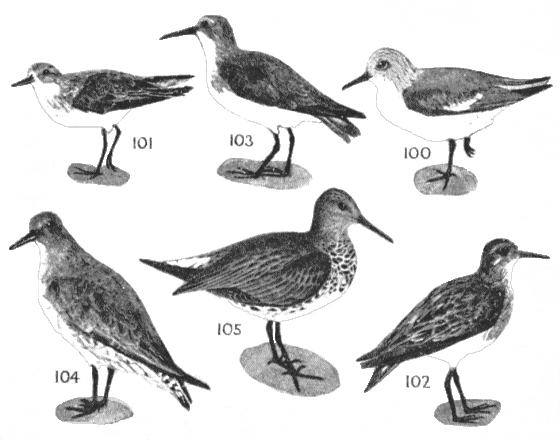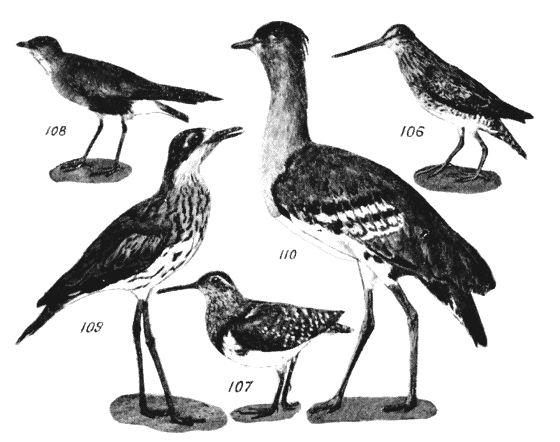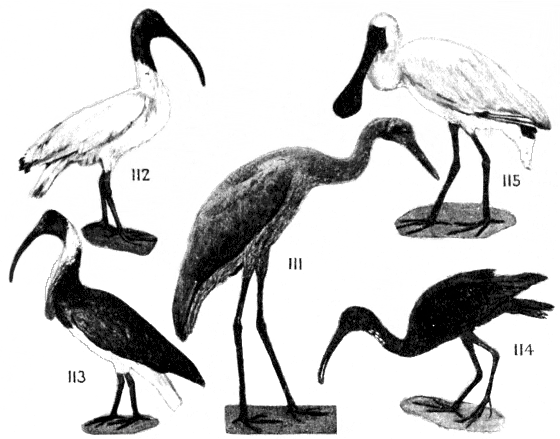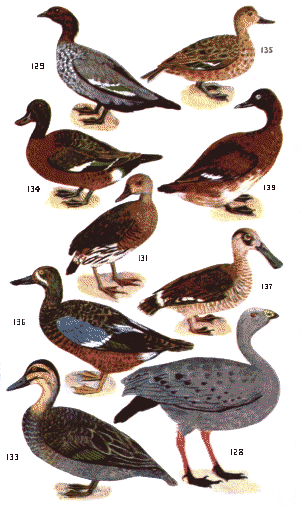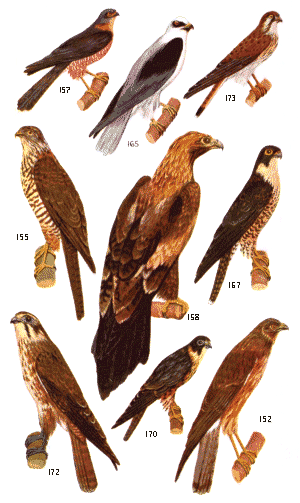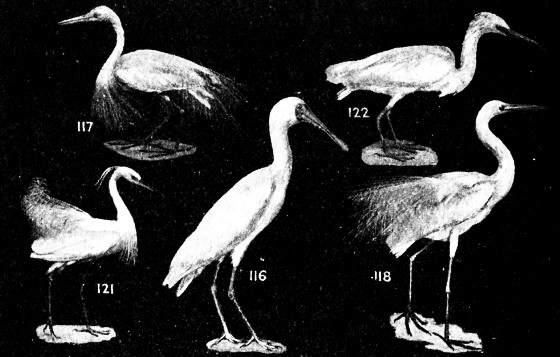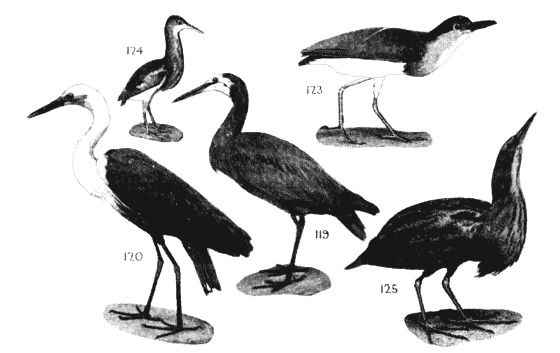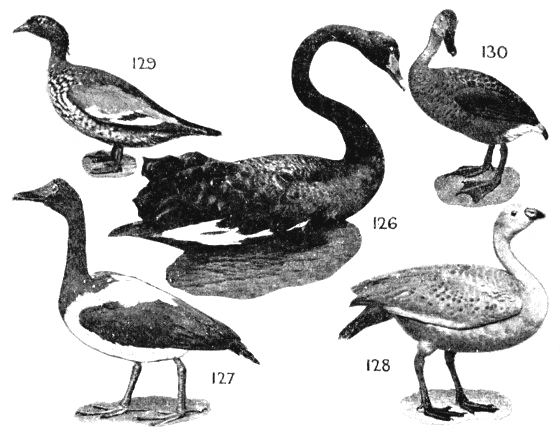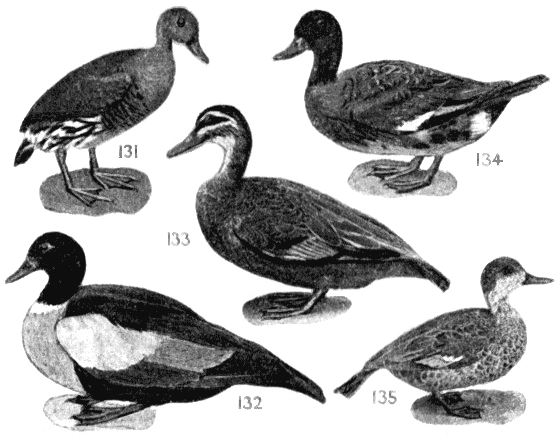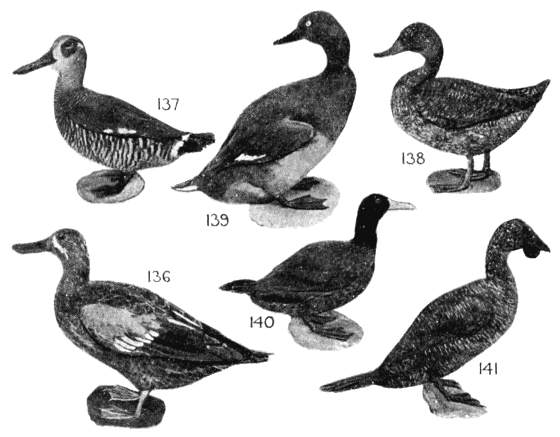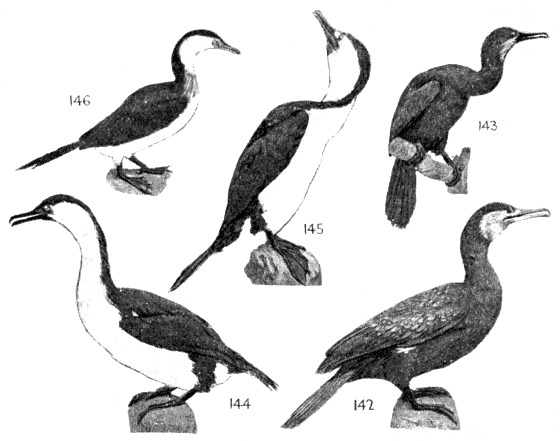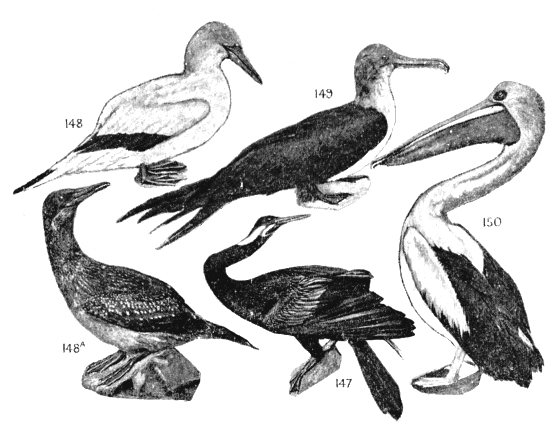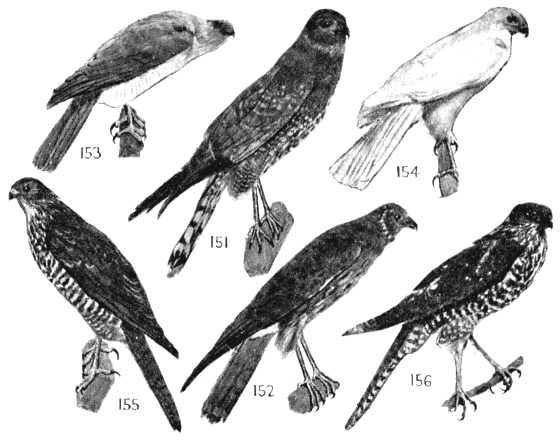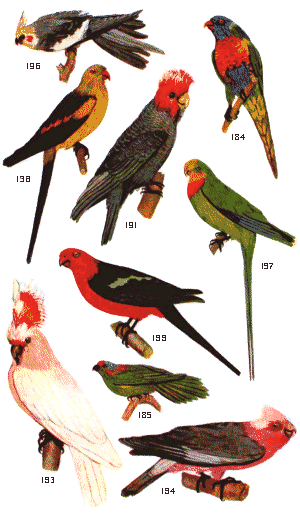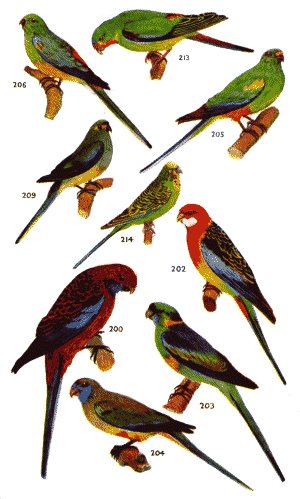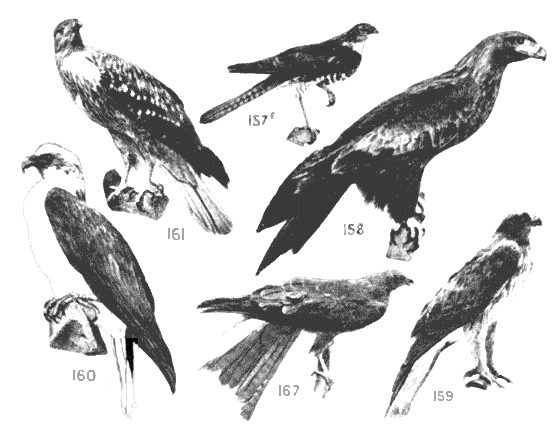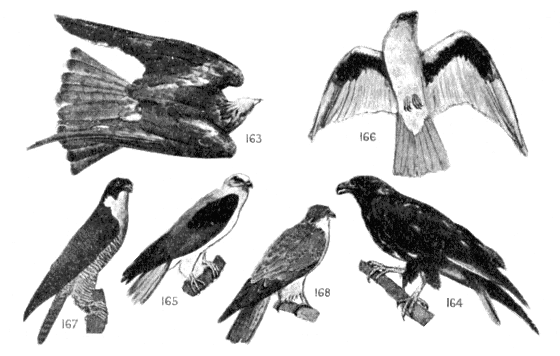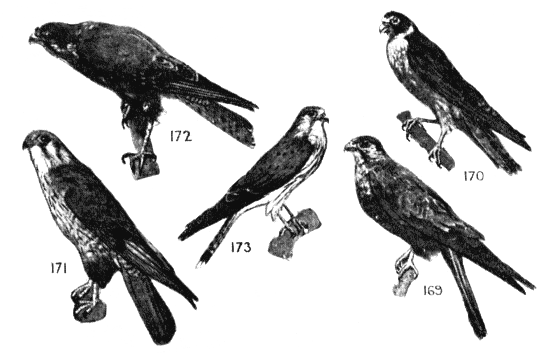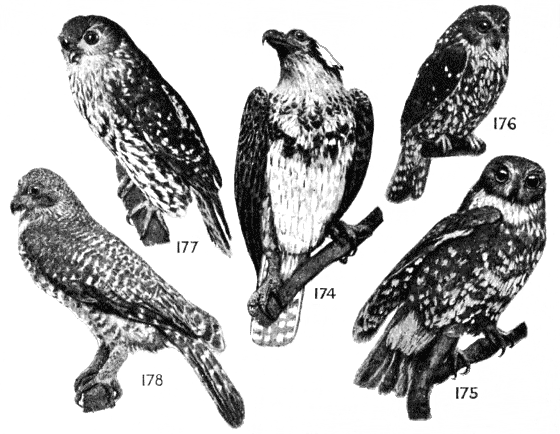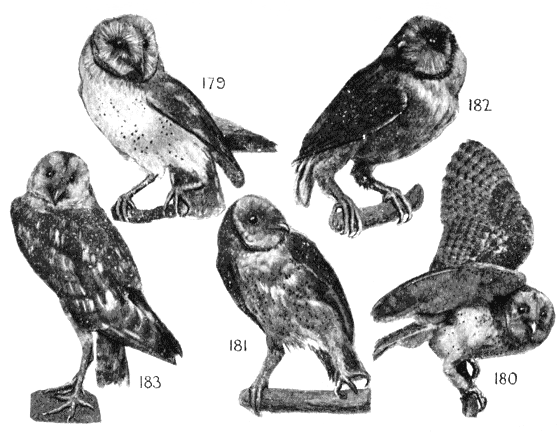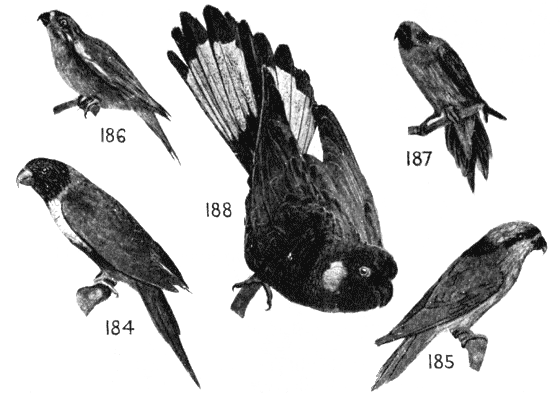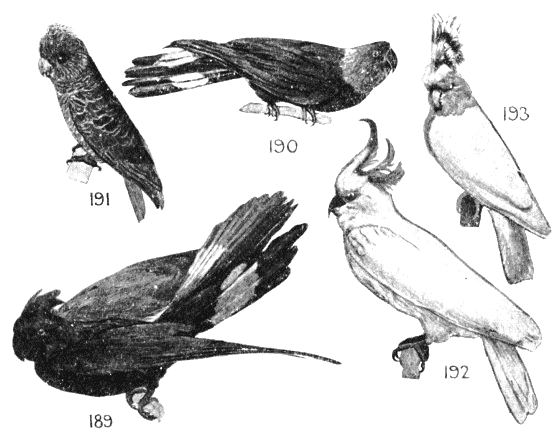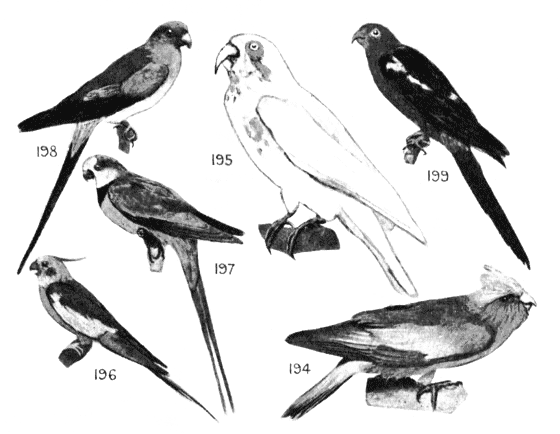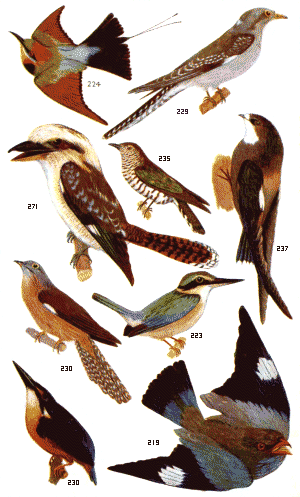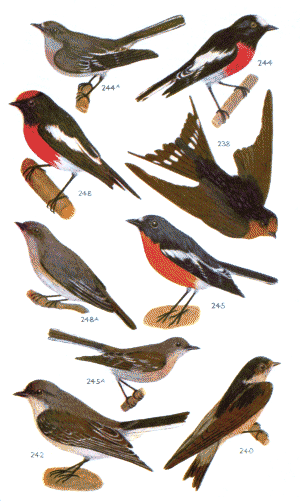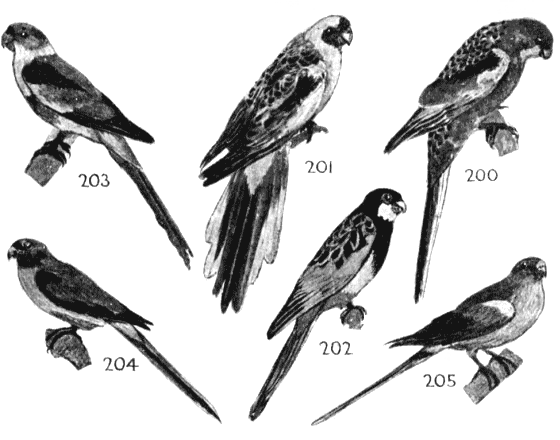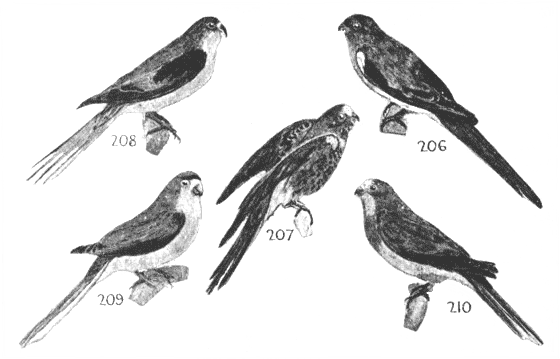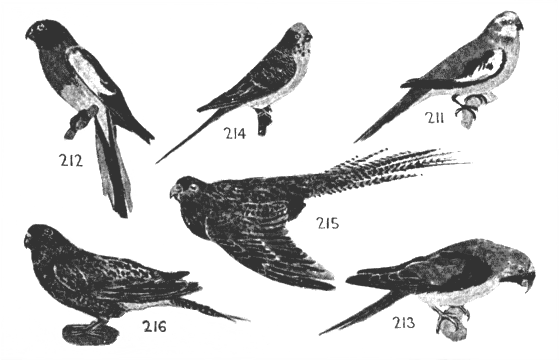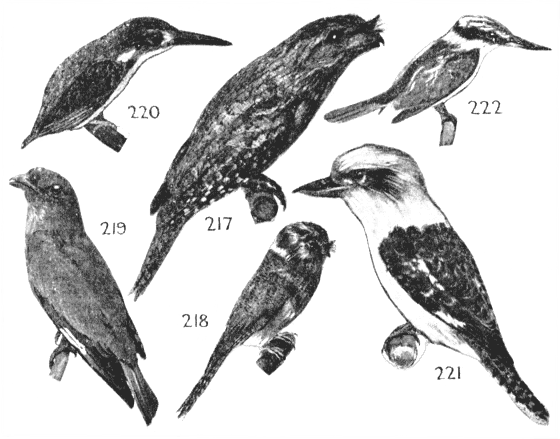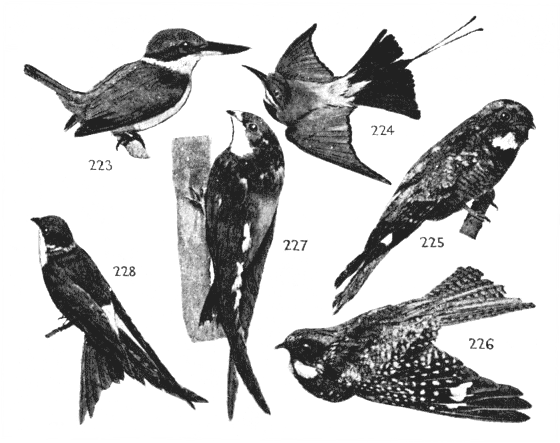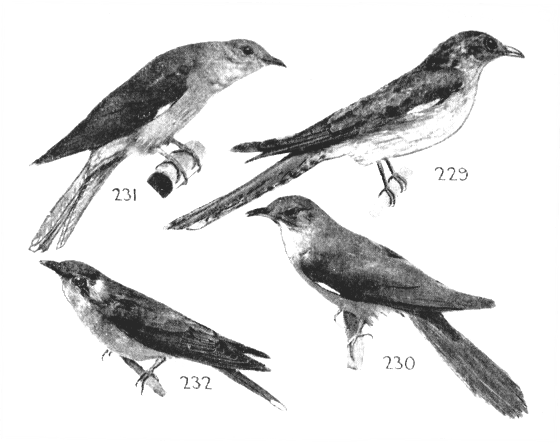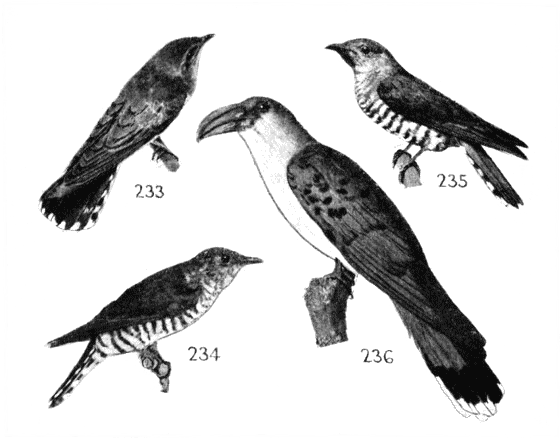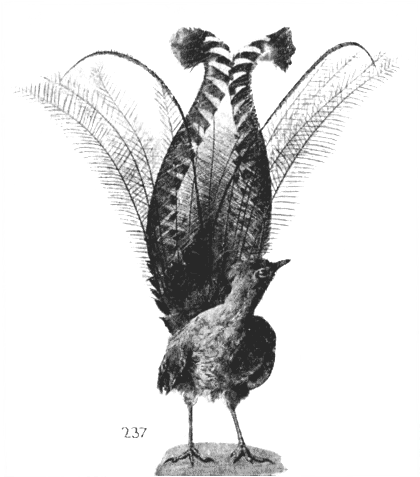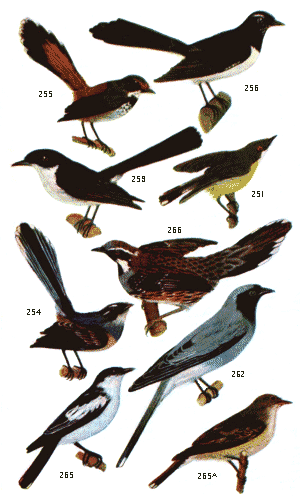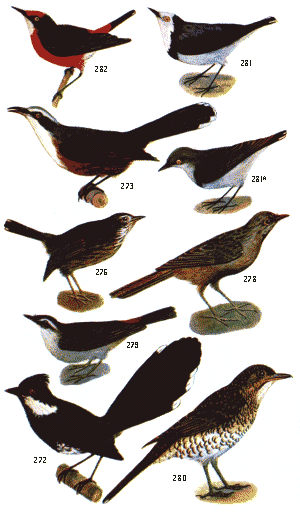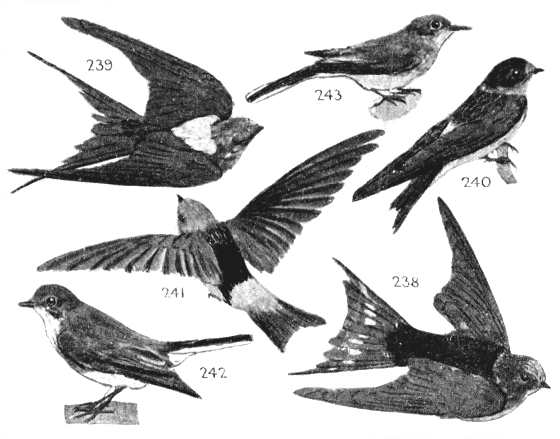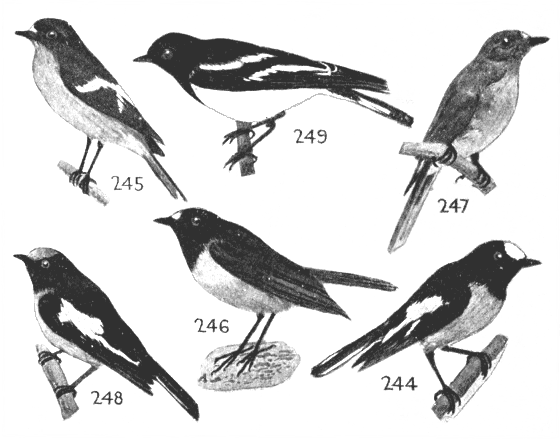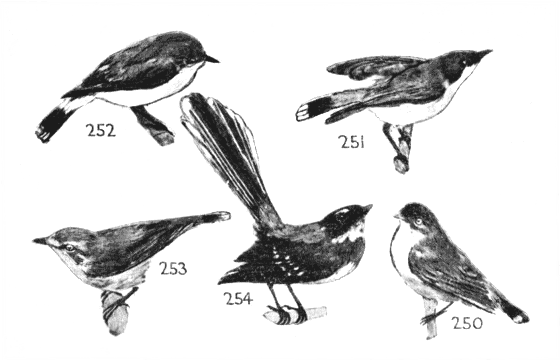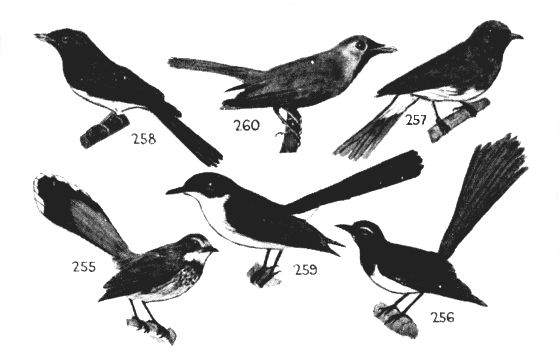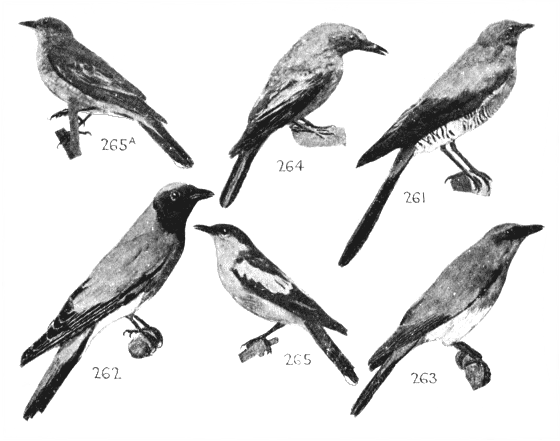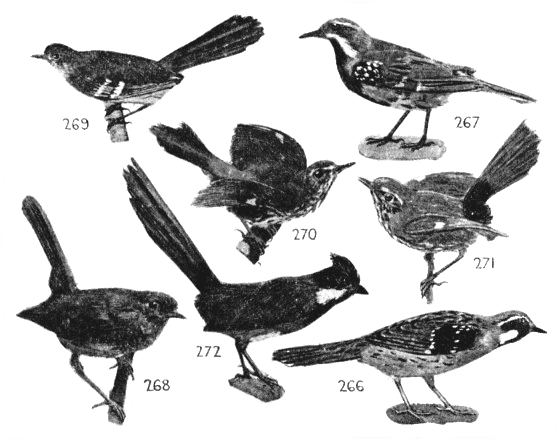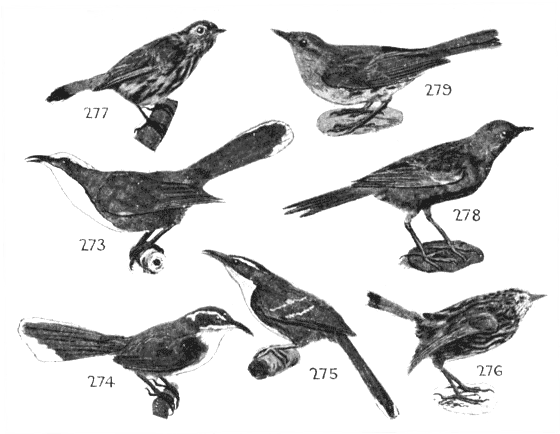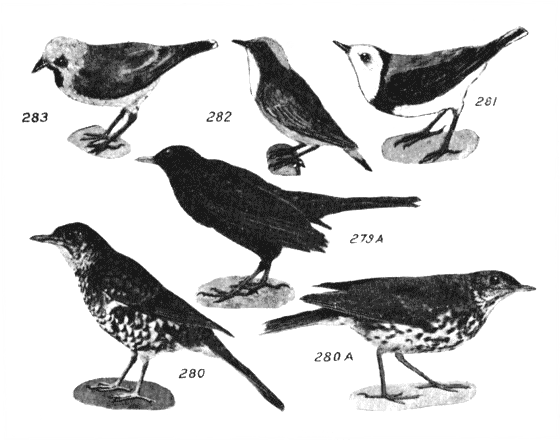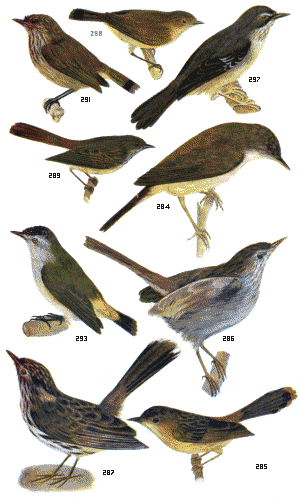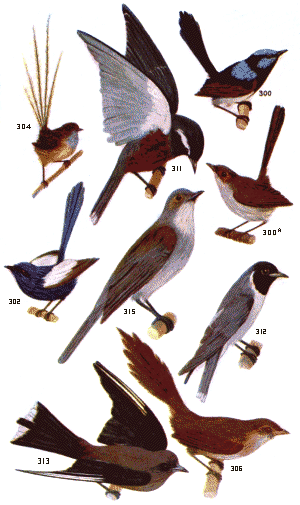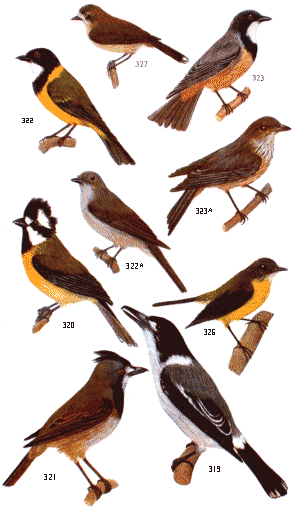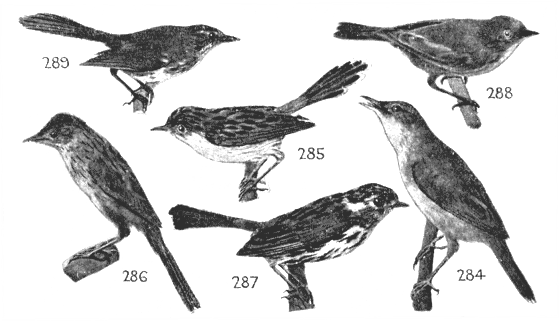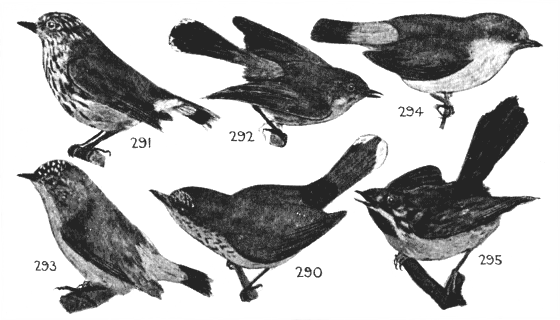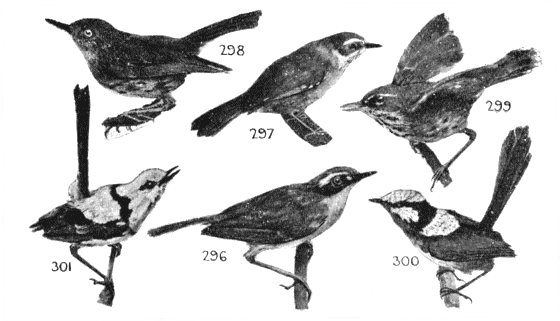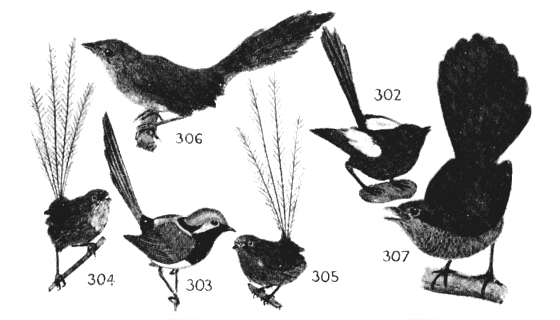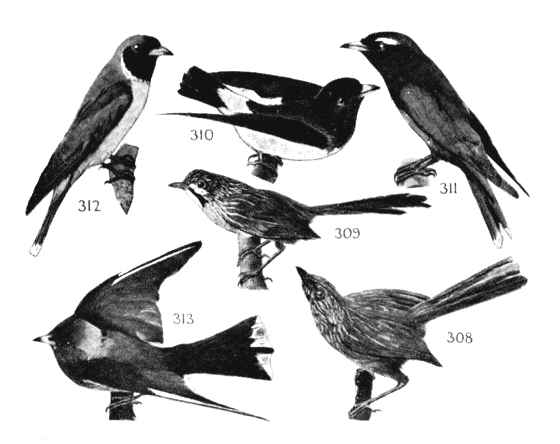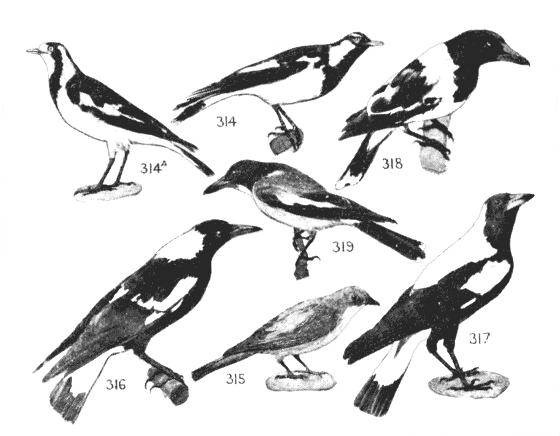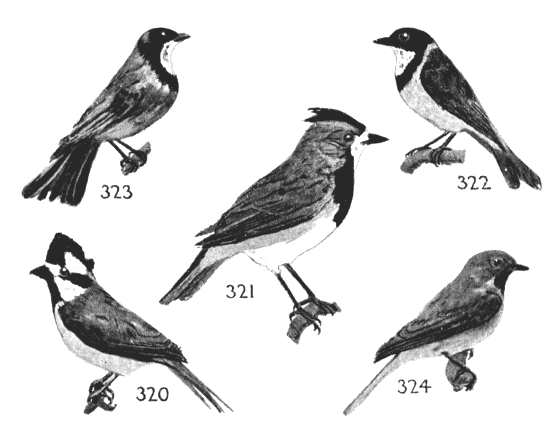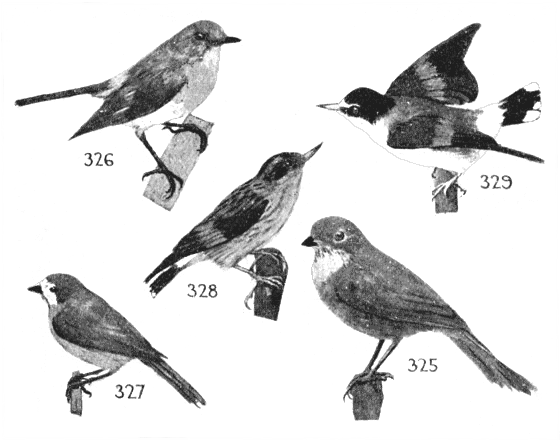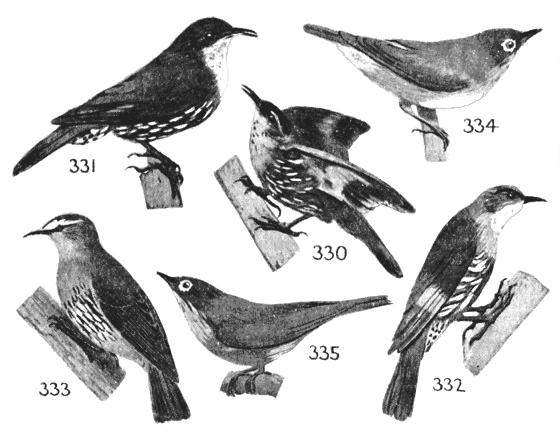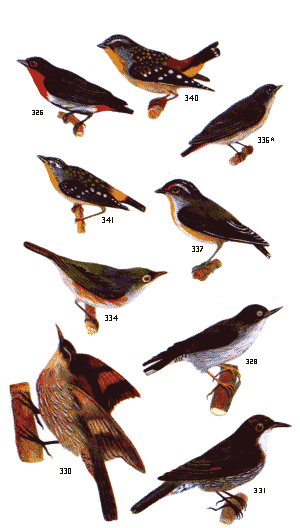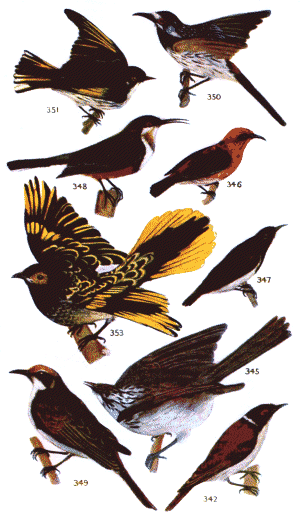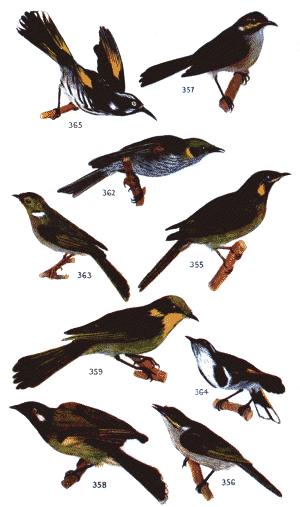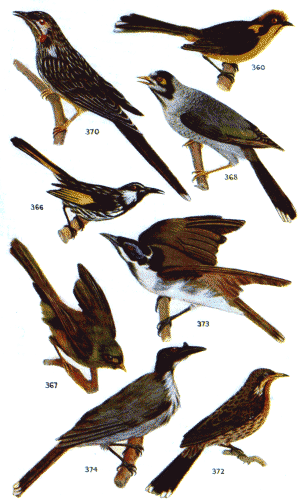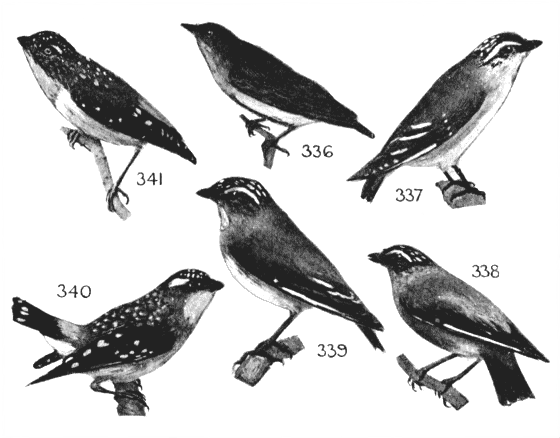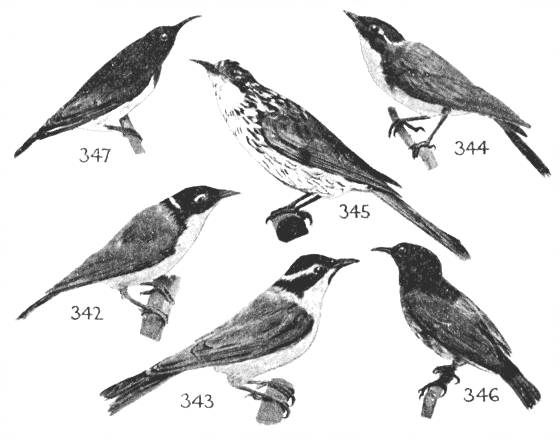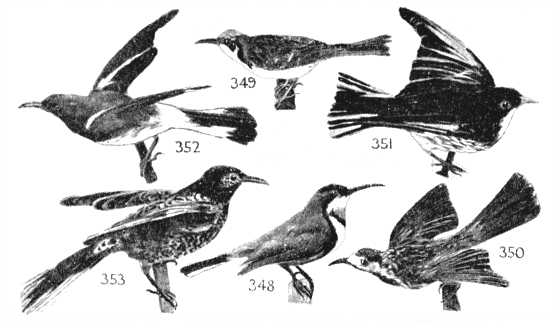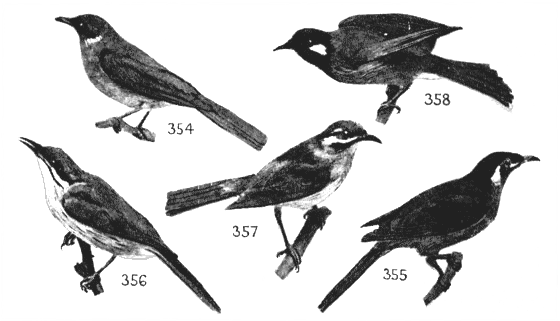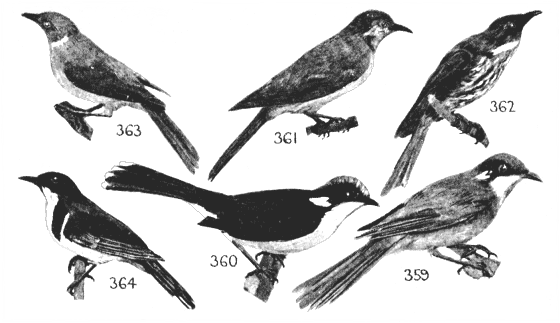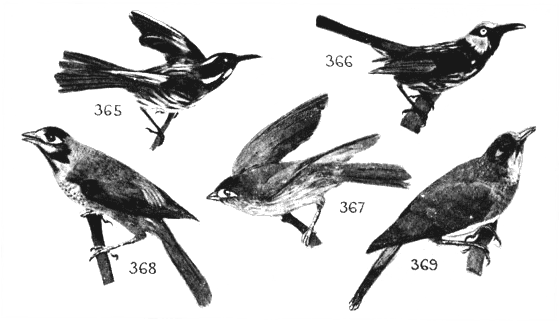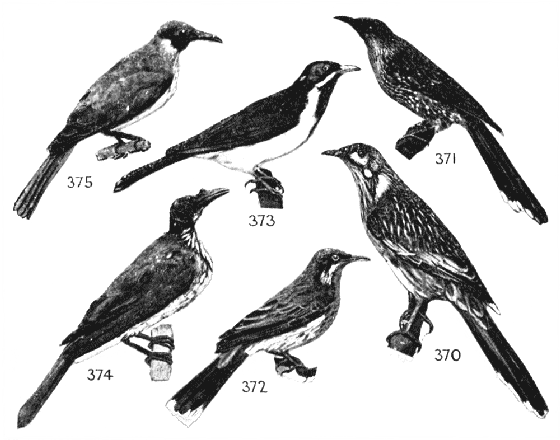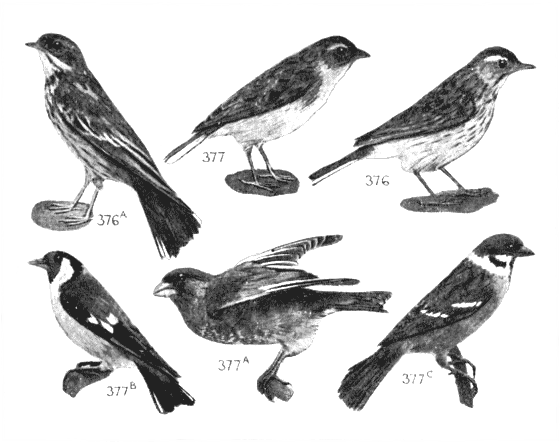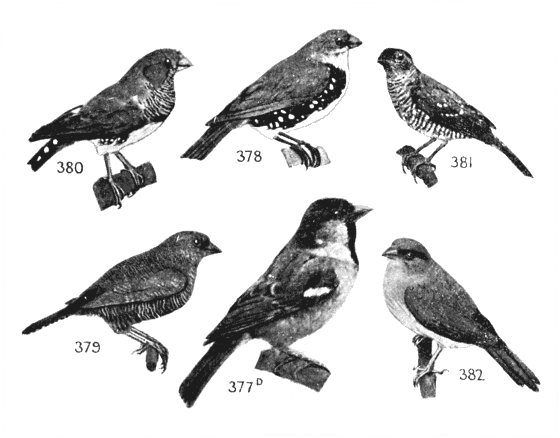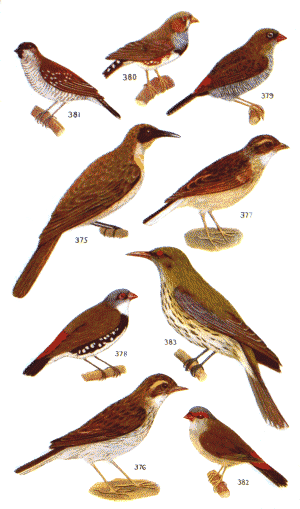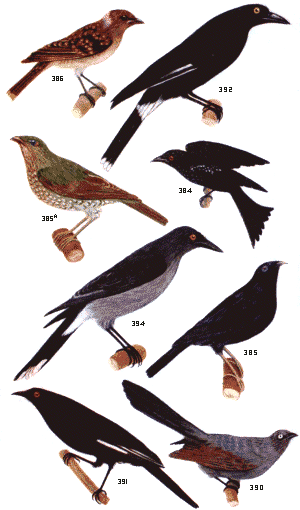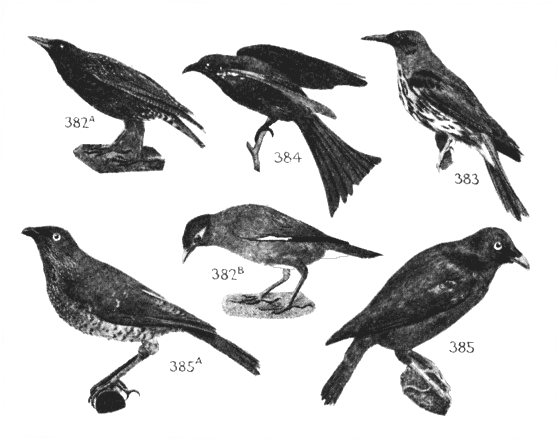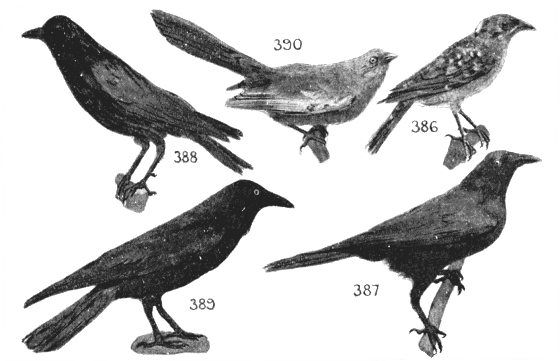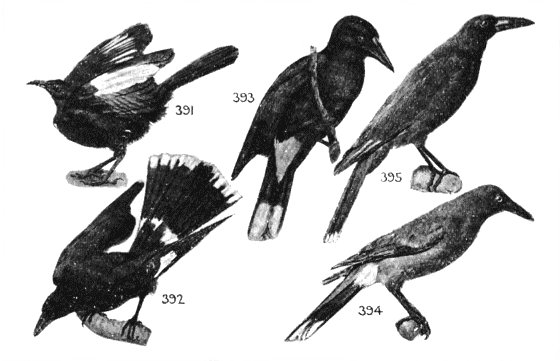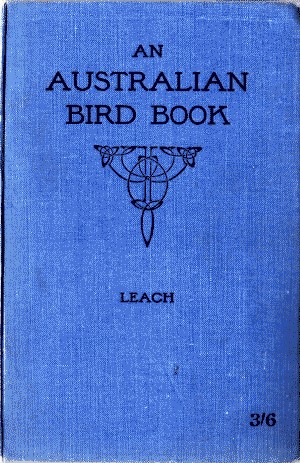
| 2 Mallee-Fowl 3 Stubble Quail 4 Brown Quail |
6 King Quail 8 Painted Quail 11 Plain Wanderer |
14 Diamond Dove 16 Bronzewing Pigeon |
AN AUSTRALIAN BIRD BOOK
A Pocket Book for Field Use
BY
J. A. LEACH, M.Sc.
First-class Honorman and University Exhibitioner and Scholar in Biology; Organizing Inspector of Nature Study, Education Department, Victoria; Member of the Council of the Royal Australasian Ornithologists' Union; Vice-President of the Field Naturalists' Club of Victoria; &c.
With Introduction by
FRANK TATE, M.A., I.S.O.
Director of Education, Victoria.
Published by arrangement with the Education Department of Victoria.
SECOND EDITION
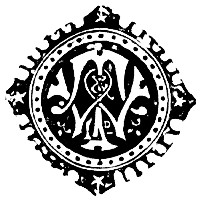
MELBOURNE
Christchurch, Wellington, Dunedin, N.Z., and London.
WHITCOMBE & TOMBS LIMITED
1912

Illustrations from Specimens (318) in the National Museum, Melbourne; the balance mostly from Specimens in the Entomological Museum, C. French (59), and in the collections of A. Coles, Taxidermist, (36), C. F. Cole, and D. Le Souëf. Twenty-two birds were photographed from Gould's "Birds of Australia," five from drawings specially prepared by C. C. Brittlebank, the well-known naturalist-artist, and one from the Report of the Horn Expedition.
Photos by Ralph L. Miller.
Engravings by Patterson Shugg & Co., from Paintings by Miss Ethel M. Paterson.
1INTRODUCTION.
Nature-study in our schools is fast producing a generation of Australians trained to look upon the characteristic beauties of our Australian skies, our trees, our flowers, our birds with a passionate appreciation almost unknown to our pioneering fathers and mothers. It was natural that newcomers from the Old World should have been impressed, and often unfavorably impressed, by the oddness of things here. Rural sights to them had hitherto been sights of trim meadows bordered by neat hedgerows, of well-cultivated fields and comfortable farmsteads, or of stately homes set in fair gardens and far-reaching parks of magnificently-spreading trees. What wonder, then, that they were at first almost repelled by the strangeness and unfamiliarity of their new surroundings! How could eyes accustomed to the decided greens and to the somewhat monotonous shapeliness of the trees in an English summer landscape find beauty all at once in the delicate, elusive tints of the gum trees, or in the wonderfully decorative lines of their scanty boughs and light foliage shown clear against a bright sky? And so a land which is eminently a land of color, where the ever-present eucalypts give in their leaves every shade from blue-grays to darkest greens; where the tender shoots show brilliantly in bright crimson, or duller russets, or bright coppery-gold; and where tall, slender stems change slowly through a harmony of salmon-pinks and pearl-grays, has been called a drab-colored land. Even now, the beauty of the gum tree is not sufficiently appreciated by Australians, and we see all too few specimens in our suburban gardens. For an appreciation of the decorative effect of our young blue gums, we must go to the Riviera or to English conservatories.
Australia has suffered greatly from phrase-makers. There is still much popular belief that our trees are shadeless, our rivers are waterless, our flowers are scentless, our birds are songless. Oddities in our flora and fauna have attracted the notice of superficial observers, and a preference for epigrammatic perfection, rather than for truthful generalization, has produced an abundance of neatly-expressed half-truths, which have been copied into popular literature, and even into school books. Our English-bred poet, Gordon, writes of lands—
"Where bright blossoms are scentless,
And songless, bright birds."
and these lines are remembered better than his description in the same poem of Spring—
"When the wattle gold trembles
'Twixt shadow and shine,
When each dew-laden air draught resembles
A long draught of wine."
It is true that we have scentless, bright blossoms; but Australia is the home of the richly-perfumed wattle, and the boronia, with its never-cloying fragrance; while there is, perhaps, no forest more odorous than a forest of eucalypts. It is true, too, that we have bright birds that have no excellence in song; but it is also true that, in this favored land, there is a far greater proportion than usual of fine song-birds.
The first generations of Australians were not taught to love Australian things. We "learned from our wistful mothers to call Old England home." Our school books and our story books were made in Great Britain for British boys and girls, and naturally they stressed what was of interest to these boys and girls. We read much about the beauty of the songs of the Lark, and the Thrush, and the Nightingale, but we found no printed authority for the belief that our Magpie is one of the great song-birds of the world; we read of the wonderful powers of the American Mocking-Bird, and did not know that our beautiful Lyrebird is a finer mimic; we learned by heart Barry Cornwall's well-known poem on "The Storm Petrel," and did not know that one of the most interesting of Petrel rookeries is near the harbor gate of Melbourne; and I remember well a lesson I heard as a boy on the migration of birds, in which the teacher took all of his illustrations from his boyish experiences in the South of England, and gave us no idea that the annual migration of our familiar Australian birds to far-off Siberia is a much more wonderful thing.
But all this is being rapidly changed. In the elementary schools Nature-study is steadily improving, and children are being given an eye for, and an interest in, the world of Nature around them. Our school books are now written from the Australian standpoint, and more use can, therefore, be made of the child's everyday experience. Field Naturalists' clubs are doing much to extend the area of specialized Nature-study, and their members are giving valuable assistance to the schools by taking part in the programs for Arbor Day, Bird Day, and the like. The growing interest in the Australian fauna and flora is further evidenced by the frequent reservations by Government of desirable areas as national parks and sanctuaries for the preservation of Australian types. Last, but not least, is the production by capable Nature students of special books on some form of Nature-study, such as this Bird Book by Mr. Leach.
To our parents, Australia was a stranger land, and they were sojourners here. Though they lived here, they did not get close enough to it to appreciate fully its natural beauty and its charm. To us, and especially to our children, children of Australian-born parents, children whose bones were made in Australia, the place is home. To them Nature makes a direct appeal, strengthened by those most powerful of all associations, those gathered in childhood, when the foundations of their minds were laid. The English boy, out on a breezy down, may feel an exaltation of soul 3 on hearing a Skylark raining down a flood of delicious melody from far up at heaven's gate, but his joy is no whit greater than his who hears, in the dewy freshness of the early morning, the carol of the Magpie ringing out over an Australian plain. To those who live in countries where the winter is long and bitter, any sign that the genial time of flowers is at hand is very welcome. All over the countryside the first call of the Cuckoo, spring's harbinger, arouses the keenest delight in expectant listeners. This delight is, however, more than mere delight in the bird's song. And to those brought up with it year by year there comes a time when the call of the Cuckoo stirs something deep down below the surface of ordinary emotion. It is the resultant of multitudes of childhood experiences and of associations with song and story. I first heard the Cuckoo in Epping Forest one delicious May evening four years ago. It charmed me, but my delight was almost wholly that of association. All the English poetry I knew was at the back of the bird's song. Here in Australia we have no sharply-defined seasons, yet I find myself every spring listening eagerly for the first plaintive, insistent call of the Pallid Cuckoo. For me his song marks another milestone passed.
Marcus Clarke wrote of the Laughing Jackasses as bursting into "horrible peals of semi-human laughter." But then Marcus Clarke was English-bred, and did not come to Australia till he was eighteen years old. It makes all the difference in our appreciation of bird or tree or flower to have known it as a boy. I venture to think no latter-day Australian who has grown up with our Kookaburra can have any but the kindliest of feelings for this feathered comedian. For myself, I confess that I find his laughter infectious, and innumerable times he has provoked me into an outburst as hearty and as mirthful as his own. More than half of our pleasure is due to the fact that the bird is
"The same that in my schoolboy days I listened to."
and to such a one we can say—
"I can listen to thee yet,
Can lie upon the plain
And listen, till I do beget
That golden time again."
It is time that we Australians fought against the generally received opinion that the dominant note of our scenery is weird melancholy. This is the note sounded mainly by those who were bred elsewhere, who came to us with other associations and other traditions, and sojourned among us. It will not be the opinion of the native-born when they find appropriate speech.
"Whence doth the mournful keynote start?
From the pure depths of Nature's heart?
Or, from the heart of him who sings,
And deems his hand upon the strings,
Is Nature's own?"
This little book should do much to popularize bird-study and to spread a knowledge of our common birds among our people. I hope devoutly that an effort will be made to give them suitable names. We should give them names a poet or a child can use. A Chaucer poring lovingly over his favorite flower, the daisy, could call it by a name which is itself full of poetry. Even the unimaginative clown, Nick Bottom, could sing of
"The Ouzel Cock, so black of hue,
With orange-tawny bill,
The Throstle with his note so true,
The Wren with little quill,
The Finch, the Sparrow, and the Lark,
The plain-song Cuckoo gray."
And a Burns can invoke the Throstle in lines as musical as the song of the bird itself—"And thou mellow mavis, that hails the night-fa'."
But how shall an Australian bard sing of "The Red-rumped Acanthiza," or of that delightful songster, "The Rufous-breasted Thickhead"? Australian Nature-poetry will be handicapped until our children give names like "Bobolink," and "Chickadee," and "Whip-poor-will," and "Jacky Winter," to our birds.
"Oriel," in the Argus, some time ago, showed how hard it is to write of love's young dream in Australian verse.
"Sweetheart, we watched the evening sky grow pale,
And drowsy sweetness stole away our senses,
While ran adown the swamp the Pectoral Rail,
The shy Hypotaenidia philippinensis.
"How sweet a thing is love! Sweet as the rose,
Fragrant as flowers, fair as the sunlight beaming!
Only the Sooty Oyster-Catcher knows
How sweet to us, as there we lingered dreaming.
"Dear, all the secret's ours. The Sharp-tailed Stint
Spied, but he will not tell—though you and I
Paid Cupid's debts from Love's own golden mint,
While Yellow-Bellied Shrike-Tits fluttered nigh.
"The Honey-eaters heard; the Fuscous—yea,
The Warty-faced, the Lunulated, too;
But this kind feathered tribe will never say
What words you said to me, or I to you.
"The golden bloom was glorious in the furze,
And gentle twittering came from out the copses;
It was the Carinated Flycatchers,
Or else the black Monarcha melanopsis.
"That day our troth we plighted—blissful hour,
Beginning of a joy a whole life long!
And while the wide world seemed to be in flower,
The Chestnut-rumped Ground-Wren burst forth in song."
It surely would not be amiss if the Bird Observers' Clubs throughout Australia, and the Royal Australasian Ornithologists' Union, enlisted the aid of the State Education Departments, and endeavored to find out what names the children use for the birds of their district. Executive committees upon bird names are good; but a good name is not evoked by arguments in committee. It ofttimes comes from the happy inspiration of some child who loves the bird. At present the names given by classifiers are often an offence. A few evenings 5 ago I was charmed with an unaccustomed song coming from out a big pittosporum tree in my garden at Kew. I took careful note of the little warbler, and then consulted Mr. Leach's Descriptive List. Judge of my satisfaction when I found that my little friend was "The Striated Field Wren or Stink Bird"!
The Australian boy is responding splendidly to the Nature-study movement. Bird observers tell me that shy native birds, formerly unknown near the haunts of men, are making their appearance, feeling safer now from molestation. Nest hunting for the sake of egg spoliation is happily becoming rarer, although children are developing keener eyes for nests. To-day every country school has its nests under loving observation for the purposes of bird-study and of bird-protection. Walt Whitman might have been describing many a Victorian school boy when he wrote—
"And every day the he-bird, to and fro, near at hand,
And every day the she-bird, crouched on her nest, silent, with bright eyes,
And every day, I, a curious boy, never too close, never disturbing them,
Cautiously peering, absorbing, translating."
This loving study must bear good fruit. If we believe the scientific men, Australia is, par excellence, the land of birds, song-birds, plumage-birds, and birds of wonderful interest, such as the Satin Bower Bird. The collection of Australian birds in our National Museum at Melbourne is certainly one of the finest sights of the city, and it should be studied by all who wish to know how favored this continent is in bird distribution. But we must get to know and to love our feathered friends. Mr. Leach in his lecture has dwelt sufficiently on the economic and scientific value of bird-study. Let me enter a plea for bird-study as a source of æsthetic pleasure. Before our Australian birds can be to us what the Thrush and the Blackbird and the Linnet and the Lark and the Nightingale are to the British boy, we must have a wealth of association around them from song and story. And this association must grow up with us from childhood if it is to make the strongest appeal to us. It can rarely be acquired in later life. British birds owe much to the poets for the charm that surrounds them. When I heard the Nightingale in England, although I had no association with it gathered from my boyhood's days, I heard more than the bird's song. I was listening to Keats and Wordsworth and Shakespeare as well. There is something very fine in the thought that such bird songs go on for ever, that these immortal birds are "not made for death," that
"The voice I hear this passing night was heard
In ancient days by emperor and clown:
Perhaps the self-same song that found a path
Through the sad heart of Ruth, when, sick for home,
She stood in tears amid the alien corn."
The Nightingale's song, as a bird song, I thought disappointing. I remember having the same feeling with regard to the Thrush and Blackbird. The charm of their songs is largely in the associations they evoke. Our city children are now growing up in familiarity with these two birds, which are becoming as 6 common in our gardens as in England. And wherever they go they carry so much that is fine in literature with them. But there has not yet been time for our native birds to endear themselves to us. And so we hear only their song. Wise Shakespeare says—
"How many things by season seasoned are
To their right praise and true perfection."
* * * * * *
"The Nightingale, if she should sing by day,
When every goose is cackling, would be thought
No better a musician than the Wren."
He knows that to the song of the bird must be its appropriate setting, and that when Nature has done her part there is still much to be supplied by ourselves.
The outlook is, however, a hopeful one. Nature-study is bringing our boys and girls into kindlier relationships with our birds; suitable popular names will be forthcoming for them; our poets will sing of them; our nursery rhymes and our children's tales will tell of them; and the time will come when even the birds now trying so hard to sing their way into our hearts, while cursed with the names of "Rufous-breasted Thickhead" and "Striated Field Wren or Stink Bird," will mean to an Australian what "the Throstle with his note so true" and "the Wren with little quill" do to an Englishman.
Mr. Leach's valuable little book is a powerful contribution to this much-to-be-desired result.
FRANK TATE.
NAMES RECENTLY AMENDED
By Gregory Mathews.
The following were not included in the text.
The numbers 70, 74, and so on refer to the numbers of the birds.
20 Rallus pectoralis.
65-66 Genus Thalasseus.
70 Sterna fuscata.
74 Catharacta.
75 C. parasitica.
76 Morinella interpres.
80 Lobibyx novae hollandiae.
82 Squatarola squatarola.
83-89 Genus Charadrius.
90 Hypsibates
95 Numenius minutus.
96 Limosa baueri.
97 L. melanuroides.
98 Tringa hypoleuca.
99 T. nebularia.
100 Arenaria leucophaea.
101 Erolia ruficollis.
102 E. aurita.
103 E. ferruginea.
104 Canutus canutus.
105 C. magnus.
110 Choriotis australis.
111 Mathewsia rubicunda.
114 Egatheus falcinellus.
117 Egretta plumifera.
118 E. timoriensis.
121 E. nigripes.
122 Demigretta sacra.
124 Ixobrychus pusillus.
126 Chenopis atrata.
132 Tadorna tadornoides.
134 Nettion castaneum.
139 Nyroca australis.
140 Oxyura australis.
142-146 Genus, Carbo.
157 Astur cirrhocephalus.
171 Ieracidea berigora.
172 I. orientalis.
179-183 Genus, Tyto.
185-187 " Glossopsitta.
191 " Callocephalon.
192-194 " Cacatöes.
195 Licmetis tenuirostris.
196 Calopsitta novae-hollandiae.
198 Polytelis anthopeplus.
208 Neophema chrysostoma.
213 Lathamus discolor.
225 Eurostopodus albigularis.
228 Apus pacificus.
229 Cuculus pallidus.
232 Misocalius palliolatus.
PREFACE.
This little volume is intended as a pocket book for field use, so that the many teachers, nature-students, nature-lovers, schoolboys, schoolgirls, and boy scouts, who like to "see what they look at," may be able to name the birds they meet.
The first step towards knowing the birds is a desire to know them; this will grow if a person is interested; so our first business, as in all nature-study work, is to arouse interest. Interest follows at once, as we have often found, if a person realizes that what is about him or her is worthy of study.
To arouse this necessary interest, a lecture on Australian birds is given in such a form that it may be repeated, if desired.
The second requisite is a handy descriptive list of the birds that are likely to be seen. This has been written in simple language, so that the schoolboy and non-expert can use it.
Thus, our aims are two:—
1. To show that Australian birds are of interest.
2. To supply, in a convenient form, a list of the birds which are likely to be seen, and the marks by means of which they may be identified.
This little book contains illustrations and descriptions of—
100% of the birds found in Victoria.
92.5% .. .. .. .. .. .. .. South Australia.
87.3% .. .. .. .. .. .. .. Tasmania.
82.5% .. .. .. .. .. .. .. New South Wales.
78.16%.. .. .. .. .. .. .. W. Australia (S. and C.).
78.15%.. .. .. .. .. .. .. Queensland.
The balance of those found in each of the other States is made up mainly of birds closely related to those of which illustrations are given, or of very rare birds restricted to a small area.
The families of the birds of the world have been included, so that the observer can see where the bird he is observing is placed amongst the world's birds. He will also be enabled to place near its Australian relatives birds he reads about. The Australian birds only are grouped in orders.
Mr. H. Wilson, Nature-study Lecturer, Training College, superintended the painting of the birds, and saw the book through the press.
A Hand-List of Birds: Dr. Sharpe; and A Hand-List of the Birds of Australasia: Gregory M. Mathews, have been followed for classification and distribution.
But for the interest of the Minister of Education, the Hon. A. A. Billson, and the Director, Mr. F. Tate, M.A., I.S.O., this little book would not have been possible. Further, Mr. Billson suggested the colored illustrations, while Mr. Tate has written the introduction, read the proof-sheets and assisted at all stages.
8PREFACE TO THE SECOND EDITION.
In response to requests from beginners, a table has been added on page 190. This table shows the page on which a bird of a certain size may be found.
Pending the completion by the Royal Australasian Ornithologists' Union of its official Check-list of the Birds of Australia, the scientific names have been left as in the first edition.
NOTES.
Where one number is placed over another at the left side of the page, the lower number denotes the number of species of that genus found in the world; the upper denotes the number of species found in Australia and Tasmania.
The number at the right side of the page is the length of the bird in inches (from the tip of bill to the tip of tail).
The families of birds known are numbered consecutively, thus, F. 11, F. 12, and so on. The number after a family name denotes the number of species recorded from Australia and Tasmania. The distribution of the species of each family amongst the six zoogeographical regions is shown thus:
F. 17. COLUMBIDAE (2), WOOD PIGEONS, Passenger-Pigeon, Rock-Dove, 119 sp.—41(40)A., 25(17)O., 18(10)P., 19(17)E., 4(0)Nc., 24(20)Nl.This should read: Family number 17 of the world's birds, COLUMBIDAE (two of which are found in Australia and Tasmania) contains the Wood Pigeons, including the Passenger-Pigeon (of North America) and the Rock-Dove (of Europe). It comprises 119 species, of which 41 are found in the Australian Region, 40 of them being confined to this region; 25 are found in the Oriental Region, 17 being confined to it; 18 are found in the Palaearctic Region, 10 of which are not found outside the region; 19 have been recorded from the Ethiopian Region, 17 being peculiar to that region; 4 have been recorded from the Nearctic Region, none of which is restricted to the region; 24 have been recorded from the Neotropical Region, 20 being peculiar to it.
The name in black type is the name accepted by the Australasian Association for the Advancement of Science in 1898, and amended by the "names" sub-committee of the Royal Australasian Ornithologists' Union, 1911. This name should be used to denote the bird. Many local names are given, so that a person knowing a bird by one of these may discover its proper name.
A.—Australian Region (from Wallace's Line to Sandwich Islands and New Zealand, see map p. 10).
O.—Oriental (Indian) Region (India to Wallace's Line).
P.—Palaearctic Region (Europe, N.W. Africa, and Northern and Western Asia, except Arabia).
E.—Ethiopian Region (Arabia and Africa, except N.W.).
Nc.—Nearctic Region. ("The A.O.U. Check-List of North American Birds, 1910" has been followed in making this North America, less Mexico).
9Nl.—Neotropical Region (South America, with Mexico).
A.O.U.—American Ornithologists' Union; R.A.O.U—Royal Australasian Ornithologists' Union.
A. denotes found throughout Australia; E.A. denotes found in Queensland, N.S.W., and Victoria; S.A. denotes South Australia; C.A. denotes Central Australia; W.A. denotes Western Australia; N. Ter.—Northern Territory; Mal.—Malaysia; Mol.—Molucca Is.; N. Cal.—New Caledonia; N. Heb.—New Hebrides; N.G.—New Guinea; N.Z.—New Zealand; Br.—British; T.—Tasmania.
Nom.—Nomadic; Mig.—Migratory; Part. Mig.—Partly Migratory; Stat.—Stationary; exc.—except; acc.—accidental.
C.—common; v.c.—very common; r.—rare; v.r.—very rare; u.—unlikely that the ordinary observer will see it.
* means see colored illustration.
f.—female; m.—male; f., sim.—f. is similar in color and size.
=vt. Eur. denotes that the Australian bird is closely similar in form, habits, &c., to the corresponding European bird.
=vt. cos. denotes that it is the equivalent or representative of a cosmopolitan group of birds.
1
4
6* King Quail (Chestnut-bellied, Least, Dwarf), reads "No. 6 (see colored illustration) is the King Quail, called also the Chestnut-bellied Quail, Least Quail, and Dwarf Quail. Four of this genus are known in the world, of which one is found in Australia."
(e) denotes that a name is used in error.
A Yellow-tailed Tit-Warbler is about 4 in. long; a White-eye, 4.5 in.; a Sparrow, 5 in.; a House-Swallow, 6.5 in.; a Sordid Wood-Swallow, 7 in.; a Black and White Fantail, 7.5 in.; a Starling, 8.5 in.; a Harmonious Shrike-Thrush, 9.5 in.; a Noisy Miner, 10 in.; a Magpie-Lark, 10.5 in.; a Butcher-Bird, 11 in.; a Pallid Cuckoo, 12 in.; a Rosella, 12.5 in.; a Galah, 14 in.; a Wattle-Bird, 14.5 in.; a Laughing Kingfisher, 17.5 in.; a White-backed Magpie, 18 in.; and a Crow, 20 in. (measured from the tip of tail to the tip of bill).
Don't try to judge a bird's length in inches.
Note one or two prominent markings, and the size of a bird; say, larger than a Starling, but smaller than a Magpie-Lark. Then get the length of these birds from the table above (8½ in. and 10½ in. respectively), and compare the description of each bird that comes between these lengths with the illustrations and the bird before you. The birds are approximately relative size on each block.
Use the index to find the page of a bird, then use the number, if asterisked, to find the bird in the colored plate index.
10An Australian Bird Book.
A LECTURE.
Australia is the wonderland of the scientist and of the Nature-lover. It is a great living "museum," stocked with marvels of many kinds, including so-called "living fossils," the sole survivors of otherwise extinct groups of animals.
Competent authorities have proposed to divide the world, biologically, into two parts—Australia and the rest of the world, and they have considered Australia the more important part.
This division was based mainly on the study of mammals—animals which suckle their young—for Australia is the home of the two surviving members of the lowest group of mammals—Monotremata, the egg-laying Platypus (Ornithorhynchus), and the Spiny Ant-eater (Echidna). Further, marsupials, except for two kinds found in America, are confined to this long-isolated southern land.
Here, shut off from the severe competition experienced by the animals of northern lands, marsupials were modified so that they were adapted for life in almost every realm utilized by the higher mammals of other countries. Thus there are herbivorous, carnivorous, and insectivorous marsupials. Owing, probably, to the advent of Bats—true flying mammals—at, possibly, a comparatively early time, the marsupial was beaten in the air, and so a true flying form was not evolved, though the so-called "Flying Phalanger" is some distance on the way.
As regards the other group of flying animals—birds—Australia is even of greater interest, for here are found unique archaic forms of life, such as the Emu, Cassowary, Mound-Builders, and Lyre-Birds, and "every widely-spread family of birds but two is represented; the only widely-spread families of birds totally absent from Australia are Woodpeckers and Vultures." Woodpeckers, however, have crossed Wallace's line into Celebes and adjacent islands, and may yet reach Australia naturally.
Further, many well-known birds, such as Pigeons, Parrots, and Kingfishers, reach their highest development in the Australian region, and, more important still, the whole bird world seems to reach its culminating point in this wonderland. It is a factor adding to the interest of Australia's fauna that three of the four families placed at the head of the bird world in the natural system of classification adopted by ornithologists, and used by Dr. Sharpe in his just recently completed Hand-List of Birds, should be absolutely confined to the Australian Continent and adjacent islands. Thus Australia can justly claim to be the most highly developed of regions, so far as birds are concerned, for Bower-Birds, Birds of Paradise, and Bell-Magpies (Streperas) are peculiar, while the penultimate family—the Crow family—is shared with the other regions of the world.
Thus, with regard to birds, the term "fossil continent" applied to Australia is not appropriate, as it is but partly true.
Since the birds native to Australia are so interesting in themselves, and are so varied in kind, Australians should know, love, and jealously protect these beautiful creatures. Strict regulations should be framed to prevent the exploitation of Nature's gifts by those who destroy useful or precious and rare birds for the sake of gain. Even collectors, who, under the guise of scientific work, collect eggs, and kill birds to trade in their skins, should be supervized.
Let us now consider the different groups of birds. Living birds were formerly divided into two sub-classes—(1) Ratitae (Lat., ratis, a raft), and (2) Carinatae (Lat., carina, a keel). The first is the small group of flightless, running birds, made up of five living birds, all inhabiting southern lands. These are the Emu and Cassowary of Australia, the Ostrich of South Africa, the Rhea or South American Ostrich, and the Kiwi or Apteryx of New Zealand. Taken together with other evidence, all pointing in the same way, these birds have led scientists to think of a great southern land mass connecting the southern lands, for the Emu did not fly here, nor did the Rhea fly to South America, but they must have reached their present home by a land-bridge not necessarily complete at any one time. As these birds do not fly, they have no big wing-muscles, and so do not need the ridge of bone down the breast. Thus they belong to the sub-class, the members of which have a raft-like breast bone. The other living birds were placed in the sub-class the members of which have a keel on the breast bone for the attachment of the wing-muscles.
Recently, however, Pycraft, a leading ornithologist, has proposed to base the division into sub-classes on the characters of the bones of the palate instead of those of the breast-bone. Thus, he places the sixth family of birds—the Tinamous, of South America—with the ratite birds, to form his primitive group—Palaeognathae ("old jaw"), while the members of the old sub-class Carinatae, minus the Tinamous, constitute his second division, the Neognathae ("new jaw").
Mr. Gregory Mathews, the first part of whose projected great work on Australian Birds has just come to hand, has followed Dr. Bowdler Sharpe in accepting this classification, so we must follow too, as Mathews' work will probably be our standard for years to come. The large number of Australian birds belonging to this second sub-class is now divided into 20 orders, which with the Emu order, make a total of 21 orders of birds represented in Australia.
Now, let us consider the birds in each order. The best-known member of the first Australian order is the Emu, a bird well known to all, though, unfortunately, becoming very rare, so that few persons in the settled districts now enjoy the privilege of seeing an Emu in a wild state.
12CLASS.—AVES.—BIRDS.
Sub-Class I.—Palaeognathae.
Ratitae and Tinamidae.
F. 1. Rheidae, Rhea, 3 sp. Nl.
F. 2. Struthionidae, Ostrich, 4 sp.—4(3)E., 1(0)P. (S. Palestine).
ORDER I.—CASUARIIFORMES.
F. 3. DROMAEIDAE (1), EMU, 1 sp. A.
1
1
1 Emu, Dromaius novae-hollandiae, A.
Stat. r. plains 78
See diagram, second largest living bird; f., smaller. Fruits, grass.
F. 4. CASUARIIDAE (1), CASSOWARY, 17 sp. A.
F. 5. Apterygidae, Apteryx, Kiwi, 6 sp. A. (N.Z.).
F. 6. Tinamidae, Tinamous, 69 sp. Nl.
The birds of the second order are well known as "scratchers." They include the domestic fowl, which has been derived from the wild jungle fowl of India, and other fowl, such as the peafowl. Quail are also included here; so are Pheasants. The absence of Pheasants from Australia is more than compensated for by the presence of the Mound-Builders. These marvellous birds, Brush Turkeys and Mallee-Fowl, retain the reptilian characteristic of not sitting on their eggs. Thus the young have never known their parents. The eggs are laid in a huge mound of sand and earth, which contains rotting vegetation. The heat of decomposition in this remarkable natural incubator, is quite sufficient to hatch the eggs. The young are born fully feathered, able to run at once, and able to fly the day they leave the mound. Contrast their stage of development with that of a pigeon born naked, blind, and helpless, and that of a chick born clothed with down and able to run about. There is an interesting connexion between the size of an egg and the state of development of the young bird at birth. The pigeon lays a relatively small egg, so the young pigeon does not develop far in the egg, and requires much maternal care. The hen's egg is larger, and the chick is more fully developed. The Mallee-Hen's egg is enormous, and so the young can develop much further before birth. This bird, unfortunately, is doomed to early extinction, for the fox has discovered the rich store of food in the eggs, and country dwellers have also discovered that they are delicate in flavor, and are good food. It is hoped that the scrubby western end of Kangaroo Island, where foxes are unknown, will prove a suitable sanctuary for them. These birds, which rank among Nature's wonders, are almost confined to the Australian region. One is found in Borneo and the Philippines, while a second is confined to the distant Nicobar Islands. Twenty-six live in Australia and its neighboring islands. One of these has spread across Wallace's line to the small Kangean Island, near Java. The Stubble Quail, a member of the Pheasant family, is nearly identical with the British Quail. Mathews and Campbell make the King Quail a sub-species of the Chinese Quail.
Quail are favorite sporting birds, but when one considers that they are worth about 9d. each as table or game birds, and that sportsmen found at Birregurra, that the crops of Quail were full of crickets, and at Kerang the Quail contained numbers of a species of weevil, it is doubtful if it is wise policy to shoot this insect-eating bird. Although it may be worth a few pence as a table bird; it is worth many shillings as a pest destroyer.
13Sub-Class II.—Neognathae.
Carinatae, minus Tinamidae.
ORDER II.—GALLIFORMES.
F. 7. MEGAPODIIDAE (4), Mound-Builders, Scrub-Fowl, Brush Turkey, Megapode, 28 sp.—27(25)A., 3(1)O.
1
1
2* Mallee-Fowl, Lowan, Native Pheasant, Pheasant (e), Leipoa ocellata, N.S.W., V., S.A., W.A.
Stat. r. mallee scrubs 24
Like a small turkey; neck light fawn-gray; back, wings spotted white, black, brown; f., smaller. Seeds, ants.
F. 8. Cracidae, Curassows, Guans, 59 sp.—1(0)Nc., 59(58)Nl.
F. 9. Tetraonidae, Grouse, Capercailly, Ptarmigan, Prairie-Fowl, 45 sp.—1(0)O., 19(16)P., 28(26)Nc.
F. 10. PHASIANIDAE (6), Pheasants, Partridges, Peafowl, Domestic Fowls, 242 sp.—12(10)A., 137(119)O., 47(31)P., 64(58)E.
1
6
3* Stubble Quail (Pectoral), Coturnix pectoralis, A., T. =vt. Eur. Quail.
Nom. c. stubble, grass 6.7
Brown lined white, black; throat dull reddish; breast streaked black; f., less distinctly marked with black. Weed-seeds, insects. Rises with a burr-r-r.
3
7
4* Brown Quail (Swamp, Partridge), Synoicus australis, N.G., A., T. =vt. Eur. Partridge.
Nom. c. grassy flats 6.5
Upper finely-barred gray, black, chestnut; under buffy-gray with zigzag black bars; bill blue, tipped black; eyes orange; f., sim. Seeds, insects. "Bee'e quick."
5 Tasmanian Quail (Silver, Greater-Brown), S. diemenensis, V., T. Like 4, but larger.
Nom. r. occ. thick grass 8.5
1
4
6* King Quail (Chestnut-bellied, Least, Dwarf, Swamp), Excalfactoria chinensis lineata, Philippines, Sumatra to A. exc. W.A.; sub-species of Chinese Quail.
Nom. r. swamps 4.5
Back dark-brown; breast blue-gray; abdomen chestnut; throat black, white bands conspicuous; 1¼ oz.; f., dark-brown, spotted black; throat whitish; under barred black. Weed-seeds, insects.
F. 11. Numididae, Guinea-Fowls, 23 sp. E.
F. 12. Meleagridae, Turkeys, 5 sp.—4(2)Nc., 3(1)Nl.
F. 13. Odontophoridae, American Quails, Bob-Whites, 72 sp.—18(10)Nc., 62(54)Nl.
Order III. comprises the 26 Bustard Quail and the peculiar Australian Plain Wanderer. Only the last species of this Bustard Quail family, the Australian Plain Wanderer has the hind toe. The females of this order of birds do the fighting.
In Quail, the rule often observed amongst birds that the male is larger and more beautiful than the female may be reversed, for here the female is sometimes larger and the more conspicuously colored. In association with this reversal of color and size, the domestic habits are changed, for, in some species at least, the female sits on the eggs but a very short time; the male then finishes the task of incubating, and brings up and educates the young family. Meantime, the female has found another mate and another clutch of eggs is left to the care of the male.
In birds having both sexes the same color each bird usually does its share of domestic work, sitting on the eggs, feeding the young, etc. Where the male is more brightly colored, he, as a rule, does not sit on the eggs, for he would be visible to a bird of prey sailing overhead, and so would probably be killed and the eggs taken. The great naturalist, Alfred Russel Wallace, thus regards the quiet coloration of most female birds as a protection during the nesting season. The gaudy coloration of many male birds has been explained by Darwin as being due to sexual selection, the female choosing as a mate the most gaily colored or most attractive bird.
Though the sitting bird is usually protectively colored, it was our good fortune, on a Summer School excursion, attended by His Excellency the Governor (Sir Thomas Gibson-Carmichael), a keen Nature-lover, and the Director of Education (Mr. F. Tate), to find the gorgeously-colored male Golden-breasted Whistler (Thickhead) sitting on the eggs in full daylight. It was noted, however, that the open nest was unusually well protected by an overhead bushy branch.
15ORDER III.—TURNICIFORMES, HEMIPODES.
F. 14. TURNICIDAE (8), Button (Bustard) Quail, 27 sp.—14(14)A., 9(6)O., 3(0)P., 4(4)E.
7
26
7 Red-Backed Quail (Black-backed, Orange-breasted), Turnix maculosa, Cel., N.G., N.A., E.A., S.A.
Nom. r. marshy 7
Back brown; crown blackish; sides, breast large black spots; abdomen lighter; no hind toe; f., larger. Weed-seeds, insects.
8* Painted Quail (Speckled, Butterfly), Varied Turnix, New Holland Partridge (e), T. varia, A., T.
Nom. r. sandy 8
Upper rufous-brown with buff, black lines; breast, face spotted; no hind toe; f., larger. Weed-seeds, insects.
9 Red-chested Quail (Chestnut-breasted, Yellow), T. pyrrhothorax, A. exc. W.A.
Nom. v.r. marshy 6
Upper dark-brown with buff, black lines; breast sandy-red; abdomen whitish; no hind toe; f., much larger, brighter. Weed-seeds, insects.
10 Little Quail (Dottrel, Swift-flying, Button), T. velox, A.
Nom. c. open plains 5.5
Upper rufous with chestnut, black lines; breast rufous; abdomen white; no hind toe; f., much larger. Weed-seeds, insects.
1
1
11* Plain Wanderer, Turkey Quail, Pedionomus torquatus, A. exc. W.A.
Mig. r. grass, m., 4.8; f., 6.3
Brown; broad black, white spotted collar; light band on wing; breast chestnut; hind toe; m., smaller, paler, faint collar. Weed-seeds, insects.
F. 15. Pteroclididae, Sand-Grouse, Rock-Pigeons (e), 17 sp.—7(2)O., 8(1)P., 12(7)E.
In Order IV. come those well-known birds—the "Cooers," Pigeons and Doves. The Australian region is the great stronghold of these often beautiful birds. It is only in this region that members of each of the five families of living Pigeons are found. Two of the five families are peculiar to the region, and nearly half the kinds of Pigeons known are found here. The finest and largest of all Pigeons are the large Crowned Pigeons of New Guinea. Unfortunately, the heads of these Pigeons are much in demand for millinery. Would that fashionable women knew the cruelty and devastation wrought by such fashions!
Amongst the most beautiful of Pigeons are, as Dr. Newton remarked, the common Bronzewing Pigeons of Australia and Tasmania. The lovely Fruit-Pigeons of East Australian scrubs are, perhaps, the most beautiful of all, so it will readily be seen how fortunate we are with regard to these birds.
The fine large Wonga-Wonga Pigeon is becoming rare. Its flesh is white, so Gould named it Leucosarcia (white flesh). It has been proposed to introduce this bird into Europe to breed for table purposes.
16ORDER IV.—COLUMBIFORMES, PIGEONS, DOVES.
F. 16. TRERONIDAE (8), FRUIT-PIGEONS, 228 sp—159(155)A., 60(56)O., 1(1)P., 12(12)E.
2
2
12 Topknot Pigeon, Lopholaimus antarcticus, E.A., T. (acc.) "Quook-quook."
Stat. c. thick brushes 17
"This noble pigeon;" under silvery-gray; upper dark-gray; crest rust-red; eyes orange; f., sim. Native fruits.
17F. 17. COLUMBIDAE (2), WOOD-PIGEONS, Passenger-Pigeon, Rock-Dove, 119 sp.—41(40)A., 25(17)O., 18(10)P., 19(17)E., 4(0)Nc., 24(20)Nl.
F. 18. PERISTERIDAE (15), GROUND-PIGEONS, Turtle-Doves, 198 sp.—61(55)A., 21(8)O., 10(1)P., 32(30)E., 10(0)Nc., 86(76)Nl.
1
6
12a Indian Turtle-Dove, Turtur ferrago, Siberia to Ceylon, introduced A.
Mig. c. gardens, cities 13
Back brown; head gray; broad patch side and back of neck black spotted white; breast cinnamon; centre tail feathers blackish, rest tipped white; f., sim. Seeds.
3
5
13 Ground Dove (Peaceful), Doo-doo, Geopelia placida, A. (interior).
Stat. r. grassy 8.7
Upper ashy-brown, barred black; chest, hind-neck gray with black lines; abdomen fawn; side tail feathers tipped white; f., sim. Small seeds. "Doo-doo."
14* Diamond Dove (Little, Turtle), G. cuneata, A. (interior).
Stat. r. grass 8.2
Upper light-brown; crown gray; under light-gray; white spots on wing; side tail tipped white; eye red; f., neck, chest pale brown. Seeds.
1
6
15 Little Green Pigeon, Chalcophaps chrysochlora, Mol., N. Heb., N. Cal., Lord Howe Is., A. exc. S.A., W.A. Melancholy bellowing note.
v.r. dense scrubs 9.5
Rich brown; head, short tail darker; wings much green; shoulder white; f., less brilliant. Fallen berries.
2
2
16* Bronzewing Pigeon (Scrub), Phaps chalcoptera, A., T.
Nom. c. open, forest 13.5
Upper brown marked lighter; cap whitish; line below eye, throat white; breast, back of head vinous; bronze wing; legs red; f., head gray. Seeds, fruits.
17 Brush Bronzewing Pigeon (Little Bronze), P. elegans, A., T.
Nom. r. sandy 13
Upper chestnut-brown; breast blue-gray; throat, crown chestnut; bronze wings; f., crown gray. Seeds.
1
1
18 Crested Pigeon (Topknot (e), Crested Bronzewing), Ocyphaps lophotes, A. Seeds.
Nom. r. inland plains 13
Upper fawn; crown, under gray; crest black; black bars on wings; tail tipped white; eyes orange; f., sim.
1
1
19 Wonga-Wonga Pigeon, Leucosarcia melanoleuca, E.A. Seeds, fallen fruits.
Stat. r. coast-, (hillside-) brushes 15
Back, breast slaty-gray; wings brown; crown, throat, abdomen white; sides spotted black; f., sim.
F. 19. Gouridae, Crowned Pigeons, 8 sp. A. (N.G.).
F. 20. Didunculidae, Tooth-billed Pigeons, 1 sp. A. (Samoa).
F. 21. Opisthocomidae, Hoactzin, 1 sp. Nl.
The birds of Order V. are amongst the successes in the struggle for existence, for they are found the world over.
The Landrail or Corn-Crake, the Little Crake, Spotted Crake, Moor-Hen, Purple Gallinule, and the lobed-toed Coot, of other countries, are represented by similar birds here.
They are largely swamp-dwellers, and conditions about swamps apparently do not vary much from continent to continent. There is a full supply of vegetable and animal food, and there is good shelter in the thick reed-beds. The smaller members of the family are seldom seen, for they skulk amongst the reeds, and seldom show themselves.
Many of these birds are long-toed, and are beautifully adapted for life about the soft mud and floating vegetation of lagoons and swamps. Though the feet are not webbed, several of these swamp-dwellers swim well. Thus the Little Crake is an expert swimmer and diver.
There is one Australian bird not represented in other countries. This is the handsome, bantam-like Black-tailed Native-Hen. At long intervals the birds appear in thousands, and, being largely vegetable feeders, they have sometimes done considerable damage to crops.
During one such irruption in 1846, the birds invaded the streets of Adelaide. Others invaded the Geraldton district, and even reached Perth in 1886. Northern Victoria was visited in 1909.
Some of the members of this group are known to all; indeed, when you have finished reading this lecture, I expect to have created in your mind an idea that bird study is very simple—that you know at least one of each of the groups of birds. One further advantage of bird study is that so few birds are found in any district. Thus, only 880 birds have ever been recorded from Australia, whereas there are over 9,000 kinds of native flowering plants, not to mention non-flowering plants. In very few districts could a list of 100 different kinds of birds be compiled in one year.
Again, while it is impossible to talk popularly of native plants, because they have no common names, that does not apply to birds, for bird-lovers have given a simple name to each bird. Even children, therefore, can talk definitely and exactly about the different kinds. This is a great advantage. Again, as birds are living, moving, loving, and beautiful animals, they have always been favorite objects of study, and so we know more about them than about any other division of the animal kingdom. Thus you will, I hope, find that you know far more about the subject than you at first thought.
18bORDER V.—RALLIFORMES.
F. 22. RALLIDAE (16), RAILS, 204 sp.—68(60)A., 37(18)O., 18(0)P., 37(24)E., 17(7)Nc., 72(65)Nl.
4
17
20 Slate-breasted Rail (Short-toed), Lewin Water-Rail, Eulabeornis (Hypotaenidia) brachypus, A., T., Auckland Is. =vt. Eur. Water-Rail.
[~20 Rallus pectoralis.]
Stat. r. rivers, lagoons 8.5
Upper blackish striped olive; wings, flanks, abdomen barred black, white; throat, breast, slate-gray; f., duller.
21* Pectoral Rail, Landrail, E. philippinensis, Malay Arch. to A., N.Z., Pac. Is. =vt. Eur. Corn-Crake (Landrail); f., young sim. Insects, grass.
Mig. c. grassy 10.5
Upper brown spotted white; under finely-barred black; white; sandy-buff bar on chest; light stripe above eye.
4
17
22* Australian Spotted Crake, Water-Crake, Porzana fluminea, A. =vt. Eur. Spotted Crake.
Stat. r. rivers 7
Upper dark-brown, spotted white; abdomen, flanks blackish barred white; breast gray; swims; f., sim. Insects.
| 21 Pectoral Rail 22 Australian Spotted Crake 26 Black Moor-Hen |
27 Bald Coot 30 Hoary-headed Grebe 67 Crested Tern |
71 White-faced Ternlet 72 Silver Gull 73 Pacific Gull |
23 Australian Little Crake, P. palustris, A. =vt. Eur. Little Crake.
Stat. r. river, reed-beds 6
Upper rusty-brown; throat, breast gray; crown blackish; flanks, lower-abdomen barred black, white; swims, dives; f., sim. Water-animals.
2324 Spotless Crake (Leaden, Tabuan), Swamp-Rail, Little Swamp-Hen, Putoto, P. plumbea, Philippines to A., N. Heb., N. Cal., Fiji, Samoa, Tonga, N.Z., Chatham Is.
Stat. c. reed-beds 6.3
Upper reddish-brown; under dark slate-gray; throat whitish; eyes pink; f., young sim. Water-animals.
2
2
25 Black-tailed Native-Hen, Gallinule (e), Tribonyx ventralis, A.
Mig. flocks, occ. r. lagoons, rivers 15
Upper brown; under bluish-gray; white marks conspicuous on flanks; upper-bill light-green; lower red at base; legs brick-red; runs, seldom flies; f., sim. Water-animals, seeds.
1
8
26* Black Moor-Hen (-Gallinule), Gallinula tenebrosa, N.G., A. =vt. cos. Gallinule.
Stat. c. lagoons, rivers 15
Grayish-black; back deep-brown; under tail white at sides; scarlet garter above knee; base bill, plate on forehead blood-red; no white on flanks; jerks tail; f., smaller. Water-animals, plants.
2
16
27* Bald-Coot, Purple Gallinule, Black-backed Water (Swamp, Macquarie) Hen, Pukeko, Redbill (e), Porphyrio melanonotus, N.G., A., T., Norfolk Is., Lord Howe Is., N.Z. =vt. cos. bird.
Stat. c. lagoons, rivers 17.5
Hind-neck, breast, flanks indigo-blue; back, wings, tail black; under tail white; eyes orange-red; bill, legs red; jerks tail; f., smaller. Insects, vegetable food.
1
13
28 Australian Coot, Dabchick (e), Fulica australis, A., T., =vt. cos. bird.
Stat. c. lakes, bays 14
Sooty-black; bill bluish-gray; eyes red; lobed feet; f., sim. Water-insects, snails.
F. 23. Heliornithidae. Finfoot, 5 sp.—1(1)O., 3(3)E., 1(1)Nl.
In the next Order, the Sixth, there are three Australian birds. They are called Grebes. Bird names often reflect some habit, e.g., Scratchers, Cooers. So Grebes are often called Divers. But the Divers of the ornithologist are Northern Hemisphere birds, placed in the next family (25).
There is a widespread tradition to the effect that Grebes wait for the flash of the cap, and then dive before the bullet can reach them. They are, indeed, remarkably active in the water, but are absurd on land. Their legs are set so far back that it is almost impossible for them to walk. Their toes are not webbed, but are broadly lobed.
The Great Crested Grebe is identical with the British bird, for it is found all through the Eastern Hemisphere.
This is a remarkable distribution, when we consider that the bird, by reason of its very small wings, is a poor flyer, and is almost helpless on land. Such a wide distribution of a creature possessing poor means of locomotion indicates that the animal must have existed for a long time, so that it has been able to gradually extend its range. Thus we conclude it is an ancient form.
24ORDER VI.—PODICIPEDIDIFORMES.
F. 24. PODICIPEDIDAE (3), GREBES, 25 sp.—5(2)A., 8(2)O., 6(0)P., 5(1)E., 6(0)Nc., 11(7)Nl.
2
15
29 Black-throated Grebe (Little), Dabchick (e), White-bellied Diver (e), Podiceps novae-hollandiae, Java, N.G., A., N. Cal., =vt. Eur. Little Grebe.
Stat. c. lagoons 9.5
Upper blackish-brown; white patch on wing; under silvery-gray; throat, side-face black (summer), brown (winter); beautiful fur-like plumage; lobed toes; f., sim. Small fish, snails, insects.
25a30* Hoary-headed Grebe, Dabchick (e), "Tom Pudding," P. poliocephalus, A., T.
Stat. c. lagoons, river 9.5
Upper brown; wings white patch; under silvery-gray; head short white hair-like plumes (summer); head brown, throat buff (winter); fur-like plumage; lobed toes; f., sim. Small fish, snails, insects.
1
3
31 Great Crested Grebe (Tippet), Loon, Gaunt, Carr Goose, P. cristatus (Lophaethyia cristata, Mathews' Handlist), Eur., N. Asia, Japan, Africa, India to A., T., N.Z.
Stat. r. lakes, rivers 24
Upper brown; under glistening-white; crown black; neck-frill chestnut edged black (summer); face, neck whitish (winter); fur-like plumage; lobed toes; f., sim. Small fish, snails, insects.
F. 25. Colymbidae (Gaviidae), True Divers, Loons, 5 sp.—1(0)O., 5(0)P., 2(0)E., 5(0)Nc.
In the next order come those remarkable birds, Penguins. As so much has been said about Penguins by Lieutenant Shackleton's party, they have caught the popular fancy, and people are much interested in them. Many Australians do not know that three Penguins are found on their own coast. It was one of the sights of the 1910 Summer School at Portsea to sit on the balcony and watch the Penguins chasing their prey in the clear waters in front. Their wings are paddles, being flattened and devoid of quills. The wings are not folded, but are carried hanging awkwardly at the side.
During the interest aroused by Peary's expedition to the North Pole, an illustrated weekly paper published a cartoon, which showed the American Eagle sitting on the North Pole and reading a proclamation to an audience of Penguins. One thing is unfortunate about this—Penguins are unknown in the Northern Hemisphere. Indeed, they support the geographer in his contention that, while the Pacific Ocean is very ancient, the Atlantic Ocean has been formed much more recently, for Penguins are found up the Pacific even to the Galapagos Is. on the Equator, but have not spread into the Atlantic Ocean beyond Tristan da Cunha, at the extreme South.
ORDER VII.—SPHENISCIFORMES.
F. 26. SPHENISCIDAE (3), PENGUINS, 17 sp.—11(7)A., 6(1)E., 9(4)Nl.
1
5
32 Crested Penguin (Tufted, Jackass, Victoria), Penguinus (Catarrhactes) chrysocome, Southern Ocean (circumpolar), V., T., N.Z.
Occ. r. coasts 27
Wing a paddle; upper black; under silvery-white; crest yellow; f., yellow crest feathers shorter. Sea-animals.
2
3
33 Little Penguin (Little Blue), Eudyptula minor, N.S.W., V., S.A., T., N.Z.
Stat. c. coasts 18
Upper light-blue; under glistening-white; wing a paddle; f., sim. Sea-animals, plants.
34 Fairy Penguin, E. undina, V., T., N.Z.
Stat. c. coast 13.5
Like 33, but smaller.
Order VIII. includes the true ocean birds—those wanderers seen far from any land by ocean travellers. Indeed, many of them do not go near land except to breed. Then they usually repair to small lonely islands often with bold precipitous shores.
Ocean birds are readily divisible into four families. The first is made up of the 25 Storm-Petrels; the second of the 75 Petrels, Shearwaters, Fulmars, and Dove-Petrels; the third family comprises only the three small southern Diving-Petrels; while the fourth contains the nineteen noble Albatrosses.
Though Storm-Petrels and Petrels of various kinds may be seen in the Northern Hemisphere, yet the Southern Hemisphere, with its enormous expanse of water, is the headquarters of these birds.
The dainty, tiny Storm-Petrels, fearlessly tripping over the mountain billows in times of great danger to the sailor, were considered birds of ill-omen. Their peculiar flight possibly helped this idea. Gould closely studied them and other ocean birds during his voyages on sailing ships. He describes them as "fluttering over the glassy surface of the ocean during calms with an easy butterfly-like motion of the wings, and buffeting and breasting with equal vigor the crests of the loftiest waves of the storm; at one moment descending into their deep troughs, and, at the next, rising with the utmost alertness to their highest point, apparently from an impulse communicated as much by striking the surface of the water with its webbed feet as by the action of the wings."
This habit of "walking" on the sea is said to be responsible for the name "Petrel," which is associated with Saint Peter, who, of old, walked on the waters. Sailors call them Mother Carey's Chickens.
The largest Australian Storm-Petrel is the Whitefaced Storm-Petrel, whose scientific name, Pelagodroma, means "open sea wanderer." It has been recorded even from the North Atlantic and Britain. Many thousands of these birds still nest on Mud Island, a sandbank just inside Port Phillip Heads. The presence there of a true ocean wanderer is a valuable piece of evidence to support the geographer in his claim that Port Phillip Bay once had a wide opening, which has been almost closed by the drift of sand across its mouth. The Storm-Petrels have probably nested there for many, many centuries. Long may they continue to do so! They hurt no one, and they are a feature of interest to all interested in the flora and fauna of Australia, and to natural history students and Nature-lovers in general.
The Shackleton expedition met the Wilson (Yellow-webbed) Storm-Petrel, in considerable numbers, far south. Two specimens were presented by Lieutenant Shackleton to the National Museum, Melbourne. However, recently our Museum received, through the agency of two schoolboys, a specimen that is valued even more highly, for it is Australian.
The boys, on their way to the Marshaltown State School (Mr. H. B. Williamson, H.T.), found a bird near a fence about nine miles inland. It had evidently been killed by flying into the fence in the dark. Using the Bird-List, the boys discovered that it was a Yellow-webbed Storm-Petrel, a truly pelagic bird, as its name, Oceanites oceanicus indicates. Mr. Williamson, to show that the List was of assistance, even to boys, in identifying birds they had never heard of before, left the bird at the Continuation School, Geelong. Here it was recognized as a valuable specimen, and was at once sent to Mr. Kershaw, curator of the National Museum. It is now in the Australian collection.
The true Petrels are very numerous in kinds and individuals. Darwin thought that the most numerous of birds was a Petrel. One of great interest is the "Mutton-Bird," or Short-tailed Petrel. This romantic bird breeds by the million on Cape Woolamai and other places about Bass Strait.
Just as the mallee farmer is dependent on his annual wheat harvest, so the remarkable colony of people living on Cape Barren Island is entirely dependent on the annual Mutton-Bird harvest. They claim to take about a million and a half birds each year. The number is probably much exaggerated, for Littler, in his valuable Birds of Tasmania, gives the number as 555,000 for 1909, valued at about £4000. Bass and Flinders were glad to replenish their stores with young Mutton-Birds. Flinders calculated that one flock of these birds he met in Bass Strait contained 132,000,000 birds. They lay but one egg, so one would expect the Petrel to be long-lived. We found a closely-similar bird nesting on Mast Head Island, Capricorn Group.
The three southern Diving Petrels, forming the next family, are much smaller than the common Petrels. They are expert divers, and are found mainly in the far South.
The mighty Albatross, with its enormous wing-span of possibly up to 14 feet, is also largely a southern bird. That this bird has spread to the North Pacific Ocean, but has not yet penetrated any distance into the Atlantic, is another piece of evidence as to the age of these two oceans. The Pacific Ocean is a very ancient depression, while the Atlantic is much younger, and has been formed since the lands which border its shores. The Black-browed Albatross, however, was once seen in England. Probably this bird might have been carried north on board ship, and then set free again. Fossil bones of Albatrosses have been found in France and England. Their remarkable power of wheeling round and round a vessel, with no perceptible movement of the wing, has excited much interest and controversy.
Mr. Froude, in his Oceana, has given a vivid description of this flight. The Albatross "wheels in circles round and round and for ever round the ship—now far behind, now sweeping past in a long, rapid curve, like a perfect skater on an untouched field of ice. There is no effort; watch as closely as you will, you rarely or never see a stroke of the mighty pinion. The flight is generally near the water, often close to it. You lose sight of the bird as he disappears in the hollow between the waves, and catch him again as he rises over the crest; but how he rises, and whence comes the propelling force, are to the eye inexplicable; he alters merely the angle at which the wings are inclined...."
Gould considered that many of these birds circumnavigate the globe many times. They follow ships for days together.
Albatrosses are sometimes caught by those on board ship. One means of protection employed by these birds is to discharge a considerable quantity of oily matter at an intruder. This has led sailors to declare that the bird is "seasick." Some claim that this is not done for protection, but is due to fright.
The members of the Australasian Ornithologists' Union, when on a trip in the Manawatu to the Bass Strait Islands found it tantalizing to see the beautiful Shy Albatrosses sitting on their nests on the precipitous granite Albatross Rock, and be unable to land owing to the rough sea that was running. We waited a second and a third day, in the shelter of Chimney Corner, Three Hummocks Island, but finally had to depart with but a distant acquaintance with this fine bird. When they return to nest the succeeding year, the parents drive last year's brood off the island. Does the young live on its fat all through the cold, rough winter, or do the parents return at intervals to feed it? Some recent records by a French party on one of these lonely nesting islands show that in some cases, at least, the parents do feed the young at night during their long wait. The sitting bird is fed by her mate. He opens his mouth, and she inserts her bill, and chooses a dainty for herself.
A Monograph of the Petrels, by F. Du Cane Godman, F.R.S., Pres. British Ornithologists' Union, was consulted for Order VIII.
26ORDER VIII.—PROCELLARIIFORMES, TUBINARES, TUBE-NOSED SWIMMERS.
F. 27. PROCELLARIIDAE (5), STORM-PETRELS, MOTHER CAREY'S CHICKENS, 25 sp—10(3)A., 2(0)O., 10(0)P., 7(0)E., 13(4)Nc., 13(3)Nl.
2
3
35 Wilson Storm-Petrel (Yellow-webbed, Flat-clawed), Oceanites oceanica, S. Polar regions N. to British Is. (acc), Labrador (acc.), India, A., N.Z.
c. ocean 6.8
Blackish; base tail above below white; legs black; webs yellow; f., sim. Shellfish, small fish, greasy.
2736 Gray-backed Storm-Petrel, O. (Garrodia) nereis, S. Oceans, A., T., N.Z.
r. ocean 6.7
Sooty; abdomen, under base tail whitish; bill, feet black; f., sim. Oily substances, shellfish.
1
1
37 White-breasted Storm-Petrel (White-faced), Frigate Petrel, Mother Carey's Chicken, Pelagodroma marina, S. Oceans, N. to Canary Is., U.S. (acc.)
c. Mud. Is. ocean 8
Upper brownish-gray; crown, line under eye, edge of wing, tail black; under, face, throat, line above eye white; bill, feet black; webs yellow; f., sim. Shellfish, oily matters.
2
4
38 Black-bellied Storm-Petrel, Cymodroma (Fregetta) melanogaster, S. Oceans, to N. Atl., A., T.
r. ocean 7.5
Sooty-black; under base tail, flanks white; bill, feet black; f., sim. Sea-animals, oily.
39 White-bellied Storm-Petrel, C. grallaria, S. Oceans to B. of Bengal, Atl. to Cancer, Florida (acc).
r. ocean 7.2
Upper, neck, chest black; under, rump white; bill, feet black; f., sim. Sea-animals, oily.
F. 28. PUFFINIDAE (29), PETRELS, Shearwaters, Fulmars, Prions, 75 sp.—47(16)A., 7(0)O., 24(0)P., 30(2)E., 22(4)Nc., 37(7)Nl.
7
25
40 Wedge-tailed Petrel (Shearwater), Puffinus sphenurus, A. seas.
v.r. ocean 17.5
Sooty-brown; wing blackish; tail black; throat ashy-gray; under dull ashy-brown; bill lead color; legs, feet livid flesh color, dusky on inner side of leg and toe. Like 42, but tail longer; f., sim. Food as for 41.
41 Allied Petrel, Gould Shearwater (Little Dusky), P. assimilis, A. and N.Z. Seas, Atl. O. to Madiera Is., Nova Scotia (acc.).
Flocks v.r. ocean 11
Upper, crown, wings, tail sooty-black; side face, under white; side-chest dusky; bill dark horn-colour; legs greenish-yellow; f., sim. Shrimps, shellfish, seaweed.
42 Short-tailed Petrel (Sooty, Bonaparte), Slender-billed Shearwater (U.S.), Seal-Bird, Mutton-Bird (V.), P. brevicaudus (tenuirostris), A., Bass St., T., N.Z. Migrates to Alaska, Japan.
Flocks, c. ocean 14
Sooty-brown; under paler; bill blackish-brown; legs, feet light-grey, black down outer side. Food as 41.
3
3
43 Brown Petrel (Great-Gray), Black-tailed Shearwater (U.S.), Night Hawk (e), Bully, Kuia, Procellaria (Priofinus) cinereus, S.O., California (once).
r. ocean 19.5
Crown, upper dark brownish-gray; under white; under base tail ashy-brown; tail black; feet grayish-flesh color; outer toe brownish-black; dives; f., sim.
1
1
44 Silver-gray Petrel (Fulmar), Slender-billed Fulmar (U.S.), Priocella glacialoides, Bass St., A., T., N.Z., S. Oceans, Pacific to Japan, Alaska.
c. ocean 18
Pearly-gray; tip-wing black; face, under silky-white; f., sim. Dead animals, oil, cuttlefish.
3
3
45 Black Petrel (Fulmar), Taonui, Procellaria (Majaqueus) parkinsoni, A. and N.Z. Seas.
r. ocean 18
Sooty black; f., sim. Food see 41.
9
32
46 Great-winged Petrel (Long-winged, Gray-faced), Æstrelata macroptera, A., N.Z., S. Oceans.
v.r. ocean 15
Dark brown; about bill, throat gray; wing-quills, tail black; bill, feet black; f., sim. Food see 41.
47 Brown-headed Petrel, Solander Fulmar, Æ. solandri, 1 specimen only, Gould, Bass St.
u. ocean 16
Head, wings, tail dark-brown; back slaty-gray, marked dark-brown; bill, legs black.
48 White-winged Petrel, Æ. leucoptera, A., N.Z. to C. Horn, Fiji.
r. ocean 13
Upper dark slaty-gray; forehead, face, under, under wing white; wings blackish-brown; eyes, bill black; legs, half toes and webs fleshy-white; tip toes and webs black; f., sim.
1
1
49 Giant Petrel (Fulmar), Mother Carey's Goose, Nelly, Glutton, Stinkpot, Vulture of the Seas, Macronectes gigantea, S. Oceans up to 30° S. Lat. Oregon (acc).
c. ocean 33
Dark chocolate-brown; bill horn-color; has also a white phase; f., sim. Scavenger, omnivorous.
1
1
50 Cape-Petrel (Pintado, Black and White, Spotted, Pied), Cape-Pigeon (-Fulmar), Daption capensis, A., N.Z., S. Oceans to Brazil, Ceylon, Peru, acc. to California, Maine, England.
Large flocks c. ocean 16.5
Head, hind-neck, upper-back, edge of wing, quills, chin sooty-brown; inner-wing, back white, broadly spotted sooty-brown; under white; bill, feet blackish-brown; f., sim. Food as 41.
5
5
51 Blue Petrel, Prion (Halobaena) coerulea, S. Oceans, A., T., N.Z. to Icepack, Fiji.
c. ocean 11
Forehead, cheeks, throat, centre-chest, under white; upper grayish-blue; outer wing-quills black; tail square, tipped white; bill blackish-brown; f., sim. Cuttlefish, shellfish.
52 Broad-billed Dove-Petrel (Blue-), Whale-Bird, Prion, P. vittatus, S. Oceans.
c. ocean 11.5
Upper delicate blue-gray; head darker than back; edge shoulder, wing, tip-tail black; under, line over eye, white; flanks blue; broad bill blue tipped black; feet light-blue; f., sim. Cuttlefish.
31 53 Banks Dove-Petrel (Blue-), Prion, Whiroia, P. banksi, S. Oceans, A., T., N.Z.r. ocean 10
Like 52, but bill narrower and paler blue-gray; expanded wings show black marks like letter W. Food as 54.
54 Dove-Petrel, Dove-like-Petrel (-Prion), Whale-Bird (Snow-), P. desolatus, S. Oceans.
c. ocean 10.5
Like 52, 53, but more delicate; blackish below eye; white stripe above eye; head same as back; bill straighter, more slender; f., smaller. Shellfish, oily substances.
55 Fairy Dove-Petrel (-Prion), Short-billed (Gould) Blue-Petrel, P. brevirostris (ariel), S. Indian O., A., Bass St., Madeira, S. Africa.
v.r. ocean 9.5
Like 52, 53, 54, but bill shorter, stouter; head same as back; white face.
F. 29. PELECANOIDIDAE (1), DIVING PETRELS, 3 sp.—2(0)A., 1(0)E., 3(1)Nl.
1
3
56 Diving-Petrel, Smaller Diving Petrel, Tee-tee, Pelecanoides urinatrix, A., N.Z., Str. of Magellan.
r. sheltered bays 8
Upper black; under white; legs, feet blue; dives; f., sim. Shellfish.
F. 30. DIOMEDEIDAE (10), ALBATROSSES, Mollymawks, 19 sp.—13(3)A., 2(0)O., 5(0)P., 5(1)E., 5(0)Nc., 9(3)Nl.
7
17
57 Wandering Albatross, Man-of-War-Bird, Cape Sheep, Toroa, Diomedea exulans, S. Oceans up to Lat. 30° S.
c. ocean 44
Upper white with fine zigzag brown lines; wing-quills black; tail short, black above; side face, under white; zigzag lines on side of breast; bill whitish; color varies with age; span up to 14 ft.; f., sim. Jelly-fish, shrimps, shellfish.
58 Royal Albatross, D. regia, A., T., N.Z. Seas.
c. ocean 44
Lately separated from 57, because young have white down instead of gray; adult has no zigzag lines; f., sim. Food see 57.
59 Black-browed Albatross (Mollymawk), D. melanophrys, S. Oceans, England (once).
v.c. ocean 32
33Head, neck, under, upper base tail white; blackish-gray streak through eye; wings dark brown; back slaty-black; tail dark-gray; bill buff-yellow; f., young sim. Fish.
60 White-capped Albatross, shy Mollymawk, D. (Thalassageron) cauta, A. Seas, Bass St.
c. ocean 31
Back slaty-gray; rump white; wings dark-gray; tail slaty-gray; head, neck, under white; blackish streak through eye; bill horn-color; f., smaller. Fish, barnacles, shrimps.
61 Flat-billed Albatross, (Yellow-nosed (e), Gray-headed), Gould Yellow-nosed Mollymawk, D. chrysostoma (culminata), A., Indian O., Pacific O., Oregon (cas.) G. of St. Lawrence (cas.).
r. ocean 28
Back, wings, tail dark grayish-black; head, neck gray; faint blackish streak through eye; under, rump white; bill black, tip, crest, lower-edge yellow, f., sim. Food see 60.
62 Yellow-nosed Albatross D. chlororhynchus, S. Atl. O., S. Ind. O., A., T.
c. ocean 30
Under, head, neck, rump white; back, wings brownish-black, tail brownish; bill black, crest bright orange-yellow, tip blood-orange; faint dark streak through eye; f., sim. Food see 60.
1
1
63 Sooty Albatross, Phoebetria palpebrata (fuliginosa), S. Oceans, Oregon (cas.), A., N.Z.
c. oceans 29.5
Sooty-brown; white ring almost round eye; bill black; f., sim. Food as 60.
F. 31. Alcidae, Auk, Garefowl, Puffin, Razorbill, Guillemot, Murre, 28 sp.—22(1)P., 27(6)Nc.
The birds of Order IX. are mainly shore birds. There are four chief kinds of these—Terns (Sea-Swallows), including Noddy Terns, Gulls, the remarkable northern Skimmers, which skim along the surface with the lengthened end of the lower mandible in the water, and the bold sea-pirates, Skuas. Fifty-seven Terns and Noddies are found throughout the world. Of these, twenty-one have been recorded from Australian waters.
Being powerful flyers, it is not surprising to find that several of the Australian Terns are really Old-World, and even New-World, forms too. Thus the Whiskered (Marsh) Tern is also British. The Caspian, Gull-billed, and Bridled (Brown-winged) Terns are British and American, while the Sooty Tern is found in all tropical and sub-tropical seas. It is one of the famous birds of the world, for it is the "egg bird" of sailors. It retires in large companies to low scrubby islands to breed. Here it lays a single egg on the bare ground. Sailors, tired of ship's fare, often visit these "rookeries." Gould quotes a record of one party which took 1500 dozen eggs on one small island in Torres Strait. Spanish eggers from Havanah take cargoes, which are disposed of at 25 cents per gallon.
The Wide-Awake Fair, of Ascension Island, is a famous annual event in natural history. A similar scene has been described by Mr. A. W. Milligan, the well-known West Australian ornithologist, on the Houtman Abrolhos Island, west of Western Australia. Here acres of the ground were covered by birds sitting on their nests. The question is, does each find its own nest when it returns to sit? Mr. Milligan settled this in the affirmative by tying a piece of string to a sitting bird and then letting it take flight. It found its own egg, and resumed its work. It is noteworthy that no two of the million eggs are similarly marked, and this puzzling variation in marking probably assists each bird to recognize its own egg.
One of the daintiest of these birds is the Fairy Tern, which was common on Mud Island while the 1909 Summer School was being held. Obedient to the call of the mother bird, which hovered threateningly overhead, the mottled and striped young one squatted on the shelly sand beach while bird-lovers hunted around for the material for a photograph. At length the dark eye revealed the beautifully-protected young bird.
As the camera was being fixed, a different call from the mother caused the young one to run away. Three or four naturalists tried to catch the active little bird, which stopped for a moment and disgorged two whole small fish, with which its mother had evidently but recently fed it. Eventually a good picture was obtained. These Terns nest singly, though others nest in large companies. They obtain fish by diving into the sea. It was interesting, on a Nature-study excursion, to watch the Crested Terns diving frequently into the sea above a shoal of small fish at Sandringham.
We found the Noddies breeding in thousands on Mast Head Island, in the Capricorn Group. They built a small platform of leaves, or seaweed, high or low, on every possible nesting site on the great Pisonia trees. In fact, there is an interesting kind of partnership between the bird and the tree. The fruits of the Pisonia have bands of sticky glands, which adhere to the plumage of the birds. After a time the fruits fall off, possibly on another island, and so this interesting tree is spread throughout these small coral sandbanks and islets. The birds are sometimes so loaded and clogged with these fruits that they are incapable of flight. Surely here is a wonderful partnership between the tree-frequenting Noddy and the forest tree that provides shelter and nesting places for it. It is, indeed, a marvellous method of seed dispersal.
The number of ocean birds breeding on these tiny island-paradises is amazing. Minute Mast Head Island is a place free of all pests—no flies, no mosquitoes, no ticks, no snakes, nor prickly plants, but a deep shady forest of giant Pisonia trees, sometimes covered with creepers and lianas, and fringed with pretty flowering shrubs, fig trees, and long green grass, and surrounded, above spring-tide level, by a fringe of graceful Horse-tail Sheoaks (Casuarinas). We calculated that over 100,000 birds bred annually on this 100-acre sandbank, no point of which rose 10 feet above spring-tide level. The graceful White-capped Noddies already mentioned nested high and low on the trees and shrubs. Petrels in thousands burrowed in the sand under the giant Pisonias, which are so thickly foliaged that not enough light penetrates to enable undergrowth to flourish, so the sand was practically bare in the centre of the island. Reef Herons nested low on spreading branches or interlacing roots. Silver Gulls and Oyster-catchers nested on the ground, within about a yard of the spring-tide mark; Doves, Silver-eyes, Bell-Magpies (Streperas), Caterpillar-eaters, Kingfishers, and other land birds nested in the trees, while the White-bellied Sea-Eagle (almost a fac-simile of the Bald Eagle of America) had his nest overlooking all, on the highest tree on the island. The Frigate Birds were not nesting on Mast Head Island, but they roosted each night in the tall Sheoaks at the water's edge. It was a treat, in the late afternoon, to see these glorious birds winding up their invisible staircase into the vast void of upper air. Gloriously and calmly they sailed up and up, until the merest speck only could be seen. Of corals, turtles, and other marvels we may not speak here. The migrating wading-birds had just reached the island after their long journey from Siberian Tundras. Some were so poor that we caught Sandpipers by hand. Flocks of Turnstone, Golden Plover, Godwits, Curlew, and other wading-birds were there, possibly only resting before continuing their journey to the South. It was indeed a privilege to live on such a spot for nine days and to see Nature in some of her most interesting phases.
The two Australian Seagulls illustrate the "law of representatives" so often referred to by Gould. It is strange how often a closely similar representative of a Northern bird is found in Australia. Thus the big Pacific Gull is the representative of the large Gull of Europe, though its peculiar deepened and orange-colored bill is distinctive. It does not gain its beautiful white and black plumage until it is three or more years old, being brown in the first year, and brown and white in the second year.
The Silver Gull is known to all. Though a dainty-looking bird, it has a bad character. It is worse than any bird of prey for stealing eggs and young birds, for let a gannet or other nesting bird but leave the nest for a moment, and Gulls quickly rob it of its contents. They are scavengers, and eagerly follow a steamer at lunch-time to gather the scraps. An interesting sight of Currie Harbor, King Island, is to see the large company of Seagulls nesting undisturbed on a tiny, bare, rocky islet close to the pier.
It was noted that, whenever the Noddies were disturbed, and rose, protesting loudly, the Gulls immediately gathered and hovered over the trees containing Noddies' nests. Evidently they were looking for unprotected eggs.
Placed in the next family are the seven robber Gulls or sea pirates—Skuas. We read of these birds in the old Royal Readers, but few recognized them when they followed us to the Summer School of 1910. They also followed our afternoon-tea cruise to South Channel fort, and played their usual game of compelling the Seagulls to give up the scraps they had gathered. The Robber Gull, or Skua, of Victoria is, strange to say, identical with the Skua of England. The one that followed the s.s. Lady Loch to the Summer School is better known in England as the Arctic Gull or Richardson Skua. It breeds in the far North, so it is a great traveller.
One interesting fact about these birds is that they show two sets of plumage. Thus, while each bird, as it gets older, usually changes its immature and almost uniform dusky plumage for a white under-surface, an incomplete white collar, and a blackish cap, yet some retain the dusky plumage throughout life. This is a good example of "dimorphism," as it is termed. Usually, instead of picking up their own prey, they watch until some other bird has captured a meal, and then they rapidly pursue it and cause it to disgorge. They do not skim over the waves like Petrels, but show a heavy, labored flight, varied by a short soar. As the two centre tail feathers project beyond the rest, the birds can be readily identified as they follow a steamer for tit-bits.
34ORDER IX.—LARIFORMES.
F. 32. LARIDAE (21), TERNS, NODDIES, GULLS, Skimmers, 125 sp.—32(13)A., 35(3)O., 45(1)P., 42(6)E., 43(5)Nc., 46(19)Nl.
2
4
64 Whiskered Tern (Marsh), Hydrochelidon fluviatilis (hybrida), Eur. (Br.) to China, Malay, Afr. to A.
r. swamps (inland) 11
Head black; upper, wings, tail light-gray; face, throat, tail white; chest dark-gray; abdomen black; bill blood-red; winter, head grayish-white; f., sim. Water-insects, small fish.
351
1
65 Gull-billed Tern (Long-legged), Gelochelidon macrotarsa (anglica), cos.
[~65-66 Genus Thalasseus.]
r. rivers, swamps inland 17
White; crown, hind-neck black; upper, wing-quills silvery-gray; bill long, stout, black; long legs and feet black; winter head white streaked black; f., sim. Small fish, insects.
1
1
66 Caspian Tern, Taranui, Sterna (Hydroprogne) caspia, cos. exc. S. Amer.
[~65-66 Genus Thalasseus.]
c. shore 20.5
Head, hind-neck black; back, wings, tail pale-gray; dark-gray wing-quills; under white; bill scarlet; dives; f., smaller. Fish.
10
37
67* Crested Tern (Swift, Rüppell, Bass-St., Torres-St.), Village Blacksmith, Sterna bergii, Red S., Indian O., to Japan to A., Pac. Is.
v.c. ocean 17
Crown, crest black; forehead, sides and back of neck, under, white; back, wings, tail dark-gray; bill yellow; legs, feet black; f., sim. Fish.
68 White-fronted Tern (Southern), S. striata (frontalis), E.A., T., N.Z.
c. shore 13
Upper delicate-gray; wing-quills grayish-black; forehead, side-neck, under white; bill, about eye, hind-neck black; f., sim. Small fish.
69 Bridled Tern (Brown-winged, Panayan, Smaller-Sooty), S. anaestheta, tropical, sub-tropical seas.
v.c. shore 14.5
Upper light sooty-brown; forehead, line over eye, throat, under white; crown, nape, line from bill past eye black; bill, legs, feet black; like 70, but smaller; back, wings brown; f., sim. Fish.
38
| 81 Black-breasted Plover 87 Black-fronted Dottrel 102 Sharp-tailed Sandpiper |
106 Australian Snipe 107 Australian Painted Snipe 109 Southern Stone-Curlew |
119 White-fronted Heron 123 Nankeen Night Heron 125 Australian Bittern |
70 Sooty Tern, Wide-awake, Egg-bird, S. fuliginosa (S. fuscata, A.O.U.), tropical, sub-tropical seas, Br. (acc).
[~70 Sterna fuscata.]
v.c. shores 17
Upper, crown, wings, line from bill past eye, tail black; forehead, under white; bill, feet black; like 69, but larger, blacker above; f., sim. Fish, squid. "Oo-ee."
71* White-faced Ternlet, Sea-swallow, Little (Fairy) Tern, Taraiti, S. nereis, A., N.Z. =vt. Eur. Little Tern.
c. shore 10.5
41Upper silvery-gray; under, rump, tall, forehead white; crown, hind-neck black; bill, feet orange-yellow; f., sim. Small fish.
1
45
72* Silver Gull (Jameson), Seagull, Sea Pigeon, Larus novae-hollandiae, A., T., N. Cal., N.Z. (acc).
Stat. c. shore, inland 17.5
Head, neck, under, rump, tail white; back, wings delicate-gray; wing-tips white and black bars; bill, legs, feet blood-red; eye white; f., sim. Scraps, eggs, omnivorous.
1
1
73* Pacific Gull (Larger), Gabianus pacificus. A., T. =vt. Eur. Greater Black-backed Gull.
Stat. c. shore 25
"This fine gull;" head, neck, under white; tail white barred black; back, wings slaty-black; eye white; legs yellow; deepened bill orange tipped red; f., smaller; young up to 4 years mottled-brown, becoming more like adult each year. Fish, crabs, carrion.
F. 33. STERCORARIIDAE (4), SKUAS, Robber Gulls, Sea Pirates, 7 sp.—4(0)A., 1(0)O., 4(0)P., 3(0)E., 4(0)Nc., 4(1)Nl.
1
4
74 Great Southern Skua, Robber Gull, Port-Egmont-Hen, Sea-Hawk, Hakoakoa, Megalestris antarctica, S. Oceans, A., N.Z. =vt. Eur. Great Skua.
[~74 Catharacta.]
Mig. r. shores 23
Upper blackish-brown; under chocolate-brown; wing white patch; centre tail feathers project ½in.; f., sim. Stolen fish, carrion.
2
3
75 Richardson Skua (Arctic), Arctic (Parasite) Gull, Long-tailed Jaeger, Sea-Pirate, Boatswain-Bird, Teaser, Stercorarius crepidatus, cos.
[~75 C. parasitica.]
Mig. r. shores 20
Dimorphic (two phases)—1. Dusky upper; blackish cap; narrow whitish collar; under white; brown band on chest; brown band on wing; centre tail feathers project 3ins.; strong bill, claws. 2. Under mottled and barred brown and whitish; follow bay steamers; f., sim. Stolen fish.
The fifty Australian birds included in the important order of Waders are remarkably like such birds found inhabiting other regions of the globe, shore conditions apparently being somewhat similar the world over. It is interesting to note that thirteen of the forty-four Australian members of this family of Plover-like birds are also found in Britain, and that most of the others are direct representatives of closely-related birds found in other Countries. No less than twenty-eight of these birds are merely visitors here, for they breed away in the far North. Many even nest within the Arctic Circle, in Siberia, for it is a rule that a migrating bird nests in the colder of the two countries visited. Strictly, these twenty-eight species are Siberian, or at least northern, forms, and not Australian birds.
Many members of this group undergo a seasonal change of plumage when breeding time comes. As they spend this season in the Northern Hemisphere, we do not see them in their brilliant colors, but in quiet, mottled browns and grays.
Some are "accidental" visitors to Australia. Possibly they find their way here by getting mixed with a company of allied birds on their annual journey south. Thus the Common (British) Sandpiper is a very rare bird here, though it retains its British name—Common Sandpiper. Similarly, other European and American birds have been recorded, and the number of these far-wandering birds recorded from Australia is likely to be still further increased. The stout, short-legged Turnstone is the most cosmopolitan of birds. Breeding in Siberia, so widely does it roam, that it has visited almost every shore in the world, where, true to name, it turns the stones in search of sandhoppers.
The two "Oyster-catchers"—"Redbills"—are representatives of similar birds found almost the world over. Their deepened, flat bill is said to serve as a pick-axe to force open oysters and mussels. We found one or two pairs on almost every shore we visited about Bass Strait, on Eyre Peninsula, and on the Barrier Reef.
The two common Plovers—the Spurwing and Black-breasted—do not migrate, so we see them in brighter colors. Still, though bright when noticed, they are yet wonderfully protected, as they stand quite still. I felt great astonishment on finding that I had driven, near Lake Tyrrell, into the midst of a company of over a thousand Black-breasted Plovers, not noticed until the eye picked out one and then another. It recalled to mind the scene in the Lady of the Lake, when Fitz James found the hillside alive with Roderick Dhu's warriors.
The White-headed Stilt, or Long-legged Plover, is one of five species spread throughout the world. Some people have pretended to pity the Stilt for being one of Nature's misfits, but surely they never saw the bird in a state of nature enjoying life, and gaining an easy living on shallow tidal flats, its long legs being a beautiful adaptation to the environment in which it lives.
The Banded Stilt is a purely Australian bird, and has no representative in other countries. These and some other shore-birds live about tidal flats, and get their food in the soft mud. Their long bill is often flexible, and the tip is sometimes well supplied with nerves, so that it is sensitive. The bird can thus detect, in the soft mud, any animal that would serve for food. It can then open its bill enough to catch the animal without trouble. The Avocet's bill is sharply curved upwards, and is one of the most remarkable of such organs. The Australian Avocet is one species of a cosmopolitan genus.
Some of the Dottrels live on the dry, open plains of the interior; others frequent the beaches and shores.
When a bird of prey appears, these plain-living birds squat quite flat, placing even the head flat on the ground. They thus escape detection, for the protective coloring of these birds and of their eggs is marvellous. The story of how a photograph of a Dottrel's nest was obtained is of value to teachers, for it will remind us that it is not well to neglect the three R's, and that Nature-study alone will not give a complete education. Three bird-lovers spent some time trying to find this nest, while the parent birds flew noisily around. Suspecting at last that the birds' knowledge of numbers was probably deficient, the three hid behind a log. Two then walked away. The birds immediately returned to the nest, and a valuable photograph was the result. A training in Nature-study, valuable as it undoubtedly is, is thus not all of our work.
The Painted Snipe breeds in Australia, but the Australian Snipe breeds in Japan, so it, properly speaking, is not an Australian bird. Think of the journey twice a year! Six of these wading-birds even visit New Zealand each year. How do they find their way there, across a gap of over 1000 miles, without any land whatever? Inherited memory is strong, but how did the first batches find their way? Their annual journey supports the geographer in his surmise that Australia at no very distant date extended very much farther to the east. Indeed, these birds almost certainly follow the old coast of the Australian continent.
Snipe, some Plovers, Dottrels, Curlews (Sea), Whimbrels, Godwits, &c., thus go to the North each year to partake of the abundant banquet of fruits, &c., preserved in the great ice chamber of the North. Numberless flocks of birds follow up the melting ice, and so nest unmolested on the great tundras and plains of Siberia. They wear their bright wedding dress in the far North, and are known here only in the quiet mottled browns and grays. In autumn these birds depart. They travel mostly at night, to avoid Birds of Prey, and so are seldom seen, though they may be heard calling as they pass high overhead. They are occasionally seen with the aid of telescopes as they pass across the face of the moon.
The Pratincole, or Swallow-Plover, is a representative of an Old-World family. Its long wings and long legs denote a rapid runner and a rapid flyer, so that it has little trouble in catching its insect food, either in the air or on the ground.
Our inland Stone-Curlew has a call very similar to that of the sea (true) Curlew, but it has a short, straight bill, instead of a long, arched bill. The proper name of the land Curlew is the Southern Stone-Curlew or Stone-Plover. It is the only Australian bird that seems to have the power of varying the color of its eggs. If the eggs are laid in grass, they are greenish; if amongst ironstone, the eggs are reddish-brown; if on sand, the eggs are tawny; and so on. Other ground-laying birds seem to pick out the soil that matches the color of their eggs, and lay there only. Possibly local races of the Southern Stone-Curlew keep to the one class of country. However, the eggs do match the surroundings, and the birds nest on different kinds of soil and rock.
In Family 42, the only Australian bird is the Australian Bustard, our representative of a widely-spread family, a member of which formerly bred in Great Britain. It is the well-known "Wild Turkey." As it is a good table bird, it is generally shot on sight. This is a mistake, as it is (as Mr. C. French, Government Entomologist, has pointed out) worth many times its table value as an insect destroyer. None of the family has spread to America. As no Bustard occurs in the regions between Australia and India, this bird supplies a good example of what is known to zoo-geographers as "discontinuous distribution." "Discontinuous distribution," as applied to land animals, e.g., marsupials found in America and Australia, ratite birds in South America, South Africa, Australia, and New Zealand, or the tapir, found in Central America and Malaysia, implies a land connexion (not necessarily complete at any one period) to allow of the gradual spread of the animals. Of course, as flying birds can pass easily from one region to another, "discontinuous distribution," as applied to them, cannot have so much importance attached to it as indicating previous land connexions.
42ORDER X.—CHARADRIIFORMES.
F. 34. Chionididae, Sheathbills, Kelp-Pigeons, 3 sp.—2(2)E. 1(1)Nl.
F. 35. Thinocorythidae, Seed-Snipe, Seed-Plover, 5 sp. Nl.
F. 36. CHARADRIIDAE (44), Waders, Plover-like Birds, 202 sp.—68(29)A., 75(5)O., 84(2)P., 70(24)E., 65(3)Nc., 74(28)Nl.
1
2
76 Turnstone, Sea-Dottrel, Calico (Beach) Bird, Arenaria interpres, cos.
[~76 Morinella interpres.]
Mig. c. shore 8
Winter plumage, mottled brown, black; summer plumage in far north; black and white conspicuous; short bill black; legs, feet, orange; f., duller. Sand-hoppers, shellfish.
432
13
77 Pied Oyster-catcher (White-breasted, Black and white), Seapie, Olive, Redbill, Torea, Haematopus longirostris, Mol., N.G., A., T., N.Z., Chatham Is. =vt. Eur. Oyster-catcher.
Stat. c. shores 19.5
Black; abdomen, rump, base tail above, below white; eyes, bill, legs red; bill 3.75in.; f., sim. Sand-hoppers, shellfish, worms.
78 Black Oyster-catcher (Sooty), Redbill, Toreo-pango, H. fuliginosus, A., T., N.Z.
Stat. c. shores 18
Sooty-black; bill, feet, eye red; f., sim. Shellfish, worms.
1
1
79 Red-kneed Dottrel, Sandpiper (e), Erythrogonys cinctus, A.
Mig. r. muddy river banks 7.5
Head, upper-neck, chest, black; throat, sides of neck, abdomen, under base tail white; back olive-brown; middle tail feathers olive, rest white; thigh, knee pink-red; f., sim. Insects.
2
4
80 Spurwing Plover (Wattled), Alarm-Bird, Lobivanellus lobatus, A., T.
[~80 Lobibyx novae hollandiae.]
Stat. c. plains, swamps 14
"One of most beautiful of plovers;" crown black; face, hind-neck, rump, under white; upper brown; tail white tipped black; wattle on face lemon-yellow; spur on shoulder; f., sim. Insects.
1
1
81* Black-breasted Plover (Stubble, Flock, Plain), Zonifer tricolor, A., T.
Stat. v.c. plains 10.5
Upper brown; crown, line on face down to broad band on chest, wing-quills black; line through eye, throat, abdomen white; tail white barred black; spot at base of upper-bill blood-red; f., spot lighter-red. Insects.
1
1
82 Gray Plover (Black-bellied), Gray Sandpiper (e), Maycock, Squatarola helvetica, cos.
[~82 Squatarola squatarola.]
Mig. r. muddy shores, rivers 12
Crown, upper, wings, olive-brown mottled white; wing-quills blackish-brown; rump white; tail white barred light olive; face, under white, breast tinged buff; bill, feet blackish; small hind toe; brighter in far North; f., sim. Insects, worms.
1
2
83 Lesser Golden Plover (Pacific, American, Australian, Eastern), Charadrius dominicus, almost cos.
[~83-89 Genus Charadrius.]
Mig. flocks, r. plains near sea, rivers 9
Upper, tail dark-brown marked whitish; under mottled buff, brown, white; line over eye, throat whitish; no hind toe; brighter in far north; f., sim. Insects, worms.
4
8
84 Double-banded Dottrel (Banded), Pohowera, Ochthodromus bicinctus, A., T., Norfolk Is., Lord Howe Is., N.Z.
[~83-89 Genus Charadrius.]
Mig. c. shores, grass 6.5
Upper brownish-gray; under white; black band on chest; chestnut band on abdomen; forehead white; black line through eye; eyelash scarlet; no hind toe; f., duller. Insects, worms.
85 Oriental Dottrel (Eastern, Asiatic, Mongolian), O. veredus, Mongolia, China to A.
[~83-89 Genus Charadrius.]
Mig. v.r. sandy coasts 9.5
Indistinct mottled plumage; upper brown and buff; throat lighter; abdomen white; slender bill dark-brown; legs long, slender; no hind toe; f., sim. Insects, worms.
4
19
86 Red-capped Dottrel, Red-necked Plover, Sandlark, Ægialitis ruficapilla, China to A., T., N.Z.
[~83-89 Genus Charadrius.]
Stat. c. shores 6
Crown, hind-neck rust-red; upper, wings pale-brown; wing-quills blackish-brown; centre tail dark-brown, rest white; under, forehead white; f., duller. Shellfish.
87* Black-fronted Dottrel, Æ. melanops, A.
[~83-89 Genus Charadrius.]
Stat. r. rivers, pools, lakes 6
Forehead, broad band on chest black; throat, abdomen, stripe over eye, round hind-neck white; eyelash bright-red; "active, elegant bird;" f., sim. Insects, worms.
88 Hooded Dottrel, Æ. cucullata, A., T.
[~83-89 Genus Charadrius.]
Stat. c. shore 8.3
Head, throat, upper-back black; hind-neck, under white; lower-back light brownish-gray; middle tail feathers black, rest tipped white; scarlet ring round eye; f., crown mottled black, white. Sand-hoppers, worms.
1
1
89 Australian Dottrel, Peltohyas australis, A. =vt. Eur. Common Dottrel.
[~83-89 Genus Charadrius.]
Mig. v.r. plains (interior) 8
Upper sandy-buff mottled with dark-brown; black band across top of head from eye to eye; black collar on hind-neck continued as a narrow V across chest; forehead, throat white; m., duller. Insects.
1
7
90 White-headed Stilt (Pied), Longshanks, Stilt-bird, Long-legged Plover, Himantopus leucocephalus, Great Sunda Is., Mol., N.G., A. =vt. Eur. Stilt.
[~90 Hypsibates]
Nom. r. swamps, lakes 15
White; hind-neck, back, wings black; long legs pink; f., smaller. Insects, pond-snails.
1
1
91 Banded Stilt, Rottnest Snipe (e), Cladorhynchus leucocephalus, A.
Nom. v.r. shallow lakes 13.5
White; broad chestnut band on breast; wings, centre of abdomen black; long bill black. Plaintive whistle.
1
4
92 Red-necked Avocet, Cobbler, Cobbler's Awl, Painted Lady, Scooper, Recurvirostra novae-hollandiae, A., T., N.Z. =vt. cos. bird.
Nom. r. lakes, tidal bays 15.5
White; head, neck chestnut; wings black; f., sim. Shellfish, insects.
2
9
93 Australian Curlew, Sea-Curlew, Numenius cyanopus, E. Sib., Japan to A. =vt. Eur. Common Curlew.
Mig. c. tidal shores m., 21; f., 24
Arched bill 7in.; mottled brown; f., larger. Crabs, worms.
94 Oriental Whimbrel (Australian), Jack-Curlew, Mayfowl, N. variegatus, E. Sib., Japan to A., T. =vt. Eur. Whimbrel.
Mig. r. river, swamp 15
Brown mottled; chin, abdomen white; tail barred brown, white; arched bill 3in.; f., sim. Crabs, shellfish, worms.
1
1
95 Little Whimbrel, Mesoscolopax minutus, E. Sib., Mongolia, Japan to A.
[~95 Numenius minutus.]
Mig. v.r. swamps 12
47Upper blackish-brown much marked and spotted buff; under, line past eye buff; arched bill 1.7in. Insects, worms.
2
5
96 Barred-rumped Godwit (Pacific), Kuaka, Limosa, novae-zealandiae (lapponica, Am.O.U.), Alaska, California; E. Sib. to A., T., N.Z., Oceania =vt. Eur. Barred-tailed Godwit.
[~96 Limosa baueri.]
Mig. c. shores 15
Upper brownish-gray marked whitish; rump, tail barred brown, white; abdomen white; legs brownish-black; broad, indistinct whitish eyebrow; bill long, slightly upturned; f., larger. Shellfish, worms, sand-hoppers.
97 Black-tailed Godwit, L. limosa, Br. Eur., N. Afr., India, E. Sib., Japan to A., Greenland (acc.), may be a distinct species than called L. melanuroides.
[~97 L. melanuroides.]
Mig. v.r. shallow lakes 16
Upper grayish-brown; wing white band flying; lower-back blackish-brown; upper base tail white; tail black, white at side at base; neck, breast, flanks grayish-brown; abdomen white; bill long, slightly upturned; f., larger. Insects, pond snails, worms.
1
2
98 Common Sandpiper, Summer Snipe, Tringoides hypoleucus, Eur. (Br.), N. Asia, Afr., Ind., to A. (acc.).
[~98 Tringa hypoleuca.]
Mig. u. shores, lakes 8
Upper pale-brown marked darker; wing-quills slightly tipped white; centre tail feathers glossy-brown, side feathers white barred brown; under white; chest marked pale-brown; indistinct pale eyebrow; tail constantly jerked; f., sim. Water-insects, shellfish.
1
1
99 Greenshank, Glottis nebularius, Br., Eastern hemisphere, Florida (acc.).
[~99 T. nebularia.]
Mig. r. shores, lakes 14
Face, under, tail white; sides of breast streaked brown; edge of tail barred freckled brown; crown, hind-neck gray; wings dark-brown; upper light-brown; legs deep olive-green; f., sim. Shellfish, worms.
1
1
100 Sanderling, Calidris arenaria (leucophoea, Am.O.U.), cos. exc. Pacific Is.
[~100 Arenaria leucophaea.]
Mig. v.r. sandy shores, swamps 7.5
Crown, back gray; white band on wing; sides, lower-back white; eyebrow, forehead, face, under white; no hind toe; brighter in far north; f., sim. Sand-hoppers, insects. "Wick."
492
5
101 Eastern Little Stint (Little), Red-necked Sandpiper, Land-snipe, Little Dunlin, Pisobia ruficollis, E. Sib., Jap., China to A., T., N.Z. =vt. Eur. Little Stint.
[~101 Erolia ruficollis.]
Mig. flocks c. shores 6.2
Upper ashy-brown mottled darker; wing-quills blackish-brown; centre tail feathers blackish-brown; rest whitish; forehead, under white; faint chestnut band on chest; bill, legs black; brighter in far north; f., sim. Insects, shellfish.
1
5
102* Sharp-tailed Sandpiper (Siberian-, Asiatic-Pectoral), Sharp-tailed Stint, Marsh Sandpiper, Marsh Tringa, Heteropygia aurita, (P. aurita, Am.O.U.), Alaska, E. Sib., Japan, Ind, to A., T., N.Z.
[~102 E. aurita.]
Mig. r. coast 8.5
Upper dark-brown marked gray; crown faint rufous; wing-quills dark-brown; face, under whitish, breast brownish; f., smaller. Small water-animals.
1
1
103 Curlew-Sandpiper, Pygmy Curlew, Curlew-Stint, Ancylochilus subarquatus (Erolia ferruginea, Am.O.U.), A., T., N.Z., almost cos. exc. Pac. Is.
[~103 E. ferruginea.]
Mig. flocks r. shore 8.5
Upper grayish-brown; eyebrow, rump, under white, chest tinged brown; bill 1.5 in., black, arched; brighter in far north; f., sim. Insects, worms.
2
2
104 Knot, Knot-Snipe, Tringa canutus, almost cos., A., T., N.Z.
[~104 Canutus canutus.]
Mig. r. tidal mud flats 9
Upper grayish-brown; under white; flanks, breast barred grayish-brown; upper base tail white barred black; brighter in far north; f., sim. Insects, worms.
105 Eastern Knot (Japanese), Great Sandpiper, T. crassirostris, E. Sib., Jap., Ind. to A.
[~105 C. magnus.]
Mig. v.r. shore 11.5
Crown, neck, brownish-gray; back, wings brown; rump white; tail brownish-gray; breast dark-brown marked white; abdomen white; bill olive, 1¾ in.; brighter in far north; f., sim. Insects, worms.
106* Australian Snipe (Japanese, Latham), Jack Snipe, Bleater, Long-bill, Gallinago australis, Jap., Formosa, to A., T., N.Z. =vt. Eur. Snipe.
Mig. c. swamps 9.5
Richly mottled; crown blackish with buff line along centre; face, chin buff; breast, washed reddish-brown; brown bars on flanks; back mottled brownish-black; under wings finely barred black, white; chestnut band on tail; two black lines on face; bill 2.7 in.; f., sim. Insects, worms.
1
3
107* Australian-Painted Snipe, Australian Rhynchaea, Rostratula australis, A.
Mig. v.r. grassy, bush 9.5
51Beautiful mottled dotted; crown dark-brown, with buff line; throat, chest dark, chin lighter; wing brown, spotted black, white, buff; abdomen white; long straight bill 1.7 in.; m., duller, smaller. Insects, worms.
F. 37. PARRIDAE (1), PARRA, Jacana, Water-Pheasant, 11 sp.—2(1)A., 3(2)O., 3(3)E., 1(0)Nc., 4(3)Nl.
F. 38. Cursoriidae, Coursers, 15 sp.—3(2)O., 1(0)P., 13(12)E.
F. 39. GLAREOLIDAE (2), PRATINCOLES, Swallow-Plovers, 10 sp.—2(0)A., 4(1)O., 3(0)P., 7(5)E.
1
1
108 Australian Pratincole, Swallow-Plover, Stiltia isabella, Borneo, Java to A., N.Z. =vt. Eur. Pratincole.
Mig. v.r. (interior) rivers, marshes 9.5
Upper, wings, breast light-rufous, throat whitish; abdomen chestnut; base tail above, below white; centre tail black, rest white; bill red, tipped black, swallow-like flight; f., sim. Insects.
F. 40. Dromadidae, Crab-Plover, 1 sp.—1(0)O., 1(0)E.
F. 41. ŒDICNEMIDAE (2), STONE-CURLEWS, Stone-Plovers, Thick-Knees, 13 sp.—2(1)A., 3(1)O., 1(0)P., 7(6)E., 3(3) Nl.
1
1
109* Southern Stone-Curlew (-Plover) Willaroo, Scrub Curlew, Burhinus grallarius, A., T. (acc.).
Stat. c. sandy plains, timber 20.5
Crown, upper dark-gray, marked black; round eye white; throat buff; chest, abdomen whitish, streaked blackish; white patch on wing; legs long; bill short, black; f., sim. Insects, berries. "Wee-lo."
F. 42. OTIDIDAE (1), BUSTARDS, 33 sp.—1(1)A., 7(2)O., 7(2)P., 23(21)E
1
5
110 Australian Bustard, Wild Turkey (e), Eupodotis australis, A.
[~110 Choriotis australis.]
Mig. r. plains 48
Crown black; face, neck grayish-white; upper, wings brown; wings spotted black-white; black band on chest; abdomen white; f., smaller. Seeds, grass, lizards, insects.
Australia, fortunately, has one representative of Order XI.—Cranes. This is the Native Companion, the only true Crane found in Australia. These are interesting birds, with their "quadrille parties," "corroborees," and dances. They live chiefly on vermin—insects, lizards, &c. The great Gould said: "Its presence adds greatly to the interest of the scenery." Would that more Australians thought so!
Cranes are amongst the best of flyers. They are said to fly sometimes at a height of from three and a half to five miles, and have been seen to cross lofty mountains in Central Asia without increasing their altitude. Perhaps because of its inappropriate name—Native Companion—some have proposed to regard this bird as the typical Australian bird, but it is not so. In fact, it is our one representative of an almost world-wide group.
52ORDER XI.—GRUIFORMES.
F. 43. GRUIDAE (1), CRANES, 19 sp.—1(1)A., 8(2)O., 9(1)P., 7(5)E., 3(0)Nc., 2(0)Nl.
1
3
111 Australian Crane, Native Companion, Brolga, Antigone australasiana, A.
[~111 Mathewsia rubicunda.]
Nom. r. plains 42
Deep silvery-gray; wing-quills black; naked red patch about face, throat; legs, feet black; f., smaller. Insects, lizards, bulbous roots, seeds.
F. 44. Aramidae, Courlans, Limpkin, 2 sp.—1(0)Nc.,
F. 45. Rhinochetidae, Kagu, 1 sp. A. (N. Cal.).
F. 46. Mesoenatidae, 1 sp. E. (Madagascar).
F. 47. Eurypygidae, Sun-bitterns, 2 sp. Nl.
F. 48. Psophiidae, Trumpeters, 7 sp. Nl.
F. 49. Cariamidae, Seriema, Saria, 2 sp. Nl.
In Order XII. Australia has representatives of the Ibises, Spoonbills, Storks, Herons, Egrets, Night Herons, and Bitterns, so well known in every part of the world.
Amongst the world's birds, few are better known than the Ibis. This bird was so highly prized by the ancient Egyptians as to be considered sacred, and they thought enough of it to embalm it. As Egypt depended on the overflow of the Nile for food supply, and as this overflow was heralded by the arrival of the migratory Ibis from the South, it was natural for the Egyptians to connect the rise of the river with this bird, and thus look for its approach. Again, the Ibis is an insect destroyer, and, as Egypt was subject to plagues of grasshoppers, it undoubtedly rendered as valuable service there as it does here. This is another reason that has been assigned for the esteem in which this valuable bird was held. However, it is now almost unknown in Egypt.
In Australia we have three Ibises. One, the Sacred Ibis, or White Ibis, is practically identical with the Sacred Ibis of Egypt. Our second Ibis is the even more valuable Straw-necked Ibis, which extends its labors to plains and pastures, while the Sacred Ibis is rarely seen except on swampy lands. The Straw-necked Ibis is restricted to Australia. It seems to be increasing in numbers, for I have seen small and large flocks in many parts of the Eastern States recently. It has an insatiable appetite for grasshoppers and other insects. This bird is a valuable asset to Australia, and yet thoughtless farmers used to shoot it. Mr. Le Souëf and Dr. C. Ryan came upon a flock of Ibises breeding in Riverina. They estimated the flock to contain 240,000 birds. They found that each bird shot contained on the average 2000 young grasshoppers. Think of it; 480,000,000 grasshoppers a day! Where are those birds now, when needed to stem a locust plague? We have to pay the price of our folly in destroying valuable birds. A third Ibis is identical with the little Glossy Ibis of Europe.
The six Spoonbills are found throughout the world except in New Zealand and the northern parts of North America. They used to breed in England before man's selfishness and stupidity destroyed them and their nesting-places. They breed at present in the Murray swamps.
The Australian Stork—the Jabiru—does not come to the Southern parts of Australia, but breeds on the Queensland coast. It is a quaint-shaped, though beautifully-colored, bird. Its large, awkward-looking bill has a slight curve upwards.
Now come those beautiful birds, the Egrets. Man's cupidity and selfishness, and woman's desire for ornament, seem to have doomed these birds to total extermination, for the plume trade, which is responsible for some of the "most abominable cruelty practised in the animal world," is a war of extermination. Egrets are shy, and are approachable only in the breeding season. At that time they are, in obedience to parental instincts, brave in defence of their young. It is just then that the plume-hunters visit the rookeries and shoot the parents, leaving the helpless, almost fully-fledged, young to die in the nest, so high overhead. And all for what? Could anyone who has seen the devastated nests, with the famished bodies of the fledglings rotting in the sun, ever take pleasure in Egret plumes decking the head of a sister or wife? Women of refinement and tender heart will refuse to wear the proceeds of human cruelty. Those engaged in the trade resort to the mean trick of calling the plumes "Osprey plumes." Now, the Osprey is a Fish-Hawk, and so possibly of little use to the land-dweller, but these plumes grow on the back and neck of a valuable insect destroyer. The extent of this trade is appalling. At one plume sale, held in London on 4th August, 1909, the breeding plumes of 24,000 birds were offered for sale. Think of it! The slow starvation of 40,000 nestlings, the death of 64,000 birds, to provide the plumes for one day's sale. No, ladies, if you consider you are in need of ornament, wear ostrich plumes and pheasants' feathers, for these do not involve the death of a bird, but rather the reverse, for the greater the demand for these feathers, the more birds will be bred; but spare the Egret.
The Reef Heron is found on beaches from the Bay of Bengal to New Zealand. It has given scientists much trouble, for it has a pure-white form and a dark slaty-gray form. We found and photographed the nests on Mast Head and Heron Islands. This was a prize, for no photograph of a Reef Heron's nest had been published previously. As soon as the falling tide exposed the reef round the island, Reef Herons, Gulls, Plovers, Dottrels, and Terns, went out to have their next meal.
The "Blue Crane" of the country dwellers is the "White-fronted Heron" of the bird-lover. "Fronted" in a bird name refers only to the forehead. Herons are valuable birds to the grazier, farmer, and irrigationist, for, in addition to insects and snails, they eat yabbies (fresh-water crayfish), which bore into the banks and bed of irrigation channels, and so cause much loss of water by soakage.
Distinguished from these birds mainly by its nocturnal habit is the interesting Nankeen Night Heron, our one representative of a practically cosmopolitan genus. Our one Night Heron hides on a leafy bough asleep during the daytime. About dusk he sets off to a swamp.
The Australian Bittern, also our one representative of a cosmopolitan genus, skulks in a bed of reeds. Hence it is seldom seen. Its loud, dismal, booming note probably assisted in the formation of the Bunyip legends of the blacks. I saw more Bitterns in a recent trip down the Brisbane than I ever saw before.
At breeding time these birds assemble in very large companies, and their nesting-places are called heronries or rookeries. The chief rookeries here are in the Riverina, where the great annual overflow of that fine river, the Murray, converts the country into a great series of lakes and swamps. Here water animals live in large numbers, and thousands of birds take advantage of this abundant food supply to nest there in the enormous redgums.
Each bird is the close relative of a similar bird in Europe, so that what is read concerning Herons and Egrets there, applies equally to our members of this widely-distributed family. Eating grasshoppers and other insects in great numbers, they are friends of the farmer and grazier. Destroying yabbies and other burrowing water animals, they are valuable allies of the irrigationist, and it is decidedly bad policy to shoot one.
53ORDER XII.—ARDEIFORMES.
F. 50. IBIDIDAE (3), IBISES, 27 sp.—4(2)A., 6(2)O., 3(0)P., 10(8)E., 4(0)Nc., 11(7)Nl.
1
5
112 Australian White Ibis (Black-necked), Sickle-Bill, Ibis molucca, Mol., N.G., A. =vt. Sacred Ibis of Egypt.
Nom. flocks, r. lagoons 30
White; head, upper-neck bare black; back of head and neck barred rose-pink; black bill arched; f., smaller. Insects.
1
1
113 Straw-necked Ibis, Dryweather (Letter) Bird, Farmer's Friend, Carphibis spinicollis, A. T.
Nom. flocks, c. grassy 28
"This beautiful ibis;" head, fore-neck naked black; black bill arched; pointed, straw-colored plumes on neck; breast, upper greenish-purple barred black; abdomen, flanks, tail white; f., smaller. Insects.
1
3
114 Glossy Ibis, Black Curlew (e), Plegadis falcinellus, A., T., N.Z., almost cos. exc. S. Am., Arctic, and Pac. Is.
[~114 Egatheus falcinellus.]
Nom. flocks, v.r. swampy 25
Head, neck, breast, back, under rich reddish-chestnut; lower-back, tail dark bronze-green; winter; head, neck streaked white; f., sim. Insects, worms.
F. 51. PLATALEIDAE (2), SPOONBILLS, 6 sp.—2(2)A., 2(0)O., 2(0)P., 2(1)E., 1(0)Nc., 1(0)Nl.
1
4
115 Black-billed Spoonbill (Royal), Platalea regia, A., N.Z.
Nom. r. marshy 29
White; bill, legs, feet black; f., sim. Shellfish, frogs.
| 128 Cape Barren Goose 129 Maned Goose 131 Plumed Whistling Duck |
133 Black Duck 134 Australian Teal 135 Gray Teal |
136 Australian Shoveller 137 Pink-eared Duck 139 White-eyed Duck |
57
| 152 Allied Harrier 155 Australian Goshawk 157 Collared Sparrowhawk |
158 Wedge-tailed Eagle 165 Black-shouldered Kite 167 Black-cheeked Falcon |
170 Little Falcon 172 Brown Hawk 173 Nankeen Kestrel |
60
1
1
116 Yellow-billed Spoonbill, Platibis flavipes, A.
Nom. r. swamps 28
White; bill, legs, feet yellow; f., sim. Shellfish, frogs,
F. 52. CICONIIDAE (1), STORK (JABIRU), 19 sp.—2(0)A., 10(6)O., 4(1)P., 8(4)E., 2(0)Nc., 3(1)Nl.
F. 53. Scopidae, Hammer-Head, 1 sp. E.
F. 54. Balaenicipitidae, Shoe-bird, Shoebill, Whaleheaded Stork, 1 sp. E. (Upper White Nile).
F. 55. ARDEIDAE (16), HERONS, 107 sp.—32(16)A., 27(4)O., 21(1)P., 25(14)E., 17(4)Nc., 33(20)Nl.
1
3
117 Plumed Egret, Mesophoyx plumifera, Cel., Mol., N.G., A.
[~117 Egretta plumifera.]
Nom. v.r. swamps 24
White; bill yellow; feet, lower legs black, above "knee" yellow; f., sim. Insects.
1
3
118 Australian White Egret (Great), White Crane (e), Herodias timoriensis, Jap., China, Philippines to A., T., N.Z.
[~118 E. timoriensis.]
Nom. v.r. lagoons 30
"This noble species;" white; bill beautiful orange; legs above "knee" and line down centre of inner shin dull yellow; rest of shin, feet black; naked space about eye greenish-yellow; f., sim. Fish, frogs, insects.
2
4
119* White-fronted Heron, Blue-Crane (e), Matuku, Notophoyx novae-hollandiae, Cel., Mol., N.G., A., T., N.Z.
Nom. v.c. about water 24
Face, throat white; upper, wings dark-gray; under gray tinged rufous; f., sim. Insects, crabs, yabbies.
120 White-necked Heron (Pacific), White-necked Crane (e), N. pacifica, A., T.
Stat. r. swamps 30
Head, neck, breast, shoulder white; under, wings, tail upper blackish; f., smaller. Frogs, insects.
1
2
121 Lesser Egret (Little, Spotless), Garzetta nigripes, Malay to N.G., A.
[~121 E. nigripes.]
Nom. r. swamps 22
White; 2 long plumes from nape; feet, legs totally black; bill black; f., sim. Frogs, insects.
1
1
122 Reef Heron (White, Blue, Sacred), Demiegretta sacra, Jap., Ind. to A., T., N.Z.
[~122 Demigretta sacra.]
Stat. r. coast 23
Dark slaty-gray; bill yellowish-green; some birds are white; f., sim. Crabs, shellfish.
1
8
123* Nankeen Night Heron, Nankeen Crane (e), Nycticorax caledonicus, Cel., N.G., A., T., N.Z. =vt. Eur. Night Heron. Frogs, insects, yabbies.
Mig. c. swamps 19
Nocturnal; crown, nape black; long white plumes from nape; upper rich chestnut; abdomen white; neck, chest reddish-chestnut; f., sim.; young mottled brown, buff.
2
10
124 Minute Bittern, Kaoriki, Ardetta pusilla, A., N.Z., =vt. Eur. Little Bittern.
[~124 Ixobrychus pusillus.]
Stat. v.r. swamps 10
Crown, back, tail greenish-black; under pale-buff; hind-neck, shoulder deep-chestnut; bill, feet yellow; dark line from chin to lower breast; f., smaller; upper brown streaked chestnut; tail black; under white streaked brown. Water-animals.
1
5
125* Australian Bittern (Black-backed), Boomer, Bull-Bird. Matuku-Lurepo, Botaurus poeciloptilus, A. T., N. Cal., N.Z. =vt. Eur. Bittern.
Stat. r. reeds 24
Head, hind-neck, back dark-brown; wings brown marked buff; throat, under creamy-buff streaked dark-brown; bill yellow; f., smaller. Fish, frogs, yabbies, insects.
F. 56. Palamedeidae, Screamers, Unicorn-Bird, 3 sp. Nl.
F. 57. Phoenicopteridae, Flamingoes, 6 sp.—2(0)O., 1(0)P., 2(0)E., 1(0)Nc., 4(3)Nl.
Swans, Geese, and Ducks, the Swimming Birds grouped in Order XIII., are all classified in one family, though there are many sub-families.
At the head of the Australian birds is the Black Swan—that rara avis which, possibly, has done more to advertize Australia than any other Australian animal or plant. A "black" swan was an "impossibility," so this bird was one of the strongest factors in establishing Australia's reputation as a land of paradoxes and contradictions.
The Black Swan is well known outside Australia, as it is common in every park and garden in Europe. Gould feared that it would be exterminated here, but fortunately Australians are now learning to appreciate their own land, and there is no danger of such a calamity.
Eight species of Swans are known to occur all over the world with the exception of New Zealand and Africa.
In the next sub-family there is but one bird—the Semipalmated Goose of Australia. This bird, better known as the Magpie Goose, has its feet but half-webbed, hence its specific name, semipalmata. It is getting rare, though I heard of six near Colac recently.
Again, the only living representative of the next sub-family is the Cape Barren Goose, which is common in city gardens in Adelaide. It is also becoming rare. It is found only in Tasmania, the Bass Strait Islands, and Southern Australia. We visited its nesting place near Flinders Island. It is a very pugnacious bird, so it is difficult to keep with other birds.
After the Goose sub-family comes the group which includes our "Wood Duck," or, as it is called, the Maned Goose, for its bill is goose-like. It is a common bird in Australia. Two allied genera are found in South America and North-east Africa respectively.
In the next sub-family come the domestic Ducks and most of the wild Ducks of Australia. This group is often referred to as the "Freshwater or River Ducks."
First come two kinds of Whistling Ducks—so called on account of their whistling note uttered while flying. These are rare Ducks, one of which is found as far as India; the other is occasionally seen in New Zealand, as well as in Australia. The Sheldrake, or Shieldrake (Mountain Duck) is the largest Australian Duck, and one of the most handsome of the sub-family. It is nowhere very plentiful, though one or more pairs appear in most suitable localities. As it is unfit for the table, it should be spared as an ornament to the landscape.
The Black Duck is very similar to the common wild Duck (Mallard) of England. Our Black Duck does not change color with the season, nor is the male different in color from the female.
The Australian Teal is closely similar to the Teal of Europe. It is a grass feeder, and is a good table bird. The female is very different from the male. It is impossible to distinguish the male Gray Teal from the female Teal when in the free state. Mr. Keartland (ex-President of the Field Naturalist Club, and ornithologist to the Horn and Calvert exploring expeditions) has shown that there is a big difference in weight. The male of the smaller Gray Teal is not brightly colored like the male Chestnut-breasted Teal.
The remarkable Shoveller comes next. It is closely similar to the English Shoveller. Strange that this name was first used for the Spoonbill. The Shovellers are found the world over. The males are very brightly colored in the nesting season.
Unlike most other birds, Swans and Ducks lose the whole of their wing feathers at once when moulting, so that for a short time they cannot fly. As a protection, the gaudy ones acquire a quiet, inconspicuous coloration for a time, so that the male is said to get an "eclipse plumage." Many other birds get a bright dress for the breeding season only, but the male Duck wears his bright dress for the whole year, except in the moulting period. It is then "eclipsed," with the corresponding advantage that he is protected from his many enemies at a time when he is most helpless.
The remarkable Pink-eared Duck has no close relative. It has a small pink spot between the eye and ear, and so is called pink-eyed or pink-eared. It is found only in Australia. The female is similar in color to the male. The name Wigeon, or Widgeon, sometimes applied to this Duck, properly belongs to another of the fresh-water Ducks which is not found in Australia. Hence, this name should not be used for our bird.
Another peculiar Australian Duck is the Freckled Duck. It is a very rare bird. One taken on the ornithologists' excursion to Eyre Peninsula was considered a prize. So far as is known, it does not change color with the season, nor has the male or female the usual bright metallic patch seen on the wing of a Duck.
The "Salt-water Ducks" form the next sub-family. These Ducks, though, are not always true to name, for they are not confined to the salt water. The Victorian representative is the well-known White-eyed Duck, or Hardhead. This Duck was common on the Botanic Gardens Lake, Melbourne, until it was emptied some time ago. Thus, our one "Salt-water Duck" was often seen on fresh water. In the same sub-family come the Eider-Ducks of Iceland and the Logger-head, Racehorse, or Steamer Duck, of Magellan Straits, which is said to lose the power of flight on reaching maturity after the first moult. Thus the life-history tells us that this bird is a degenerate form, and not a primitive flightless form, for it has evidently descended from flying ancestors. It uses its wings to row itself along at great speed.
The ninth sub-family of this group of swimming birds contains two native Ducks. The Blue-billed Duck, the first of these, is "especially adapted for immersion and for obtaining its food from the bottom of the water rather than on its surface." It was thought by Gould to be confined to the coastal lagoons of Western Australia, but it has since been recorded from inland in Victoria, and four specimens have been taken in Tasmania. It remains under the water for a considerable time, and, if hunted, flaps along the surface with its short wings, but hesitates to exercise its "feeble grebe-like flight."
Some writers declare that the large Musk Duck is the most remarkable of the many remarkable birds of Australia. It is the only known species of the genus, and is "singularly different from every other member of the Duck family," as Gould points out. Gould further says that "this extraordinary bird reminds one of the Cormorants. Like many other of these antipodean forms, it must be regarded as an anomaly." The male has a lengthened, stiff, and leather-like appendage under the bill. The female is without this pouch, and is but half the size of the male. A pair is often to be seen on a sheltered bay or on an inland dam, and yet this bird has very feeble powers of flight. It is difficult to cause one to take to flight. Mr. A. J. Campbell summed up an instructive discussion on this point in the columns of The Australasian by concluding that Musk Ducks can fly, though they do so almost entirely at night.
62ORDER XIII.—ANSERIFORMES.
F. 58. ANATIDAE (21), SWANS, GEESE, 206 sp.—39(30)A., 50(9)O., 68(10)P., 41(21)E., 56(11)Nc., 70(39)Nl.
1
1
126 Black Swan, Chenopsis atrata, A., T.
[~126 Chenopis atrata.]
Stat. c. lakes 40
Black; white on wing; very long neck; f., sim. Plants.
631
1
127 Pied Goose (Magpie, Black and White, Semipalmated), Anseranas semipalmata, A., T.
Stat. v.r. water 32
Head, neck, wings, lower-back, tail, thighs black; rest white; feet half-webbed; f., sim. Grass.
1
1
128* Cape Barren Goose, Cereopsis novae-hollandiae, V., S.A., W.A., T., Bass St. Is.
Stat. v.r. grass, coast 3
Brownish-gray; dark spots on wing; bill black; naked skin round bill lemon-yellow; legs pinkish; toes, webs, streak up front of leg black; pugnacious; f., sim. Grass.
1
1
129* Maned Goose, Wood-Duck (e), Chenonetta jubata, A., T.
Stat. c. water 20
Crown deep-brown; tail, lower-back black; metallic green on wing; breast gray spotted black; hind-neck short black plumes; white patch on wing; bill olive-brown, high, goose-like; f., smaller; duller; breast spotted white. Grass, snails, insects.
2
9
130 Whistling Duck (Tree), Dendrocygna arcuata, Ind., Malay to Cel., Mol., N.G., A., Oceania.
Stat. r. water 17
Crown, upper brownish-black marked lighter; chin whitish; breast deep-buff, spotted black; abdomen chestnut; under base tail white; whistles when flying; f., sim. Water-plants, fish.
131* Plumed Whistling Duck (Eyton Tree), D. eytoni, A., T., N.Z.
Stat. r. lagoons 16
Upper grayish-brown; rump, tail blackish-brown; lower-breast, flanks chestnut barred black; white, black plumes on flanks; under base tail white; whistles when flying; f., sim. Water-plants, fish.
652
5
132 Australian Sheldrake, Chestnut-colored Shieldrake, Mountain Duck, Casarca tadornoides, N.S.W., V., T., S.A., W.A., N.W.A. =vt. Eur. Sheldrake.
[~132 Tadorna tadornoides.]
Stat. r. lagoons 27
Head, neck shining-green; chest, upper-back pale rust-red; white band between green and rust-red; upper, under blackish; tail black; white, green, chestnut on wing; f., smaller, duller. Small fish, shellfish.
1
16
133* Black Duck (Australian Wild, Gray, Brown), Parera, Anas superciliosa, =vt. Eur. Mallard. Sunda Is. to N.G., A., T., N.Z.
Stat. v.c. water 24
Head dark-brown; line above eye, line below eye, throat light-buff; upper, under brown marked lighter; glossy-green patch on wing; bill bluish lead-color; f., sim. Grass, insects, pond-snails.
3
15
134* Australian Teal (Chestnut-breasted, Black, Mountain), Tete, Nettium castaneum, Java, Cel., A., T., N.Z. =vt. Eur. Teal.
[~134 Nettion castaneum.]
Stat. c. lagoons 18.5
Head, neck dark bronze-green; upper rich brown; under chestnut; flanks spotted black; white, green patch on expanded wing; quills black; 1 lb. 9 oz.; f., head, neck brown and buffy-white; breast gray, spotted black; 1 lb. 8 oz. Grass.
135* Gray Teal, Wood-Teal, N. gibberifrons, Sunda Is., Cel., N.G., A., T., N.Z.
Stat. c. lagoons 16
Like female of 134, but smaller; neck white; 1 lb. 2 oz.; f., smaller; 1 lb. 1 oz.
2
4
136* Australian Shoveller, Bluewing, Spoonbill-Duck, Stinker, Kuruwhengi, Spatula rhynchotis, A., T., N.Z., =vt. Eur. Shoveller.
Nom. v.r. freshwater 21.5
Crown brownish-black; white line before eye, side of neck; head, neck gray tinged green; under chestnut-brown mottled black; flanks chestnut banded black; back-feathers blackish edged grayish; blue, white, green on wing; throat black; quills dark-brown; under-wing white; f., duller; head, neck buff marked brown; under mottled brown, buff. Water-plants, shellfish, insects.
671
1
137* Pink-eared Duck (Pink-eyed, Zebra), Widgeon (e), Malacorhynchus membranaceus, A., T.
Nom. v.r. fresh water 17
Under barred brown, white; face, chin white; black round eye; behind eye a spot of rose-pink; back, wings brown; upper base tail whitish; tail dark-brown slightly tipped white; f., smaller. Water-animals.
1
1
138 Freckled Duck (Monkey), Stictonetta naevosa, V., S.A., W.A., T., N.S.W.
v.r. water 17
Dark-brown freckled whitish, under lighter. Small fish, pond-snails.
1
8
139* White-eyed Duck (Purple-headed, White-winged), Hardhead, Brownhead, Barwing, Karakahia, Aythya australis, N.G., A., T., N.Z., =vt. Canvas-back of N. Am.
[~139 Nyroca australis.]
c. lagoons, bays 20
Chestnut-brown; white patch on wing; upper abdomen whitish; under tail white; eye white; f., smaller, duller. Pond-snails, insects.
1
7
140 Blue-billed Duck (Spiny-tailed, Stiff-tailed, Diving), Erismatura australis, N.S.W., V., S.A., W.A., T.
[~140 Oxyura australis.]
v.r. reedbeds 16
Head, neck black; chest, back, flanks chestnut; tail blackish; bill light-blue; f., bill olive-green; freckled gray-brown; under lighter. Insects, pond-snails, fish.
1
1
141 Musk Duck (Must), Mould Goose (e), Biziura lobata, S.Q., N.S.W., V., S.A., W.A., T.
Stat. c. lagoons, bays 26
Blackish freckled buffy-white; wings small; long stiff tail-feathers; bill, lobe beneath chin greenish-black; dives; f., half-size; duller; no lobe. Frogs, shellfish, shrimps.
There are six families of birds included in Order XIV.—the Totally-webbed Swimmers. All four toes are joined by a web. Ducks have three toes only joined by the web, the hind toe being free. Representatives of the six families are found in Australia. These birds are fishers par excellence.
In the first family come the well-known Cormorants or Shags, birds found in almost every country in the world. Forty-two species are known, of which five occur in Australia.
The large Black Cormorant is the common Black Cormorant of Britain. It has a very extensive range over North America, Greenland, Europe, Africa, Asia, and Australia.
The little Black Cormorant is found in Australia, from the Moluccas to Borneo, and in New Zealand. Indeed, New Zealand is the stronghold of Cormorants, as it possesses many species.
The White-breasted and Pied Cormorants are so closely similar that possibly they will yet prove to be one species. Each is glistening white below, and jet black above. The bill is said to be longer in the Pied Cormorant, and the patch of naked skin near the eye is yellow, whereas, in the White-breasted Cormorant, this patch is said to be blackish or purplish. The Little Cormorant is also black and white. Its throat and upper chest are yellow.
Mr. Mattingley, C.M.Z.S., and others claim that the Cormorant, by feeding its young on yabbies, which, they say, prey on fish eggs, saves many more fish in the young stage than it ever eats in the adult stage, and hence it is really "a friend" of the anglers and fish. One thing is certain—fish were formerly much more abundant, and so were Cormorants. Anglers, collect evidence, and balance good with evil. Cormorants have a long, narrow bill, with a strongly-hooked tip. They are such expert fishers that in China they are much used to catch fish. Some will probably be surprised to learn that this custom formerly held in England, for the "Master of the Cormorants" was once one of the officers of the Royal household.
Some Cormorants nest in company in the Murray swamps, while others retire to a rocky island, such as Storehouse Island, east of Flinders Island, to breed.
These birds are expert swimmers and divers, so that one of the common names for them is "Diver," but the true Divers, as already pointed out, are Northern Hemisphere birds, and are placed in Family 25.
The Darter, or Snake Bird, is practically identical with the Water-Turkey of the United States. Sometimes, when alarmed, it submerges its body, leaving the head and neck exposed. It swims rapidly in this position. Four of these birds are known, and they are spread over America, Africa, Madagascar, Southern Asia, New Guinea, Australia, and New Zealand. The Darter was frequently seen on a recent trip to Enoggera Reservoir, the storage basin for Brisbane. The long, stiletto-like bill is used to impale its prey, while the flexible neck assists the spearing operation.
The next family contains the famous "Boobies" of sailors—the stupid Gannets, or Solan Geese, that were too stupid to escape from danger. Gould says our Gannet out-boobies the Booby, for he landed on a flat rock and secured five specimens by hand before the rest shuffled over the edge of the cliff and took flight. The Australian bird can scarcely be distinguished from its British cousin. It is common in Australian seas, where it can be seen diving for fish or flying swiftly round looking for prey. There is a large Gannet rookery on Cat Island, east of Flinders Island, where probably 4000 pairs of these fine birds nest each year. This was visited by a party of ornithologists in the Manawatu in 1908.
The famous Frigate-Bird we read of in the old school readers was twice taken in Port Phillip Bay. It is the best of flyers, as it can "breakfast on the Senegal (Africa), and dine on the Amazon." The two Frigate-Birds are common in Australian tropical seas. As already mentioned we met the Frigate Bird on Mast Head Island. Its wings are long, the forked tail also is long, but the legs and feet are very small. It is a creature of the air, and gets its living by compelling hard-working sea-birds to disgorge their prey.
The last bird in this varied Order is the Pelican. Our Australian Pelican is one of the largest of its tribe. Its enormous pouch distinguishes it at once. The ten Pelicans are practically world-wide in their distribution. On the trip of the Manawatu last year round the islands of Bass Strait, we visited the Pelicans' nesting-place on Penguin Island. This bird is practically identical with the "Pelican of the wilderness" mentioned in Holy Writ. The Pelican enjoys a reputation for maternal care of her offspring; indeed, she was said to feed the young with her own blood. This was probably due to the fact that one species of Pelican has a blood-red tip to the bill. Young Pelicans have not the long bill or the pouch. Thus this bird illustrates the truth of the statement that each animal in its development climbs its own ancestral tree, or, to say it in another form, each animal in its development recapitulates the life-history of the race. The Pelican has evidently descended from birds that possessed a short bill.
68ORDER XIV.—PELICANIFORMES.
F. 59. PHALACROCORACIDAE (5), CORMORANTS, 42 sp.—16(14)A., 6(2)O., 7(3)P., 6(5)E., 10(4)Nc., 9(6)Nl.
5
42
142 Cormorant (Black), Black Shag, Phalacrocorax carbo., A., T., N.Z., cos. exc. S. Am.
[~142-146 Genus, Carbo.]
c. lagoons, sea 35
Glossy blackish-green; side of neck, face buffy white; white on thighs; f., sim. Fish.
69143 Little Black Cormorant, Shag, P. sulcirostris, Borneo to N.G., A., T., N.Z.
[~142-146 Genus, Carbo.]
c. lagoons, rivers 25
Glossy greenish-black, about eye and side of neck lighter; f., sim. Fish, frogs.
144 White-breasted Cormorant, Black and White Shag, Diver (e), P. gouldi, Louisiade Is., A., T.
[~142-146 Genus, Carbo.]
Stat. c. shores, rivers 30
Upper greenish-black, under glistening-white; naked skin about eye purple; hooked bill 2in.; f., sim. Fish.
145 Pied Cormorant, Black and White Shag, Diver (e), P. hypoleucus, S.Q., N.S.W., V., S.A., W.A., N.W.A.
[~142-146 Genus, Carbo.]
Stat. v.c. bays 30
Like 144, but bare space in front of eye orange, bill 2.7in.; f., sim. Fish.
146 Little Cormorant, Frilled Shag, P. melanoleucus, Sunda Is., Mol., N.G., A., T., N.Z.
[~142-146 Genus, Carbo.]
Stat. pairs, r. inlets, rivers 23
Upper black; under white; upper breast chestnut; f., sim. Fish, water-insects.
F. 60. PLOTIDAE (1), DARTERS, Water-Turkey, 4 sp.—2(1)A., 1(0)O., 2(0)P., 1(0)E., 1(0)Nc., 1(0)Nl.
1
4
147 Australian Darter, Snake-bird, Diver (e), Shag (e), Plotus (Anhinga) novae-hollandiae, N.G., A., N.Z.
r. lagoons, bays 36
Head, long thin neck, upper, under greenish-black; white patch side of neck; wings spotted whitish; bill straight, sharp; tail long; f., light-brown neck, breast. Fish.
71F. 61. SULIDAE (4), GANNETS, Booby, Solan Goose, 11 sp.—4(1)A., 3(0)O., 1(0)P., 3(1)E., 6(l)Nc., 5(2)Nl.
4
11
148 Australian Gannet, Takupu, Sula serrator, A., T., N.Z.
Stat. c. bays 32
White; wing-quills black; head, hind-neck buff; f., sim.; young brown spotted. Fish.
F. 62. FREGATIDAE (2), FRIGATE BIRDS, Man-o'-war-bird, 2 sp.—2(0)A., 2(0)O., 1(0)P., 2(0)E., 1(0)Nc., 2(0)Nl. (Tropical Seas).
2
2
149 Frigate-Bird, Man-o'-war-Bird, Fregata aquila.
Stat. r. ocean 40
Brownish-black; about eyes, pouch on throat deep red; variable in size, color; bill long, hooked; tail forked; wings very long; legs very short; f., browner; breast, flanks whitish. Stolen fish, young turtles.
F. 63. PHAËTHONTIDAE(2), TROPIC BIRDS, Boatswain-Bird, Straw-Tails, 7 sp.—4(1)A., 4(1)O., 4(0)E., 3(0)Nc., 4(0)Nl.
F. 64. PELECANIDAE (1), PELICANS, 10 sp.—1(1)A., 4(1)O., 3(0)P., 3(1)E., 3(0)Nc., 4(1)Nl.
1
10
150 Australian Pelican, Pelecanus conspicillatus, N.G., A., T., N.Z. =vt. cos. bird.
c. lagoons, bays 60
White; wings, tail black; bill pink, pouch yellowish; f., sim. Fish, insects.
F. 65. Cathartidae, Condor, Turkey (American, New World) Vultures, 9 sp.—3(1)Nc., 8(6)Nl. The largest of flying birds.
The well-known Birds of Prey, so keen of eye, so rapid of flight, so fearless in courage, and so matchless in fight, have spread over almost the whole known world. The Eagles of one land are, therefore, much like the Eagles of another. The Harriers of England are practically identical with the Harriers of Australia and New Zealand, and, in fact, of almost any other land. The Falcon, so famous in mediæval times, is practically identical with the Falcon of Australia and Tasmania. The Australian Fish Hawk is the universal Fish Hawk or Osprey, for there is probably but one Osprey, having an almost world-wide range. The naming of these birds, though, has been a stumbling-block to us. To Australians they are all Hawks—even our gigantic and glorious Eagle has been reduced to the ignominious level of an "Eaglehawk," though our male Eagle is the largest male Eagle known, outrivalling, as it does, both the Bald Eagle of America and the Golden Eagle of Europe. A source of confusion, too, has arisen from the introduction of so many of our popular names from America, Thus, the Gum-tree (Eucalypt) is not a Gum, the 'Possum is not the carnivorous Opossum of America, the Goanna is not the equivalent of the vegetarian American Iguana; the "Wild Cat" is not a Cat, nor is the "Native Bear" a Bear, nor even remotely related to one, nor is the Kestrel a Sparrowhawk. It is an American error in popular naming, which has given us the Kestrel as the equivalent of the American Sparrowhawk, while the Sparrowhawk of the ornithologist is the equivalent of the Sparrowhawk of Britain.
In one respect, we are unfortunate in this new land. No mass of association and tradition has yet had time to crystallize about our native animals and plants. Our poets have not been able to sing of our birds for want of names and knowledge. Little has been done beyond the giving and frequent altering of scientific names, and the misapplication of names of animals and plants living in other lands to often totally different animals and plants here, so that confusion has reigned supreme. However, in bird matters, at least, we are on a better footing, for the bird-lovers have provided a common, and in most cases an appropriate, name for each bird.
The American Bobolink and Chickadee are famous birds, chiefly on account of an appropriate name; so is the British Cuckoo, while its even more noisy, more common, and practically identical Australian cousin is still unknown, or rather was until recently. The introduction of Bird Day has already produced gratifying results. We need good descriptive names for our varied and beautiful birds—more children's and poets' names, and less of the deadly formal "Yellow-vented Parrakeet," "Blue-bellied Lorikeet," and "Warty-faced Honeyeater" for some of the most glorious of the world's birds.
The old Order Raptores—birds of prey—included Hawks and Eagles, and Owls. These are now placed in two orders as "Diurnal Birds of Prey"—Hawks, and "Nocturnal Birds of Prey"—Owls. They all seize prey with the very well-developed talons, and not with the bill. Hence they were called Raptores—seizing birds. They use these talons when flying, and do not catch prey in scrub, or very close to the ground, unless in a clear space.
The two Harriers are typically Ground Hawks. The name is said to be derived from the habit these birds are said to possess of harrying birds. They are generally called "Swamp Hawks," and may frequently be seen flying low over bushes, to beat birds out.
The Goshawks—i.e., Goosehawks—possibly received their name by confusion, as possibly a Falcon to hunt Geese was kept in olden days, but probably it was not this bird. Three of these birds are rare. The White Goshawk is a fine bird, and is confined to Australia and Tasmania. The Australian Goshawk is said to be the only troublesome Hawk to the poultry farmer, and he bears a bad name generally. The Lesser Goshawk is a casual visitor in the Eastern States.
The Sparrowhawk of the ornithologist is much feared by small birds. He lurks in ambush, suddenly flashes out upon his prey, and is away with it instantly. The male is one of the smallest of Hawks. It is an almost universal rule in this order of birds that the females are larger, often much larger, than the males, and that there are several changes of plumage before the adult plumage is finally donned, so it is often a matter of difficulty to determine exactly the name of one of these birds.
Eagles are found the world over except in New Zealand. Our Eagle has the honor of being, as already stated, the largest Eagle in the world. It is also of undoubted courage, as its specific name, audax (bold) would lead one to suppose. It is, further, Gould says, of a "far more pleasing and elegant contour" than the Golden Eagle, the "pride and pest of the parish." Whoever heard of an Australian who was proud of his Eagle, though it is something to be proud of? Let our noble bird appear near a house, and there is a rush for a gun. On Eyre Peninsula we found the Eagles fed their young on rabbits, a serious pest in Australia.
The equivalent of our Sea Eagle is the White-headed or Bald Eagle of America, the female of which is the same length as the male of our Eagle, 38 inches. Many of these glorious Sea Eagles were floating, with their peculiar butterfly-like flight, over the Brisbane River, and added much to our enjoyment of a recent bird excursion there. We found one nest on each island in the Capricorn Group. On Mast Head Island the nest was in a tree about 60 feet high. On tiny Erskine Island, where there were no big trees, it was built on the ground, though it had been added to until it is now over 6 feet high. The fully-feathered dark-brown young bird sat on the edge of the nest, and formed a good photographic subject. Eagles were ruthlessly slaughtered in the British Isles. There is a shadow of an excuse there, perhaps, with their game preserves, where rabbits and birds are bred for sporting purposes. These reasons do not exist here. But it is pleasing to find on record that, even there, "Lord Breadalbane, who died in 1862, thought that the spectacle of a soaring Eagle was a fitting adjunct to the grandeur of the Argyllshire mountain scenery, and a good equivalent for the occasional loss of a lamb."
Though the Sea Eagle lives mainly on fish and refuse cast up by the sea, it is pitiful to read that, though this interesting, picturesque, and valuable bird was once common, not one is left on the mainland of Scotland. Could blind, unreasoning slaughter do more? Why kill a harmless bird? But it is not only harmless; it is of distinct value in its sphere in Nature. Hawks altogether are misunderstood and misjudged. It is doubtful if it pays a farmer, aye, even a poultry farmer, to shoot Hawks. They might steal a few chickens, but they do not live on them. They live mainly on rabbits, mice, rats, and insects.
The Whistling Eagle whistles while flying about in the fine large flight-houses of the Adelaide Zoological Gardens. One fine specimen accompanied the Federal trawler Endeavour down Gladstone Harbor, but not far from shore, for it returned when we headed for the open ocean and the fairyland of the Great Barrier Reef.
Kites used to be excessively common about many English towns, where they acted as scavengers. The introduction of the shot-gun has exterminated them. They are world-wide in distribution, so what you read about European Kites will fit Australian Kites. They are, perhaps, the most graceful of flyers, gliding, soaring, hovering, and performing all sorts of aërial evolutions. The toy kites of our childhood were suggested by the flight of these once common birds. Now, alas! they are very rarely seen. Being mainly insectivorous, they are invaluable birds, and we can ill spare them in this country, where insect life is so abnormally prolific.
The Black-breasted Buzzard is the third largest of our Diurnal Birds of Prey. It is a rare visitor in Southern Australia, but in seasons of drought it comes down from Central Australia.
The Falcon, which our ancestors trained for hawking, is almost identical with our Falcon, while our Little Falcon is, for its size, the "boldest and swiftest of all birds of prey," for it has been observed to decapitate a flying Duck with a blow of the edge of its wing. In Brisbane we had the pleasure of spending an interesting afternoon with Mr. J. Bell, who formerly practised falconry with trained Australian Falcons.
The Kestrel of Australia is almost identical with the Kestrel of Europe. You must have noticed with interest its habit of hovering. One incident of the 1909 Ornithologists' Congress will show that, even in the midst of a crowded city like Adelaide, it is possible for scientific work in ornithology to be done. While the Director of Education, Mr. A. Williams, Mr. Le Souëf (ex-Pres., A.O.U.), Mr. A. J. Campbell (Pres., A.O.U.), Mr. Robert Hall (Vice-Pres., A.O.U.), and myself were walking from the Education Office to Grote Street School, a Kestrel was seen on the grass in a small square. The members of the party were astonished to see the Kestrel rise carrying a bird, possibly a Sparrow, in its talons. Now, the interest of this observation is that most of our ornithologists were prepared to state that the Kestrel is entirely insectivorous, and never touches small birds. However, an observation in the heart of Adelaide is of value in this matter of scientific interest. This bird, unfortunately, is generally called the Sparrowhawk, a name which belongs to a much bolder Australian bird of prey (No. 157), which does eat small birds.
Kestrels are very fond of mice, and would, if allowed, spend time protecting the farmer's haystacks, but if a Kestrel comes near the farmhouse the gun is at once produced, and so the farmer loses the services of one of his best friends.
Jeffries and other Nature-lovers have written on the marvellous powers of hovering possessed by these birds. In fact, the Kestrel is frequently called the Windhover. In Australia Kestrels frequently nest in a hollow tree, but do not lay the usual white egg.
The Osprey is another example of bad naming. The word is said to be a corruption of Ossifrage, the "bone-breaker." As it feeds on fish, it has no big bones to break. It is spread from "Alaska to Brazil, Lapland to Natal, Japan to Tasmania, and even out to the Pacific Isles," and it may be the same bird throughout, though Dr. Sharpe has allowed three species in the "Handlist of Birds." "The A.O.U. Check-list of North American Birds, 1910," however, recognizes the North American bird as a sub-species only, so it is possible the Australian bird will be also listed as a sub-species when the Royal Australasian Ornithologists' Union adopts its check-list in Sydney this year. These birds eat living fish, which they catch by plunging into the sea. Occasionally they drive their talons into too big a fish, and, not being able to withdraw them, are drowned.
Flinders, in his journal, wrote about the enormous nests he met on rocky points, and considered they were built by a great "Dinornis."
The Osprey and the White-bellied Sea Eagle, however, build on rocky points if no trees are available, and add to the nest each year. It is interesting to read in the Western Australian Year Book article on birds that the Government has placed an Osprey's nest in the cave district, "under the protection of the Cave Warden." A pleasing interest is growing in Australian nature in its many forms.
72ORDER XV.—ACCIPITRIFORMES, DIURNAL BIRDS OF PREY.
F. 66. Serpentariidae, Secretary-Bird, 2 sp. E.
F. 67. Vulturidae, Vultures, 17 sp.—8(5)O., 6(0)P., 9(5)E.
F. 68. FALCONIDAE (29), HARRIERS, GOSHAWKS, EAGLES, FALCON, etc., 485 sp.—99 (86) A., 106(58)O., 70(19)P., 118(91)E., 53(17)Nc., 144(112)Nl.
2
18
151 Spotted Harrier (Jardine), Spotted Swamp-Hawk, Circus assimilis, Cel. to A., T.
Stat. c. plains 22
73Facial disc, hind-neck, back, chest dark-gray; crown rust-red streaked black; shoulders, rest of under rich-chestnut spotted white; tail barred dark-brown, gray; legs long, yellow; m., smaller, duller. Lizards, mice, small snakes, birds.
152* Allied Harrier (Gould), Swamp-Hawk, Kahu, C. gouldi, A., T., N. Cal., Norfolk Is., Lord Howe Is., N.Z., Fiji =vt. Eur. Marsh-Harrier.
Stat. v.c. swampy 20
Upper, head dark-brown; facial disc indistinct brown; under buffy-white streaked and tinged red-brown; upper base tail white; rest tail brownish-gray; f., larger. Reptiles, mice, birds.
5
63
153 Gray Goshawk (New Holland, Gray-backed), Astur clarus (cinereus), A.
v.r. dense brushes 16.5
Upper gray; throat, under white finely barred gray; feet yellow, claws black; f., larger. Reptiles, mice, birds.
154 White Goshawk, A. novae-hollandiae, E.A., S.A., T.
r. timber 16.5
Pure white; m., much smaller. Food as 153.
155* Australian Goshawk, Chicken-Hawk, A. fasciatus (approximans), A., T., Norfolk Is., N. Cal. =vt. Eur. Goshawk.
Stat. c. timber, f., 20; m., 15
Upper dark-brown; shoulder thigh rust-red; tail dark-brown barred black; throat buff; under buff barred brown; f., larger. Food as 153.
156 Lesser Goshawk (Western, Chestnut-colored), A. cruentus, V. (acc.), W.A., N.W.A.
Stat. c. timber 17
Back, wings, tail slaty-brown; chestnut-red, indistinct collar; under barred brown white; chin buffy-white; f., upper brown. Birds, mice, lizards.
76
| 184 Blue Mountain Lorikeet 185 Musk Lorikeet 191 Gang-gang Cockatoo |
193 Pink Cockatoo 194 Rose-breasted Cockatoo 196 Cockatoo-Parrot |
197 Superb Parrot 198 Black-tailed Parrot 199 King Parrot |
78
| 200 Crimson Parrot 202 Rosella 203 Mallee Parrot |
204 Blue Bonnet 205 Many-colored Parrot 206 Red-backed Parrot |
209 Grass Parrot 213 Swift Parrot 214 Warbling Grass-Parrot |
1
42
157* Collared Sparrow-Hawk, Accipiter cirrhocephalus, N.G., A., T. =vt. Eur. Sparrow-Hawk.
[~157 Astur cirrhocephalus.]
Stat. r. timber, f., 14; m., 12
Head, upper brownish-gray; tail barred deep-brown; obscure collar reddish-brown; throat, under, thighs rufous barred white; f., much larger. Mice, birds. 811
1
158* Wedge-tailed Eagle, Eaglehawk (e), Uroaëtus audax, A., T. =vt. Eur. Golden Eagle (32in.).
Stat. c. timber, plains 38
"Noble bird;" largest eagle known; upper, under blackish-brown; feathers edged pale-brown; hind-neck golden-brown; f., larger. Rabbits, rats, carrion.
1
4
159 Little Eagle, Eutolmaëtus morphnoides, N.G., A.
r. timber 22
Back of head, under rufous striped black; back, rump, wings brown; tail grayish-brown, barred blackish-brown. Carrion, rats, mice.
1
10
160 White-bellied Sea Eagle, Haliaëtus leucogaster, Ind. Malay to A., T., Oceania =vt. American Bald Eagle.
r. shores 30
"Noble species;" white; wing-quills, base-tail blackish-brown; f., larger; young; head buff; upper wings chocolate-brown; under buffy-brown. Dead fish, shellfish. "Floats like a great butterfly."
2
4
161 Whistling-Eagle (-Hawk), Haliastur sphenurus, A., N. Cal.
Nom. c. swamps, shores 24
Under light sandy-brown streaked white; back, wings brown marked lighter, spotted white; tail ashy-brown; head, neck sandy streaked lighter; f., larger. Caterpillars, mice, rats, floating food.
1
6
162 Allied Kite, Milvus affinis, Sunda Is., Cel. to A. =vt. Eur. Black Kite.
Nom. c. open country 20
Upper glossy brown; wing-quills black; slightly-forked tail brown; under rufous-brown; chest dark lines; f., sim. Scavenger, birds.
1
1
163 Square-tailed Kite, Lophoictinia isura, A. =vt. Eur. Common Kite.
r. timber, plains 19
Neck, shoulders, under reddish-orange; chest marked black; head streaked black; abdomen, flanks barred lighter; upper blackish-brown; square tail brownish-gray; f., larger. Caterpillars, birds.
1
1
164 Black-breasted Buzzard, Gypoictinia melanosternum, A. (interior).
v.r. timber, plains 23
"Fine species;" crown, face, chest, abdomen black; flanks chestnut; hind-neck light-brown; upper brownish-black; wing-quills white base, rest black; this white patch gives appearance of window in wing when flying; f., larger. Animals.
2
5
165* Australian Black-shouldered Kite, Elanus axillaris, A.
Mig. r. open plains 12.5
Upper delicate-gray; head, under white; jet black shoulder, patch under wing; tail grayish-white; f., sim. Insects, reptiles.
166 Letter-winged Kite, White-breasted Sparrow Hawk (e), E. scriptus, E.A., S.A., W.A.
r. plains (interior) 12.5
Like 165, but more black on under angle of wing gives letter W when wings expanded; f., sim. Insects.
4
37
167* Black-cheeked Falcon, Falco melanogenys, A., T. =vt. Eur. Peregrine Falcon.
Stat. c. plains, coast, rocky 15
Crown, side of head black; upper-breast creamy spotted black; rest of under barred black, reddish-gray; upper, wings, tail dark-gray; tail barred brown, gray; f., larger. Birds.
83168 Gray Falcon, Blue (Smoke) Hawk, F. hypoleucus, A. =vt. Eur. Gyrfalcon.
v.r. timber, plains f., 17; m., 12
"Rare beautiful falcon;" bluish-white below; grey above; tail barred gray, brown. Birds.
169 Black Falcon, F. subniger, A.
v.r. plains (inland) 17
Dark, sooty-brown, paler below; chin whitish; f., larger.
170* Little Falcon (White-fronted), Duck Hawk (e), Australian Hobby, F. lunulatus, A., T., =vt. Eur. Hobby.
Stat. c. plains f., 13.5; m., 11.5
Forehead white; upper grayish-black; cheeks black; tail barred gray, chestnut; throat buff; chest reddish-buff, striped dark-brown; under, thighs reddish; incomplete whitish collar; f., larger. Birds, insects.
2
3
171 Striped Brown Hawk (Western, Orange-speckled), Hieracidea berigora, A.
[~171 Ieracidea berigora.]
v.c. swampy, plains 17
Upper dark-brown; wings spotted reddish; incomplete collar, under buff-white striped dark-brown; throat whitish; naked skin round bill yellow; tail barred dark-brown, gray; f., larger. Caterpillars, insects, birds.
172* Brown Hawk, H. orientalis, A., T.
[~172 I. orientalis.]
Stat. v.c. timber 17
Head, upper dark-brown; line over eye, throat buff; under buff spotted rust-brown; tail brown barred rust-red; Skin round bill bluish; f., larger. Food as 171.
1
28
173* Nankeen Kestrel, Windhover, Mosquito Hawk, Sparrowhawk (e), Cerchneis cenchroides, A., T., N.Z. =vt. Eur. Kestrel.
Stat, v.c. timber, plains 11.5
Upper cinnamon-red, spotted black; tail rufous, faintly banded black above, tipped white, then black bar; side neck, throat, abdomen, under tail white; chest buff striped black; f., larger. Insects, mice.
84F. 69. PANDIONIDAE (1), OSPREYS, 6 sp.—3(0)A., 5(1)O., 1(0)P., 1(0)E., 1(0)Nc, 1(0)Nl.
1
3
174 White-headed Osprey, Fish Hawk, Pandion leucocephalus, Mol., N.G., A., T. =vt. cos. bird.
Stat. r. shores 23
Crown, hind-neck, throat, abdomen, under tail white; upper dark-brown; chest mottled brown; side-neck dark-brown, marked white; wing-quills black; dives; f., sim. Fish.
Just as the Diurnal Birds of Prey (e.g., Hawks) are closely related to those of the Northern Hemisphere, so are the Nocturnal Birds of Prey (Owls) very closely related to those of the Old World. The different kinds of Owls are so closely similar that there are many disputes as to their classification, and it is not likely that we shall ever be able to recognize in the living, free state all the species recognized by scientists.
Indeed, I was much interested at the Adelaide Museum to see our leading ornithologists fail to pick out the skins of two English Barn Owls when they were placed with three Australian Lesser Masked Owls, and yet ornithologists give our birds such widely-different names that literature is useless to us. These names have seriously hampered the popularization of bird-study in Australia. If ornithologists, with skins in hand, cannot separate them, what is the use of manufacturing species?
As Owls are active late in the afternoon or at night, there has always been a certain amount of mystery regarding them, and, speaking generally, the ordinary observer knows little of them. Two of the Australian birds have forced themselves on our notice to some extent. The Powerful Owl, the largest of our Owls, has alarmed many by means of its blood-curdling screeches heard in quiet forest gullies.
The Boobook Owl, though not often seen, calls "Mopoke," which sounded like "Boobook" to the aboriginal ear, but became "Cuckoo"—the best-loved bird-call of their far-distant home to the ears of the homesick first white residents. And was it not, they asked, what one might expect in a country where Christmas came at the wrong time of the year, where the trees were always green, and shed their bark instead of their leaves—where the leaves grew vertically, instead of horizontally, and so gave no shade—was it not natural that the Cuckoo, a day bird in England, should become a night bird in this land of paradoxes and contradictions? Thus Australia's reputation was added to even by the Boobook Owl.
Confusion was caused, for, when daylight came, and the Frogmouth was seen sitting in the tree, the Frogmouth was supposed to be responsible for the frequent calls of the previous night. However, some reliable observers, notably Mr. C. H. McLennan, "Mallee Bird," and Mr. T. H. Tregellas, claim that the Frogmouth does call "Mopoke'" occasionally, but the Boobook Owl is the bird that is responsible for the frequent "Mopoke" on calm evenings.
The Owls are divided into two families. The members of the first family—the Owls Proper, or Hawk-Owls—have the facial disc almost absent, while in the second family the facial disc is complete. In each, the eyes are directly obliquely forward, and, since they are not capable of much movement, the bird turns its head from side to side. Though mainly nocturnal, Owls are sometimes seen hunting for their prey by day. As they feed mostly on mice, rats, and insects, they are very valuable birds. The feathers are very soft, with a weak central axis, so that no sound is made when flying. They are thus able to approach their prey without giving warning. The Powerful Owl well deserves its name, as it possesses great strength, and is a formidable enemy if wounded. However, Owls are, fortunately, seldom shot at.
Like Hawks, Owls catch their prey with and carry it in their feet, unless the feet are required for climbing. One peculiarity of the feet is that the bird can reverse one toe, so that it can have three toes in front and one behind, like most birds, or two in front and two behind, like Parrots and Cuckoos.
Although not so strong of flight as the Diurnal Birds of Prey (e.g., Hawks), Owls have managed to spread throughout the world, so that they are found even in New Zealand. The different kinds are not easily separated, so most people are satisfied when they have classed a bird as an Owl, though you will probably want to divide them into two groups—the Owls Proper and the Barn Owls.
85ORDER XVI—STRIGIFORMES, NOCTURNAL BIRDS OF PREY, OWLS.
F. 70. BUBONIDAE (11) HAWK OWLS, 280 sp.—47(44)A., 88(74)O., 33(17)P., 48(42)E., 34(16)Nc, 75(61)Nl.
11
44
175 Boobook Owl (Cuckoo), Ninox boobook, A.
Stat. v.c. timber 16
Head, upper, wings, tail reddish-brown; under rufous blotched white; facial disc indistinct, grayish-white edged black; f., larger. Insects, mice, birds.
176 Spotted Owl, N. maculata, S.Q., N.S.W., V., S.A., T., King Is.
Stat. r. timber 13
Head, upper brown spotted white; under brown blotched tawny and white; disc indistinct; f., slightly larger. Insects, birds.
177 Winking Owl (Western), N. connivens, A., exc. N.W.A.
Stat. c. brushes, wooded gullies 16
Upper dark-brown spotted white; tail dark-brown barred grayish-white; under mottled brown, white; disc indistinct; f., larger. Insects, birds.
178 Powerful Owl (Eagle), N. strenua, N. Ter., E.A., S.A.
Stat. r. dense gullies 24
Crown, upper brown marked whitish; face, throat, chest whitish streaked brown; rest of under whitish barred brown; f., sim. Birds, quadrupeds.
86F. 71. STRIGIDAE (5), BARN OWLS, 26 sp.—13(11)A., 3(1)O., 1(0)P., 4(3)E., 1(1)Nc., 7(7)Nl.
5
26
179 Australian Barn Owl (Lesser Masked, Delicate, Screech), Strix delicatula, N.G., A.
[~179-183 Genus, Tyto.]
Stat. c. timber 14
Upper beautiful soft light grayish-brown tinged yellow, finely spotted blackish-brown and white; under white, few small brownish spots; disc white edged buff; f., sim. Mice, rats.
87180 Masked Owl, S. novae-hollandiae, A.
[~179-183 Genus, Tyto.]
Stat. r. forests, rocky 14
Pale buff; head, back wings marked dark-brown, few white spots; under paler, few brown spots; disc purplish-white, edged with deep-brown spots; f., larger. Mice, rats.
181 Chestnut-faced Owl, S. castanops, N.S.W., V., S.A., T.
[~179-183 Genus, Tyto.]
Stat. c. brushes, swamps; f., 17; m., 14.5
Disc deep-chestnut edged black; upper rufous-brown marked dark-brown; few small spots on head, shoulders; under deep sandy-brown with blackish spots; f., larger. Mice, rats.
182 Sooty Owl, Dusky Barn Owl, S. tenebricosa, N.G., E.A.
[~179-183 Genus, Tyto.]
Stat. v.r. dense brushes; f., 16; m., 13.5
Disc sooty-gray deeper round eyes; upper brownish-black finely spotted white; under brownish-black washed buff, fainter spots; legs mottled brown, white; f., larger. Mice, rats.
183 Grass Owl, S. candida, India, Formosa, China, Philippines to E.A.
[~179-183 Genus, Tyto.]
Stat. v.r. grass 14
Disc white or tinged pale-pink; brownish spot before eye; edge disc dark-brown above, buff below; upper dark-brown finely spotted white; under white tinged orange-buff with scattered brown spots; tail whitish barred brown; legs long; f., sim.
While Australia possesses representatives of nearly all the important widely-spread families of birds this favored land also contains many birds that are unknown elsewhere. In addition, there are some groups which are found in other continents, but which reach their highest development here. Conspicuous amongst these are Parrots and Cockatoos. Australians are so accustomed to see these beautiful birds on every country road, and in cages outside their houses, that they do not appreciate their beauty or their interest, for "familiarity breeds contempt," even with bird life.
When one reflects that no figure of a Parrot is found in ancient Egyptian art, and that no Parrot is mentioned in the Bible, then one begins to understand the interest of Europeans in these "spoilt children" of the animal world, the "monkeys of the bird world," and "the cream of the Australian avifauna."
Their tameness, their affection, their entertaining habits, and their remarkable powers of speech, all help to render Parrots the favorites amongst birds. The brilliance of their plumage, their intelligence, and their longevity excite wonder, for Parrots have been known to live 100 years in captivity. Presumably, they would live even longer in a state of nature. Humboldt recorded, as quoted in Newton's "Dictionary of Birds," "that in South America he met with a venerable bird, which remained the sole possessor of a literally dead language, the whole tribe of Indians, Atures by name, who spoke it, having become extinct."
Australians will perhaps be surprised to learn that there are no Parrots or Cockatoos in Europe, and none in Asia, excepting India, none in Africa north of the Tropic of Cancer, and only two in North America, and that one of these is rapidly becoming extinct, and that Africa and India are poor in Parrots. Thus South America and Australasia alone are left as the lands that contain these interesting birds in any number. While South America contains the largest Parrots—the Macaws—all the South American species belong to one family. In the Australian region six families of Parrots are represented. Four of them are confined to the region, while but one species of the fifth family (Cockatoos) is found outside the region.
The Brush-tongued Parrots, or "Lorikeets," are a purely Australian family. Some of these are very common at times in flowering eucalypts, even in the public gardens and streets. The Blue Mountain Parrot, very common at times, is a giant of the family. It has been described as a "noble bird, gorgeously apparelled." Its vernacular name of Blue-bellied Lorikeet has been altered to Blue Mountain Lorikeet. We found these birds nesting in the big sugar-gums bordering Warunda Creek, Eyre Peninsula. They keenly and noisily resented our curiosity, and screeched much as we tried to discover them amongst the green foliage. Though so gaudy, they were picked out with difficulty. This bird was very troublesome in my garden at Bengworden, near the Gippsland Lakes, where, when the apples were about the size of marbles, they tore them to pieces to get the developing "pips." In common with the other members of the family, they have a swift, direct flight, and screech much when flying. The "Green Keets," generally called "Green Leeks," which are so very numerous at times, are often accompanied by two other Lorikeets, the Little and Purple-crowned Lorikeets. These green birds hang, head down, among the eucalyptus leaves, and brush up the honey from the flowers with their brush tongue. They follow the flowering of the eucalypts from district to district, and since the eucalypts flower at irregular intervals, these birds are not so regular in their movements as Swifts, Snipe, Curlews, Cuckoos, and other migratory birds. For this reason the birds may be absent from a district for some years, and then suddenly appear again in great numbers.
Cockatoos are almost confined to the Australian region. This includes the islands north-west of Australia out to Wallace's line, passing between Celebes and the Philippine Islands, Celebes and Borneo, and between the small islands of Lombok and Bali, east of Java. These islands, though but fifteen miles apart, "differ far more from each other in their birds and quadrupeds than do England and Japan. The birds of the one are extremely unlike those of the other." Another authority says that the faunas of Bali and Lombok are more unlike than those of South America and Africa. Bali has Woodpeckers, Barbets, Bulbuls, and Black and White Magpie-Robins, none of which is found in Lombok, where we find Screaming Cockatoos, Friar-birds, and other Honey-eaters, and the strange mound-building Megapodes and numerous other remarkable birds. This narrow strait is over 1000 fathoms in depth, and is probably one of the most ancient and most permanent dividing lines in the world. Instead of being united to Asia, it is probable that Australia has been more recently joined to New Zealand, South America, and South Africa. Only one Cockatoo transgresses Wallace's line to the west, and that is found in the Philippine Islands; evidently it has spread there from the adjacent part of the Australian region.
The sombre, slow-flying Black Cockatoo is the largest of all Cockatoos. It is seen fairly often in small companies, especially on wattles and eucalypts, the wood of which it tears to pieces with its powerful bill to get the insect larvæ feeding there. It is a valuable forest-saving bird.
The Glossy or Leach Black Cockatoo is named after Dr. Leach, who did a great amount of work on Australian animals about 100 years ago. It is a rare bird, and may readily be distinguished by its smaller size and more glossy plumage.
The peculiar gray Gang-gang Cockatoos are common in parts of the forest country. The male is easily recognized by his red head and crest. I occasionally see these interesting birds in the big eucalypt forests of Gippsland. I was surprised to discover that, in South Gippsland, it is generally called the Galah, a name which belongs to quite a different bird (194).
The screeching, fussy White Cockatoo, with its delicate sulphur crest, is well known. Many country dwellers enjoy the privilege of often seeing these snowy-white birds almost covering a dead tree. They are favorites as pets, and live to a good old age. They render good service at times by digging up and eating grasshoppers' eggs, though they do damage to maize and other crops. As they post sentinels, they are difficult birds to approach.
The Pink Cockatoo (Major Mitchell) is unfortunately becoming rare. It was fairly common when I taught in a Mallee school, near where Hopetoun now is. It has been described as "quite the most beautiful of all the Cockatoos, being a harmony of delicate rose-pink and white, with a handsome crest of acuminate feathers barred in crimson, yellow, and white." It does not take kindly to captivity. It nested in the smaller "spouts" of the green "box-trees" in the "box-flats" and swamps about the Goyura School, south of Lake Corrong.
What is more glorious than a mob of Rose-breasted Cockatoos (Galahs), 500 strong, airing their beauties and graces as they take a constitutional before retiring for the night? Probably no other kind of bird shows better company-flying than Galahs; now one sheet of a delicate gray lavender, and the next instant a flash of brilliant salmon-pink, as the whole company turns and wheels, obedient to some command or signal unperceived by us; again, the sun lights up the pale-pink crests and gray backs, as they turn once more and wheel, screeching, to continue their evolutions further afield. It is a sight that lingers in the memory. They are charming pets, and some talk well. Their beauty adds charm to our almost perfectly level great inland plains.
The delicately-colored and friendly Cockatoo Parrot, with its immovable crest, takes a sub-family to itself. It migrates from the North, and, in a dry year, may even reach the South Coast. In 1908 some of these birds reached Colac, in Southern Victoria. They are favorite aviary birds, and thousands have been exported.
In the true Parrot family, Australia is strongly represented by many beautiful birds. The first is the Barraband Parrakeet of Gould, and the Green Leek of some ornithologists. As the name Green Leek is practically in universal use for the Musk Lorikeet (Green Keet) of the ornithologist, it seems desirable to sink an inappropriate name into a synonym, and use the earlier name, Superb Parrot, for it is a beautiful bird. Sad to say, it has become exceedingly rare, though Mr. A. W. Milligan informed me, a few days ago, that he saw six fly into some pines at Black Rock one day this month (January, 1911).
The Rock Pebble, or Smoker, of the country dweller, formally called the Black-tailed Parrot, is a fine bird. His tail, however, is not really black, but is strongly iridescent. He nested in numbers, at the beginning of the nineties, in the dead box-trees in Lake Corrong. After an early tea, we frequently went over to the lake and watched the birds feeding their young. No longer do they inhabit that district, which has been completely cleared and placed under cultivation.
The big King Parrot is a "showy, noble species," and is still common in parts, especially the moist forest districts.
The members of the next group form a sub-family—the Broad-tails—confined to Australia, Tasmania, New Zealand, and the Pacific Islands. Judging by their names, they must be amongst the most beautiful of birds. The best known is the common Rosella, often quoted in European books as one of the most beautiful of birds. Its scientific name is eximius, which means excellent. Indeed, the scientific names of Australian parrots give a good indication of their place amongst the glories of the bird world. The cousin of the Rosella—the large blue-winged and blue-cheeked Crimson Parrot—is well named elegans; a grass parrot is also elegans, then follow splendidus, splendida, and pulchella, while that great ornithologist, Gould, has conferred the honor of pulcherrimus on another Australian parrot. These names, given by scientists, will show Australians in what high esteem these birds, so common with us, are held by observers from other lands.
The Crimson Parrot, previously mentioned, is, I think, becoming common, for I have lately seen it flying about in towns, notably in the Botanic Gardens, Melbourne, the Zoological Gardens, Melbourne, and the school yard at Wangaratta.
The Yellow Parrakeet, with its blue cheeks, is a "harmony in blue and canary yellow, and is an exceedingly lovely bird." It is unfortunately rare.
The next bird is one of our well-known cage pets—the beautiful Ringneck—the Mallee Parrot. It flies ahead of one along the half-chain strip of scrub left on mallee roads, and is a feature of interest.
The next group contains some inland parrots. The "Bulloak," or "Blue Bonnet," is a beautiful bird, and is common on inland plains. It has a brownish-olive back and a gray chest. The bright, blue cheeks, forehead, and shoulder, red abdomen, and light yellow base to tail present a striking appearance. Its vernacular name—Yellow-vented Parrakeet—has now been altered to Blue Bonnet Parrot.
The Many-colored Parrot, with its large yellow shoulder patch, is a glory. It is, indeed, difficult to imagine a more beautiful bird as it flies about in the bright Mallee sunshine. The Red-backed Parrot is the common "Grass Parrot" of country dwellers. Large flocks of these birds are to be seen on the inland plains. The female is much plainer than her gaudy mate. This is unusual amongst parrots; for, as the work of sitting on the eggs is done in a hollow tree under good shelter, there is apparently no reason why the female should be plainer than the male, and in most parrots she is equally pretty.
The brownish female offers a strong contrast to her more brightly coloured mate, which is immediately distinguished by the large red patch on the back. (The Many-colored Parrot has a much smaller red patch on the back, near the base of the tail.)
The seven small Grass-Parrots (Neophemas) are amongst the most beautiful of parrots. These birds have become so rare that the South Australian Government has wisely placed them on the totally-protected list. Bird trappers formerly exported numbers to Europe each year. These rare Parrots are said to be worth about £7 each as cage birds.
We found the rare Rock Parrot nesting in the edges and hollows of a tiny travertine-limestone island (Goat Island) in an inlet at the eastern end of the Great Australian Bight. The eggs were laid on the bare earth, often within two or three feet of high-tide mark. The whole island was less than an acre in extent, and at no point was ten feet above high-tide level. Many similar islands on the Australian coast have not yet been explored ornithologically, so we do not know what matters of interest are awaiting us.
The next bird, the Swift-flying Lorikeet, is a honey feeder, like the first four Parrots (Lorikeets) mentioned. It is often found with them, and was common all the winter, and is common now in a clump of flowering gums outside the Melbourne Cricket Ground. It has given scientists much trouble as to its correct name and position. It can be distinguished from the "Green Keets" by having scarlet under the wings.
The beautiful and affectionate little Budgerigar (Warbling Grass Parrot), or Love Bird, has many names. It is migratory, and sometimes appears in thousands, though it may not be seen again for years. It is a favorite cage bird, and breeds as freely as caged canaries, so it is well-known in Europe.
The last two Parrots are ground birds, which never perch or climb. It was feared that the Ground Parrot was extinct, but it is seen occasionally in the National Park at Wilson's Promontory. The Night Parrot is better called the Western Ground Parrot. It is found amongst the Spinifex (Triodia) scrub of the interior.
Though Parrots are essentially "climbers," having the suitable arrangement of two toes in front and two behind, it is interesting to learn of these two Australian Parrots which cannot perch or climb. The Parrot's foot is of interest, further, in so far as it is used as a hand, and the food is held in it while being eaten. The powerful bill not only serves to reduce its food to powder, but also assists in climbing. It is sometimes amusing to note the "absurd caution," and great deliberation with which a parrot climbs down in his cage to pick up some dainty.
Possessing no less than 76 kinds of Parrots and Cockatoos, Australians should be alive to their privileges as contrasted with the dwellers of northern lands, where Parrots do not live. They should insist on the proper protection of these beautiful and wonderful birds.
88ORDER XVII.—PSITTACIFORMES.
F. 72. Nestoridae, Nestor, Kaka, Kea, 4 sp. A. (N.Z.).
F. 73. LORIIDAE (9), BRUSH-TONGUED PARROTS, LORIES, LORIKEETS, 87 sp. A.
3
16
184* Blue Mountain Lorikeet (-Parrot), Rainbow Lory, Blue—bellied (Swainson) Lorikeet, Trichoglossus novae-hollandiae, N.A., E.A., S.A., T.
Nom. flocks c. eucalypts 14
Head, throat, abdomen blue; chest blood-red tinged yellow; back green; bill blood-red; f., sim. Honey. Screech.
893
5
185* Musk Lorikeet, Green Keet, Green Leek (e), Glossopsittacus concinnus, E.A., S.A., T.
[~185-187 Genus, Glossopsitta.]
Nom. v.c. flowering eucalypts 8.5
Green; forehead, behind ear red; bill black tipped red; f., sim. Honey. Screech.
186 Purple-crowned Lorikeet, G. porphyrocephalus, N.S.W. V., S.A., W.A.
[~185-187 Genus, Glossopsitta.]
Nom. flocks with 185. r. eucalypts 6.5
Green; forehead red, yellow; behind ear fainter red, yellow; crown purple; behind head yellowish-green; shoulder light-blue; under wing crimson; under greenish-gray; flanks, under-tail golden-green; bill black; f., sim. Honey. Screech.
187 Little Lorikeet, Jerryang, G. pusillus, E.A., S.A., T.
[~185-187 Genus, Glossopsitta.]
Nom. flocks with 185. c. eucalypts 6.5
Green; face deep-red; hind-neck brown; wings black edged green; tail feathers grass-green, inner webs red at base, yellowish at tip; f., smaller. Honey. Screech.
F. 74. CYCLOPSITTACIDAE (2), Fig-Parrots, 23 sp. A.
F. 75. CACATUIDAE (17), COCKATOOS, 29 sp.—28(28)A., 1(1)O. (Philippine Is.).
7
7
188 Black Cockatoo, Funereal Black Cockatoo, Calyptorhynchus funereus, S.Q., N.S.W., V., S.A., T., King Is.
Small flocks, r. timber 26
Black; ear-patch, under tail yellow; f., sim. Wood-boring larvae. Seeds. "Wy-la."
90189 Banksian Cockatoo, Banksian Black Cockatoo, C. banksi, E.A., S.A.
r. timber 24
Glossy greenish-black; vermilion-red band on tail; f., yellow side of head, neck. Caterpillars, seeds.
91190 Glossy Cockatoo (Leach Black), C. viridis, E.A., S.A.
Small flocks, r. timber 19.5
Glossy greenish-black; deep vermilion-red on tail; f., no vermilion on tail. Sheoak (Casuarina) seeds.
1
1
191* Gang-gang Cockatoo (Red-crowned), Red-crowned Parrot (e), Galah (e), Callocephalum galeatum, S.Q., N.S.W., V., T., King Is.
[~191 Genus, Callocephalon.]
v.r. forest 13.5
Head, crest fine scarlet; rest slate-gray barred grayish-green; wings tinged green; under tinged red; f., head, crest gray. Eucalypt seeds.
5
17
192 White Cockatoo (Sulphur-crested), Cacatua galerita, A., T., King Is.
[~192-194 Genus, Cacatöes.]
Nom. Flocks, v.c. timber, open plains 20
White; crest, under wing, portion of tail sulphur-yellow; f., sim. Seeds, grain, native bread, bulbous roots, grasshoppers' eggs. Screech.
193* Pink Cockatoo (Leadbeater), Major Mitchell, C. leadbeateri, Int. A.
[~192-194 Genus, Cacatöes.]
Nom. r. lofty gums 16
"Most beautiful and elegant" cockatoo; white; forehead, neck, under wing, middle abdomen, base of tail salmon pink becoming deeper under wing; crest crimson, yellow, white; eyes black; f., yellow in crest brighter; eyes reddish-brown. Plaintive cry.
92194* Rose-breasted Cockatoo, Galah, Willie-willock, Willock, C. roseicapilla, A., T. (acc).
[~192-194 Genus, Cacatöes.]
Nom. large flocks, c. plains 14
Upper gray; under deep rose pink; head pinky-white; "the second most beautiful of cockatoos;" f., sim. Seeds, salt-bush.
932
2
195 Long-billed Cockatoo, Corella, Licmetis nasica, N. Ter., N.S.W., V., S.A.
[~195 Licmetis tenuirostris.]
Flocks r. ground 17
White; under wing pale-yellow; under tail bright-yellow; forehead, face scarlet; neck, breast tinged scarlet; naked blue skin round eye; long bill, 1⅝ in.; f., sim. Bulbous roots.
1
1
196* Cockatoo-Parrot, Cockatiel, Quarrion, Calopsittacus novae-hollandiae, A.
[~196 Calopsitta novae-hollandiae.]
Mig. flocks, c. plains, timber 12
Forehead, crest lemon-yellow; ear-patch rich reddish-orange in a patch yellow above white below; upper, under gray; white on wings, chest; f., face, crest dull olive-yellow; tail barred brown. Seeds.
F. 76. PSITTACIDAE (47), PARROTS, Macaws, 433 sp.—144(144)A., 49(49)O., 42(42)E., 2(l)Nc., 197(196)Nl.
2
2
197* Superb Parrot (Scarlet-breasted), Green Leek, Barraband Parrakeet, Polytelis barrabandi, S.Q., N.S.W., V., S.A.
Stat. v.r. timber 16
Green; forehead, cheeks, throat rich gamboge-yellow; crescent of scarlet next to yellow on chest; bill yellow; sometimes red on thigh; f., green tinged dull rose on chest; thigh red. Seeds.
198* Black-tailed Parrot, Rock-Pebbler, Rock-Pebble, Smoker, P. melanura, N.S.W., V., S.A., W.A. (interior).
[~198 Polytelis anthopeplus.]
Nom. v.r. Box flats, timber 16
Head, neck, greenish-yellow; shoulders, under yellow; upper-back olive; wing-quills, tail iridescent black; some pink on wing; bill scarlet; f., duller. Seeds, honey.
1
9
199* King Parrot (Scarlet and Green, Spud), Blood Rosella, King Lory (e), Aprosmictus cyanopygius, E.A., S.A.
Stat. c. forest 16
"Showy, noble species;" head, neck, under scarlet; back, wings green; rump, base tail rich dark blue; band bright green on wing; bill scarlet; f., head, upper green; throat, chest green tinged red; abdomen scarlet; young male like female for two years. Bulbous roots, seeds.
95| 219 Australian Roller 220 Blue Kingfisher 221 Laughing Kingfisher |
223 Sacred Kingfisher 224 Australian Bee-eater 227 Spine-tailed Swift |
229 Pallid Cuckoo 230 Fan-tailed Cuckoo 235 Bronze Cuckoo |
97
| 238 Welcome Swallow 240 Tree Martin 242 Brown Flycatcher |
244 Scarlet-breasted Robin 244a Scarlet-breasted Robin (Female) 245 Flame-breasted Robin |
245a Flame-breasted Robin (Female) 248 Red Capped Robin 248a Red Capped Robin (Female) |
100
16
16
200* Crimson Parrot, Crimson Rosella, Pennant Parrakeet, Red Lory (e), Mountain Lowry (e), Platycercus elegans, S.Q., N.S.W., V., S.A.
Stat. v.c. timber, open 13.5
Head, neck, under, rump rich deep crimson; feathers of back black, edged crimson; cheeks, shoulders blue; tail tipped pale-blue; f., sim.; young all green at first. Grass, seeds, insects, caterpillars.
101201 Yellow Parrot, Yellow Rosella, Murray Smoker (e), Swamp Lory (e), Yellow-rumped Parrakeet, P. flaveolus, N.S.W., V., S.A. (interior).
Stat. v.r. lofty river gums 13.5
"Exceedingly lovely bird, a harmony in blue and canary yellow;" upper under canary-yellow; back feathers black edged pale-yellow; wing blue; tip quills dark-brown; tail tipped light blue and white; forehead crimson; cheeks blue; f., duller. Seeds.
202* Rosella, Rosehill Parrakeet, Nonpareil Parrot, P. eximius, S.Q., N.S.W., V., S.A., T.
Stat. v.c. open timber 12.5
Crown, hind-neck, chest, under base tail scarlet; cheeks white; back feathers black edged rich yellow; rump, upper base tail, lower abdomen pale-green; centre-abdomen yellow; shoulders blue; tail tipped pale blue; f., young sim.
5
5
203* Mallee Parrot (Scrub), Barnard Parrakeet, Ring-neck, Bulla-Bulla, Barnardius barnardi, S.Q., N.S.W., V., S.A. (interior).
Stat. c. mallee scrub, water courses 13
Crown, chest, abdomen, rump rich-green; yellow band on hind-neck; forehead red; back bluish-gray; centre-abdomen orange; wing-quills black; shoulder blue; centre tail feathers green becoming deep iridescent blue at tip; side tail deep blue at base becoming bluish white at tip; bill horn color; f., sim. Seeds.
8
8
204* Blue-Bonnet, Bulloak Parrot, Yellow-vented Parrakeet, Psephotus zanthorrhous, N.S.W., V., S.A., W.A. (inland).
c. mallee-scrub, plains 12.5
Forehead, face blue; crown, upper, chest yellowish-gray; rump, under base tail, abdomen deep yellow, about legs scarlet; edge shoulder, patch on wing blue; wing-quills blackish-brown; f., duller. Seeds.
205* Many-colored Parrot (Varied, Mulga), P. multicolor, N.S.W., V., S.A., W.A., N.W.A. (inland).
Stat. c. plains 12
Head, neck, chest, back green; rump little red; abdomen, thighs scarlet; forehead, shoulder, under base tail yellow; f., brick red patch on shoulder, duller. Grass-seeds.
206* Red-backed Parrot (Grass, Red-rumped, Ground), P. haematonotus, S.Q., N.S.W., V., S.A.
Large flocks, v.c. grass 11
Green; lower-back scarlet; tip-shoulder outer wing-quills blue; centre-shoulder, abdomen yellow; f., brownish-olive upper. Seeds.
7
7
207 Bourke Grass-Parrot (Night, Pink-bellied), Neophema bourkei, N.S.W., V., S.A. (interior).
v.r. plains 8.5
Upper olive-brown; under delicate brown tinged pink; forehead, shoulder, flanks, under tail blue; f., forehead not blue. Seeds.
208 Blue-winged Grass-Parrot (Blue-banded), N. venusta, N.S.W., V., S.A., T., King Is.
[~208 Neophema chrysostoma.]
Mig. r. open timber 9
Forehead, large patch shoulder deep-blue; crown, neck, back, breast green; face, abdomen light-yellow; tail tipped fine yellow; f., sim. Grass seeds.
209* Grass-Parrot (Elegant Grass), N. elegans, S.Q., N.S.W., V., S.A., W.A.
Mig. r. grass 9
Forehead, patch shoulder, first set off again, and so on. "With their wing-quills blue; about eye rich-yellow; back golden-green; chest green; abdomen, side of tail yellow; f., duller. Seeds. Musical whistle.
210 Orange-breasted Grass-Parrot (Orange-bellied), N. chrysogastra, N.S.W., V., S.A., T.
Mig. r. grass 9
Crown, upper grass-green; forehead blue; cheeks, breast yellowish-green; shoulder, patch on wing deep-blue; abdomen, under base tail yellow; lower abdomen much orange; f., less orange. Seeds. Sharp snapping note.
211 Red-Shouldered Grass-Parrot (Chestnut-shouldered, Beautiful), N. pulchella, S.Q., N.S.W., V., S.A.
Mig. c. timber 8
Cheeks, shoulders rich metallic-blue; crown, hind-neck, upper, flanks bright olive-green; bright patch chestnut-red at insertion of wing; under rich-yellow, tail green tipped yellow; f., sim. Seeds.
212 Scarlet-chested Grass-Parrot (Orange-throated, Splendid), N. splendida, N.S.W., V., S., W.A.
v.r. scrub 8
Head, neck beautiful deep-blue; shoulder blue; breast scarlet; abdomen light-yellow; upper green; f., duller, breast green. Seeds.
1
1
213* Swift Parrot (Red-shouldered), Swift-flying Lorikeet (e), Euphema discolor, S.Q., N.S.W., V., S.A., T.
[~213 Lathamus discolor.]
Mig. r. flowering eucalypts 9.5
Green; forehead, throat, tip-shoulder, base tail above below, under-wing red; crown, edge wing blue; f., smaller, duller. Honey.
1
1
214* Warbling Grass-Parrot (Shell-, Canary-, Zebra-), Betcherrygah, Budgerigar, Love-Bird (Flight-), Melopsittacus undulatus, A. (int.).
Mig. flocks c. timber 7.5
Head, throat yellow; under, rump green; upper green finely barred black; several dark spots on throat; f., smaller. Grass-seeds.
1
2
215 Ground Parrot (Swamp), Pezoporus terrestris, V., S.A. W.A., T., Bass St. Is.
v.r. u. sandy, swampy 13
Green uniformly barred black yellow; forehead scarlet; tail long; never perches; f., sim. Seeds.
1
1
216 Night Parrot (Spinifex), Western Ground Parrakeet, Geopsittacus occidentalis, V., S.A., C.A., W.A., N.W.A.
v.r. u. swampy 10
Like 215, but forehead not red; under base short tail yellow.
F. 77. Stringopidae, Owl-Parrot, 2 sp. A. (N.Z.).
Australia is well represented in Order XVIII.—Picarian Birds. The Tawny Frogmouth is one of "the most peculiar," and is the "ugliest of birds." On account of its wide mouth, it is called the Frogmouth, and on account of the confusion connecting it with the Boobook Owl, which calls "Mopoke," this bird is also called the "Mopoke" (see p. 85). It so closely mimics a broken branch during the day that it is seldom seen, though it is fairly common.
Gould bears eloquent testimony to the value of Australian birds in general, and the Podargus in particular, when he says: "In no other country is there a greater proportion of insectivorous birds, and certainly none in which nocturnal species such as the Podargi are more numerous."
The Australian Roller (Dollar-Bird) has the family beauty, and has a white circular patch on each wing, which shows clearly when the wing is expanded during flight. At the Tallangatta excursion a pair was working even after dusk near the schoolground. Flying from the topmost dead branch, one bird suddenly closed its wings, and cut queer antics in the air. After flying a considerable distance, it returned to its former perch, and the mate set off. On the return of the mate the first set off again, and so on. With their disagreeable, rough "treek treek," and peculiar antics, they are conspicuous birds. It is our one representative of a family most strongly developed in Africa.
While Kingfishers are cosmopolitan (world-wide in distribution), yet the Australian region contains far more of these beautiful birds than any other region. They are famous in legend and story, and we owe to them the expression, "halcyon days" (Gr. alkuon, a Kingfisher).
The great terrestrial Kingfishers, of which Australia has three species—the fourth being confined to New Guinea—are amongst the avine curiosities of Australia. Few birds are more famous than the Laughing Kingfisher (Jackass), first, on account of his gigantic size—hence his specific name, gigas—and, secondly, because of his laugh, which brightens many a gloomy, misty day in lonely country districts. Homesick travellers from foreign lands could only hear evil spirits laughing at their trials and loneliness, but, just as mountains, once thought ugly, are now considered beautiful, so other thoughts are now associated with the laugh of our remarkable Australian Kingfisher.
True to the law of representatives, Australia presents us with a beautiful representative of the Old World family of Bee-eaters. A writer has well said that there are "few so beautiful, and none so graceful." Its scientific name, ornatus, shows that our bird stands well amongst its fellows. One kind occasionally visits England (about thirty records in the last hundred years).
In the same order come the Goatsuckers, or Nightjars, wide-mouthed, swift-flying, insectivorous birds, which have an almost cosmopolitan range, being absent only from New Zealand and the Polynesian Islands. These Owl-like birds have very long wings, thus indicating their rapid flight. They are very valuable insect destroyers, though they are sometimes called "Night Hawks," and are shot by people who foolishly shoot hawks. Many destructive insects fly only at night, and these night-flying birds are a necessity to maintain the balance of Nature.
Swifts are cosmopolitan birds. One Swiftlet is world-famous on account of its saliva-built nest, which is the edible swallows' nest we used to read about. This bird occasionally visits Queensland. Two of the Australian birds breed in Japan. They are essentially creatures of the air; their long, pointed wings, shown much longer than the tail, indicate great speed. Gould said that a Swift might be hawking for insects over Victoria one hour, and over Tasmania the next hour; that is, it can cross Bass Strait in an hour. The spines at the end of the short tail feathers are thought to assist as a prop when the bird settles on a wall or a cliff face. In some Swifts the four toes point forward; this helps also in cliff clinging. Though so common in the upper air, Swifts have not, in Victoria, been recorded as having been seen to alight.
Most birds have hollow bones which are filled with air. It was claimed by those who like to find a use for everything that this was an obvious adaptation for purposes of flight, but when one reflects that, in some of the Ostrich and Emu group, the members of which never fly, the bones are strongly "pneumatic," while in Terns and Swifts, and some other flying birds, the bones are solid, one must hesitate before generalizing even about such an apparently obvious matter. Swifts are in no way related to Swallows, but are close to Humming Birds, which are born with a wide, Swift-like mouth.
104ORDER XVIII.—CORACIIFORMES, PICARIAN BIRDS.
F. 78. Steatornithidae, Oil-Bird, Guacharo, 1 sp. Nl.
F. 79. PODARGIDAE (6), FROGMOUTHS, 32 sp.—20(20)A., 12(12)O.
4
7
217 Tawny Frogmouth (Tawny-shouldered), Mopoke (e), Podargus strigoides, A.T.
Stat. c. open forest 18
Upper brown freckled grayish-white and darker-brown; wings lighter, spotted black and buff; tawny patch on wing; tail tawny-brown barred blackish-brown; wide bill brown; nocturnal; f., sim. Insects. "Oom, oom."
2
13
218 Owlet Nightjar (Little), Banded Goatsucker (e), Moth Owl (e), Ægotheles novae-hollandiae, A., T.
Stat. r. timber 8.5
Blackish-gray; tail faintly banded; obscure collar; short, wide bill; bristles round bill; nocturnal; f., sim. Insects, mosquitoes, moths.
F. 80. Leptosomatidae, Kirombos, Madagascar Rollers, 2 sp. E.
105F. 81. CORACIIDAE (1), ROLLERS, 32 sp.—5(5)A., 6(3)O., 3(0)P., 22(21)E.
1
11
219* Australian Roller, Dollar (Star) Bird, Eurystomus pacificus, Cel., Mol., A. exc. S.A., W.A., Lord Howe Is., N.Z.
Mig. r. timber 12
Head, upper dark-brown; inner-wing bluish, outer-wing dark-blue with a silvery-blue patch (dollar); throat dark-blue; eyelash, wide curved bill, feet red; many shades of blue and green; abdomen light-green; f., sim. Insects.
F. 82. ALCEDINIDAE (14), KINGFISHERS, 200 sp.—112(105)A., 52(44)O., 5(0)P., 31(30)E., 3(0)Nc., 11(8)Nl.
3
7
220* Blue Kingfisher (Azure, Water, River), Alcyone azurea, E.A., S.A., T.
Mig. r. water 8
Upper ultramarine-blue; behind ear yellowish-white patch; wings black; throat whitish; under rusty-orange; bill black; f., sim. Fish, insects.
3
4
221* Laughing Kingfisher (Great Brown, Giant), Laughing Jackass, Bushman's (Settler's) Clock, Kookaburra, Dacelo gigas, E.A., S.A.
Stat. v.c. timber 17.5
Upper, line from bill past eye brown; side-head, under whitish; blue, white spots on wing; tail barred brown, black, tipped white; f., sim. Lizards, insects, snakes.
6
71
222 Red-backed Kingfisher (Golden), Halcyon pyrrhopygius, A. (interior).
r. open country 8
Back, rump reddish-brown; collar, under white; crown dull-green streaked white; dark band from bill through eye round back of head; wings, tail bluish; f., sim. Fish, insects.
223* Sacred Kingfisher (Wood, Forest, Tree), H. sanctus, Cel., Java to A., T., N. Heb.
Mig. c. timber, near water 8
Head, upper greenish-blue; whitish collar; buffy-white under; bill long black; f., sim. Insects, ants, lizards, fish.
F. 83. Bucerotidae, Hornbills, 71 sp.—4(4)A., 33(33)O., 34(34)E.
F. 84. Upupidae, Hoopoes, 6 sp.—2(1)O., 2(0)P., 4(3)E.
F. 85. Irrisoridae, Wood-Hoopoes, 12 sp. E.
F. 86. MEROPIDAE (1), BEE-EATERS, 41 sp.—5(4)A., 10(6)O., 2(0)P., 30(27)E.
1071
21
224* Australian Bee-eater, Rainbow Bird, Sandpiper (e), Kingfisher (e), Spinetail, Pintail, Merops ornatus, Cel., Lesser Sunda Is., Mol., A.
Mig. c. open forests 10
Crown, back, inner-wing brownish-green; wing-quills orange-brown, tipped black; band on throat blackish; line below eye, lower-back blue; throat orange; tail black; two tail feathers longer; curved bill black: f., sim. Insects, very rarely bees.
F. 87. Momotidae, Motmots, 24 sp. Nl.
F. 88. Todidae, Todies, 7 sp. Nl. (West Indies).
F. 89. CAPRIMULGIDAE (3), NIGHTJARS, GOATSUCKERS, 124 sp.—11(8)A., 22(17)O., 10(4)P., 30(26)E., 11(5)Nc., 57(51)Nl.
2
3
225 White-throated Nightjar, Night Hawk (e), Moth (Fern) Owl, Eurostopus albigularis, N.G., E.A., S.A.
[~225 Eurostopodus albigularis.]
Stat. r. open forest 13
Upper mottled, striped gray, brown; head darker; wings dark-brown marked gray, spotted buff, with white patch (see figure); white patch side of throat; under buff marked dark-brown; f., sim. Insects. Valuable nocturnal birds.
226 Spotted Nightjar, E. argus., Aru Is., New Ireland, A.
Stat. r. open forest 12
Like 225, but uniform rusty-brown abdomen and under base tail; f., sim. Insects. Valuable, nocturnal.
F. 90. Macropterygidae, Tree-Swifts, 7 sp.—3(3)A., 4(4)O.
F. 91. CYPSELIDAE (4), SWIFTS, 103 sp.—11(7)A., 33(24)O., 9(1)P., 28(22)E., 4(0)Nc., 30(26)Nl.
1
34
227* Spine-tailed Swift, Chaetura caudacuta, Sib., Jap., China, to A., T., N.Z.
Mig. c. upper air 7.5
Throat, forehead, back edge wing, flanks, under base tail white; wings, tail deep shining-green; under, back grayish-brown; short tail ends in spines; f. smaller. Flying insects.
1
25
228 White-rumped Swift (Australian), Cypselus pacificus, E. Sib., Jap., Indo-China to A., T., N.Z.
[~228 Apus pacificus.]
Mig. r. upper air 7
Upper brownish-black; rump, throat white; under brown; long forked tail; indistinct collar; f., sim. Flying insects.
Few birds have attracted more notice, or have been more written about, than Cuckoos. To dwellers in lands with a dreary winter, the Cuckoo heralds the spring, so its call is most welcome. Then, too, the mysteries connected with its upbringing have proved of interest to all Nature and bird lovers. Its call, "Cuckoo," aptly described as the "most imitable of bird calls," has also assisted in making the bird a favorite.
The Pallid Cuckoo belongs to the same genus as the well-known Cuckoo of England. It also resembles that bird in appearance. Its note, however, is quite different. At times it seems to be endeavoring to run up a chromatic scale, so, in some districts, it is called the Scale Bird. At other times, after three running notes, it repeats one note strongly. So persistent is it in calling that it is called in places the Brain-fever Bird. Last September, in Castlemaine, it called all night in the street trees. Few, however, seemed to notice it, and fewer still knew what was uttering the persistent call.
Possibly other birds recognize the Cuckoo as an enemy, or possibly its remarkable superficial resemblance to a Hawk causes birds to chase it. However, in some cases, possibly, the male Cuckoo does not object to being chased. He draws the birds away, while the female Cuckoo quietly places an egg in a convenient nest, and retires unmolested.
The Fan-tailed or Ash-colored Cuckoo is not so conspicuous, as it keeps to more secluded places, and is a solitary bird. Its flight is heavy and labored. It also has a habit of elevating and lowering its tail several times both before and after flight. Its frequent, plaintive, trilling note often reveals its presence, which would otherwise be overlooked.
The Brush Cuckoo is rare. In fact, considerable difficulty was experienced in obtaining a specimen for the photograph above, as there was no named specimen in the National Museum. Thanks to Messrs. Kershaw and French, the difficulty was at last overcome.
The Bronze Cuckoos are very similar. They will be immediately recognized by the under-surface barred brown and white, and the golden-green or bronze lustre of the dark back. The New Zealand Bronze-Cuckoo migrates from N.E. Australia and New Guinea. Apparently it sometimes migrates down the East Coast, instead of to New Zealand.
The Narrow-billed Bronze Cuckoo has a narrower bill, and the centre tail feathers are brownish-chestnut at the base. While the birds are so similar, their eggs are quite unlike. The Bronze Cuckoo lays a bronze egg, generally in dome-shaped or covered nests. It is sometimes found in Tits' nests. The Narrow-billed Bronze Cuckoo has a red-speckled egg, which is placed often in an open or cup-shaped nest.
The last Cuckoo—the Channel-bill—is one of the largest of Cuckoos. It is a northern bird, which very rarely reaches the southern part of the continent. Its large bill is characteristic. Its tail is large, and often spread out fanwise, thus giving a majestic appearance to the bird. Its call is not pleasing, as it is described by Gould as a "frightful scream," and again as consisting of "awful notes." It lays its eggs sometimes in the nest of a Sparrowhawk (not Kestrel), or in the nest of a Magpie, Bell-Magpie (Strepera), or even of a Crow. It appears with the first flood-waters, and follows the rivers from the Gulf of Carpentaria watershed down to Cooper's Creek and Lake Eyre.
One large Australian Cuckoo builds its own nest, and rears its own young. This bird, however, does not visit Southern Australia.
In addition to the interest of their habits and life history, Cuckoos are amongst the most valuable of insectivorous birds. Few birds will eat the vine caterpillar or hairy caterpillar. The Cuckoos, however, are very fond of these, and so should be encouraged. They do no harm to anything we need.
108F. 92. Trochilidae, Humming-Birds, 581 sp.—18 (5) Nc., 576(563)Nl.
F. 93. Coliidae, Mouse-Birds, 14 sp. E.
F. 94. Trogonidae, Trogons, 54 sp.—16(16)O., 4(4)E., 1(0)Nc., 34(33)Nl.
ORDER XIX.—COCCYGES.
F. 95. Musophagidae, Plantain-eaters, Touracos, 35 sp. E.
F. 96. CUCULIDAE (14), CUCKOOS (Cuckows), 202 sp.—61(50)A., 57(42)O., 8(0)P., 55(51)E., 8(0)Nc., 43(35)Nl.
1092
11
229* Pallid Cuckoo (Unadorned), Harbinger-of-Spring, Scale (Semitone, Brain-fever, Storm) Bird, Mosquito (Grasshopper) Hawk, Cuculus inornatus, A., T. =vt Eur. Cuckoo.
[~229 Cuculus pallidus.]
Mig. v.c. open, timber 12
Upper brown; under gray; tail barred white, brown; eyelash yellow; white at edge wing; wing spotted, marked lighter; f., upper mottled whitish, rufous. Caterpillars, insects. Runs up scale, calls frequently at night.
3
13
230* Fan-tailed Cuckoo, Ash-colored, Cacomantis rufulus (flabelliformis), Aru Is., A., T.
Mig. c. open, timber 10
Head, upper dark slate-gray; under rust-red; throat gray; tail dark toothed with white; white edge of wing; eyelash citron-yellow; f., smaller. Caterpillars, insects. Sad trill often repeated.
231 Square-tailed Cuckoo (Brush), C. flabelliformis (variolosus), Mol., Timor, N.G., A.
Mig. v.r. open timber 9.2
Like 230, but smaller; tail feathers toothed with white on inner web only; f., sim. Insects.
1
1
232 Black-eared Cuckoo, Mesocalius palliolatus, Mol., Aru Is., A.
[~232 Misocalius palliolatus.]
Mig. v.r. scrub 7.5
Head, upper, wings glossy olive-brown; shoulder darker; tail olive-brown tipped white; side tail feather five white bars; behind ear a narrow black streak; above this a lighter patch; under pale-brown; f., duller. Insects. Feeble plaintive note.
5
15
233 Narrow-billed Bronze Cuckoo, Chalcococcyx basalis, Mal. Pen., Java, Cel., to A., T.
Mig. c. open, timber 6.2
Upper beautiful bronze-green; under barred brown, white; like 234 but bill narrower; lighter brown head; paler back; outer tail feathers strongly barred blackish-brown, white; centre abdomen not barred; base tail much chestnut; f., duller. Insects, caterpillars.
111234 Broad-billed Bronze Cuckoo (New Zealand, Shining), Pipiwharauroa, C. lucidus, E.A., T., N.Z., Chatham Is., Macquarie Is. (acc).
Mig. v.r. open, timber 6.2
Like 233, but outer tail feathers barred white; next feathers barred rufous; forehead freckled with white; crown, hind-neck shining-green; bill broader; f., duller. Insects.
235* Bronze Cuckoo, C. plagosus, A., T., Pac. Is.
Mig. c. open, timber 6.2
Like 233, 234; crown, hind-neck dark violet-brown; very little rufous on tail; f., duller. Insects, caterpillars.
1
1
236 Channel-bill, Giant Cuckoo, Storm (Flood, Rain) Bird, Toucan (e), Hornbill (e), Scythrops novae-hollandiae, Cel., Flores, Mol., A., T. (once).
Mig. r. plains 24
Gray; tail banded black; tipped white barred black, white below; bill very large, light horn-color; red about eye; f., smaller. Insects, berries.
F. 97. Indicatoridae, Honey-Guides, 18 sp.—2(2)O., 16(16)E.
F. 98. Capitonidae, Barbets, 140 sp.—40(40)O., 82(82)E., 18(18)Nl.
F. 99. Rhamphastidae, Toucans, 60 sp. Nl.
F. 100. Galbulidae, Jacamars, 22 sp. Nl.
F. 101. Bucconidae, Puff Birds, 45 sp. Nl.
F. 102. Picidae, Woodpeckers, Piculets, Wrynecks, Flickers, 440 sp.—6(5)A., 124(117)O., 41(33)P., 54(53)E., 44(32)Nc., 197(181)Nl.
F. 103. Eurylaemidae, Broadbills, 16 sp. O. The only family of birds restricted to the Oriental Region.
One of the most interesting birds in the world is the Lyre Bird, whose beautiful tail, alas, often brings early death to its rightful owner. There are three species of these birds, found only in the mountainous parts of South-eastern Australia, and as far as Wide Bay, in Southern Queensland. Two of the species are found in New South Wales and Southern Queensland, while the third is found in Victoria. Though these beautiful birds are supposed to be protected, hundreds of their tails are sold annually in London.
The Lyre Bird is responsible for the statement that Australia possesses "Wrens as large as peacocks," whereas most Wrens are very small. However, the Lyre Bird is not now classed with Wrens. In all its ways, the Lyre Bird is of interest. Its dancing mounds, its large domed nest, containing but one egg, and its remarkable mimicking powers have frequently been written about. Dr. Sharpe has lately placed the Lyre Birds in an Order by themselves—Order XX.
Gould considered the Lyre Bird the most shy of birds, for he spent days in the forest gullies surrounded by them, but though he was entertained by their many and varied calls, he caught no sight of a bird. The wonderful tail is not attained until the male bird is four years old. It is unique, and is the most beautiful tail ornament worn by any bird. Dr. Newton hoped that "so remarkable a form as the Lyre Bird, the nearly sole survivor, apparently, of a very ancient race of beings, will not be allowed to become extinct—its almost certain fate, so far as can be judged—without many more observations of its manners being made, and fuller details of them placed on record." Australians please note. You alone can assist by collecting facts and recording reliable observations. Bird-lovers hope that the Lyre Bird will be successfully established in the National Park, Wilson's Promontory, where some have already been placed, and so be preserved for future generations. Its large, domed nest is usually placed on the ground, and the large single egg (or the young one) is often taken by the fox. Further, its natural haunts—dense forest scrubs—are being rapidly cleared, so that the bird is doomed, except in special sanctuaries.
The Lyre Bird is now generally acknowledged to be the prince of mocking birds. It mimics clearly all bush noises, the chopping of trees, sawing of logs, barking of dogs, clucking of hens, the singing of native birds. Its dancing mounds are interesting. Near one of these mounds, on the Upper Snowy River, in the wild cherry scrub, we observed a nest at a height of about thirty feet from the ground.
Australians! you owe it to mankind in general to see that the protection supposed to be given to the Lyre Bird is a reality. Recently, after passing a lady much bedecked with Bird of Paradise plumes, I thought it was fortunate the Lyre Bird's tail was too large for a lady's hat. Imagine my surprise when, at the next street corner (Collins and Spring Streets), I met a lady with a Lyre Bird's tail stuck through her head-dress. However, I have seen no other tail used for such a purpose.
In America the Audubon Society has done splendid work by disseminating knowledge about American birds, and arousing public interest in the value of birds. There, also, thorough scientific investigation has been made of the value of insect-eating and seed-eating birds. It has been stated, as the result of full research, that one wild pigeon, in whose crop over 7000 weed seeds were found, was as efficacious in destroying weeds as two farm laborers.
It is to be noted that no less an agricultural authority than Professor Gilruth, of the Veterinary School, Melbourne University, has given it as his deliberate opinion that the Australian farmer would find life impossible without the aid of the detested Sparrow as a weed destroyer. This is the judgment of a man whose opinion is worthy of serious consideration.
It is open to serious doubt if it pays commercially to kill indiscriminately any kind of bird found on this continent. It may, of course, happen that one individual bird has learnt where to get an easy food supply at the expense of a farmer or orchardist. Such a bird could be kept away. To kill birds at all times, because of the damage done by a few at a particular time, is foolish.
On the lines of the American Audubon Society, the Gould League of Bird Lovers has recently been established. Just as Audubon was the great father of American ornithology, so "John Gould, the bird man," was the father of Australian ornithology. Hence his name has been associated with this movement to save our birds. The movement is progressing by leaps and bounds.
The Victorian branch has a very large body of members, about 40,000 certificates having already been issued to adults and children. Tasmania has a branch in full operation. In South Australia bird clubs are doing excellent work, especially amongst the young people, and Queensland and New South Wales bird-lovers have taken active steps to develop the movement in their States. A Bird Day, by order of the Minister of Education, Hon. A. A. Billson, and the Director, Mr. F. Tate, was observed in Victorian schools in 1909 and 1910, with gratifying results. Bird-nesting, for the collection of eggs, has practically wholly disappeared from our schools, while at most country schools native birds can be seen nesting on the school grounds, the children keeping observation notes of nesting and feeding habits of the birds as part of their work in Nature-study. What study is of greater economic importance to this wealthy, though occasionally insect-troubled, land?
112ORDER XX.—MENURIFORMES, LYRE-BIRDS.
F. 104. MENURIDAE (3), LYRE-BIRDS, 3 sp. A. (South-Eastern A.).
3
3
237 Victoria Lyre-Bird, Pheasant (e), Menura victoriae, V.
Stat. r. dense scrubs, m., 36; f., 27
Beautiful lyre tail; f., sooty-brown; all tail feathers fully webbed. Insects, centipedes, snails.
Order XXI.—Perching-Birds—contains 11,500 species, more than three-fifths of the world's 19,000 birds. As Perching-Birds (Passeres) are still undergoing evolution, connecting links still live, so that it is very difficult to divide the Perching Birds into well-defined families. Sharpe has divided them into sixty-one families, but, for several of these, no exact characters that exclude other birds can be assigned, so that some of these, at least, are "not worthy of family rank." However, Sharpe's classification represents the latest thought of scientists on this difficult matter, so it must be adopted here.
This large order of birds is divided into two sub-orders:—
1. Songless Perching-Birds, made up mainly of South American birds, though two families are included that are represented in the Australian region—viz., Pittas (Pittidae) and New Zealand Wrens (Xenicidae).
2. Song-Birds.
Birds of the second division are again divided into two:—A.: Abnormal Song-Birds. B.: Normal Song-Birds.
The first group, Abnormal Song-Birds, comprises only the two remarkable Scrub-Birds (Atrichornithidae) of Australia. One of these inhabits West Australian scrubs only, while the other inhabits East Australian (Richmond River) scrubs only.
The breast bone and the muscles of the voice apparatus are unusual. These birds are about the size of a thrush, and form "one of the most curious ornithological types of the many furnished by that country" (Australia).
So far, no female bird has been examined, and little is known about these remarkable, noisy, scrub-haunting birds.
The remaining forty-eight "families" of birds belong to the Normal Song-Birds. It is interesting to note that Australia contains representatives of twenty-nine families of Song-Birds. Representatives of but nineteen families have been recorded from Britain. The Indian Empire, including Burmah and Ceylon, contains representatives of twenty-two families, North America, also, of twenty-two families, while in South America twenty-three families are represented in this highest division of birds.
Again, while only 89 Song-Birds have been recorded as permanent residents of, or regular visitors to, Britain, almost 500 species of Song-Birds have, so far, been recorded from Australia and Tasmania. Of these, 157 have been recorded from Victoria, and are illustrated in this volume. And yet, we are told, this is a land of songless birds.
Swallows have always attracted much notice, perhaps, because of their airy play when enjoying themselves after their long migration flight. It is very difficult to realize that Cuvier and most scientists of one hundred years ago believed that Swallows hibernated by burying themselves in the mud in the bottom of lakes and pools. It is interesting to note, in Gilbert White's Natural History of Selborne, the growing doubt concerning this belief; but, as it was supported by apparently good authority, he is cautious. Fuller observation shows that there are well-marked lines of migration, so that the European Swallow migrates sometimes even as far as South Africa, and the Swallows of North Asia are said to migrate even to Australia. However, in our winterless clime, migration is not complete, and this year (1910) there was probably little migration of Swallows. As Swallows are such rapid fliers, and spend much of their time on the wing, it is not a matter of surprise to find that they have spread the world over, except to New Zealand, though Tree Swallows are said to reach even that distant land occasionally.
The Australian members of the Swallow family present very different nesting habits. While the Welcome Swallow builds the well-known cup-like mud nest, the rare White-backed Swallow drills a two-inch hole into a bank for two or three feet, and there builds its nest. The Tree Martin (Swallow), on the other hand, makes no nest, but lays its eggs on leaves placed on the rotten wood in the hollow of a tree. The Fairy Martin builds a long, bottle-shaped mud flask, under a bridge, or a ledge, and so is sometimes called the Bottle or Retort Swallow. Wood-Swallows and Swifts do not belong to the Swallow family.
The Flycatcher family is a large one, nearly 700 species being accepted by Dr. Sharpe. More than half of these are restricted to the Australian region.
The Brown Flycatcher is almost as common as the Willie Wagtail (Black and White Fantail). The white feather on each side of the tail is a valuable guide, though the Groundlark also has this. So often does it sit on fence posts looking at the passer-by that it has been called the "Post-Sitter." Its Sydney name, Jacky Winter, is less formal than Brown Flycatcher—a name which is already in use for another bird.
The Robin Redbreast of Britain is regarded with affection by all English children. That feeling has been transferred to the externally slightly similar "Robin Redbreasts" of this country, though they are not at all related to the British Robins. Redbreast is really the name of the English bird, and Robin is perhaps a term of endearment added to the name Redbreast. While the British bird has a rufous breast, the Australian birds have a scarlet breast, and are much handsomer birds. The British Robin is now placed in the Thrush family.
Once given to members of this family, the name Robin has been adopted for related birds that have no red—e.g., the black and white Hooded Robin, and the Tasmanian Dusky Robin. The Shrike Robins belong to the Shrike family, so they need not be mentioned here. The Scrub Robin of the inland dry scrubs belongs to the same family as the Coachwhip Bird and the Babbler.
The Fantails and some, at least, of the Flycatchers proper are known to all. Who does not know and admire the plucky, though fussy Black and White Fantail (Willie Wagtail), as it drives a cat or a dog away from the vicinity of its nest, or as it waits impatiently about the mouth of a grazing cow or horse, or as it expresses its opinion of itself in the melodious "sweet, pretty creature," heard even late on moonlight nights? The friendly White-shafted Fantail is almost as well known, as it flits about a camp or catches flies near some water-course.
At the Summer School, a Fantail spent some time each day in the dining-tent. The beautiful Rufous Fantail is just as tame, but is not quite so common. The nests of the White-shafted and Rufous Fantails are things of beauty. The long wine-glass stem is said by some to serve to drain the water away down from the nest, or as a means of carrying the eye down from the nest itself, so that it is seldom seen, or as a balance, so that the nest is not tilted too far in windy weather.
The Scissors Grinder, or Restless Flycatcher, is very much like a Black and White Fantail, but the throat is white, while that of the Fantail is black. The Grinder is often mentioned in popular books on bird-life, on account of its peculiar scissors-grinding note uttered while hovering in search of insects.
(continued below)
113ORDER XXI.—PASSERIFORMES, PERCHING BIRDS.
F. 105. Pteroptochidae, Tapaculos, Tilt-birds, 31 sp. Nl.
F. 106. Conophagidae, Antwrens, 16 sp. Nl.
F. 107. Formicariidae, Ant-thrushes, 348 sp. Nl.
F. 108. Dendrocolaptidae, Wood-hewers, Spinetails, 405 sp. Nl.
F. 109. Tyrannidae, Tyrant-birds, American Flycatchers, Kingbird, Phoebe, 560 sp.—41(9)Nc., 551(519)Nl.
F. 110. Oxyrhamphidae, 3 sp. Nl.
F. 111. Pipridae, Mannikins, 84 sp. Nl.
F. 112. Cotingidae, Cotingas, Chatterers, 145 sp.—1(0)Nc., 145(144)Nl.
F. 113. Phytotomidae, Plant-cutters, 4 sp. Nl.
F. 114. PITTIDAE (4), ANT-THRUSHES, 63 sp.—32(32)A., 30(30)O., 1(1)E.
F. 115. Philepittidae, Wattled Ant-thrushes, 2 sp. E. (Madagascar).
F. 116. Xenicidae, New Zealand Wrens, 4 sp. A. (N.Z.).
F. 117. ATRICHORNITHIDAE (2), SCRUB-BIRDS, 2 sp. A.(N.S.W., W.A.).
116
| 251 White-throated Flyeater 254 White-shafted Fantail 255 Rufous Fantail |
256 Black and White Fantail 259 Restless Flycatcher 262 Black-faced Cuckoo-Shrike |
265 White-shouldered Caterpillar-eater 265a White-shouldered Caterpillar-eater (F.) 266 Spotted Ground-Bird |
118
| 272 Coachwhip Bird 273 Gray-crowned Babbler 276 White browed Field-Wren |
278 Brown Song Lark 279 Rufous Song Lark 280 Mountain Thrush |
281 White-fronted Chat 281a White-fronted Chat (Female) 282 Crimson-breasted Chat |
F. 118. HIRUNDINIDAE (6), SWALLOWS, MARTINS, 116 sp.—9(6)A., 25(7)O., 16(2)P., 54(50)E., 10(1)Nc., 34(27)Nl.
3
40
238* Welcome Swallow (House), Chelidon (Hirundo) neoxena, A., T. =vt. Eur. House Swallow.
Mig. c. houses 6.6
Breast, throat, forehead rust-red; abdomen whitish; head, back, rump black; tail forked, a band of whitish spots; f., duller. Flying insects.
1211
1
239 White-backed Swallow (Black and White, White-breasted, White-capped), Cheramoeca leucosternum, A., exc. N. Ter. =vt. Eur. Sand-Martin.
Stat. r. inland 5.8
Back, throat, chest white; wings, tail, rump, abdomen black; no rust-red; f., sim. Insects.
2
10
240* Tree Martin, Tree Swallow, Petrochelidon nigricans, Mol., N.G., A., T., Bass St. Is., N.Z. =vt. Eur. Tree Swallow.
Mig. flocks, v.c. timber 5.1
Head, back black; under, rump whitish-gray; indistinct whitish collar; rust-red forehead; f., sim. Flying insects.
241 Fairy Martin, Bottle (Land, Cliff, Retort) Swallow, P. ariel, E.A., S.A., T. (occ).
Mig. c. cliffs, banks 4.7
Head rust-red; black back; rump, under white; tail slightly forked; f., sim. Insects.
F. 119. MUSCICAPIDAE (71), FLYCATCHERS, 690 sp.—354(346)A., 164(148)O., 14(1)P., 155(151)E., 5(2)Nc., 20(17)Nl.
4
11
242* Australian Brown Flycatcher, Jacky Winter, Postboy, Post-sitter, White-tail, Stump-Bird, Spinks, Peter-Peter, Microeca fascinans, E.A., S.A.
Stat. c. open, forest 5.2
Upper pale-brown; side tail white; under lighter; chin, abdomen white; swings tail sideways; f., sim. Insects. Songster.
243 Allied Flycatcher (Lesser Brown), M. assimilis, N.A., V. (acc), W.A. Insects.
Stat. c. open, forest 4.6
Like 242, but smaller; outer tail feathers brown at base.
11
17
244* Scarlet-breasted Robin, Petroica leggei, S.Q., N.S.W., V., S.A., W.A., T.
Mig. c. (winter) open, (summer) forest gullies 5.2
Head, throat, upper black; cap white; white bands on wing; breast scarlet; lower-abdomen dull-white; outer-tail white; bill, feet black; f.,* upper, under brown; breast tinged red; white marks on wing. Insects.
123 245* Flame-breasted Robin, P. phoenicea, S.Q., N.S.W., V., S.A., T., Bass St. Is.Mig. c. (winter) open, (summer) mt.-gullies 5.3
Crown, upper sooty-gray; small white forehead; white on wing; outer-tail white; chin sooty-gray; under scarlet; under base tail white; f.,* under brown; outer-tail white; under reddish-gray. Insects.
246 Pink-breasted Robin, P. rhodinogaster, V., S.A., T., Bass St. Is.
Stat. v.r. deep forest, gullies 5.2
Head, neck, back sooty-black; white spot on forehead; breast, abdomen rose-pink; under base tail white; f., upper brown; buff marks on wing; under gray; under base tail white. Insects. "Tick-tick-tick;" like snapping dead twig.
247 Rose-breasted Robin, P. rosea, E.A. Insects.
Stat. r. dense brushes, gullies 4.5
Crown, throat, upper dark slate-gray; narrow white forehead; chest rich rose-red; under base tail white; outer-tail white; f., forehead buff; upper grayish-brown.
248* Red-capped Robin, Redhead (e), P. goodenovii, S.Q., N.S.W., V., S.A., C.A., W.A.
Nom. r. open inland scrubs 4.7
Crown, breast scarlet; upper, neck black; white stripe on wing; abdomen, under tail white; f.,* dark-brown upper; forehead tinged reddish; throat, breast faintly tinged red. Insects.
249 Hooded Robin (Black and White, Black, Pied), P. bicolor, S.Q., N.S.W., V., S.A., W.A., N.W.A.
Stat. r. open, forest 6.5
Head, upper, throat black; patch on wing, abdomen, under base tail, outer-tail white; f., brownish-gray instead of black. Insects.
2
2
250 Short-billed Tree-Tit (Sombre), Scrub-Tit, Smicrornis brevirostris, E.A., S.A., W.A.
Stat. c. treetops 3.5
Crown brownish-gray; back olive; behind eye reddish-brown; throat, chest whitish; abdomen citron-yellow; tail brown at base, banded blackish, spotted white at tip; short bill brown; f., sim. Insects. Clear whistle.
16
62
251* White-throated Flyeater, Native Canary (e), Bush-Warbler, Gerygone albigularis, N.A., E.A., N.W.A. Insects. Musician.
Mig. c. tree-tops 4.3
Upper ashy-brown; throat, face white; chest, abdomen greenish-yellow; tail blackish band, white tip; f., sim.
252 Southern Flyeater (Western), White-tailed Bush-Warbler, G. (Pseudogerygone) culicivora, E.A., S.A., C.A., W.A. f. sim. Insects.
v.r. forests, scrubs 4.2
Upper olive-brown; throat, chest light-gray; abdomen white; tail white base; black band, tip spotted white.
253 Brown Flyeater, Brown Bush-Warbler, G. fusca, E.A.
Stat. c. forest, scrubs 3.8
Back, sides reddish-brown; forehead, eyebrow, throat, chest gray; tail black band, tip spotted white; f., sim. Insects. Feeble "What is it? What is it?"
10
99
254* White-shafted Fantail (-Flycatcher, -Flysnapper), Cranky Fan, Devil-Bird, Land-Wagtail (e), Rhipidura albiscapa, E.A., S.A.
Stat. c. open forest 6
Upper, band across chest sooty-black; under buff; stripe over eye, mark behind eye, throat, bars on wing, shafts of tail feathers (except 2 centre feathers) white; outer-tail, tip white; f., sim. Insects. Musical song.
255* Rufous Fantail (-Flycatcher), R. rufifrons, E.A.
Part.-Mig. (winter) open, (summer) gullies, brushes 6.2
Crown, hind-neck brown; forehead, lower-back, base tail rust-red; throat, centre-abdomen white; chest black; flanks, under base tail light fawn; f., smaller. Insects.
256* Black and White Fantail (-Flycatcher), Shepherd's Companion, Willie Wagtail, Wagtail (e), Frog (Morning) Bird, R. motacilloides (tricolor), Mol., N.G., A. "Sweet pretty little creature."
Stat. v.c. open forest 7.5
Upper, throat, breast black; eyebrow, rest under white; long fan-tail; f., sim. Insects. Often sings at night.
4
29
257 Leaden Flycatcher (-Flysnapper), Frog-Bird, Myiagra rubecula, N.G., A., T.
Mig. r. coast scrubs, gullies 6.5
Upper, wings, tail, breast leaden-gray glossed with green; abdomen, under base tail white; f., throat, breast rust-red. Insects. Squeaking note.
258 Satin Flycatcher (Shining), Satin Sparrow (e), M. nitida, Louisiade Is., E.A., S.A., T.
Mig. r. gullies 6.5
Upper, breast blackish metallic-green; abdomen, under base tail white; f., upper duller; throat, breast rust-red. Insects. Loud piping whistle.
2
2
259* Restless Flycatcher, Scissors Grinder, Grinder, Willie Wagtail (e), Dishwasher (e), Who-are-you? Seisura inquieta, A.
Stat. c. open, scrub 8
Upper shining black; under white; like 256 but throat white; hovers; f., throat, breast buff. Insects. Harsh grinding, "Tu-whee, tu-whee."
2
8
260 Black-faced Flycatcher (Carinated), Monarcha melanopsis, Timor, N.G., N. Ter., E.A.
Stat. r. brushes 6.7
Forehead, face, throat black; upper gray; wings, tail brown; chest gray; abdomen rufous; f., sim. Insects. Loud whistle, "Why-yew, witch-yew."
Order XXI. (continued)
More than half the species of birds making up the family of Caterpillar-eaters are restricted to the Australian region.
The common Black-faced Cuckoo-Shrike has many names. Leatherhead, Blue Pigeon, and Blue Jay are amongst the most common, and all are wrong. The Leatherhead is a Honey-eater, and is better known as the Friar-Bird. The Cuckoo-Shrike is not a Pigeon, but is a perching bird; nor is it a Jay, which is a Northern Hemisphere bird, a member of the Crow family.
The Black-faced Cuckoo-Shrike is partly migratory, being stationary in the northern parts of its range, but migratory in the south. It occasionally reaches New Zealand. These birds undergo many changes of plumage before assuming the adult dress. The Little Cuckoo-Shrike, in particular, has several plumage phases, the throat and neck being black in the young, but gray in the adult. Its Cuckoo-like flight undoubtedly suggested part of the name. When young males are unlike the adult males, they usually resemble the female. Here, however, the adults of both sexes are similar.
The male White-shouldered Caterpillar-eater resembles a Hooded Robin (249). It is supposed to be shy, but at the Tallangatta excursion, two pairs were attending to domestic duties in the school ground and surprised all by their fine musical performances. The male called "Peter, Peter," or some syllabize it "Pretty Joey," and then broke into a trilling song that fully equalled any canary performance I have heard. This was repeated frequently during the day. The female seemed to have a creak in her note, which, however, was musical. The bill is slender in this species.
The Jardine Caterpillar-eater is rare and very shy. It keeps to the topmost branches of lofty trees. The male is dark blue-gray and black, and has a strong bill. The brown female is quite dissimilar, her whitish under surface being crossed with numerous brown arrow-head markings.
The Cuckoo-Shrikes and Caterpillar-eaters are, like the Cuckoos, very fond of caterpillars, and so should receive all the protection we can give them.
(continued below)
126F. 120. CAMPOPHAGIDAE (10), CUCKOO-SHRIKES, Caterpillar-eaters, 186 sp.—104(103)A., 63(61)O., 2(1)P., 19(19)E.
1
1
261 Ground Cuckoo-Shrike, Ground Graucalus, Ground (Long-tailed) Jay (e), Pteropodocys phasianella, Q., N.S.W., V., C.A., W.A. (interior).
Stat. v.r. plains 13
Head, neck, chest, back delicate-gray; abdomen, rump white, many narrow black bars; under base tail white; wings, tail black; side tail tipped white; f., sim. Insects, larvae. Shrill note.
1275
34
262* Black-faced Cuckoo-Shrike, Leatherhead (e), Cherry-Hawk (e), Lapwing (e), Summer (Blue) Bird, Blue (Gray) Jay (e), Blue (Mountain) Pigeon (e), Australian Shrike (N.Z.), Coracina robusta (Graucalus melanops), Cel., Mol., N.G., A., N.Z. (acc.).
Part.-Mig. v.c. plains, timber 13
Delicate gray; forehead, face, throat black; wing-quills black edged gray; tail gray base, black centre, tip white; lifts wings after settling; f., sim. Caterpillars, insects, fruit. Purring note.
263 Little Cuckoo-Shrike, Varied Graucalus, Lesser Blue-Jay (e), C. mentalis, E.A.
Stat. r. forest 10.5
Upper dark slate-gray; wing-quills black; tail black tipped white; about eye black; throat, breast gray (adult), under wing, under base tail white; young many changes of color; head, neck black; f., sim. Caterpillars, insects, berries. Soft rolling note.
1
35
264 Jardine Caterpillar-eater (-Campophaga), Edolisoma tenuirostre, N. Ter., E.A.
Stat. r. treetops 10.6
Face black: upper, under, centre-tail deep blue-gray; wing-quills, outer-tail black; f., smaller; upper, wings, tail feathers brown, edged lighter; under creamy-buff with many blackish bars; line over eye buff. Insect larvae. "Kree-kree."
2
25
265* White-shouldered Caterpillar-eater (-Campophaga), Peewee-Lark (e), Lalage tricolor, N.G., A., T.
Mig. c. thick timber 6.5
Crown, hind-neck, upper-back black; shoulders, line on wing white; rest wing black; lower-back gray; tail black outer tipped white; under white; somewhat like 248 but throat white; f.,* upper brown; wing marked light lines; under whitish. Insects. Fine musician, canary-like song.
F. 121. Pycnonotidae, Bulbuls, 257 sp.—7(6)A., 148(145)O., 6(4)P., 99(99)E.
Order XXI. (continued)
The family Timeliidae is an ill-defined one, the members of which are mostly ground birds, or, at least, spend a good deal of time on the ground.
The Spotted and Chestnut-backed Ground-Birds are rare and are very quiet and shy as they run back under the shade of a bush. Thus, they are seldom seen, though they are very beautiful in their richly-spotted plumage. Driving along mallee roads, one sometimes sees these birds make a short, quick run to cover. A good name is required for them. Ground-Bird is not very definite.
The rich brown Pilot Bird rarely flies, but keeps low down in the dense tangles and undergrowths in country like that about Ferntree Gully. It must be patiently waited for, as it is very shy. It, apparently, values its services highly, for it often calls "A-guinea-a-week."
The larger Scrub-Robin which lives only in the interior flies little, but, as shown in the figure, it has long legs, suitable for running. Its color is not the dark-brown suitable for dark scrubs, but is the light-brown which matches the dead mallee twigs lying so thickly on the ground under the scrub. We met the Scrub-Robin on Eyre Peninsula, but it was difficult to get a second look at it. Almost as rare are the closely-similar Chestnut-rumped and Red-rumped Ground-Wrens. Few will see these birds, as they live only in the drier parts.
That interesting bird—the Coachwhip Bird—is far more often heard than seen. Along the densely-scrubbed creeks of Eastern Australia, the interesting whip-crack of this bird is very often heard. An exact representative lives in West Australian scrubs. I was surprised to hear, in several places lately, the Rufous-breasted Whistler (Thickhead) called the Coachwhip Bird. It has been found that both birds take part in the peculiar call which has a loud crack very like that of a whip. This bird dwells in the dense eastern scrubs, and uses its short wings but little for flight. It was seen, however, recently at Sandringham, a few miles from Melbourne.
The Australian Babblers are of interest from all points of view. Their habits are peculiar; their calls are varied and usually pleasant, and their large domed stick nests are common objects along a country road. Usually seen in companies of from four to a dozen, these birds work energetically and systematically. They are entirely insectivorous, and so are of great value economically. They are tame, as I have watched a flock at work in the gardens in the middle of a town such as Dunolly. They occasionally visit orchards and attack the codlin moth pupae. They are said never to squabble, and so are called "Happy Family" or "Happy Jacks." Their names, however, are many. The commonest is, perhaps, "Catbird." There is a "Catbird," a Bower-Bird, in Queensland, so the use of that name should be discouraged. Babblers sometimes make six or seven nests, laying only in one. The others are said to be shelter nests, or possibly play nests.
That pleasing songster—the White-browed Field-Wren—is uniformly streaked with black both above and below. It is fairly common, but is not often seen unless looked for. Dogs will follow the scent of this bird, as they do that of a quail; so it is sometimes called the Stink-Bird by sportsmen.
Now we come to two of the four native Skylarks. Who has not, while lying on his back on the grass enjoying a rest in the warm sunshine, felt pleasure at the beautiful song of the Rufous Song-Lark as it soars singing away so high overhead? The British Skylark often receives the credit for the harmony of our four Skylarks. Two belong to this family, and two come later with the Larks and Pipits. One is larger and darker on the breast, hence the name Black-breasted Song-Lark. I saw many of these birds, when examining the glacial deposits at Hallet's Cove, near Adelaide. As there was a continuous chorus of these fine songsters above the crops, the reason for the name Harvest Birds was apparent.
The Thrush family (Turdidae) includes the British Song-Thrush, Blackbird, Nightingale, and many other famous songsters, The Australian Mountain-Thrush is larger and more prettily marked, but is not such a good songster as its European cousin—the Song-Thrush. It, however, has one of its calls closely similar to one of the calls of its more famous relative. It is a quiet, shy bird, though I walked within five feet of one this morning as it was busy digging up worms on the lawn in the Melbourne Botanic Gardens. I left it at work pleased that my presence had caused no feeling of fear in so beautiful and so shy a bird. Its beautiful moss-covered nest is built even so early as July. It flies little, preferring to keep near the dark scrubs, especially the tea-tree scrub along the coast.
The Song-Thrush and Blackbird have been successfully introduced, and they are common in suburban gardens. Their delightful song makes richer the lives of busy city dwellers, though their attentions to soft fruits are not always appreciated. For sweetness and fulness of notes, however, these introduced birds cannot compare with our Harmonious Shrike-Thrush (315), deservedly named harmonica by Latham, a British ornithologist. The call of the latter bird, however, is not so continuous as that of the introduced birds.
The four Australian birds known as Chats take the next sub-family to themselves. The common Chat is known as a "Tang," "Nun," and "Tin-tac." While the White-fronted Chat is very common in the South, the beautiful Crimson-breasted Chat, with its crimson cap and pure white throat, and the Orange-fronted Chat, are found mostly in the dry interior, where they are known as Salt-bush Canaries. A good common name is urgently required for this Australian sub-family of birds. North calls them Nuns; but that name is preoccupied, and is suitable only for one of them. I was much interested last week (January, 1911) to see a male White-fronted Chat feeding a fully-fledged young Bronze Cuckoo. Two female Sparrows were also in attendance, one of which fed the Cuckoo three times while I was observing it. A female Bronze Cuckoo sat for some time by the young one, but did not interfere, or offer to feed it. The Chat returned the fifth time for the purpose of feeding the young Cuckoo, when the passing of a motor-car broke up the party. The young Cuckoo flew across the road and some distance on to a bush, where it resumed its constant wheezing whine. It is unusual to find birds so far apart as a Finch, like the Sparrow and a member of the Thrush family, like the Chat, feeding the one young Cuckoo.
(continued below)
128F. 122. TIMELIIDAE (27), BABBLERS, BABBLING-THRUSHES, 590 sp.—65(65)A., 447(443)O., 7(3)P., 75(75)E. (an ill-defined family).
6
6
266* Spotted Ground-Bird (-Thrush, -Dove), Babbling-Thrush, Cinclosoma punctatum, S.Q., N.S.W., V., S.A., T.
Stat. r. scrubby 10.7
Crown, back rufous-brown; back striped black; shoulders steel-black spotted white; throat, narrow chest band steel-black; eyebrow, patches on throat white; breast gray; tail tipped white; f., upper lighter; throat white, rufous patch at side. Insects. Rise with a whirr-r-r. Low piping whistle.
129267 Chestnut-backed Ground-Bird (-Thrush), C. castano-notum, W.N.S.W., W.V., S.A., W.A., N.W.A.
Stat. r. plains 9
Upper chestnut-brown; eyebrow, side-throat white; throat, chest black; shoulder black spotted white; tail tipped white; f., duller; throat, chest gray. Insects.
1
1
268 Pilot Bird, Pycnoptilus floccosus, E.N.S.W., E.V.
Stat. v.r. dense scrubby gullies 6.7
Rich dark-brown; throat rufous mottled dusky; f., sim. Insects. "Guinea-a-week."
3
5
269 Scrub-Robin, Drymodes brunneipygius, N.S.W., V., S.A. (interior).
Stat. v.r. mallee, scrub 8
Upper brown; wings brown barred white; tail brown, slightly tipped white; under grayish-brown; long legs; shy, runs; f., smaller. Insects. Monotonous whistle.
2
2
270 Chestnut-rumped Ground-Wren, Red-rumped Scrub-Warbler, Hylacola pyrrhopygia, N.S.W., V., S.A.
Stat. v.r. dry scrubs 5.3
Upper brown; base tail chestnut-red, tip white; eyebrow white; under streaked black, white; f., sim. Agreeable song.
271 Shy Ground-Wren (Red-rumped, Cautious, Rufous-rumped), Shy Scrub-Warbler, H. cauta, V., S.A., W.A.
Stat. v.r. dry scrubs 5.7
Like 270, but small white patch near outer edge of wing; shier; f., sim. Insects.
3
3
272* Coachwhip Bird (Whip, Stockwhip), Psophodes crepitans, E.S.Q., E.N.S.W., E.V.
Stat. c. dense scrubs 10
Dark olive-green; black crest, breast; white side of throat, centre of abdomen, tip-tail; f., smaller, duller. Insects. Loud full note ends in a whip crack.
4
34
273* Gray-crowned Babbler, Chatterer (e), Cackler, Barker, Pine (Cat (e), Dog) Bird, Codlin-Moth-eater, Hopper, Jumper (e), Yahoo, Happy Family, Happy Jack, Twelve Apostles (e), Apostle-Bird (e), Pomatorhinus frivolus (temporalis), E.A., S.A.
Stat. flocks, c. open timber 11
Dark brown; crown light-gray; brow white; throat, breast white; tail tipped white; bill long black, curved; runs; f., sim. Insects. Many peculiar notes, noisy.
131274 White-browed Babbler, Go-aways, Stick-Birds, P. superciliosus, A. inland (exc. N. Ter., N.Q.).
Stat. flocks, c. open timber 8
Like 273, but smaller; crown dark-brown; f., sim. Insects. "Most noisy bird I ever observed." (G.) Many notes.
275 Chestnut-crowned Babbler, P. ruficeps, N.S.W., V., S.A. (interior). Insects. Noisy.
Stat. c. timber 8.5
Like 273, 274, but crown, hind-neck chestnut; f., sim.
7
7
276* White-browed Field-Wren, White-lored Reed-Lark, Rush Warbler (e), Stink-Bird, Calamanthus albiloris, N.S.W., V., S.A.
Stat. c. grass, heath 5
Greenish-brown streaked black; face, brow white; throat whitish streaked black; erect tail; shy; f., sim. Insects. Pretty song on bush-top.
277 Field-Wren, Field Reed-Lark, C. campestris, V., S.A., N.W.A.
Stat. v.r. open plains 4.6
Upper ashy-brown streaked dark-brown; upper base tail rufous-brown; side tail tipped white, banded black; forehead rufous streaked dark-brown; eyebrow white; under whitish streaked dark-brown; f., sim. Insects.
2
2
278* Brown Song-Lark (Black-breasted), Australian Skylark, Harvest-Bird, Singing-Lark, Corn-Crake (e), Cincloramphus cruralis, A. exc. C.A.
Mig. c. crops 9
Dark-brown, upper feathers edged lighter; abdomen blackish; f., much smaller; paler; eyebrow, under whitish. Insects. "Fine songster, ranks with the Skylark;" sings flying like Skylark.
279* Rufous Song-Lark (Rufous-tinted), Rufous-rumped Singing-Lark, Skylark, C. rufescens, A.
Mig. c. grass, crops 7.5
Upper brown, feathers edged lighter; upper base tail rufous; brow, throat whitish; under brownish-gray; side face darker; f., smaller; face not dark. Insects. "Amongst the richest and sweetest of Australian bird songs." Sings flying like Skylark.
F. 123. Troglodytidae, Wrens, 255 sp.—2(1)A., 18(17)O., 10(10)P., 43(32)Nc., 194(183)Nl.
F. 124. Cinclidae, Dippers, Water-Ouzels, 19 sp.—5(2)O., 11(8)P., 1(0)Nc., 6(5)Nl.
F. 125. Mimidae, Mocking-Birds, Thrashers, 71 sp.—17(10)Nc., 61(54)Nl.
F. 126. TURDIDAE (8), THRUSHES (Blackbird (Br.), Nightingale, Robin (Br.), Wheatear, Bluebird (Am.), Redstart, Hedge-Sparrow), 588 sp.—48(44)A., 167(117)O., 124(53)P., 192(163)E., 29(14)Nc., 132(118)Nl.
1
114
279a Blackbird, Turdus merula, Eur., N. Afr., Egypt, Syria, Persia, Azores, A. (introduced).
Stat. c. timber 10
Black; bill yellow; f., dark-brown; breast reddish-brown marked darker. Insects, snails, fruit. Songster.
1334
13
280* Australian Mountain Thrush (Ground), King Thrush, Turdus (Oreocichla) lunulata, N.S.W., V., S.A.
Stat. c. coastal scrubs, mt. gullies 10.5
Upper brown marked with black half-moons; under white stained buff on breast, flanks, marked with black half-moons; f., sim. Snails, insects, worms.
1
24
280a Song Thrush, T. musicus, Eur., W. Asia, India, A. (introduced).
Stat. c. gardens 9
Upper brown; breast yellowish spotted brown; throat, abdomen white; f., sim. Snails, insects, worms. Famous singer.
5
5
281* White-fronted Chat, Banded Tintac, Tang, Ringlet (e), Clipper, Nun, Dottrel (e), Jenny-Wren (e), Ballyhead, Gar, Ringneck (e), Epthianura albifrons, Bass St. Is., T., A. exc. N. Ter. Insects. Dull metallic "tang."
Mig. v.c. grass 4.5
Forehead, face, under, tip tail white; back gray; band on chest, wings, tail black; f.,* duller, faint band on chest.
282* Crimson-breasted Chat (Tricolored), Saltbush Canary (e), E. tricolor, A. exc. N. Ter.
Mig. r. timber 4.3
Crown, base tail, breast, abdomen scarlet; face, back of head, back dark-brown; tip-tail spotted white; throat, under base tail white; f., duller. Insects.
283 Orange-fronted Chat, Saltbush Canary, E. aurifrons, A. exc. N. Ter.
Nom. r. open plains 4.3
Head, upper base tail, under golden-orange; back brown; tip tail spotted white; chin black; f., duller. Grasshoppers, other insects.
Order XXI. (continued)
The Warbler family, Sylviidae, is a large one, found all through the Eastern Hemisphere. One migratory species crosses Behring Strait each year to summer in Alaska.
As no less than 79 Australian small birds have been grouped in this family, it is of considerable importance to our bird lovers. At the head of the family, we have an exact representative of the Reed-Warbler of Europe in the delightful plain-brown songster which charms all who frequent river sides. Its song is "louder and more melodious than that of any of its European relations except" the Reed-Warbler. It is a welcome spring visitor, and can be heard on any spring or summer day in the Botanic Gardens, or in any reed bed by stream or lake.
The next bird is the Australian representative of the Fantail-Warblers (Cisticola). These birds are related to the Tailor-Bird.
Much has been written of the Tailor-Bird of India which so cleverly sews leaves together to enclose its nest, but few know we have a bird that does similar work when building its nest. Dr. Sharpe has decided that our bird is identical with an Indian species, so we must take the Indian name—Golden-headed Fantail-Warbler. This bird moults twice a year. At the autumn moult, it obtains a long tail and a streaked crown. The four Australian species described by Gould are now known to be but different forms of the one species which undergoes seasonal change.
Speckled Jack, the Speckled Warbler (Little Field-Wren), is a tame little bird with a pleasing song. Its chocolate-colored egg used to be much valued in the days when schoolboys collected eggs. It walks instead of hopping.
The Yellow-tailed Tit-Warbler (Acanthiza) is a member of an Australian genus, which has been split up into 27 species, all of which, except a New Guinea form, are restricted to Australia. Some are pleasing songsters. The two-storied nest of the Yellow-tail is well known and is peculiar. What is the use of the upper nest—for the male to rest in, to delude the cuckoo, or what?
These birds are not Tits (Paridae). They have been called Thornbills by Mr. A. J. North. The name Tit-Warbler has been adopted by the "names" sub-committee of the Royal Australasian Ornithologists' Union, pending the completion of the Australian Check-List. The common White-browed Scrub-Wren is not a Wren, but is a Warbler. He is the best known of the genus, though even he is seldom seen. His dark-brown color leads one to suspect a dark scrub as his dwelling place. Though common in places, he is seldom noticed, but if you sit down in a quiet scrubby corner, his inquisitiveness will often impel him to run almost over your feet. Some light spots on the shoulder and the white eyebrow will assist you in identifying him. His mouse-like run further assists in identification.
Amongst the glories of the bird world, the Superb-Warbler stands high. His beautiful enamel-blue and black costume, and his cheery, fussy song justify his name. He is generally accompanied by four or five plain-colored mates, and is said to lose his beautiful coat of blue each autumn, but the balance of evidence now seems to be with Mr. Keartland and Dr. Horne, who claim that he gets the permanent beautiful coat late in life (that is, when three or four years old), and does not lose it afterwards, except for a few days at moulting time. But, being so conspicuous, he soon falls a prey to one of his numerous enemies, of whom the small boy with a pea-rifle is probably the worst. I, too frequently, hear of these enemies of their country being caught with three or four of these lovely little birds in their possession. However, Bird Day in the schools did much good, and the next generation of boy will probably have less of the savage in him.
The Emu-Wren, which has tail feathers like Emu feathers, is easily recognized if seen. It is difficult to cause it to fly out of the rushes round a swamp. The Bristle-Birds are Australian, and are fairly common in some dense scrubs.
Grass-Wrens are not Wrens, but are placed in the Warbler family. They are Central Australian birds. They seldom fly, but "progress like a rubber ball" with great swiftness. They are of the light tawny color that so well matches desert sands. It is very difficult to get a second look at one, as it hides in the grass and scrub, and almost refuses to be flushed. Sometimes it nearly allows itself to be walked upon.
Fourteen of the 17 members of the Wood-Swallow family are confined to the Australian region. The White-rumped Wood-Swallow extends from Australia through the islands to the Andaman Islands; another kind is found in India, Ceylon, and Burma. Some kinds are migratory. They appear suddenly in great companies, build a flimsy, careless nest in any spot high or low, and soon have the young on the wing. They are the "Blue-Birds," "Summer-Birds," or "Martins" of our youth. Some of these birds have the remarkable habit of hanging in a cluster similar to a great swarm of bees. Like Honey-eaters, they take honey from the flowering eucalypts. The street trees of Bendigo were alive with these birds in May, 1909. The Sordid Wood-Swallow is partly migratory, and lives in small companies. Most towns in Southern Australia have a company of these birds in the neighborhood. One such company lives in the Domain, near the entrance to the Botanic Gardens, Melbourne.
These tame woodland birds, admirable in their graceful wheeling and floating flight, destroy numbers of destructive insects. Occasionally, a company has discovered that a good food supply can easily be obtained close to a beehive. Thus rarely they do a slight amount of harm, but the balance is overwhelmingly in their favor.
(continued below)
135| 284 Aust. Reed-Warbler 285 Aust. Fantail-Warbler 286 Grass-Bird |
287 Speckled Warbler 288 Little Tit-Warbler 289 Brown Tit-Warbler |
291 Striated Tit-Warbler 293 Yellow-tailed Tit-Warbler 297 White-browed Scrub-Wren |
137
| 300 Superb-Warbler 300a Superb-Warbler (Female) 302 White-winged Superb-Warbler |
304 Emu Wren 306 Bristle Bird 311 White-browed Wood-Swallow |
312 Masked Wood-Swallow 313 Wood-Swallow 315 Gray Shrike-Thrush |
139
| 319 Australian Butcher-Bird 320 Yellow-breasted Shrike-Tit 321 Crested Bell-Bird |
322 Golden-breasted Whistler 322a Golden-breasted Whistler (Female) 323 Rufous-breasted Whistler |
323a Rufous-breasted Whistler (F.) 326 Shrike-Robin 327 Whiteface |
142
F. 127. SYLVIIDAE (79), WARBLERS (Whitethroat, Blackcap (Br.), Chiffchaff), 525 sp.—107(102)A., 137(84)O., 108(22)P., 267(228)E., 1(0)Nc.
2
29
284* Australian Reed-Warbler, Reed-Bird, (Nightingale), Water-Sparrow (e), Acrocephalus australis, Lombok, E.A., S.A., T. =vt. Eur. Reed-Warbler.
Mig. c. reeds 6.2
Brown; head darker; under lighter; throat whitish; bill long, pointed; f., sim. Insects. Rich melodious song.
1
51
285* Golden-headed Fantail-Warbler, Grass-Warbler (Exiled), Corn (Barley) Bird, Cisticola exilis, Ind., Formosa to A. (exc. C.A.), King Is.
Stat. r. grass, crops 3.6
Golden-buff; upper streaked blackish; tail 1.2in., blackish, edged buff; f., crown streaked black. Winter* crown streaked black; throat whitish; tail 1.9in.; f., sim.
3
10
286* Grass-Bird (Little Reed), Marsh-Warbler, Megalurus gramineus, N.S.W., V., S.A., T.
Stat. v.r. tussocks 5.2
Upper brown streaked, lined blackish; throat, chest gray faintly streaked black; tail reddish-brown; f., sim. Insects. "Four or five plaintive notes."
1
1
287* Speckled Warbler, Little Field-Lark (-Wren), Speckled Jack, Blood Tit (e), Jenny-Wren (e), Chthonicola sagittata, E.A., S.A.
Stat. r. grass 5
Under whitish boldly streaked black; head brown faintly streaked white; back brown, feathers edged lighter; tip-tail spotted white; f., sim. Insects. Singer.
26
27
288* Little Tit-Warbler (Yellow), Yellow-breasted Thornbill, Tomtit, Little Tit, Acanthiza nana, S.Q., N.S.W., V., S.A.
Stat. c. trees 3.5
Upper dull olive-green; under yellow; tail grayish-brown, black band; f., sim. Insects. "Tiz, tiz, tiz."
289* Brown Tit-Warbler (Tit), Scrub Thornbill, Dwarf Warbler, A. pusilla, E.A., S.A.
Stat. c. scrub 3.7
Upper, wings brown; tail brown, banded black, slightly tipped white; throat, chest spotted black and white; flanks, abdomen buff; f., sim. Insects. Singer.
290 Red-rumped Tit-Warbler (Tit), Rufous-rumped Thornbill, A. pyrrhopygia, N.S.W., V., S.A. (interior).
Stat. v.r. mallee, scrubs 4
Upper pale olive-brown; forehead blackish-brown, feathers tipped white; throat, chest mottled gray, white; abdomen whitish; upper base tail rufous; tail olive, black band, white tip; f., sim. Insects.
291* Striated Tit-Warbler, Striped Tit, Striped-crowned Thornbill, A. lineata, E.A., S.A.
Stat. c. timber 3.7
Throat, chest whitish streaked black; head brown streaked whitish; back olive-brown; flanks, abdomen yellowish; tail black band; f., sim. Insects. Songster.
292 Chestnut-rumped Tit-Warbler (Thornbill), A. uropygialis, A. exc. C.A., N. Ter.
Stat. r. scrubs, forests 3.6
Upper brown; upper base tail rich reddish-chestnut; tail brownish-black tipped white; under whitish; f., sim.
293* Yellow-tailed Tit-Warbler, Yellow-rumped Thornbill (-Tit), Yellow-tail, Geobasileus, A. chrysorrhoa, E.A., S.A., W.A., T.
Stat. v.c. gardens, timber 3.8
Upper olive-brown; base tail bright-yellow; under yellowish-white; forehead black spotted white; cheeks, throat, line over eye grayish-white; f., sim. Insects. Singer.
294 Buff-tailed Tit-Warbler, Buff-rumped Thornbill (Tit), A. reguloides, E.A., S.A.
Stat. c. open timber 4.3
Upper olive-brown; upper base tail pale yellow; throat, chest white slightly marked brown; forehead feathers tipped lighter; f., sim. Insects. Song.
10
16
295 Redthroat, Red-throated Scrub-Wren, Sericornis brunnea, N.S.W., V., S., C., W.A.
Stat. v.r. scrubs 4.5
Upper dark-brown; tail brownish-black tipped white; throat rufous; under brownish-gray; f., sim. Insects. "Fine song equal to that of any small bird."
296 Yellow-throated Scrub-Wren, Devil Bird, S. barbata, E.Q., E.N.S.W., E.V.
Stat. r. coastal scrubs 5.5
Crown, upper brown tinged yellow; side of face, round eye, ear black; white line over eye; throat yellow; chest, flanks olive-brown; centre abdomen white; f., smaller; duller. Insects. Pleasing rich note.
297* White-browed Scrub-Wren (White-fronted), S. frontalis, E.A., S.A., Kent Group.
Stat. c. undergrowth 4.5
Upper dark-brown; throat white streaked dusky; brow white; chest, abdomen light-yellow; flanks olive-brown; small distinct white marks on shoulder; f., duller, throat not streaked. Insects. Inward warble.
298 Large-billed Scrub-Wren, S. magnirostris, E.A.
Stat. v.r. tree-tops, coast, gully scrubs 4.7
Brown; rump rufous; about bill tawny; eye, long bill black; legs flesh-color; f., sim. Insects.
299 Spotted Scrub-Wren (Striated), S. maculata, V., S.A., Kangaroo Is., W.A.
Stat. v.r. scrubby 4.5
Upper brown; tail black band tipped white; forehead, side of face black; stripe above, very small patch below eye, marks on edge of wing white; under grayish-white, sometimes washed yellow; throat, chest grayish-white spotted (striated) black; f., duller. Insects.
23
23
300* Superb-Warbler, Blue-Wren (-Bonnet, -Tit, -Cap, -Head), Mormon-Wren, Cocktail, Malurus cyanochlamys, E.A., S.A., Kangaroo Is.
Stat. v.c. gardens 5
Crown, behind ear, upper-back enamel-blue; throat, chest, hind-neck, lower-back black; tail deep-blue; f.,* brown; round eye reddish-brown; under lighter; bill reddish-brown. Insects. "Animated song." "Lovely bird."
301 Black-backed Superb-Warbler (Wren), M. melanonotus, E.A., C.S.A. (inland).
Stat. r. scrubs 4.7
Crown, under, upper-back, upper and under base tail beautiful metallic blue; behind ear verditer-blue; side of face, band on back, faint band across chest black; wing green; tail greenish-blue; f., side of face, round eye reddish-brown; upper brown; under whitish; wings brown; tail green. Insects.
302* White-winged Superb-Warbler (Wren), M. cyanotus (leucopterus), A. (exc. N. Ter.).
r. saltbush, plains 4.8
Above, below deep cobalt-blue; wings white; quills brown; tail dark-blue; f., upper brown, under white tinged brown. Insects.
303 Purple-backed Superb Warbler (Wren), M. assimilis, A.
Stat. v.r. scrubs 5
Crown, side of head, back purplish-blue; throat, chest, band on upper back, rump black; chestnut-red patch inner wing; rest wing brown; abdomen white; tail dark-blue tipped white; f., brown; about eye rich chestnut; under whitish; tail greenish-blue. Insects.
4
4
304* Emu-Wren, Stick-tail, Stipiturus malachurus, S.A., E.A., W.A., f., throat brown. Insects.
Stat. c. tussocks 7
Upper brown streaked rufous; tail feathers long loosely webbed, erect; throat blue; abdomen brown; runs.
305 Mallee Emu-Wren, S. mallee, N.W.V.
Stat. v.r. Spinifex (Triodia) 5
Like 304, but forehead chestnut; throat, chest light purplish-blue; abdomen grayish-brown.
4
4
306* Bristle-Bird, Sphenura brachyptera, N.S.W., E.V., Insects. Rich, varied notes.
Stat. v.r. undergrowth 8.8
Brown; throat, centre-breast lighter; shy; runs; f., sim.
307 Rufous Bristle-Bird (Rufous-headed), S. broadbenti, W.V., S.A. (Otway Ranges to Mt. Lofty).
Stat. v.r. dense scrub 10.5
Rufous-brown; f., sim. Insects.
10
10
308 Grass-Wren, Amytornis textilis, V., C.A., W.A.
Stat. v.r. plains, dense scrubs 6.2
Upper dark-brown striped white; under paler; flanks rust-red; seldom flies; progresses like a rubber ball; tail erect; f., sim. Insects.
309 Striated Grass-Wren (Black-cheeked), A. striatus, N.S.W., V., C.A., W.A.
Stat. v.r. dense scrubs 6.8
Like 308, but black stripe on cheek; plumage strongly rufous; runs, seldom flies; f., sim. Insects.
147F. 128. Vireonidae, Vireos, Greenlets, 112 sp.—24(7)Nc., 105(88)Nl.
F. 129. Ampelidae, Waxwings, Cedar-Bird, 10 sp.—1(0)O., 2(0)P., 3(0)Nc., 7(5)Nl.
F. 130. ARTAMIDAE (12), WOOD-SWALLOWS, Swallow-Shrikes, 17 sp.—15(14)A., 2(1)O., 1(1)E.
9
16
310 White-rumped Wood-Swallow (Swallow-Shrike), Artamus leucogaster, Andaman Is., Mal. Arch., Papuan Is., A.
Mig. r. timber 7.4
Head, neck grayish-black; back brown; tail, wing-quills black; rump, breast, abdomen white; f., sim. Insects. Plaintive note.
311* White-browed Wood-Swallow, Summer-Bird, Martin (e), A. superciliosus, E.A., S.A., N.W.A.
Mig. v.c. timber 8
Slaty-gray; white eyebrow; abdomen rich chestnut; tail tipped white; f., faint white eyebrow. Insects, honey. "Sweet, clear whistling note."
312* Masked Wood-Swallow, Bush (Blue) Martin (e), A. personatus, S.Q., N.S.W., V., S.A., W.A., N.W.A.
Mig. c. timber 8
Dark-gray upper; pure white edge to jet-black throat patch; under gray; tail tipped white; f., duller. Insects.
313* Wood-Swallow (Sordid, Dusky), Jacky-Martin, Martin (e), A. tenebrosus, A., T., Bass St. Is.
Part-Mig. v.c. timber 7.3
Smoky vinous-gray; wing-quills black; white line in edge of wing; tail tipped white; bill blue tipped black; f., sim. Insects.
F. 131. Vangidae, 12 sp. E. (Madagascar).
Order XXI. (continued)
Family 132—Wood-Shrikes—contains two of the best known of Australian birds, for they are to be found about almost every town and city, as well as in the country. The well-known Magpie-Lark has but one close cousin in the world, a New Guinea bird. Its mud nest is familiar to country boys. It is notable that, excepting Swallows, only two other Australian birds build a mud nest. These birds, the Apostle-Bird and the White-winged Chough, are mentioned later. Its dainty, well-kept plumage renders the Magpie-Lark one of the most graceful of birds. Its flight is "unlike that of any bird known to me." (Gould.) "It flies in a straight line, with a heavy, flapping motion of the wings." Its loud call is responsible for the name of Pee-wee, a common name for a European Plover; its black and white coloring for the vernacular name—Magpie-Lark.
This bird is of great value, as it consumes large quantities of pond snails, the necessary host of the early stages of the liver fluke. Exterminate the pond snails, and immediately the liver fluke is completely destroyed, and all future loss from its ravages is saved to the pastoralists. In 1846, fluke caused a loss of £10,000,000 in England alone, so it is a serious pest, and may yet prove a very expensive one to Australia.
This bird's scientific position is disputed. It has been classed with Crows and with Thrushes. Gould placed it by itself. Dr. Sharpe has, however, placed it in the family Prionopidae. Its vocal organs are anomalous, and it may be that its position is not finally settled yet.
Placed by Sharpe in the same family are the Shrike-Thrushes, strictly Australian birds. The glorious "powerful swelling notes" of our common bird caused Latham to bestow the well-deserved name harmonica on it. Yet there are some who talk of Australia as a land of songless birds. This falsehood seems to have had its origin in a note written by Caley, who, about 1825, collected near Sydney, for the Linnean Society of London. As quoted by North, he said, "They (Superb-Warblers) are good songsters, and, I may say, almost the only ones in the colony." Fortunately, the Harmonious Shrike-Thrush is becoming common and tame about school grounds and most towns. It is occasionally to be heard in the Melbourne Botanic Gardens.
Family 134 contains the famous Shrikes, those birds which are said to keep a butcher's shop. Not being "birds of prey," they do not hold their prey in their feet, so they fasten it in the fork of a tree, or on a thorn. Then they proceed to eat it, or leave it until they are hungry. Our Shrike or Butcher-Bird has the same habit.
The Australian Butcher-Bird has a rich, mellow, flute-like note, which is more frequently heard in autumn. Some consider his one of the best of bird-notes. His strongly-hooked bill renders him a terror to small birds, including caged Canaries.
That glorious songster, the Australian Magpie, is placed in this family. These Australian songsters are now divided into five closely-similar species, all possessing the same rich carol. The Tasmanian bird was formerly called the "Organ-Bird." This Australian musician is responsible for the European epigram of "white Crows that sing." These birds are not Crows, nor are they white, but they sing, so that Alfred Russel Wallace has declared that no European songbird can equal them. Gould found it impossible to describe their "carol," and regretted that "his readers could not," as he had done, "listen to the birds in their native wilds." Their early morning carol lives in the memory. The Australian Magpie is not related to the European Magpie, which is a member of the Crow family (164), but is a glorified Butcher-Bird. However, it would be a difficult matter to displace the name magpie for the Australian bird.
In the same family, though in the next sub-family, are some peculiar Australian birds. The two Shrike-Tits are found one in Eastern Australia and the other in Western Australia. Gould said feelingly—he was nipped by one—that "no bird of its size has stronger mandibles." It is to be seen in the Melbourne Botanic Gardens, tearing off bark as it seeks for insects.
The Crested Bell-Bird is restricted to Australia. Being a perfect ventriloquist, it is very difficult to locate it. Some of its notes are bell-like, and have misled those seeking horses. I met it frequently in the Mallee and in the Maryborough and Ararat districts. It often hopped out on to the road on frosty mornings. It is one of Australia's singular and interesting birds.
Those badly-named, but often attractive, songsters—the Thickheads (now called Whistlers)—are placed next. Eighty-eight of these birds are known from the Australian region, though but twenty occur in Australia itself and Tasmania. On account of the difficulty of skinning these birds, they were given the name Pachycephala. It is unfortunate that the literal translation—thick head—was the name used by bird people for these beautiful singers. It is now proposed to change the name to Whistler. Strange to say, we have not heard a good local name for these attractive and often gorgeous birds.
To complete this interesting sub-family, we have the Yellow-breasted Shrike-Robin—a confiding favorite, found in most dark scrubs. Its single, often-repeated, piping note is responsible for its name, Eopsaltria, "Psalm of the Dawn." This delightful forest-dweller frequently perches sideways on a sapling. Six kinds are known from Australia, and two more from adjacent islands.
(continued below)
148F. 132. PRIONOPIDAE (11), WOOD-SHRIKES, 95 sp.—55(55)A., 15(15)O., 25(25)E.
1
2
314 Magpie-Lark, Murray (Little) Magpie (e), Mudlark (e), Soldiers, Peewee (e), Peewit (e), Pugwall, Grallina picata, A., T. (acc).
Stat. v.c. (near water) open, timber 10.5
Black and white; slender stilt-like legs; throat white (f.), black (m.); mud nest. Insects, pond-snails. "Pee-wee."
14910
10
315* Gray Shrike-Thrush (Harmonious), Gray (Native) Thrush, Pluff, Mourner, Colluricincla harmonica, E.A., S.A.
Stat. c. timber 9.5
Gray; back umber-brown; face whitish; under lighter: f., throat streaked dusky. Insects. Powerful swelling harmonious note.
F. 133. Aerocharidae, 1 sp. E. (Madagascar).
F. 134. LANIIDAE (42), SHRIKES, 313 sp.—134(132)A., 36(22)O., 33(10)P., 140(127)E., 6(6)Nc., 1(1)Nl.
5
5
316 Black-backed Magpie, Piping Crow-Shrike (Varied), Organ (Flute) Bird, Singing White Crow (e), Gymnorhina tibicen, E.A., S.A., W.A.
Stat, v.c. open 17
Black; hind-neck, upper under base tail, patch on wing white; f., grayish instead of white. Insects. "To describe the note of this bird is beyond the power of my pen." (Gould.) "Wonderfully modulated whistle ... unequalled among European birds." (Alfred Russel Wallace).
317 White-backed Magpie (Crow-Shrike), G. leuconota, N.S.W., V., S.A., C.A., W.A.
Stat. v.c. open 18
Upper white, except head, tip-tail, wing-quills black; under black; f., back gray. Insects. Glorious carol, see 316.
8
11
318 Black-throated Butcher-Bird (Crow-Shrike), Cracticus nigrigularis, A. exc. N. Ter.
Stat. v.r. timber 13.5
Head, neck, chest black; hind-neck, centre-wing, rump, under white; tail black, side tipped white; f., sim. Insects, mice. One of the best of songsters, rich notes.
319* Australian Butcher-Bird (Shrike), Collared Crow-Shrike, Derwent (Tasmanian, Whistling) Jackass, Durbaner, C. destructor, E.A., S.A., W.A.
Stat. v.c. timber 11.2
Head, neck black; back gray; side hind-neck, upper base tail, patch on wing white; under grayish-white; f., duller. Insects, mice, birds. Fine song (autumn); rich notes.
3
3
320* Yellow-breasted Shrike-Tit (Yellow-bellied, Frontal, Crested), Falcon-Shrike, Falcunculus frontatus, E.A., S.A.
Stat. r. timber 7.5
Upper green; crest, throat, line through eye black; patch above eye, patch below eye white; under bright-yellow; strong hooked bill; f., throat green. Insects. Musical notes.
1511
1
321* Crested Bell-Bird, Oreoica cristata, A.
Stat. c. timber 9
Upper brown; top of head black, side-head gray; white on face, throat; black from eye to black chest band; abdomen white tinged sandy-buff; f., duller. Caterpillars, insects. Bell notes, ventriloquist.
20
88
322* Golden-breasted Whistler, White-throated Thickhead, Thunder-Bird, Cutthroat, Coachwhip-Bird (e), Pachycephala pectoralis (gutturalis), E.A.
Stat. c. timber 7
Throat white; black head, band on chest; outside black band, under golden-yellow; back olive green; f.,* brown; throat whitish faintly streaked dusky. Caterpillars, insects. Fine songster, many melodious calls; whip-like smack ends one of notes.
323* Rufous-breasted Whistler (Thickhead), Little Thrush, Ring Coachman, Coachwhip-Bird (e), P. rufiventris, E.A., S.A., C.A., W.A.
Stat. c. timber 6.7
Upper gray; throat white; head blackish; black side of neck, band on chest; rest under light rufous-brown; f.,* upper brownish-gray; throat white streaked blackish-brown; rest under buff; breast, sides streaked blackish-brown. Insects, caterpillars, wild berries. Famous songster; whip-like smack at end of one of its calls.
324 Red-throated Whistler, Gilbert Thickhead, P. gilberti, N.S.W., V., S.A., W.A.
Stat. v.r. timber 7.2
Dark-gray; black before eye; throat dull rust-red; under gray; f., no black on face; throat gray. Insects. Clear whistling note.
325 Olive Whistler, Olivaceous Thickhead, P. olivacea, N.S.W., V., T., Bass St. Is.
Stat. r. humid scrubs 8
Olive brown; head dark-gray; throat whitish marked brown; faint gray band across chest; under reddish-brown; f., no band on chest. Insects. "Liquid, whistling note."
6
8
326* Yellow-breasted Shrike-Robin, Yellow Robin (e), Wild Canary (e), Eopsaltria australis. N.S.W., V.
Stat. c. timber 5.3
Dark-gray; upper base tail olive-yellow; throat grayish-white; under bright yellow. Tame, perches on side of sapling; f., sim. Insects. Piping note often repeated.
Order XXI. (continued)
In Family 135—Titmice or Tits—Australia has but five representatives—the peculiar Wedgebill, "Kitty-lin-tof," and the four Australian "Whitefaces." The Whiteface is "lively, with sweet chirping notes." Its former scientific name (Xerophila) means "dry lover," for it is found mainly in the drier parts.
The European Tits belong to this family, so it is not desirable to use the name "Tit" for the Australian birds of the genus Acanthiza, for they belong to the Warbler family (Sylviidae), and not to the Tit family (Paridae).
The Nuthatches of the Old World and America are represented by closely-related birds, with somewhat similar habits, in Australia. These run spirally down a tree-trunk, searching every crack or piece of bark. Eight of these birds occur in Australia. Latham called them Nuthatches. It is now proposed to return to this name, as it is used for the British, Indian, and North American birds of this family (Sittidae).
The male Black-capped Nuthatch (Tree-runner) is true to name, but the female has the head and hind-neck black, instead of a black cap only. Nuthatches are not found in Tasmania. Possibly Bass Strait was formed before they reached Southern Victoria. Thus bird-study supports the geographer and ethnologist when they declare that Bass Strait is of comparatively remote formation. As the Tasmanian blacks were ignorant of boats, they evidently reached Tasmania before Bass Strait was formed. They are a more primitive type than the Australian blacks, who were improved by later influxes of more highly-developed Caucasians.
Many country dwellers will not admit that there is no Woodpecker in Australia, but it is a fact, nevertheless. Our so-called "Woodpecker" is the Tree-Creeper. It never chisels mortice-holes in a tree to get out a grub, as the true Woodpecker does. These birds occur all over the continent, and are often to be seen alighting on the side of a tree or fence post and then running up spirally to the top. They soon fly off to another tree, alighting lower than the place they started from. The bright-brown band on the wing is conspicuous as they fly. Their lively notes brighten a country drive.
The White-eye is one of a large genus, for no less than 157 species have been accepted by Dr. Sharpe. However, one of the rarest of these was a Victorian species. It was based on one specimen, a female, taken at Marong, near Bendigo. It was said to be slightly different from the common White-eye. Hence Dr. Horne, of Clifton Hill, one of our most enthusiastic bird-lovers, created a new species, and named it in honor of his niece, Miss Bowie, who is a favorite with all the birds in Dr. Horne's extensive aviaries. White-eyes are found from Africa and Madagascar to India and Japan, and from Australia out past New Zealand.
Our common White-eye is one of the interesting birds of the world at the present time, for it is showing that man is not the only animal with a colonizing instinct. It was unknown in New Zealand until, in 1856, it was first recorded. The Maoris, keen Nature-students, who have a name for every native animal and plant, called it the "Stranger." Its presence has been accounted for by some authorities as being due to the fierce winds that accompanied Black Thursday having blown it over from Australia. However, not satisfied with spreading throughout New Zealand until it is said to be the commonest bird there, it has spread out to Chatham Island, and a flock was reported recently a considerable distance from the coast, apparently looking for fresh fields, or rather islands, to colonize. It is a well-known city dweller. Though it destroys grapes and other soft fruits, it also so completely destroys aphides that it is appropriately called the Blight-Bird. Again, the balance is strongly in its favor, for it is probably but taking fair toll of that which will probably not have reached maturity but for its labors, and the laborer, even if a bird, is worthy of his hire.
A bird's color usually affords it protection from its natural enemies. These are mainly birds of prey flying overhead. Thus, speaking generally, protective coloration applies only to the upper surface, so that a white throat or under surface does not necessarily render a bird conspicuous to its natural enemies.
Again, a bird may be very conspicuous when seen away from its natural surroundings, but the concealment may be perfect under natural conditions. It has been already mentioned that the gorgeous Blue Mountain Lorikeet was very difficult to discern in its native sugar-gums. A tiger is said to be invisible at a distance of ten yards in a jungle; the black stripes being similar to the shadows of the bamboos, and the light bands to the sunlight between the vegetation.
The White-eye and Tree-Creepers just noticed may be considered protectively colored, for they are difficult to see in a tree. Still, the brown patch on the wing of the Tree-Creeper is conspicuous as it flies. Alfred Russel Wallace, the great evolutionist, supplied a good explanation, when he regarded bright wing bands, white rump, and white-tipped tail, as "warning colors." An enemy is, perchance, perceived by a bird. This individual flies away quietly; others see the bright wing patch disappear, and they seek shelter as quickly and quietly as possible. This is often a great advantage, for, in many cases, all reach safety, possibly, before the enemy has seen one of them. If the first bird had given an alarming call, it would have warned the enemy too.
It is noteworthy that these bright markings on the upper surface are, usually, not visible when the bird is at rest. The white wing patch folds in, the white rump is covered, while, in a white-tipped tail, it is usual for the two centre feathers to be plain throughout (see illustrations of species 313 and 329). The tail is folded, and the white tips are covered by the two non-white centre feathers. The introduced Indian Turtle-Dove, common about nearly every city in Australia, shows the spread-out, white-tipped tail splendidly when flying. The bird itself is barely visible if it settles in the shade or on the soil. The Indian Myna, a city bird, has both white wing-patch and white-tipped tail.
This explanation is also applied to other wild animals; thus many Deer have the white patch on the hind quarters. Other Deer, seeing this warning signal displayed in flight, immediately make for safety. Similarly, Wallace has explained the white tail of a Rabbit.
The Skunk also has this white patch on the hind quarters, but here a different explanation is required, for the Skunk does not trouble to run away when a possible enemy appears. The bright color is here regarded as an "advertizing color." The Skunk has other means of protection, and he is labelled dangerous or objectionable, just as our one poisonous Spider is plainly labelled dangerous by means of a red stripe. An inexperienced enemy may rush at the Skunk, but the means of protection enjoyed by it effectively protects it, and the enemy retires.
It is a rule recognized by collectors that conspicuous animals have generally some effective means of protection, and they are best left alone, or at least taken with caution. This is readily understood when it is considered that a young, inexperienced chicken will rush at a brightly-colored caterpillar. He then retires, endeavoring to get rid of the objectionable taste. For the future, he avoids brightly-colored animals. Thus the bright color is an obvious advantage to its possessor, as it saves a dangerous peck. It is also an advantage to its enemies, for it saves them an unpleasant experience. We are told the Parrot is the only bird with a sense of taste, but it seems that the chicken possesses one also.
Still another phase of color is shown by Diamond-Birds, where three species have a yellow spot, a red spot, or an orange spot respectively on the wing. It is also shown by the Red-breasted Robins. One has a white forehead, one a white cap, and the third a red cap. These colored patches are considered to be recognition marks, so that a bird can recognize its mate, or a bird of its own kind, readily and with certainty.
That rarely-seen, but beautiful, bird, the Mistletoe-Swallow, is fairly common. From several points of view, it is of great interest. Ranging from India, through Malaysia, to Australia, it did not reach Tasmania. Possibly Bass Strait was formed before this bird reached Southern Victoria. Interesting, also, is the fact that no mistletoe is found in Tasmania. This bird is closely associated with the mistletoe, for, wherever you find it, you find the mistletoe. It furnishes another example of those interesting partnerships between animals and plants. It is not related to Swallows, but while it sits on a bough, its external form somewhat resembles that of a Swallow. Its nest is one of the most beautiful of all nests—a finely-felted, domed structure, often suspended in a clump of mistletoe. This bird has a long-continued, pretty, animated song, which is seldom heard, for it is low, and, as the bird is high in the tree-tops, it might be inaudible; but the main reason is probably that our ears are not attuned to pick out these fine songs. It is said that Tyndall found the insects on the Alps almost deafening, while his companions heard nothing. So it is with the high-pitched call of a Bat. Have you heard one? Few have.
The Mistletoe-Swallow should be called the Australian Flower-Pecker, for it is our one representative of a large genus, best developed in the Indian Region.
Placed at present in Family 141 with the little Mistletoe-Bird are the Diamond-Birds of Australia, the plumage of our common kind of which is "so variegated and beautiful as to render description impossible."
The Diamond-Birds are restricted to Australia. Though they are found mainly in high tree-tops, whence they prettily and continuously call "wit-e-chu" and "wit-loo," some usually nest in a bank of earth. The bank of a dam, the side of a creek, and the earth suspended on the roots of a fallen tree are favorite places. Some people find the continuous, musical note annoying, and have named the Diamond-Bird the Headache-Bird. Others find it entertaining, and syllabize it as "Sweet Dick," or "Sleep, Baby."
Three of these birds are recognized by a small, bright spot on the side of the wing. In one this spot is said to be red, in another it is orange, and in the third yellow. However, Gould said the young of the Red-tipped had the orange tip, and later investigation seems to be supporting his view, for the Orange-tipped is possibly not a different species, but only a phase of the Red-tipped. One of our bird observers, Mr. F. Wilson, has lately recorded finding the nest of a pair of Pardalotes, of which one was red-tipped and the other orange-tipped. The Yellow-tipped is said to be the commonest bird in Tasmania. These birds are plentifully spotted, "spotted like the pard," hence the name Pardalote, Panther-Bird, or Diamond-Bird.
(continued below)
153F. 135. PARIDAE (5), TITMICE, Tits, 206 sp.—5(5)A., 55(48)O., 88(78)P., 32(32)E., 34(28)Nc., 8(5)Nl.
4
4
327* Whiteface, White-faced Titmouse (Squeaker), Aphelocephala (Xerophila) leucopsis, S.Q., N.S.W., V., S.A., C.A., W.A. (interior).
Stat. small flocks, c. plains 4
Upper olive-brown; forehead, face white; under pale-buff; tail tipped white; f., sim. Small seeds. Sweet chirping notes.
F. 136. Chamaeidae, Wren-Tits, 3 sp. Nc. (W.U.S.). The only family of birds restricted to the Nearctic Region.
F. 137. Regulidae, Gold-crested Wren, Fire-crested Wren, Kinglet, 20 sp.—6(5)O., 9(7)P., 1(0)E., 4(2)Nc. 4(2)Nl.
F. 138. SITTIDAE (8), NUTHATCHES, 60 sp.—12(11)A., 21(18)O., 18(16)P., 1(1)E., 10(7)Nc., 3(1)Nl.
8
10
328* Orange-winged Nuthatch (Tree-runner, Bark-pecker), Woodpecker (e), Neositta (Sittella) chrysoptera, E.A., S.A.
Stat. r. open forest 4.5
Head brown; upper gray streaked black; wing dark-brown with rich rufous band; upper base tail white; tail black tipped white; under gray; under base tail white barred brown; bill sharp slightly upturned; f., head darker. Insects. "Chip-chip."
329 Black-capped Nuthatch (Tree-runner, Bark-pecker), Woodpecker (e), N. pileata, N.S.W., V., S.A., C.A., W.A., N.W.A.
Stat. r. open timber 4.7
Grayish-brown; upper base tail white; cap black; quills blackish-brown with rich rufous band; tail black tipped white; forehead, stripe over eye, under white; thighs blackish-brown; f., head, face, hind-neck black. Insects.
F. 139. CERTHIIDAE (8), CREEPERS, 39 sp.—10(10)A., 13(12)O., 9(8)P., 1(1)E., 5(4)Nc., 3(2)Nl.
9
10
330* Brown Tree-Creeper, Woodpecker (e), Climacteris picumna, E.A., S.A. =vt. Eur. Creeper.
Stat. c. open timber 7.2
Crown blackish-brown; line over eye buff; throat buff with few blackish spots; upper brown; wings banded buff; under grayish-brown; flanks striped white; f., throat chestnut spots. Insects. Sharp piercing cry. Creep up a tree.
155331* White-throated Tree-Creeper, Woodpecker (e), C. scandens, S.Q., N.S.W., V., S.A., T.
Stat. c. forest 6.5
Crown sooty-black; back olive-brown; buff band on wing; throat, centre-abdomen white; flanks brownish-black striped white; f., orange spot below ear. Insects. Shrill piping cry. Creeps up.
332 Red-browed Tree-Creeper, C. erythrops, S.Q., N.S.W., V., W.A.
Stat. v.r. rough barked trees 6
Back brown; head blackish-brown; forehead marked dusky-gray; rump, tail gray; buff band on wing; face, stripe above eye rust-red; throat white; under grayish-brown striped white; f., face brighter; throat rust-red, striped white. Insects. Creeps up.
333 White-browed Tree-Creeper, C. superciliosa, Q., N.S.W., V., S.A., C.A., W.A.
Stat. v.r. timber 5.7
Upper brown; wings rich fawn band; broad white stripe over eye; under grayish-brown; abdomen striped white; f., narrow line rust-red above the white eyebrow; tail washed with gray. Insects. Creeps up.
F. 140. ZOSTEROPIDAE (14), WHITE-EYES, Silver-eyes, 171 sp.—83(80)A., 38(34)O., 4(3)P., 50(50)E.
13
157
334* White-eye (Silver, Ring, Glass-), Blight-Bird (Spectacled-), Grape-eater, Silve, Tauhou, Zosterops coerulescens, E.A., S.A., T., N.Z., Chatham Is.
Stat. v.c. open gardens 4.5
Crown, wings, tail olive; back dark-gray; white ring round eye; throat, centre-abdomen, under base tail whitish; flanks chestnut-brown; sometimes throat, side-head yellow; f., sim. Insects, fruit. Pretty lively song.
335 Gray White-eye, Z. bowiae, V. (Marong). One specimen only. Mathews now says it is 334.
Like 334, but gray instead of olive, abdomen darker.
158
| 328 Orange-winged Nuthatch 330 Brown Tree-Creeper 331 White-throated Tree-Creeper |
334 White-eye 336 Flower-Pecker 336a Flower-Pecker (Female) |
337 Red-tipped Diamond-Bird 340 Spotted Diamond-Bird 341 Golden-rumped Diamond-Bird |
160
| 342 White-naped Honey-eater 345 Striped Honey-eater 346 Sanguineous Honey-eater |
347 Black Honey-eater 348 Spinebill 351 Painted Honey-eater |
349 Tawny-crowned Honey-eater 350 White-fronted Honey-eater 353 Regent Honey-eater |
162
| 355 Yellow-eared Honey-eater 356 Singing Honey-eater 357 Yellow-faced Honey-eater |
358 White-eared Honey-eater 359 Yellow-tufted Honey-eater 362 Yellow-plumed Honey-eater |
363 White-plumed Honey-eater 364 Crescent Honey-eater 365 White-bearded Honey-eater |
164
| 360 Helmeted Honey-eater 366 White-cheeked Honey-eater 367 Bell-Miner |
368 Noisy Miner 370 Wattle-Bird |
372 Spiny-cheeked Honey-eater 373 Blue-faced Honey-eater 374 Friar-Bird |
F. 141. DICAEIDAE (11), FLOWER-PECKERS, 113 sp.—57(57)A., 56(56)O.
1
74
336* Australian Flower-Pecker, Mistletoe-Bird (-Swallow), Dicaeum hirundinaceum, A.
Stat. c. treetops 3.5
Black glossed steel-blue; throat, breast, under base tail scarlet; abdomen white, black patch down centre; flanks dusky; f.,* throat, centre-abdomen buff; under base tail pale scarlet. Honey, pollen, fruits, insects. Pretty, feeble song.
16710
10
337* Red-tipped Diamond-Bird (Striated, -Pardalote), Wittychu, Pickwick, Chuck-e-chuc, Pardalotus ornatus, S.Q., N.S.W., V., S.A., W.A.
Stat. c. treetops, scrub 4.2
Crown, wings, tail black spotted, lined white; back gray; rump brown; throat yellow; red spots side of wing, yellow stripe from bill above eye joins white stripe to nape; centre-abdomen white; flanks pale-brown, tinged yellow; f., sim. Insects. "Wit-e-chu."
338 Orange-tipped Diamond-Bird (Ramsay, -Pardalote), P. assimilis, E.A., C.A.
Stat. v.c. treetops, timber 4.3
Like 337, but upper paler; orange spots on wing; as a rule only one feather in the wing edged with white; Gould thought it the young of 337; f., sim. Insects. "Wit-e-chu."
339 Yellow-tipped Diamond-Bird, Allied Pardalote, P. affinis, E.A., S.A., T., Bass St. Is.
Stat. c. timber 4.3
Like 337, 338, but yellow spot on side of wing; head black, striped white; yellow stripe from bill joins white stripe above eye; back grayish-brown; upper base tail olive-brown; tail black, tip spotted white; throat yellow; centre abdomen white; flanks buffy-brown; wings black, tipped white, a few feathers lined white; f., sim. Insects. "Witloo." "Sleep, Baby."
340* Spotted Diamond-Bird (Pardalote), Diamond Dyke (Ground), Ground-Diamond, Diamond Sparrow (e), P. punctatus, T., A. (exc. N.A., C.A.).
Stat. v.c. timber 3.3
Head, wings, tail black, spotted white; white stripe above eye; back grayish-brown, marked buff and black; upper base tail crimson; throat, under base tail rich yellow; abdomen fawn; f., duller; head yellow spots; throat whitish. Insects. "Sleep, Baby," "Sweet Dick."
341* Golden-rumped Diamond-Bird, Yellow-rumped Pardalote, P. xanthopygius, N.S.W., V., S.A., W.A. f., duller. Insects.
Stat. r. timber 3.5
Like 340, but upper base tail golden-yellow; throat, under base tail golden-yellow; rest under buffy-white.
Order XXI. (continued)
The most characteristic family of birds of the Australian region is the Honey-eaters. Flowering eucalypts and other myrtaceous plants, with their honey-bearing flowers and usually inedible fruits, are the characteristic Australian trees; so are these birds, depending so largely on the honey of these brilliant flowers and the insects which visit them, the characteristic Australian birds. The Honey-eaters form a very large family, and are found throughout the Australian region as far as New Zealand and away to the Sandwich Islands, which, zoologically, belong to Australia. Strange it is that only one species should have spread to the west across Wallace's line to the island of Bali. These birds are provided with a brush tongue, which is used in brushing up honey from the flowers. They have usually a long, slender, curved bill, suitable for exploring flowers. Their feet are well developed and strong, for they are used while hanging in all sorts of positions as the flowers are explored. No less than eighty-eight Honey-eaters are found in Australia, but they are often restricted to very limited areas, so that no district would contain many kinds of these birds. Many are well known, though not by the name Honey-eater. Who does not know the harsh note of the Wattle-Bird (Wattled Honey-eater)? Again, who does not often meet the Noisy Miner (Garrulous Honey-eater), a bird that makes such a fuss when a snake appears that he is sometimes called the Snake-Bird? Is there a city boy who does not know the Greenie (White-plumed Honey-eater)? Some of the Honey-eaters are amongst the most beautiful of birds.
The Regent (Warty-faced) Honey-eater is a glory, and is often figured in British books as one of the world's beautiful birds.
The Helmeted Honey-eater is very rare, and is probably confined to the deep forests of Gippsland. It is one of the most splendid of Honey-eaters.
That active city-dweller, the Greenie, is found in almost every large eucalypt that happens to be in flower. It is pugnacious. As it busily brushes honey from the flowers, or catches an insect on the wing, the white ear plume can be seen. Otherwise, it has not conspicuous colors. Its lively call of "chick-oo-wee" adds something to life for the busy city toiler.
Now come the Miners. The Noisy Miner is known to nearly everyone. It is a common visitor to school grounds at lunch time, and is a noisy bird that is little loved by sportsmen, for it persists in alarming all game within reach. A second Miner is famous as the Bell-Bird, better Bell-Miner. The tinkling notes, "like silver bells from a distant shrine," must be heard in a deep fern gully to be appreciated fully. The green birds are seldom seen. Kendall has immortalized this bird in his beautiful poem, "Bell-Birds."
The Wattle-Bird is known to all. It is a pugnacious bird, and has a rough, disagreeable note. It has a small wattle of naked red flesh hanging at the side of the neck, hence the name. The bold, pugnacious Brush Wattle-Bird is not so well known, though its notes are even more remarkable. Both birds to-day are common in the Melbourne Botanic Gardens on the flowering plants in the "Australian" section.
The Spiny-cheeked Honey-eater is said to be a rare bird, but there is probably not a park about Melbourne but has some of these at present, as well as all through the winter. It is somewhat similar in build and habits to the Wattle-Birds, but is an elegant and attractive bird, with many peculiar notes.
The Blue-eye (Blue-faced Honey-eater) is a conspicuous bird in country districts. He is noisy, and is handsomely attired. His nesting habits are peculiar, for he often builds in the deserted nest of a Babbler.
The remarkable Friar-Bird has a naked, dark-blue head, and is an "impudent and daring" bird, that does not hesitate to steal fruit. Its loud call has been variously interpreted as "Four o'clock," "Pimlico," or "Tobacco-box." This bird has a hump on its long curved bill. The Yellow-throated Friar-Bird, when young, has yellow on the end of the throat feathers, and has no hump on the bill. It is a summer visitor to Southern Australia.
The well-known Ground-Lark, or Australian Pipit, is the Australian representative of the cosmopolitan family (147) of Pipits. Even New Zealand has its representative of this family. The Wagtails of Britain and North America belong to this family, whereas the so-called Australian Wagtail is a flycatcher. Like the other members of its family, our Ground-Lark, or Pipit, sometimes sings beautifully as it soars.
The Skylark of Britain comes in the next family (the Alaudidae), which is almost cosmopolitan. This beautiful songster, singing at Heaven's gate, pours forth a flood of melody. The man who has these delightful songsters on open land near his home is indeed fortunate. Australia has its representative of this family—the Bush-Lark, a bird so remarkably like the Australian Pipit in external appearance that it is well-nigh impossible to distinguish them in the field. The Bush-Lark, however, is "shorter, plumper, and has a stouter bill." It further has a peculiar, greatly undulating flight. It mounts up, then sinks, then mounts, and so on alternately, "singing all the time very melodiously, but with a weaker strain than that favorite bird" (the British Skylark).
Four introduced Finches have succeeded in establishing themselves in Southern Australia. The Greenfinch is spreading, though slowly. A specimen was recently sent in from Horsham, in Western Victoria. The Goldfinch, "one of the prettiest birds in Britain," is spreading rapidly. It is often to be seen on thistles, for it destroys their seeds.
The Tree-Sparrow is rare as yet, but the House-Sparrow is already a serious pest, though probably he has not been valued highly enough as a weed destroyer. However, it was a pity early colonists did not take notice of Gould's protests and warnings, for possibly the greatest harm introduced birds do is the displacing of native birds.
(continued below)
168F. 142. NECTARINIIDAE (1), SUN-BIRDS, 234 sp.—36(33)A., 77(74)O., 2(1)P., 123(122)E.
F. 143. Promeropidae, Promerops, 2 sp. E. (S. Afr.)
F. 144. MELIPHAGIDAE (88), HONEY-EATERS, Honey-Suckers (-Birds), 251 sp.—250(250)A., 1(1)O.
11
11
342* White-naped Honey-eater (Lunulated), Blackcap, Melithreptus atricapillus, S.Q., N.S.W., V., S.A., Kent Group.
Stat. v.c. timber 5.5
Upper yellowish-olive; quills brown; head, hind-neck black; narrow white band on nape; under white; naked patch about eye orange-scarlet; f., sim.; young no black cap. Tame. Honey, pollen, insects. Peevish, half-whistling note.
169343 Black-chinned Honey-eater (Black-throated), M. gularis, E.A., S.A., W.A.
Stat. r. timber 6.7
Upper olive-yellow; head, nape black; whitish band on nape joins white band up to eye; sides of throat white, centre blackish; chest grayish; sides creamy; centre-abdomen white; naked skin about eye turquoise-blue; f., sim. Honey, insects, seeds. Sweet song.
344 Brown-headed Honey-eater (Short-billed), M. brevirostris, E.A., S.A., W.A.
Stat. r. timber 5.7
Greenish-olive upper; quills brown; head, nape dark-brown; whitish band on nape continued as brownish-white band on head; under creamy; bare skin about eye greenish-blue in winter, dull yellow (delicate flesh-tint) in summer; f., sim. Honey, insects. Rough, rattle-like note.
1
1
345* Striped Honey-eater (Lanceolated), Plectoramphus lanceolatus, E.A., S.A., W.A. (inland).
Stat. r. timber 8.8
Upper grayish-brown, striped blackish-brown; wing-quills brown, edged lighter; throat white; under, upper base tail white; black marks side of neck, flanks. Honey, insects. Cheerful, loud whistle, "Chirp, chirp, cherry, cherry."
6
52
346* Sanguineous Honey-eater (Blood), Humming-Bird (e), Blood-Bird, Myzomela sanguinolenta, E.A. (coastal).
Nom. r. thick bushes, heath 4.3
Head, neck, breast, back, upper base tail rich shining scarlet; side-face, wings, tail black, wings lined lighter; abdomen buff; f., light brown, lighter below. Pollen, honey, insects. Beautiful song.
347* Black Honey-eater, M. nigra, A. exc. N. Ter. (interior).
Mig. v.r. plains 4.4
Black; side abdomen, under base tail white; f., brown; under dull-white; breast marked dark-brown; under base tail white. Insects. Plaintive song.
1704
4
348* Spinebill, Spinebill Honey-eater, Humming-Bird (e), Cobbler's Awl, Acanthorhynchus tenuirostris, E.A., S.A., T., Bass St. Is.
Stat. c. Banksias, heath 6.5
Crown, line to crescent on side of chest, wings, tail black; chest white, chestnut-brown patch on throat; back brown; abdomen light chestnut-brown; outer tail tipped white; eye scarlet; f., duller. Insects, honey. Monotonous strong call.
4
12
349* Tawny-crowned Honey-eater (Fulvous-fronted), Gliciphila melanops (fulvifrons), S.Q., N.S.W., V., S.A., W.A., T., Bass St. Is.
Stat. c. sandy, heathy 7
Upper ashy-brown; crown tawny, blackish line from bill past eye down side of breast; buff spot behind ear; throat, abdomen white. Insects, honey. Plaintive notes.
350* White-fronted Honey-eater, G. albifrons, N.S.W., V., S.A., W.A., T. (inland).
Stat. c. dry scrubs 5.7
Upper grayish-brown; crown, throat black; forehead, behind ear white; abdomen white, streaked dark-brown. Insects, honey. "Tink-tink."
1
1
351* Painted Honey-eater, Entomophila picta, N.S.W., V., S.A. (inland).
Stat. v.r. plains 5.5
Upper black; band on wings, side tail yellow; tip tail white; abdomen white, faintly streaked brown; f., smaller. Insects.
1
1
352 Pied Honey-eater, Certhionyx variegatus, N.S.W., V., S.A., C.A., W.A., N.W.A.
Stat. v.r. dry scrubs 6.5
Black and white; head, throat, back, wings, tip-tail black; rest white; f., light-brown upper; under whitish, throat buffy, streaked dark-brown. Pollen, honey, berries.
1
1
353* Regent Honey-eater (Warty-faced), Turkey-Bird (Mock Regent), Flying Coachman, Meliphaga phrygia. S.Q., N.S.W., V., S.A.
Nom. flocks r. eucalypts 9.2
One of the most beautiful of birds; see colored plate; richly contrasted black and yellow; warty patch about eye; pugnacious; f., sim. Ringing "Clink-clank."
27
53
354 Fuscous Honey-eater, Ptilotis fusca, S.Q., N.S.W., V., (exc. dry parts).
Stat. c. open forest 6.2
Grayish-brown, quills dark-brown, edged yellow; a circle blackish feathers round eye; pale yellow ear tufts; under whitish, chest faintly streaked brownish; f., smaller. Insects, honey.
355* Yellow-eared Honey-eater (Lewin), P. chrysotis, E.A.
Stat. c. humid scrubs 9
Upper olive-green, under lighter; large bright yellow ear tufts; gape straw-white; about eye blackish. Insects, honey. Quavering whistling notes.
356* Singing Honey-eater (Large-striped), P. sonora, A. exc. extreme N.
Stat. c. forest, scrub 7.5
Upper brown; black stripe through eye to side of neck; faint yellow band below black stripe; bright yellow ear patch, behind this a small white patch; throat whitish; under gray, faintly streaked blackish; f., sim. Insects, berries. Loud calls.
357* Yellow-faced Honey-eater (Yellow-gaped), Chick-up, Love-Bird (e), P. chrysops, E.A., S.A.
Stat. c. scrub 6.8
Ashy-brown; two black lines along side of face, bright yellow band between these to ear tufts; spot of white behind ear; throat grayish-white; chest ashy-brown; f., sim. Insects, honey. Strong musical call.
358* White-eared Honey-eater, P. leucotis, S.Q., N.S.W., V., S.A., W.A.
Stat. c. scrub, timber 8
Fine, showy bird; upper, abdomen yellowish-olive; head dark-gray; throat, chest black; ear patch pure white: f., smaller. Insects. Loud ringing note.
Stat. c. eucalypts 7.8
"One of the most beautiful of birds," crown olive-yellow; throat, about ear bright yellow; black from bill, round eye above ear; upper dark-brown; under yellow; f., smaller. Insects, honey. Varied, high-pitched notes.
360* Helmeted Honey-eater, P. cassidix, V.
Stat. r. forest 8.5
"This splendid" Honey-eater; greenish-black; head black; crown, ears, under yellow; tail tipped white; about eye black; f., smaller, paler. Insects.
361 Wattled-cheeked Honey-eater, P. cratitia, V., S.A., W.A.
Stat. r. eucalypts 7
Crown gray; upper olive-green; tail, wings brown; about eye, ear black; narrow yellow line below black; from bill to side of neck naked lilac skin; under olive yellow; f., smaller. Pollen, honey.
362* Yellow-plumed Honey-eater (Graceful), P. novae-hollandiae (ornata), N.S.W., V., S.A., W.A.
c. scrub 6.5
"Elegant bird;" upper olive-brown; under grayish-white, streaked brown; yellow ear-tuft; f., sim. Honey, insects. Loud ringing note.
363* White-plumed Honey-eater, Greenie, Linnet (e), Chickoowee; Ringeye (e), Ringneck (e), Australian Canary (e), P. penicillata, E.A., S.A., W.A.
Stat. v.c. gardens 6.7
Grayish-brown, tinged olive; under light yellowish-brown; long white ear plumes, sometimes not seen until the head is moved; f., smaller. Insects, pollen, honey. Loud ringing notes; "Chick-oo-wee."
5
6
364* Crescent Honey-eater (Horseshoe, Tasmanian), Egypt, Meliornis pyrrhoptera (australasiana), N.S.W., V., S.A., T.
Stat. c. forest, heath 6.2
Upper dusky black; black bar each side of breast; under white; flanks dusky; wings, tail marked golden-yellow; side-tail spotted white; f., dusky-brown, faint yellow on wings and tail. Loud varied calls, "Egypt."
365* White-bearded Honey-eater (New Holland), Yellow Wings, M. novae-hollandiae, S.Q., N.S.W., V., SA., T.
Stat. v.c. scrubby, Banksias 7.2
Blackish-brown, marked white; much yellow on wings; tail black, margined yellow, tipped white; line side of nape, cheeks, behind ear white; f., sim. Insects, honey.
366* White-cheeked Honey-eater, M. nigra (sericea), S.Q., N.S.W., V., W.A.
Stat. r. scrub, undergrowth 7
Like 365, but forehead white; large tuft of white plumes on side of head; tail not tipped white; f., smaller. Insects, honey. Clear double whistling note.
1
1
367* Bell-Miner, Bell-Bird, Manorina melanophrys, E.A. f., sim. Insects. Bell note, "Tink."
Stat. r. dense gullies 7
Olive-green; bright yellow patch between eye and bill; small red patch behind eye; forehead, about eye black.
4
4
368* Noisy Miner, Garrulous Honeyeater, Snake-Bird, Cherry-eater, Soldier, Micky, Squeaker, Myzantha garrula, E.A., S.A., T.
Stat. v.c. open forest 10
Gray; marked whitish on hind-neck, marked dusky-gray chest; crown, about eye, ear, chin black; wing tinged yellow; tail tipped white; legs, bill, skin behind eye bright yellow; f., smaller. Insects, fruit, honey. Noisy.
369 Yellow-throated Miner, M. flavigula, E.A., S.A., C.A. W.A. (inland).
Stat. r. timber 10
Gray; hind-neck marked whitish, chest marked brown; rump, tip tail white; naked space behind eye; forehead, throat, bill, legs yellow; a little olive-yellow on wing, base-tail; f., smaller. Insects, honey.
2
2
370* Wattle-Bird, Red Wattle-Bird, Gill-Bird, Wattled Honey-eater, Mutton-Bird (e), Acanthcchaera carunculata, S.Q., N.S.W., V., S.A., W.A.
Stat. c. timber 14.5
Brown streaked, lined white; red wattle ¼in.; whitish below eye, between shoulder and gill; wing quills and tail tipped white; centre abdomen yellow; f., smaller. Insects, honey. "Kwock, kwock;" "Up with the rag." Many curious guttural notes.
1752
2
371 Brush Wattle-Bird, Mocking-Bird, Mocker, Cookaycock, Anellobia chrysoptera (mellivora), S.Q., N.S.W., V., S.A., T.
Stat. c. timber 12
Brown, lined white; quills lined, tipped white; tail tipped white; throat whitish; no wattle; f., smaller. Showy, pugnacious, many curious notes.
1
1
372* Spiny-cheeked Honey-eater, Acanthagenys rufigularis, A.
Nom. c. timber, scrub 10
Upper dusky-brown; white spiny feathers, below eye to ear; throat, chest rufous; abdomen whitish, streaked dusky-brown; tail tipped white; f., sim. Insects, honey. Many peculiar loud notes, a plaintive trill.
3
3
373* Blue-faced Honey-eater, Banana-Bird, Blue-eye, Entomyzon cyanotis, E.A., S.A.
Stat. c. timber 12
Attractive, beautiful; upper golden olive-green; head, hind-neck black; throat dusky; line on hind-neck, side throat, under white; about eye blue; f., sim. Insects, honey. Loud monotonous call.
3
8
374* Friar-Bird, Monk, Leatherhead, Four-o'-clock, Pimlico, Poor Soldier, Tropidorhynchus corniculatus, E.A., S.A. Insects.
Nom. c. open forest, orchard 13.2
Head naked, ink-black; knob on bill; brown; tail tipped white; silver-white lanceolate feathers on throat; f., sim. Noisy, "Tobacco-box," "four-o'-clock." Fruit.
2
12
375* Yellow-throated Friar-Bird, Little Leatherhead, Philemon citreigularis, N. Ter., E.A., S.A., N.W.A.
Nom. r. timber 10
Upper brown; under pale brown; throat yellow (young), white (adult); the colored plate shows a young bird; the adult loses yellow on throat, black on face, grayish marks on back, and becomes "one of the plainest of birds"; f., similar to adult male. Insects, berries, honey. "Five-o'-clock."
F. 145. Mniotiltidae, American Warblers, 231 sp.—2(0)P., 80(12)Nc., 219(151)Nl.
F. 146. Drepanididae, Sandwich Island Honeyeaters, 40 sp. A.
F. 147. MOTACILLIDAE (2), Pipits, Wagtails, 107 sp.—11(6)A., 32(6)O., 53(12)P., 49(32)E., 7(1)Nc., 11(9)Nl.
1
55
376* Australian Pipit, Ground-Lark, Anthus australis, A., T. =vt. Eur. Pipit.
Part-Mig. v.c. grass 7
Upper dark-brown, feathers edged lighter; buff stripe above eye; under white streaked dark-brown; most streaked on chest; outer-tail white; f., sim. Insects, small seeds. Sometimes soars singing melodiously.
F. 148. ALAUDIDAE (4), Larks, Skylark, Horned-Larks, Shore-Larks, 224 sp.—6(6)A., 45(29)O., 69(48)P., 108(99)E., 18(10)Nc., 11(4)Nl.
1771
12
376a Skylark, Alauda arvensis, Eur., N. Afr., V. (introduced).
Mig. c. grass 7
Upper warm-brown mottled, streaked darker; stripe over eye lighter; throat, chest brownish-buff, streaked brown; abdomen yellowish-white; f., smaller. Insects, seeds. Sings soaring; famous songster.
4
45
377* Bush-Lark, Horsfield Bush-Lark, Skylark (e), Mirafra horsfieldi, E.A., W.A.
Stat. r. grass 5.3
Like 376, but plumper, shorter; bill stouter, almost finch-like; f., sim. Insects, small seeds. Sings melodiously soaring, also on moonlight nights; "one of our most pleasing songsters."
F. 149. Catamblyrhynchidae, 2 sp. Nl. (Peru).
F. 150. Fringillidae, Finches, Grosbeak, Bullfinch, Bunting, Cardinal (Am.), Crossbill, Chaffinch, Linnet, Redpoll, Canary, 1087 sp.—129(83)O., 202(138)P., 107(96)E., 191(125)Nc., 529(474)Nl.
1
10
377a Greenfinch, Green Linnet, Ligurinus chloris, Europe to Persia, V. (introduced).
Stat. c. fields, gardens 6
Upper olive-green; golden-yellow eyestripe; tail yellow base, black tip; wing dark-brown, lined bright yellow; under greenish-yellow, darker on flanks; f., much duller. Seeds. "One of the prettiest of British songsters."
1
11
377b Goldfinch, Thistle-Finch, Carduelis carduelis, Europe, Canary Is. to Egypt, to Persia, Siberia, V. (introduced).
Stat. v.c. fields 5
Crown black; face, chin red; behind eye, throat, under, upper base tail white; bright yellow on wings; f., sim. Thistle seeds, insects. Loud, sweet song; "twit-it."
2
56
377c Tree-Sparrow (Mountain-), Passer montanus, Eur., N. Asia, A. (introduced).
Stat. r. trees 5.6
Like 377d, but head, nape chestnut; black ear patch in centre of a large white patch; two white bars on side of wing; shier; f., sim. Seeds, insects. Chirps.
377d House-Sparrow, P. domesticus, Eur., Siberia, A. (introduced).
Stat. v.c. houses 5
Crown, nape bluish-gray; behind eye, side neck broad chestnut band; upper brown; one white bar on wing; cheeks, throat black; under whitish; f., duller; darker below; no black throat. Seeds, insects. Chirps.
F. 151. Coerebidae, Honey-Creepers, 93 sp.—1(0)Nc., 93(92)Nl.
F. 152. Procniatidae, 1 sp. Nl.
F. 153. Tanagridae, Tanagers, 424 sp.—6(0)Nc., 424(418)Nl.
Order XXI. (continued)
Gould placed the Australian Finches in the same family as the Sparrow—the Fringillidae—which includes also the Linnet and the cage Canary. Most writers now put them in with the Weaver-Birds or Weaver Finches (family Ploceidae). Twenty-three Finches have been recorded from Australia. All have the well-known Finch bill, adapted for shelling seeds, and all are seed-eaters, though some occasionally take insects in addition.
The Spotted-sided Finch is true to name, as a glance at the illustration shows. The rare Fire-tail is beautifully and closely banded below, while the Chestnut-eared Finch is banded on the throat and chest. The Plum-headed Finch has a deep crimson forehead, and is banded below.
The Red-browed Finch is often called the "Firetail," for it has the red rump as well as the red brow and bill, but the under surface is not banded. These birds usually build a very large nest, which has been compared to a "stocking hung by the toe, while the eggs are laid in the heel, and entrance is gained through the leg."
The introduced Starling has firmly established itself, and is extending its range rapidly. Incredible numbers gather at lagoon-sides to roost in the reed-beds.
This bird is a favorite with farmers and graziers, but orchardists view its rapid increase with alarm. It is possible, as Mr. C. French, Government Entomologist, has pointed out, that the Starling will yet prove a more expensive pest than the Rabbit.
Starlings, at least, upset the balance of nature, for, by occupying all available nesting sites, early and late, they displace the native birds. Kingfishers, Parrots, and other birds that nest in hollows are thus being driven away from their old haunts.
The Australian Oriole is a member of the family of true Orioles. The Fig-Birds of Queensland towns are closely related. The members of this family are restricted to the Eastern Hemisphere. Our Oriole is an interesting migrant which visits even cities. Its beautiful hanging, cup-shaped nest woven amongst the twigs at the end of a leafy bough is a clever piece of work. Its note is melodious and varied. It often calls "o-ree-ee-o-ole." It is also fond of mimicking other birds.
The Baltimore Oriole, or Golden Robin, is properly not an Oriole, but comes in a related family—the Icteridae—which contains American birds somewhat similar to Orioles. The Australian bird, as shown by the colored illustration, has not the conspicuous golden and black plumage of the European bird.
The Spangled Drongo is the Australian representative of a family of birds spread from Africa, Madagascar, and India up to Japan, and through the islands to Australia. They are a characteristic feature of Indian ornithology, for they are found everywhere in that country. The one Australian bird is a migrant, and seldom reaches Southern Australia. Like other Drongos, it is a glossy black, has a long, forked tail, is a good mimic of other birds' calls, and is also a vicious fighter. It is exceedingly active, and has a disagreeably harsh, cackling, and creaking whistle. It will drive away even hawks and crows.
After the Shining Starlings of Queensland, come the marvellously-beautiful Birds of Paradise—"God's Birds."
These unique birds are found only in New Guinea, Papuan Islands, Molucca Islands, and the rich, tropical coast scrubs of Eastern Australia. One, the Riflebird, is found even down to North-Eastern New South Wales.
The Federal and State Governments are doing excellent work in protecting our beautiful birds, and are giving what seems to be a really efficient protection, so that some of our birds which possess the fatal gift of beauty in an extreme degree will probably survive for some time yet. Collectors as well as plume-hunters should be compelled to keep hands off our exquisite birds.
(continued below)
F. 154. PLOCEIDAE (23), WEAVER-FINCHES, 487 sp.—59(56)A., 41(37)O., 1(0)P., 391(391)E.
1
1
378* Spotted-sided Finch, Diamond-Sparrow (e), Java-Sparrow (e), Stagonopleura guttata, S.Q., N.S.W., V., S.A.
Stat. c. grass 4.6
"Showy, attractive;" crown gray; back, wings brown; rump, bill, eye red; sides, chest-band, tail black; sides spotted white; throat, centre abdomen white; f., sim. Grass-seeds.
2
2
379* Firetailed Finch, Firetail, Zonaeginthus bellus, S.Q., N.S.W., V., S.A., T.
Stat. r. grass 4.6
Upper olive-brown, finely-barred black; under gray, finely-barred black; rump, bill scarlet; about eye black; f., sim. Seeds.
1
2
380* Chestnut-eared Finch (Zebra), Taeniopygia castanotis, A. (interior).
Nom. small flocks, v.r. plains 4.2
Upper brown; rump white; upper base tail black, with three white spots; cheeks chestnut; throat, chest gray, barred black; black band on chest; abdomen white; flanks chestnut, spotted white; feet, bill orange; f., throat, chest gray, fringed brown; abdomen yellowish-brown. Grass-seeds.
1
4
381* Plum-headed Finch (Diadem, Plain-colored), Aidemosyne modesta, S.Q., N.S.W., V., S.A.
Stat. small flocks, r. grass 4.6
Crown deep purple; bill, between eye and bill, spot on chin black; upper brown; wings spotted white; side-tail tipped white; under white barred brown; f., no black on chin. Seeds.
2
2
382* Red-browed Finch (Temporal), Redhead, Redbill (e), Sydney Waxbill, Ægintha temporalis, E.A., S.A.
Stat. small flocks, r. grass 4.5
Bill, patch over eye, rump crimson; crown gray; upper olive-brown; under lighter; f., sim. Seeds.
F. 155. Icteridae, Bobolink, Cowbird, Blackbirds (Am.), Oriole (Am.), Redwing (Am.), 185 sp.—35(15)Nc., 170(150) Nl.
F. 156. Sturnidae, Starlings, Grackles, 60 sp.—2(1)A., 42(28)O., 29(14)P., 2(1)E.
| 375 Yellow-throated Friar-Bird 376 Australian Pipit 377 Bush-Lark |
378 Spotted-Sided Finch 379 Firetailed Finch 380 Chestnut-eared Finch |
381 Plum-headed Finch 382 Red-browed Finch 383 Olive-backed Oriole |
183
| 384 Spangled Drongo 385 Satin Bower-Bird 385a Satin Bower-Bird (Female) |
386 Spotted Bower-Bird 390 Apostle-Bird 391 White-winged Chough |
392 Pied Bell-Magpie 394 Gray Bell-Magpie |
186
1
23
382a Starling, Sturnus vulgaris, Eur., N. Afr., Asia, A. (introduced).
Nom. v.c. open 8.5
Glossy-black, with metallic reflections; upper feathers tipped buff, under tipped white; light tips lost in summer; bill lemon-yellow summer, blackish winter; f., sim. Insects, caterpillars, fruit. Wheezing, whining notes. Mimic.
187a1
3
382b Common Myna (Indian, Calcutta), Acridotheres tristis, India, Afghanistan, V. (Introduced).
Stat. v.c. houses 10
Head, neck black; upper brown; under rich vinous-brown; tip-tail, large patch on wing white; about eye, bill, legs yellow; f., sim. Insects, fruit. Many notes.
F. 157. EULABETIDAE (2), SHINING STARLINGS, 139 sp.—51(51)A., 20(20)O., 1(1)P., 67(67)E.
F. 158. Paramythidae, 1 sp. A. (N.G.).
F. 159. Buphagidae, Oxpecker, Rhinoceros-Bird, 2 sp. E.
F. 160. ORIOLIDAE (4), ORIOLES, Fig-Birds, 70 sp.—27(27)A., 29(26)O., 3(0)P., 15(14)E.
1
12
383* Olive-backed Oriole, Green Thrush (e), Mimetes sagittata (Oriolus viridis), E.A., N.W.A.
Stat. r. open forest 11.5
Upper yellowish olive-green; wings, tail brown, tipped white; under whitish, streaked black; bill flesh-red; eyes scarlet; variable in color; f., sim. Insects, fruit. "Or-ree-ee-oale." Mimic.
F. 161. DICRURIDAE (1), DRONGOS, 73 sp.—24(23)A., 39(38)O., 11(11)E.
1
29
384* Spangled Drongo, Drongo-Shrike, King-Crow, Dicruropsis (Chibia, Dicrurus) bracteata, N.G., N. Ter., E.A., N.W.A., T. (acc.).
Nom. r. timber 12.2
Black glossed, spotted green; spotted white under wing; f., sim. Insects. Noisy, harsh peculiar notes.
F. 162. PARADISEIDAE (4), BIRDS OF PARADISE, Rifle-Bird, 70 sp. A.
Order XXI. (continued)
Mr. A. J. North, C.M.B.O.U., the ornithologist of the Australian Museum, Sydney, and one of the greatest of living Australian ornithologists, has declared that "without exception, the bower-building birds of Australia are the most extraordinary and interesting group of birds found in the world."
These wonderful birds construct, apart from their nests, play-houses—structures that "are perfectly anomalous in the architecture of birds." Gould considered the accounts of the "extraordinary habits" of the Bower Birds "as some of the valuable and interesting portions" of his work. Though the bird was known before Gould's time, its "extraordinary habits had never been brought before the scientific world until I (Gould) had the gratification of publishing an account of them after my return from Australia."
This month I had the gratification of seeing the Satin Bower Birds playing about a perfect bower within one chain of a country school, and within one yard of a busy roadside. The birds have quite made friends with the school children. They have helped themselves to the blue flowers from the school garden, pieces of blue paper, and even a blue hair ribbon, besides blue parrot's feathers. These are used to decorate this very interesting playhouse.
Unfortunately, Satin Bower Birds are mainly fruit-eaters, and so will possibly do some damage, but they are amongst the wonders of the world, and it is hoped all will hesitate to shoot them, "for their highly-decorated halls of assembly must be regarded as the most wonderful instances of bird-architecture yet discovered." The male gets his beautiful blue-black coat after he is seven years old.
Many of the schools of South Gippsland can show Satin Bower-Birds regularly in attendance at lunch-time to gather the crusts. We have destroyed their native fruits, and should submit to some slight loss to enable young Australians to become familiar with the "most interesting group of birds" in the world.
(continued below)
187bF. 163. PTILONORHYNCHIDAE (11), BOWER-BIRDS, Regent-Bird, Cat (Gardener) Bird, 37 sp. A.
1
1
385* Satin Bower-Bird, Satin Bird, Ptilonorhynchus violaceus, E.A.
Stat. r. coast-scrubs, mt.-gullies 12.5
Lustrous blue-black, with black centres to feathers; f.,* upper grayish-green; quills dark-brown; tail golden-brown; under yellow, washed bluish-green, marked blackish-brown; young male up to 3 years sim. to f. Gets fully adult blue-black after 7 years of age. Fruits, berries, insects. Many notes, mimics.
5
6
386* Spotted Bower-Bird, Cabbage-Bird, Chlamydera maculata, E.A, S.A. (inland).
Stat. v.r. dry scrubs 12
Upper dark-brown spotted buff; rose-lilac opalescent plumes on nape; tail tipped buff, white; abdomen pale creamy-buff, flanks barred dusky brown; f., no rose-lilac plumes. Varied, harsh, plaintive notes, mimics.
Order XXI. (continued)
The members of the Crow Family—the Corvidae—were considered the most highly-developed of birds—the most highly organized, so far as structure was concerned, and the most intelligent. However, Sharpe has erected the seven Australian Bell-Magpies (Streperas) into a family which, in his Hand-List of Birds is placed at the top of the bird tree.
In the Crow Family many well-known birds are placed. The Jays, Magpie, Daws, Rooks, and Nutcrackers of Europe are not represented in Australia. The Crows and the Raven, however, are represented by closely-related birds.
It is important to tell the difference between the Australian Crow and the Australian Raven, for, we are told, the Crow is all that is good, while the Raven is the reverse.
The ornithologists say it is easy to tell the difference. Just examine the down, say, on the neck. It is white in the Crow, but dusky in the Raven. Unfortunately, the birds will not always wait to permit an examination of the down.
The eye is often mentioned, but hazel-eyed birds have become white-eyed. However, the Raven has lanceolate feathers on the neck, and a rougher, unmusical voice.
The Raven seems the more common bird, though most people will tell you there are no Ravens in their district.
The Apostle-Bird (Gray Jumper), and the White-winged Chough are two of Australia's "anomalous birds." Both go in flocks, so each has been called the "Twelve Apostles." However, the name has become attached to the Gray Jumper.
The White-winged Chough has no close relative in the world; possibly, the Chough that nests in the cliffs of Cornwall is nearest to it.
The Bell-Magpies (Streperas), perhaps better known as Black or Gray Magpies, are now receiving much notice, because of their position at the head of the bird-world. They are restricted to Australia, Tasmania, and Lord Howe Island. A good name is required for these birds, for, of course, they are not Magpies, though they have a white-tipped tail, and there is usually white in the wing, and about the base of the tail. They are fine, large birds, with a variety of notes.
(continued below)
F. 164. CORVIDAE (5), CROWS, Rook, Raven, Jackdaw, Magpie (Br.), Jay, Nutcracker, Chough, 274 sp.—27(25)A., 73(58)O., 69(53)P., 15(9)E., 43(35)Nc., 73(65)Nl.
3
63
387 Hazel-eyed Crow, Corvus coronoides, A.
Nom. c. open, timber 20
Black glossed with purple; white down; hazel eyes; f., smaller. Insects, carrion, fruit, not lambs.
388 Small-billed Crow, C. bennetti, W.N.S.W., V., S.A. Like 387, but smaller; bill small; eye white; f., sim. Insects, carrion. "Car" repeated.
Stat. v.r. plains 18.5
389 Australian Raven, Crow (e), C. marianae (Corone australis), A., T.
Nom. v.c. plains, timber 20
Black glossed purple; throat feathers lanceolate, tinged green; down dusky-gray; eyes white; f., smaller, lanceolate feathers not so well developed. Locusts, caterpillars, omnivorous, destructive. "Loud, deep Gwar-gwar, varied with shrill, high-sounding Korr-Korr" (North).
1
1
390* Apostle-Bird, Gray Jumper, Twelve Apostles, Struthidea cinerea, N. Ter., E.A., S.A. (inland).
Stat. small flocks, r. open timber 13
Gray; wings brown; bill, legs black; eye white; f., sim. Mud nest. Insects. Incessant chattering.
1
1
391* White-winged Chough, Black Magpie (e), Jay (e), Apostle-Bird (e), Corcorax melanorhamphus, E.A., S.A.
Stat. small flocks, c. timber 16
Sooty black, white on wing only; eyes red; f., sim. Mud nest. Insects, fruits, seeds. Low, mournful whistle.
F. 165. STREPERIDAE (7), BELL-MAGPIES, Streperas, Crow-Shrikes, 7 sp. A.
7
7
392* Pied Bell-Magpie (Crow-Shrike), Currawong. Mutton-Bird (e), Strepera graculina, E.A., Lord Howe Is.
Nom. r. timber 18.5
Black; white patch on wing, upper base tail, under base tail, tip tail; eye yellow; f., smaller. Berries, fruit, insects.
393 Black-winged Bell-Magpie (Crow-Shrike), S. melanoptera, V., S.A., Kangaroo Is.
Stat. v.r. scrub 19
Black, white tip tail, under base tail; f., smaller. Insects.
394* Gray Bell-Magpie (Crow-Shrike), Gray Magpie, Rain-Bird, Squeaker, S. versicolor (cuneicaudata), E.A.
Stat. v.c. timber, orchard 19
Gray; white on wing, tip tail, under base tail; eye orange; f., sim. Insects, fruit. Loud, ringing notes. "It's-going-to-rain." "Two and two are four." Cree-e-ling, cree-e-ling.
395 Sooty Bell-Magpie (Crow-Shrike), Black Magpie (e), S. fuliginosa, E.A., S.A., T., Bass St. Is.
Stat. r. timber 18
Sooty black; white in wing, tip tail; eye yellow; big bill black; f., sim. Insects, fruit.
This concludes a necessarily brief outline of the classification of the Birds of Australia, and, incidentally, of the birds of the world, for, while the Emu is one of the most primitive of birds placed right at the foot, the Bell-Magpies (Streperas) are placed at the very summit of the avine tree.
Australians! Realize that you live in a land favored far beyond most as regards birds, and that you have a duty to perform in preserving as many as possible of these unique, interesting, and valuable forms for posterity. Teachers! Your influence is more potent than all the legislation. Bird lovers already freely acknowledge the fundamental change that has come over the schoolboy since the introduction of nature-study, and they look to you with confidence to extend greatly the good work of cultivating an interest and a pride in things Australian, for this interest will eradicate the once almost-universal, but now rapidly-disappearing, desire for slaughter of anything wearing a feather.
If women could be persuaded to come in line with the once destructive schoolboy in this respect, the bird lover and the well-wisher of his country would have further cause for gratification, and our beautiful birds a further enjoyment of a useful, indeed, often a necessary life, one necessary to the welfare of the agriculturist and the pastoralist, as well as of all dwellers in this fair, sunny land of ours.
Australians! Your wonderful Lyre-Birds, your marvellous Bower-Birds, your gorgeous Birds of Paradise, your Mound-Builders, your flute-noted Magpies, your charming Whistlers, your beautiful and intelligent Cockatoos, your glorious Parrots—the pets of the bird world—your Superb-Warblers, your varied, valuable, and attractive Honey-eaters, and your giant Laughing-Kingfisher are here for your enjoyment and appreciation. No other people has your privilege of knowing these birds in their native state. On the other hand, you enjoy most of the privileges of dwellers in other lands, in addition to your own, for "every widely-spread family of birds but two is found in Australia. The only notable absentees are Vultures and Woodpeckers." Be proud of your heritage, and pass it on uninjured. Though that, alas! is not possible, yet you may pass on at least the remnant that still survives the "blessings and advance of civilization."
NOTE.
Having obtained the approximate length of a bird, look for it on the following pages. Compare the bird before you with the half-tone and colored illustrations, and, if necessary, the written description:—
| 3-5 inches... | Pages | 14, 121, 123, 124, 131, 133, 142-145, 153, 155, 166, 167, 169, 179. |
| 5-7 inches... | " | 13, 15, 22, 23, 26, 27, 44, 49, 89, 110, 111, 120-125, 127, 129, 131, 142, 144-146, 151, 152, 155, 168-172, 177, 178. |
| 7-9 inches... | " | 13, 15, 17, 18, 27, 31, 42, 43, 45, 47-49, 89, 102-107, 109, 125, 129, 131, 145, 147, 150-152, 154, 169-173, 176, 177, 186. |
| 9-11 inches... | " | 17, 18, 24, 25, 31, 40, 43, 44, 49-51, 61, 102, 103, 107, 109, 127-129, 131-133, 145, 148, 149, 151, 170, 171, 173, 175, 187. |
| 11-13 inches... | " | 28-30, 34, 43, 46, 49, 80, 82, 83, 93, 101, 102, 105, 107, 109, 130, 149, 175, 187a, 187b, 188a, 188b. |
| 13-15 inches... | " | 17, 18, 23, 25, 28, 29, 35, 43, 45, 47, 80, 83, 85-88, 91, 92, 100, 101, 103, 107, 126, 127, 149, 174, 175, 188. |
| 15-17 inches... | " | 18, 23, 28, 29, 45-47, 64, 65, 67, 73, 82, 85, 91, 93, 189. |
| 17-20 inches... | " | 16, 23, 25, 27, 28, 35, 40, 41, 43, 61, 63, 65, 67, 73, 82, 83, 91, 93, 104, 105, 149, 188, 189. |
| 20-23 inches... | " | 35, 41, 45, 51, 61, 63, 66, 67, 72, 73, 81, 91, 188. |
| 23-25 inches... | " | 13, 25, 41, 45, 60, 61, 65, 69, 81, 82, 84, 85, 90, 111. |
| 25-30 inches... | " | 25, 33, 41, 53, 60, 65, 67, 69, 89, 112. |
| 30-35 inches... | " | 29, 32, 33, 53, 60, 63, 69, 71, 81. |
| Over 35 inches... | " | 12, 31, 32, 51, 52, 62, 68, 70, 71, 81, 112. |
191
INDEX (Colored Plates).
| Frontispiece. | |
|---|---|
| 2 | Mallee-Fowl |
| 3 | Stubble Quail |
| 4 | Brown Quail |
| 6 | King Quail |
| 8 | Painted Quail |
| 11 | Plain Wanderer |
| 14 | Diamond Dove |
| 16 | Bronzewing Pigeon |
| Page 19 | |
| 21 | Pectoral Rail |
| 22 | Australian Spotted Crake |
| 26 | Black Moor-Hen |
| 27 | Bald Coot |
| 30 | Hoary-headed Grebe |
| 67 | Crested Tern |
| 71 | White-faced Ternlet |
| 72 | Silver Gull |
| 73 | Pacific Gull |
| Page 38 | |
| 81 | Black-breasted Plover |
| 87 | Black-fronted Dottrel |
| 102 | Sharp-tailed Sandpiper |
| 106 | Australian Snipe |
| 107 | Australian Painted Snipe |
| 109 | Southern Stone-Curlew |
| 119 | White-fronted Heron |
| 123 | Nankeen Night Heron |
| 125 | Australian Bittern |
| Page 55 | |
| 128 | Cape Barren Goose |
| 129 | Maned Goose |
| 131 | Plumed Whistling Duck |
| 133 | Black Duck |
| 134 | Australian Teal |
| 135 | Gray Teal |
| 136 | Australian Shoveller |
| 137 | Pink-eared Duck |
| 139 | White-eyed Duck |
| Page 57 | |
| 152 | Allied Harrier |
| 155 | Australian Goshawk |
| 157 | Collared Sparrowhawk |
| 158 | Wedge-tailed Eagle |
| 165 | Black-shouldered Kite |
| 167 | Black-cheeked Falcon |
| 170 | Little Falcon |
| 172 | Brown Hawk |
| 173 | Nankeen Kestrel |
| Page 76 | |
| 184 | Blue Mountain Lorikeet |
| 185 | Musk Lorikeet |
| 191 | Gang-gang Cockatoo |
| 193 | Pink Cockatoo |
| 194 | Rose-breasted Cockatoo |
| 196 | Cockatoo-Parrot |
| 197 | Superb Parrot |
| 198 | Black-tailed Parrot |
| 199 | King Parrot |
| Page 78 | |
| 200 | Crimson Parrot |
| 202 | Rosella |
| 203 | Mallee Parrot |
| 204 | Blue Bonnet |
| 205 | Many-colored Parrot |
| 206 | Red-backed Parrot |
| 209 | Grass-Parrot |
| 213 | Swift Parrot |
| 214 | Warbling Grass-Parrot |
| Page 95 | |
| 219 | Australian Roller |
| 220 | Blue Kingfisher |
| 221 | Laughing Kingfisher |
| 223 | Sacred Kingfisher |
| 224 | Australian Bee-eater |
| 227 | Spine-tailed Swift |
| 229 | Pallid Cuckoo |
| 230 | Fan-tailed Cuckoo |
| 235 | Bronze Cuckoo |
| Page 97 | |
| 238 | Welcome Swallow |
| 240 | Tree Martin |
| 242 | Brown Flycatcher |
| 244 | Scarlet-breasted Robin |
| 244a | Scarlet-breasted Robin (Female) |
| 245 | Flame-breasted Robin |
| 245a | Flame-breasted Robin (Female) |
| 248 | Red Capped Robin |
| 248a | Red Capped Robin (Female) |
| Page 116 | |
| 251 | White-throated Flyeater |
| 254 | White-shafted Fantail |
| 255 | Rufous Fantail |
| 256 | Black and White Fantail |
| 259 | Restless Flycatcher |
| 262 | Black-faced Cuckoo-Shrike |
| 265 | White-shouldered Caterpillar-eater |
| 265a | White-shouldered Caterpillar-eater (Female) |
| 266 | Spotted Ground-Bird |
| Page 118 | |
| 272 | Coachwhip Bird |
| 273 | Gray-crowned Babbler |
| 276 | White-browed Field-Wren |
| 278 | Brown Song-Lark |
| 279 | Rufous Song-Lark |
| 280 | Mountain Thrush |
| 281 | White-fronted Chat |
| 281a | White-fronted Chat (Female) |
| 282 | Crimson-breasted Chat |
| Page 135 | |
| 284 | Australian Reed-Warbler |
| 285 | Golden-headed Fantail-Warbler |
| 286 | Grass-Bird |
| 287 | Speckled Warbler |
| 288 | Little Tit-Warbler |
| 289 | Brown Tit-Warbler |
| 291 | Striated Tit-Warbler |
| 293 | Yellow-tailed Tit-Warbler |
| 297 | White-browed Scrub-Wren |
| Page 137 | |
| 300 | Superb-Warbler |
| 300a | Superb-Warbler (Female) |
| 302 | White-winged Superb-Warbler |
| 304 | Emu Wren |
| 306 | Bristle-Bird |
| 311 | White-browed Wood-Swallow |
| 312 | Masked Wood-Swallow |
| 313 | Wood-Swallow |
| 315 | Gray Shrike-Thrush |
| Page 139 | |
| 319 | Australian Butcher-Bird |
| 320 | Yellow-breasted Shrike-Tit |
| 321 | Crested Bell-Bird |
| 322 | Golden-breasted Whistler |
| 322a | Golden-breasted Whistler (Female) |
| 323 | Rufous-breasted Whistler |
| 323a | Rufous-breasted Whistler (Female) |
| 326 | Yellow-breasted Shrike-Robin |
| 327 | Whiteface |
| Page 158 | |
| 328 | Orange-winged Nuthatch |
| 330 | Brown Tree-Creeper |
| 331 | White-throated Tree-Creeper |
| 334 | White-eye |
| 336 | Australian Flower-Pecker |
| 336a | Australian Flower-Pecker (Female) |
| 337 | Red-tipped Diamond Bird |
| 340 | Spotted Diamond Bird |
| 341 | Golden-rumped Diamond Bird |
| Page 160 | |
| 342 | White-naped Honey-eater |
| 345 | Striped Honey-eater |
| 346 | Sanguineous Honey-eater |
| 347 | Black Honey-eater |
| 348 | Spinebill |
| 349 | Tawny-crowned Honey-eater |
| 350 | White-fronted Honey-eater |
| 351 | Painted Honey-eater |
| 353 | Regent Honey-eater |
| Page 162 | |
| 355 | Yellow-eared Honey-eater |
| 356 | Singing Honey-eater |
| 357 | Yellow-faced Honey-eater |
| 358 | White-eared Honey-eater |
| 359 | Yellow-tufted Honey-eater192 |
| 362 | Yellow-plumed Honey-eater |
| 363 | White-plumed Honey-eater |
| 364 | Crescent Honey-eater |
| 365 | White-bearded Honey-eater |
| Page 164 | |
| 360 | Helmeted Honey-eater |
| 366 | White-cheeked Honey-eater |
| 367 | Bell-Miner |
| 368 | Noisy Miner |
| 370 | Wattle-Bird |
| 372 | Spiny-cheeked Honey-eater |
| 373 | Blue-faced Honey-eater |
| 374 | Friar-Bird |
| Page 181 | |
| 375 | Yellow-throated Friar-Bird |
| 376 | Australian Pipit |
| 377 | Bush-Lark |
| 378 | Spotted-Sided Finch |
| 379 | Firetailed Finch |
| 380 | Chestnut-eared Finch |
| 381 | Plum-headed Finch |
| 382 | Red-browed Finch |
| 383 | Olive-backed Oriole |
| Page 183 | |
| 384 | Spangled Drongo |
| 385 | Satin Bower-Bird |
| 385a | Satin Bower-Bird (Female) |
| 386 | Spotted Bower-Bird |
| 390 | Apostle-Bird |
| 391 | White-winged Chough |
| 392 | Pied Bell-Magpie |
| 394 | Gray Bell-Magpie |
INDEX (General).
The Ordinary Figures (175) refer to tabular matter and the Italic Figures (141) refer to the lecture.
A | B | C | D | E | F | G | H | I | J | K | L | M | N |O | P | Q | R | S | T | U | V | W | X | Y | Z
- Acanthagenys, 175
- Acanthiza, 142, 141, 153
- Acanthochaera, 174
- Acanthorhynchus, 170
- Accipiter, 80
- Acridotheres, 187
- Acrocephalus, 142
- Ægialitis, 44, 45
- Ægintha, 179
- Ægotheles, 104
- Aerocharidae, 149
- Æstrelata, 28, 29
- Aidemosyne, 179
- Alarm-Bird, 43
- Alauda, 177
- Alaudidae, 176, 177
- Albatross, 31, 32, 33, 33, 34
- Alcedinidae, 105
- Alcidae, 33
- Alcyone, 105
- Ampelidae, 147
- Amytornis, 146
- Anas, 65
- Anatidae, 62
- Ancylochilus, 49
- Anellobia, 175
- Anhinga, 70
- Anseranas, 63
- Anteater, Spiny, 11
- Anthus, 176
- Antigone, 52
- Ant-thrushes, 113
- Antwrens, 113
- Aphelocephala, 153
- Apostle-Bird, 188, 130, 189, 147, 186
- Aprosmictus, 93
- Apterygidae, 12
- Apteryx, 12, 13
- Aramidae, 52
- Ardeidae, 60
- Ardetta, 61
- Arenaria, 42
- Artamidae, 147
- Artamus, 147
- Astur, 73
- Atlantic O., 26, 33
- Atrichornithidae, 113, 119
- Audubon Society, 114
- Auk, 33
- Aves, 12
- Avocet, 45, 47
- Aythya, 67
- Babbler, 130, 130, 176
- Babbling-Thrush, 128
- Balaenicipitidae, 60
- Bald-Coot, 23
- Bali, 91, 168
- Ballyhead, 133
- Banana-Bird, 175
- Barbet, 111, 91
- Barker, 130
- Bark-pecker, 153
- Barley-Bird, 142
- Barnardius, 101
- Barn Owl, 86, 87, 85
- Barwing, 67
- Bass St., 154, 165
- Bat, 11, 166
- Beach-Bird, 42
- Bee-eater, 106, 107, 106
- Bell-Bird, 151, 151, 174
- Bell-Magpie, 189, 12, 39, 185, 186, 187
- Bell-Miner, 173, 174
- Bird Day, 74, 119, 141
- Birds of Paradise, 187, 12, 180, 190
- Birds of Prey, 72, 71, 74, 79, 84, 87
- Bittern, 61, 59
- Biziura, 67
- Blackbird, 132, 179, 133, 134
- Blackcap, 142, 168193
- Bleater, 50
- Blight-Bird, 155, 156
- Blood-Bird, 169
- Blood Tit (e), 142
- Blue-Bird, 127, 132, 146
- Blue-Bonnet, 101, 144, 99
- Bluecap, 144
- Blue-eye, 175, 176
- Blue-Head, 144
- Blue Mountain, 88, 90, 156
- Blue-Tit, 144
- Bluewing, 66
- Blue-Wren, 144
- Boatswain-Bird, 41, 71
- Bobolink, 179, 74
- Bob-White, 14
- Boobook Owl, 85, 85, 104
- Booby, 71, 70
- Boomer, 61
- Botaurus, 61
- Bower-Birds, 187, 188, 12, 185, 190
- Brain-fever Bird, 109, 110
- Bristle Bird, 145, 141
- Broadbill, 111
- Broad-tails, 94
- Brolga, 52
- Brownhead, 67
- Brush-Turkey, 13, 15
- Bubonidae, 85
- Bucconidae, 111
- Bucerotidae, 106
- Budgerigar, 103, 100
- Bulbul, 127, 91
- Bulla-Bulla, 101
- Bull-Bird, 61
- Bullfinch, 177
- Bully, 28
- Bunting, 177
- Bunyip, 59
- Buphagidae, 187
- Burhinus, 51
- Bush-Lark, 177, 177
- Bushman's Clock, 105
- Bush-Warbler, 124
- Bustard, 51, 51, 52
- Bustard Quail, 15, 17, 21
- Butcher-Bird, 149, 150
- Button Quail, 15
- Buzzard, 82, 79
- Cabbage-Bird, 188
- Cacatua, 91
- Cacatuidae, 89
- Cackler, 130
- Cacomantis, 109
- Calamanthus, 131
- Caley, 149q
- Calico-Bird, 42
- Calidris, 48
- Callocephalum, 91
- Calopsittacus, 93
- Calyptorhynchus, 89
- Campophaga, 127
- Campophagidae, 126
- Canary, 124, 133, 152, 172, 177, 134, 179
- Cape Barren Is., 32
- Cape Petrel, 29
- Cape Pigeon, 29
- Capercailly, 13
- Cape Sheep, 31
- Capitonidae, 111
- Caprimulgidae, 107
- Cardinal, 177
- Carduelis, 177
- Cariamidae, 52
- Carinatae, 13, 13, 14
- Carphibis, 53
- Carr Goose, 25
- Casarca, 65
- Cassowary, 12, 11, 13
- Casuariidae, 12
- Catamblyrhynchidae, 177
- Catarrhactes, 25
- Catbird, 130, 187, 131
- Caterpillar-eater, 126, 127, 39, 127, 128
- Cathartidae, 71
- Cerchneis, 83
- Cereopsis, 63
- Certhiidae, 154
- Certhionyx, 170
- Chaetura, 107
- Chaffinch, 177
- Chalcococcyx, 110
- Chalcophaps, 17
- Chamaeidae, 153
- Channel-bill, 111, 111
- Charadriidae, 42
- Charadrius, 44
- Chat, 133, 134
- Chatterer, 113, 130
- Chelidon, 120
- Chenonetta, 63
- Chenopsis, 62
- Cheramoeca, 121
- Cherry-eater, 173
- Cherry-Hawk, 127
- Chibia, 187
- Chickadee, 74
- Chicken-Hawk, 73
- Chickoowee, 172
- Chick-up, 171
- Chiffchaff, 142
- Chionididae, 42
- Chlamydera, 188
- Chough, 189, 147, 186
- " (Br.), 188, 186
- Chthonicola, 142
- Chuck-e-chuc, 167
- Ciconiidae, 60
- Cinclidae, 132
- Cincloramphus, 131
- Cinclosoma, 128
- Circus, 72
- Cisticola, 142, 134
- Cladorhynchus, 45
- Climacteris, 154
- Clipper, 133
- Coachwhip-Bird, 129, 151, 130
- Cobbler, 45
- Cobbler's Awl, 45, 170
- Coccyges, 108
- Cockatiel, 93
- Cockatoo, 89, 91, 88, 89, 91,
- Cockatoo-Parrot, 93, 94
- Cocktail, 144
- Codlin-Moth-eater, 130
- Coerebidae, 178
- Coliidae, 108
- Colluricincla, 149
- Coloration—194
- Columbidae, 17
- Colymbidae, 25
- Condor, 71
- Conophagidae, 113
- Cooers, 21, 24
- Cookaycock, 175
- Coot, 23, 22
- Coraciidae, 105
- Coracina, 127
- Corcorax, 189
- Corella, 93
- Cormorant, 68, 68
- Corn-Bird, 142
- Corn-Crake, 18, 131, 22
- Corone, 188
- Corvidae, 188, 185
- Corvus, 188
- Cotingas, 113
- Cotingidae, 113
- Coturnix, 13
- Courlan, 52
- Courser, 51
- Cowbird, 179
- Crab-Plover, 51
- Cracidae, 13
- Cracticus, 149
- Crake, 18, 22, 23, 22
- Crane, 52, 60, 52, 59
- Cranky Fan, 124
- Creeper, 154, 154
- Crossbill, 177
- Crow, 188, 12, 185
- " White, 149, 150
- Crow-Shrike, 149, 189
- Cuckoo, 108-111, 74, 85, 87, 109, 112, 134
- Cuckoo-Shrike, 126, 126
- Cuculidae, 108
- Cuculus, 109
- Curassow, 13
- Curlew, 45, 39, 49, 50
- Curlew, Black, 53
- " Pygmy, 49
- " -Sandpiper, 49
- " -Stint, 49
- " Stone, 51, 50
- Currawong, 189
- Cursoriidae, 51
- Cutthroat, 151
- Cyclopsittacidae, 89
- Cymodroma, 27
- Cypselidae, 107
- Cypselus, 107
- Dabchick, 23, 24, 25
- Dacelo, 105
- Daption, 29
- Darter, 70, 69
- Daw, 185
- Deer, 165
- Demiegretta, 61
- Dendrocolaptidae, 113
- Dendrocygna, 63
- Devil-Bird, 124, 144
- Diamond-Bird, 167, 166
- Diamond Dyke, 167
- Dicaeidae, 166
- Dicaeum, 166
- Dicruridae, 187
- Dicruropsis, 187
- Dicrurus, 187
- Didunculidae, 18
- Dimorphism, 41
- Dinornis, 84
- Diomedea, 31
- Diomedeidae, 31
- Dipper, 132
- Dishwasher (e), 125
- Diver, 24, 25, 69, 70, 24, 69
- Diving-Petrel, 31, 32
- Dog-Bird, 130
- Dollar Bird, 105, 105
- Dottrel, 42-45, 133, 48, 59
- Dove, 16, 17, 21, 39
- Dove-Petrel, 30, 31, 27
- Drepanididae, 175
- Dromadidae, 51
- Dromaeidae, 12
- Dromaius, 12
- Drongo, 187, 180
- Drymodes, 129
- Dryweather-Bird, 53
- Duck, 63-67, 62-67
- Dunlin, Little, 49
- Durbaner, 149
- Eagle, 81, 72, 74, 79
- " Bald (Amer.), 81, 26, 39, 72, 74
- " Golden, 81, 72, 74, 79
- " Sea, 81, 39, 74, 79, 84
- Eaglehawk (e), 81, 72
- Echidna, 11
- Edolisoma, 127
- Egg (size), 16
- Egg-Bird, 40, 36
- Egret, 60, 61, 54, 59
- Egypt, 172, 53
- Eider Duck, 65
- Elanus, 82
- Emu, 12, 11, 13, 15, 109, 187
- Emu-Wren, 145, 141
- Entomophila, 170
- Entomyzon, 175
- Eopsaltria, 152, 152
- Epthianura, 133
- Erismatura, 67
- Erolia, 49
- Erythrogonys, 43
- Eudyptula, 25
- Eulabetidae, 187
- Euphema, 103
- Eupodotis, 51
- Eurostopus, 107
- Eurylaemidae, 111
- Eurypygidae, 52
- Eurystomus, 105
- Eutolmaëtus, 81
- Excalfactoria, 14
- Falco, 82
- Falcon, 82, 83, 72, 79
- Falconidae, 72
- Falcon-Shrike, 150
- Falcunculus, 150
- Fantail, 124, 125, 123
- Fantail-Warbler, 142, 134, 141
- Farmer's Friend, 53
- Fern-Owl, 107
- Field-Lark, Little, 142
- Field-Wren, 131, 132
- Fig-Bird, 187, 180
- Fig-Parrot, 89
- Finch, 177-179, 178-180, 134195
- Finfoot, 23
- Firetail, 179, 179
- Fish Hawk, 84, 59, 72
- Flamingoes, 61
- Flickers, 111
- Flight-Bird, 103
- Flood-Bird, 111
- Flower-Pecker, 166
- Fluke, 148
- Flute-Bird, 149
- Flycatcher, 113, 121-125, 121-123
- Flyeater, 124
- Flying Coachman, 170
- Flying Phalanger, 11
- Flysnapper, 124, 125
- Formicariidae, 113
- Four-o'clock, 175
- Fowl, Domestic, 13, 15
- Fregata, 71
- Fregatidae, 71
- Fregetta, 27
- Friar-Bird, 175, 91, 176
- Frigate Bird, 71, 39, 70
- Fringillidae, 177, 179
- Frog-Bird, 125
- Frogmouth, 104, 86, 104
- Fruit-Pigeon, 16, 21
- Fulica, 23
- Fulmar, 27, 28, 29, 27
- Gabianus, 41
- Galah, 91, 92, 92, 93
- Galbulidae, 111
- Gallinago, 50
- Gallinula, 23
- Gallinule, 23
- " Purple, 23, 22
- Gang-gang, 91, 92
- Gannet, 71, 70
- Gar, 133
- Gardener-Bird, 187
- Garefowl, 33
- Garrodia, 27
- Garzetta, 61
- Gaunt, 25
- Gaviidae, 25
- Gelochelidon, 35
- Geobasileus, 143
- Geopelia, 17
- Geopsittacus, 103
- Gerygone, 124
- Gill-Bird, 174
- Glareolidae, 51
- Glass-eye, 155
- Gliciphila, 170
- Glossopsittacus, 89
- Glottis, 47
- Glutton, 29
- Goatsucker, 104, 107, 107
- Goaway, 131
- Godwit, 47, 39, 49
- Golden Robin, 180
- Goldfinch, 177, 178
- Goose, 62, 63, 67, 62
- Goshawk, 72, 73, 74
- Gould League, 114
- Gouridae, 18
- Grackle, 179
- Grallina, 148
- Grape-eater, 155
- Grass-Bird, 142
- Grasshopper-Hawk, 109
- Grass-Warbler, 142
- Grass-Wren, 146, 141
- Graucalus, 126, 127
- Graucalus, 127
- Grebe, 24, 25, 24
- Greenfinch, 177, 178
- Greenie, 172, 169, 174
- Green Keet, 89, 90, 100
- Green Leek, 93, 90, 94
- Green Leek (e), 89, 94
- Greenlet, 147
- Greenshank, 47
- Grinder, 125, 126
- Grosbeak, 177
- Ground-Bird, 128, 129
- Ground-Diamond, 167
- Ground-Dove, 17, 128
- Ground-Lark, 176 176
- Ground-Pigeon, 17
- Ground-Thrush, 128, 133
- Ground-Wren, 129
- Grouse, 13
- Gruidae, 52
- Guacharo, 104
- Guan, 13
- Guillemot, 33
- Guinea-a-week, 129
- Guinea-Fowl, 14
- Gull, 34, 35, 41, 35, 39, 40, 41, 59
- Gymnorhina, 149
- Gypoictinia, 82
- Gyrfalcon, 83
- Haematopus, 43
- Hakoakoa, 41
- Halcyon, 105
- Haliaëtus, 81
- Haliastur, 81
- Halobaena, 29
- Hammer-Head, 60
- Happy-Family, 130, 131
- Happy Jack, 130, 131
- Harbinger of Spring, 109
- Hardhead, 67, 65
- Harrier, 72, 73, 72, 74
- Harvest-Bird, 131, 133
- Hawk, 81, 83, 109, 72, 74, 79, 87
- Hawk Owl, 85, 86
- Headache-Bird, 166
- Hedge-Sparrow, 132
- Heliornithidae, 23
- Hemipode, 15
- Herodias, 60
- Heron, 60, 61, 53, 59
- Heteropygia, 49
- Hieracidea, 83
- Himantopus, 45
- Hirundinidae, 120
- Hirundo, 120
- Hoactzin, 18
- Hobby, 83
- Honey-Bird, 168
- Honey-Creeper, 178
- Honey-eater, 168-175, 74, 91, 126, 168-176, 190
- Honey-guide, 111
- Honey-sucker, 168
- Hoopoe, 106
- Hopper, 130
- Houtman Abrolhos, 36
- Humming-Birds, 108, 169, 170, 109
- Hydrochelidon, 34
- Hydroprogne, 35
- Hylacola, 129196
- Hypotaenidia, 18
- Jabiru, 60, 54
- Jacamar, 111
- Jacana, 51
- Jackass, 105, 149, 106
- Jackdaw, 188, 185
- Jacky Martin, 147
- Jacky Winter, 121, 122
- Jaeger, 41
- Jay, 126, 127, 188, 189, 126, 185
- Jenny-Wren, 133, 142
- Jerryang, 89
- Jumper, 130, 188, 186
- Kagu, 52
- Kahu, 73
- Kaka, 88
- Kaoriki, 61
- Karakahia, 67
- Kea, 88
- Kelp-Pigeon, 42
- Kestrel, 83, 73, 80, 81
- Kingbird, 113
- King-Crow, 187
- Kingfisher, 105, 106, 107, 11, 39, 105, 106, 190
- Kinglet, 153
- Kirombo, 104
- Kite, 81, 82, 79
- Kiwi, 12, 13
- Knot, 49
- Knot-Snipe, 49
- Kookaburra, 105
- Kuaka, 47
- Kuia, 28
- Kuruwhengi, 66
- Lalage, 127
- Landrail, 18, 22
- Land-Snipe, 49
- Land-Wagtail, 124
- Laniidae, 149
- Lapwing (e), 127
- Laridae, 34
- Lark, 176, 133
- Larus, 41
- Leatherhead, 127, 175
- Leipoa, 13
- Leptosomatidae, 104
- Letter-Bird, 53
- Leucosarcia, 18, 21
- Licmetis, 93
- Ligurinus, 177
- Limosa, 47
- Limpkin, 52
- Linnet, 172, 177, 179
- Lipoa, 13
- Lobivanellus, 43
- Logger-Head, 66
- Lombok, 91
- Longbill, 50
- Longshanks, 45
- Loon, 25
- Lophaethyia, 25
- Lophoictinia, 82
- Lopholaimus, 16
- Loriidae, 88
- Lorikeet, 88, 89, 103, 74, 89, 90, 99, 156
- Lory, 88, 93, 100, 101
- Love-Bird, 103, 171, 100
- Lowan, 13
- Lowry, 100
- Lyrebird, 112, 11, 112, 113, 190
- Macaw, 93, 89
- Macquarie-Hen, 23
- Macronectes, 29
- Macropterygidae, 107
- Magpie, 148, 149, 189, 150, 151, 190
- " Br., 188, 151, 185
- Magpie-Lark, 148, 147
- Majaqueus, 28
- Major Mitchell, 91, 93
- Malacorhynchus, 67
- Mallard, 65, 63
- Mallee-Fowl, 13, 15
- Mannikin, 113
- Man-of-war-bird, 31, 71
- Manorina, 173
- Marsh-Tringa, 49
- Marsh-Warbler, 142
- Martin, 120, 121, 147, 121, 146
- Matuku, 60
- Maycock, 43
- Mayfowl, 46
- Megalestris, 41
- Megalurus, 142
- Megapode, 13, 91
- Megapodiidae, 13
- Meleagridae, 14
- Meliornis, 172
- Meliphaga, 170
- Meliphagidae, 168
- Melithreptus, 168
- Melopsittacus, 103
- Menura, 112
- Menuridae, 112
- Meropidae, 106
- Merops, 107
- Merula, 132
- Mesocalius, 109
- Mesoenatidae, 52
- Mesophoyx, 60
- Mesoscolopax, 46
- Micky, 173
- Microeca, 121
- Microtribonyx see Tribonyx, 23
- Milvus, 81
- Mimetes, 187
- Mimidae, 132
- Miner, 173, 169, 174
- Mirafra, 177
- Mistletoe-Bird, 166
- Mistletoe-Swallow, 166, 165
- Mniotiltidae, 175
- Mocker, 175
- Mocking-Bird, 132, 175, 114
- Mock Regent Bird, 170
- Mollymawk, 31, 32, 33
- Momotidae, 107
- Monarcha, 125
- Monk, 175
- Monotremata, 11
- Moor-Hen, 23, 22
- Mopoke, 104, 85, 86, 104
- Mormon-Wren, 144
- Morning-Bird, 125197
- Motacillidae, 176
- Mother Carey's Chicken, 26, 27, 30
- Mother Carey's Goose, 29
- Moth-Owl, 104, 107
- Motmot, 107
- Mound-builders, 13, 11, 15, 16, 190
- Mourner, 149
- Mouse-Bird, 108
- Mud Island, 30, 36
- Mudlark, 148
- Murre, 33
- Muscicapidae, 121
- Musophagidae, 108
- Mutton Bird, 28, 32
- " (e), 174, 189
- Myiagra, 125
- Myna, 187, 156
- Myzantha, 173
- Myzomela, 169
- Native Bear, 73
- Native Companion, 52, 52, 53
- Native-Hen, 23, 22
- Native Pheasant, 13
- Nature-study, 48, 190
- Nectariniidae, 168
- Nelly, 29
- Neognathae, 13, 14
- Neophema, 102, 99
- Neositta, 153
- Nestor, 88
- Nestoridae, 88
- Nettium, 65
- Night Hawk (e), 28, 107, 107, 108
- Night Heron, 61, 53, 59
- Nightingale, 132, 133
- Nightjar, 104, 107, 107
- Ninox, 85
- Noddy, 34, 35, 36, 39, 40
- North Pole, 26
- Notophoyx, 60
- Numenius, 45
- Numididae, 14
- Nun, 133, 134
- Nutcracker, 188, 185
- Nuthatch, 153, 153
- Nycticorax, 61
- Oceanites, 26, 31
- Ochthodromus, 44
- Ocyphaps, 18
- Odontophoridae, 14
- Œdicnemidae, 51
- Œstrelata (Æstrelata)
- Oil-Bird, 104
- Olive, 43
- Opisthocomidae, 18
- Oreocichla, 133
- Oreoica, 151
- Organ-Bird, 149, 150
- Oriole, 179, 187, 180
- Oriolidae, 187
- Ornithorhynchus, 11
- Osprey, 84, 59, 72, 81, 84
- Ostrich, 12, 13, 109
- Otididae, 51
- Owl, 85, 74, 84, 87
- Owlet Nightjar, 104
- Owl-Parrot, 103
- Oxpecker, 187
- Oxyrhamphidae, 113
- Oyster-catcher, 43, 39, 46
- Pachycephala, 151, 152
- Pacific O., 26, 33
- Painted Lady, 45
- Palaeognathae, 12, 14
- Palamedeidae, 61
- Pandion, 84
- Pandionidae, 84
- Panther-Bird, 167
- Paradiseidae, 187
- Paramythidae, 187
- Pardalote, 167, 165, 167
- Pardalotus, 167
- Parera, 65
- Paridae, 153, 141, 153
- Parra, 51
- Parrakeet, see Parrot
- Parridae, 51
- Parrot, 88, 93-103, 11, 88-101, 190
- Partridge, 13, 15
- Passer, 177
- Passeres, 119
- Peafowl, 13, 15
- Peary, 26
- Pedionomus, 15
- Pee-wee, 148, 148
- Peewee Lark, 127
- Peewit, 148
- Pelagodroma, 27, 30
- Pelecanidae, 71
- Pelecanoides, 31
- Pelecanoididae, 31
- Pelecanus, 71
- Pelican, 71, 71
- Peltohyas, 45
- Penguins, 25, 25, 26
- Penguinus, 25
- Perching Birds, 113, 119
- Peristeridae, 17
- Peter-Peter, 121, 127
- Petrel, 27-31, 27, 30-39
- Petrochelidon, 121
- Petroica, 122
- Pezoporus, 103
- Phaëthontidae, 71
- Phalacrocoracidae, 68
- Phalacrocorax, 68
- Phaps, 17
- Phasianidae, 13
- Pheasant, 13, 112, 15
- Philemon, 175
- Philepittidae, 113
- Phoebe, 113
- Phoebetria, 33
- Phoenicopteridae, 61
- Phytotomidae, 113
- Picarian Birds, 104, 104
- Picidae, 111
- Pickwick, 167
- Piculets, 111
- Pigeon, 16-18, 11, 21, 126, 127
- Pilot-Bird, 129, 129
- Pimlico, 175
- Pine-Bird, 130
- Pintado, 29
- Pintail, 107
- Pipit, 176, 133, 176
- Pipiwharauroa, 111
- Pipridae, 113
- Pisobia, 49
- Pitta, 119
- Pittidae, 113, 119
- Plantain-eater, 108198
- Plant-cutters, 113
- Platalea, 53
- Plataleidae, 53
- Platibis, 60
- Platycercus, 100
- Platypus, 11
- Plectoramphus, 169
- Plegadis, 53
- Ploceidae, 179, 179
- Plotidae, 70
- Plotus, 70
- Plover, 43-45, 39, 42, 46, 49, 59, 148
- Pluff, 149
- Plumage, Eclipse, 64
- " Phase, 41
- Podargidae, 104
- Podargus, 104, 105
- Podiceps, 24
- Podicipedidae, 24
- Pohowera, 44
- Polytelis, 93
- Pomatorhinus, 130
- Poor Soldier, 175
- Porphyrio, 23
- Port Egmont Hen, 41
- Porzana, 18
- Postboy, 121
- Post-sitter, 121, 121
- Prairie-Fowl, 13
- Pratincole, 51, 50
- Pretty Joey, 127
- Priocella, 28
- Priofinus, 28
- Prion, 27, 30, 31
- Prion, 29, 30, 31
- Prionopidae, 148, 148
- Procellaria, 28
- Procellariidae, 26
- Procniatidae, 178
- Promeropidae, 168
- Promerops, 168
- Psephotus, 101
- Pseudogerygone, 124
- Psittacidae, 93
- Psophiidae, 52
- Psophodes, 129
- Ptarmigan, 13
- Pteroclididae, 15
- Pteropodocys, 126
- Pteroptochidae, 113
- Ptilonorhynchidae, 187
- Ptilonorhynchus, 187
- Ptilotis, 171, 172
- Puff-Birds, 111
- Puffin, 33
- Puffinidae, 27
- Puffinus, 27
- Pugwall, 148
- Pukeko, 23
- Putoto, 23
- Pycnonotidae, 127
- Pycnoptilus, 129
- Rabbit, 165, 180
- Racehorse, 66
- Rail, 18, 23
- Rain-Bird, 111, 189
- Rainbow Bird, 107
- Rallidae, 18
- Raptores, 74
- Ratitae, 12, 13
- Ratite, 52
- Raven, 188, 185, 186
- Razorbill, 33
- Recurvirostra, 45
- Redbill, 23, 43, 179, 46
- Redbreast, 122
- Redhead, 123, 179
- Redpoll, 177
- Redstart, 132
- Redthroat, 143
- Redwing, 179
- Reed-Bird, 142
- " -Lark, 131
- " -Nightingale, 142
- " Warbler, 142, 134
- Reef Heron, 61, 39, 59
- Regent-Bird, 187
- Regulidae, 153
- Rhamphastidae, 111
- Rhea, 12, 13
- Rheidae, 12
- Rhinoceros-Bird, 187
- Rhinochetidae, 53
- Rhipidura, 124
- Rhynchaea, 50
- Riflebird, 187, 180
- Ring Coachman, 151
- Ringeye, 155, 172
- Ringlet, 133
- Ringneck, 101, 133, 172, 99
- Robin, 122, 123, 122, 129
- " (Br.), 132, 122
- " (Scrub), 129, 129
- " (Shrike), 152, 152
- Rock-Dove, 17
- Rock-Pebbler, 93, 94
- Rock-Pigeon, 15
- Roller, 105
- " Madagascar, 104
- Rook, 188, 185
- Rosella, 93, 100, 101, 94
- Rostratula, 50
- Rush-Warbler, 131
- Saltbush Canary, 133, 134
- Sanderling, 48
- Sand-Grouse, 15
- Sandlark, 44
- Sand-Martin, 121
- Sandpiper, 43, 47, 49, 107, 39, 43
- Sandwich Is. Honey-eaters, 175
- Saria, 52
- Satin-Bird, 187
- Scale-Bird, 109, 110
- Scissors Grinder, 125, 123, 126
- Scooper, 45
- Scopidae, 60
- Scratcher, 15, 24
- Screamer, 61
- Scrub-Birds, 113, 119
- Scrub-Curlew, 51
- Scrub-Fowl, 13
- Scrub-Tit, 124
- Scrub-Warbler, 129
- Scrub-Wren, 143, 144, 141
- Scythrops, 111
- Seagull (see Gull)
- Sea-Hawk, 41
- Seal-Bird, 28
- Seapie, 43
- Sea-Pigeon, 41
- Sea-Pirate, 41, 40199
- Sea-Swallow, 40, 35
- Secretary-Bird, 72
- Seed-Plover, 42
- Seed-Snipe, 42
- Seisura, 125
- Semitone-Bird, 109
- Sericornis, 143
- Seriema, 52
- Serpentariidae, 72
- Settler's Clock, 105
- Sexual Selection, 21
- Shag, 68, 69, 70, 68
- Shearwater, 27, 28, 27
- Sheathbill, 42
- Sheldrake, 65, 63
- Shepherd's Companion, 125
- Shieldrake, 65, 63
- Shoebill, 60
- Shoebird, 60
- Shoveller, 66, 64
- Shrike, 127, 149, 149
- Shrike-Tit, 150, 151
- Sickle-bill, 53
- Silve, 155
- Silver-eye, 155, 39
- Singing-Lark, 131
- Sittella, 153
- Sittidae, 153, 153
- Skimmers, 34, 35
- Skua, 41, 35, 40, 41
- Skunk, 165
- Skylark, 131, 176, 177, 132, 133, 177
- Smicrornis, 124
- Smoker, 93, 101, 94
- Snake-Bird, 70, 173, 69
- Snipe, 45, 47, 49, 50, 48, 49, 90
- Snow-Bird, 31
- Solan Goose, 71, 70
- Soldier, 148, 173
- Song Birds, 119
- Song-Lark, 131, 133
- Song Thrush, 133, 134
- Sparrow, 125, 167, 177, 178, 179, 114, 134, 178
- Sparrowhawk, 80, 82, 83, 73, 74, 81, 112
- Spatula, 66
- Speckled Jack, 142, 141
- Spectacled-Bird, 155
- Spheniscidae, 25
- Sphenura, 145
- Spider, 165
- Spinebill, 170
- Spinetail, 107, 113
- Spinks, 121
- Spoonbill, 53, 60, 53, 54
- Squatarola, 43
- Squeaker, 153, 173, 189
- Stagonopleura, 179
- Star-Bird, 105
- Starling, 179, 186, 180
- " Shining, 187, 180
- Steamer Duck, 65
- Steatornithidae, 104
- Stercorariidae, 41
- Stercorarius, 41
- Sterna, 35
- Stick-Bird, 131
- Stick-tail, 145
- Stictonetta, 67
- Stilt, 45, 47
- Stiltia, 51
- Stink-Bird, 131, 132
- Stinker, 66
- Stinkpot, 29
- Stint, 49
- Stipiturus, 145
- Stockwhip-Bird, 129
- Stone-Plover, 51, 50, 51
- Stork, 60, 54
- " Whaleheaded, 60
- Storm-Bird, 109, 111
- Storm-Petrel, 26, 27, 30, 31
- Straw-Tails, 71
- Strepera, 189, 39, 112, 185, 186, 187
- Streperidae, 189
- Strigidae, 86
- Stringopidae, 103
- Strix, 86
- Struthidea, 188
- Struthionidae, 12
- Stump-Bird, 121
- Sturnidae, 179
- Sturnus, 186
- Sula, 71
- Sulidae, 71
- Summer-Bird, 127, 146
- Sun-Bird, 168
- Sun-Bittern, 53
- Superb-Warbler, 144, 145, 141, 149, 190
- Swallow, 120, 109, 120, 147
- Swallow-Plover, 51, 50
- Swallow-Shrike, 147
- Swamp-Hawk, 72, 73, 74
- Swamp-Hen, 23
- Swamp-Rail, 23
- Swan, 62, 62
- Swift, 107, 90, 108, 121
- Sylviidae, 142, 134, 153
- Synoicus, 13
- Taeniopygia, 179
- Tailor Bird, 134
- Takupu, 71
- Tanager, 178
- Tanagridae, 178
- Tang, 133, 134
- Taonui, 28
- Tapaculo, 113
- Tapir, 52
- Taraiti, 40
- Taranui, 35
- Tauhou, 155
- Teal, 65, 64
- Teaser, 41
- Tee-tee, 31
- Tern, 34-40, 35-39, 59, 109
- Ternlet, 40
- Tetraonidae, 13
- Thalassogeron, 33
- Thickhead, 151, 152, 21, 130, 151
- Thick-Knee, 51
- Thinocorythidae, 42
- Thornbill, 142, 143, 141
- Thrasher, 132
- Thrush, 132, 133, 149, 151, 187, 133, 148, 149
- " Shrike, 149, 134
- Thunder-Bird, 151
- Tilt-Birds, 113
- Timeliidae, 128, 128
- Tinamidae, 12, 13200
- Tinamous, 12, 14
- Tintac, 133, 134
- Tit (Acanthiza) see Tit-Warbler
- Tit (Paridae), 153, 141, 152
- Titmouse, 153, 152
- Tit-Warbler, 142, 143, 141
- Todidae, 107
- Todies, 107
- Tom Pudding, 25
- Tomtit, 142
- Torea, 43
- Toreo-pango, 43
- Toroa, 31
- Toucan, 111
- Touraco, 108
- Tree-Creeper, 154, 155, 154, 156
- Tree-runner, 153, 153
- Tree-Swifts, 107
- Tree-Tit, 124
- Treronidae, 16
- Tribonyx, 23
- Trichoglossus, 88
- Tringa, 49
- Tringoides, 47
- Trochilidae, 108
- Troglodytidae, 132
- Trogonidae, 108
- Trogons, 108
- Tropic-Bird, 71
- Tropidorhynchus, 175
- Trumpeters, 52
- Tube-nosed Swimmers, 26
- Tubinares, 26
- Turdidae, 132, 133
- Turdus, 133
- Turkey, 15
- Turkey-Bird, 170
- Turnicidae, 15
- Turnix, 15
- Turnstone, 42, 39, 46
- Turtle-Dove, 17, 156
- Turtur, 17
- Tyrannidae, 113
- Tyrant-Bird, 113
- Vangidae, 147
- Village Blacksmith, 35
- Vireonidae, 147
- Vireos, 147
- Vulture, 71, 72, 11, 190
- " of the Seas, 29
- Vulturidae, 72
- Waders, 42, 42
- Wagtail, 125, 176
- Wallace's Line, 11, 17, 91, 168
- Wanderer, 15, 17, 21
- Warbler, 124, 142-146, 175, 134, 153
- Water-Hen, 23
- Water-Ouzel, 132
- Water-Pheasant, 51
- Water-Sparrow, 142
- Water-Turkey, 69
- Wattle-Bird, 174, 175, 169, 175
- Waxbill, 179
- Waxwing, 147
- Weaver-Birds, 179
- Weaver-Finches, 179, 179
- Wedgebill, 153
- Whale-Bird, 30, 31
- Wheatear, 132
- Whimbrel, 46, 49
- Whip-Bird, 129
- Whiroia, 31
- Whistler, 151, 152, 21, 130, 151, 152
- White-eye, 155, 155, 156
- Whiteface, 153, 153
- White-tail, 121
- Whitethroat, 142
- White-tipped tail, 156
- Who-are-you, 125
- Wide-Awake, 40
- Wide-Awake Fair, 36
- Widgeon, 67, 65
- Wild-Canary, 152
- Wild-Cat, 73
- Wild Turkey, 51, 51
- Willaroo, 51
- Willie-Wagtail, 125, 121, 123
- Willie-Willock, 92
- Windhover, 83, 81
- Wittychu, 167
- Wood-hewer, 113
- Wood Hoopoe, 106
- Woodpecker, 111, 153, 154, 155, 11, 91, 154, 190
- Wood-Pigeon, 17
- Wood-Shrike, 148, 147
- Wood-Swallow, 147, 146
- Wren, 113, 132, 144,
- " Tits, 153
- Wrynecks, 111

